You've chosen the best place to learn more about web marketing and how to develop your online presence. Our blog features insightful articles from our team of experts, covering topics such as SEO, social media, content marketing, web design, and more. You'll discover useful tactics and tips that you may use in your own business. By reading our blog, you may keep up with the most recent trends and best practices in the digital world.
Get valuable tips and tricks from our skilled digital marketing teams. Boost your online performance and reach your goals with our insights, ideas, and inspirations.

October 30, 2025
Not long ago, websites were designed with one assumption, that visitors would read against a bright white screen. Then came the quiet rise of dark mode. First introduced by operating systems and social media apps, it has since evolved into a user expectation that shapes how people experience digital spaces.
For some, the shift is about comfort and reducing glare. For others, it is about style, mood, and a sense of modernity. As the web adapts to meet these preferences, businesses are faced with a choice. Should they invest in offering dark mode or risk falling behind in a landscape where design is more about how it feels than how it looks?
There is something quietly magnetic about flipping the switch to dark mode. For many, it begins with relief from glare, the way harsh white screens feel like too much when the lights are low or when working late at night. Recent studies show that dark mode can reduce visual fatigue, dry eyes, and even discomfort linked to prolonged screen use in dim settings.
Beyond comfort, there is a sleek, modern look to dark themes that users often describe as elegant and calming. It is less about flash, more about subtlety, muted tones, gentle contrasts, and design that feels intentional.
Battery life plays a part too, particularly on devices with OLED or AMOLED screens. When large portions of the screen are dark, pixels can dim or switch off, trimming power consumption significantly.
Psychologically, dark mode also helps with focus by lowering luminous distractions, darker tones can help users zero in on content, especially at night or in low light.
These benefits are strong; however, they are not always universal. In bright daylight, or for users who need high contrast and clarity, light mode still wins. This leads to the real question, should your website offer both, and what trade-offs will that involve?
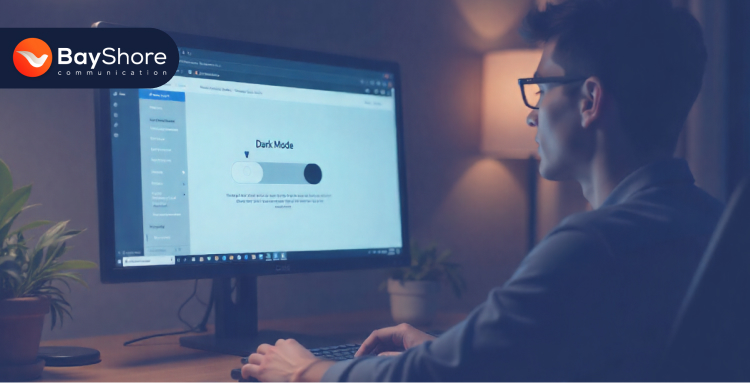
Your website should offer dark mode if your target audience prefers it, if your content-heavy site benefits from it, or to improve accessibility for users with visual impairments.
At this moment many users expect dark mode as an option nearly everywhere they go online. Recent surveys show that roughly 80 to 82 percent of mobile users prefer dark mode or at least want the choice, which makes it a serious consideration for your website.
However, offering dark mode is not a typical solution. Some brands, especially in industries where clarity, trust, or traditional visual standards matter, such as finance, medical, or professional services, may find that sticking mainly with light mode maintains consistency and legibility under many viewing conditions.
The visual identity of a brand, the contexts where its content is consumed in bright daylight or dim rooms, and the audience’s expectations all play a role. Still, giving visitors the choice between dark and light modes adds a layer of personalization many users appreciate.
It signals you respect individual comfort and preferences, which can improve user satisfaction and engagement. The next step is to look at when dark mode truly fits with your brand identity and where it might fall short.
Dark mode is offers a range of practical benefits that make it more than a passing trend. From improving visual comfort to creating a modern brand presence, its advantages extend across usability, design, and even energy efficiency.
Improved Comfort and Accessibility
Dark mode softens the harsh brightness of a screen, reducing the blue light that often leads to fatigue or disrupted focus during long reading sessions. For people with light sensitivity or photophobia, this shift can turn browsing from an uncomfortable task into a more welcoming experience, making your site accessible to a wider audience.
Better Focus on Content
By minimizing luminous distractions, dark mode creates a canvas where the content itself takes center stage. Text feels easier to concentrate on, visuals command more attention, and media-heavy sites, from portfolios to streaming platforms, can guide the viewer’s eye more effectively.
A Modern Aesthetic
Design choices send subtle signals about a brand. Dark mode, with its sleek contrasts and subdued tones, conveys a sense of innovation and sophistication. It suggests that a brand is not only keeping pace with current design trends, it is willing to offer users an elevated visual experience.
Highlighting Design Elements
Bright images, videos, and icons often pop against a dark background in a way they simply cannot on a light canvas. This gives designers more control over emphasis, making certain details stand out and allowing storytelling through design to feel more deliberate and impactful.
Energy Efficiency
On devices with OLED or AMOLED displays, dark mode can also mean practical savings. Black or near-black pixels require less power, and at higher brightness levels, energy use may drop by as much as 30 to 50 percent. For mobile-first audiences, this efficiency translates to longer battery life and a smoother user experience.
Enhanced User Engagement
Personalization matters. Allowing visitors to choose dark mode creates a sense of agency, signaling that their preferences are respected. This small act of customization can lead to stronger user satisfaction, longer site visits, and a deeper connection with the brand.
These strengths make dark mode appealing, however they also set the stage for important questions. What happens when readability suffers, or when a brand’s identity does not align with darker themes? The next section explores the potential drawbacks.

For all of its appeal, dark mode is not a universal solution. While it offers comfort, modern flair, and customization, it also presents challenges that can undermine the very experience it aims to improve. The disadvantages often emerge in the details, where design, usability, and brand identity collide.
Some text and colors lose readability, especially in bright environments or with high-contrast designs.
Development and testing require more time, adding cost and complexity.
Light, airy brand identities may not translate well into darker themes.
Poorly executed dark mode can frustrate users and harm credibility.
Dark mode is not always a natural fit for every brand or audience. Adding it only makes sense when users show clear preference or demand, and when your design system can support it without compromise.
The real test is whether it strengthens your brand identity, which leads directly into the next section on guidance for fitting dark mode into your design approach.
Dark mode can elevate a website when executed thoughtfully. It is more than switching black and white, it is about crafting an experience that is comfortable, visually clear, and true to your brand. The following principles ensure your dark mode design feels intentional rather than forced.
1. Color and Contrast
Avoid harsh extremes: Pure black backgrounds and pure white text can create eye strain. Use soft dark grays for backgrounds and off-white or light gray for text.
Desaturate accents: Reduce vibrancy of bright brand colors by 20–30 percent to maintain visual harmony.
Ensure accessibility: Check color contrast ratios with tools like WebAIM’s Contrast Checker to meet WCAG standards, making your site inclusive for all users.
2. Depth and Visual Hierarchy
Use subtle light and glow: Shadows are less effective on dark themes; instead, apply lighter shades or glows to convey depth.
Layer shades and opacity: Different shades of gray and varied opacities help distinguish UI elements and create a clear hierarchy.
Embrace negative space: Adequate spacing prevents the dark interface from feeling heavy or cluttered.
3. User Experience and Personalization
Toggle option: Provide a light/dark mode switch so users can choose based on preference or environment.
Preserve settings: Use cookies or local storage to remember users’ choices for consistent experiences.
Text and image optimization: Adjust font size, line height, and image brightness to maintain readability and visual comfort.
Accessibility support: Ensure keyboard navigation, focus indicators, and interactive elements remain clear for all users.
4. Testing and Feedback
Real-user testing: Gather feedback from actual users to assess comfort, readability, and engagement.
Device testing: Check how dark mode appears across phones, tablets, and desktops to ensure consistency.
Accessibility simulations: Use color blindness and contrast emulators to confirm your design works for everyone.
When these strategies are applied thoughtfully, dark mode not only improves usability and reinforces brand identity, it can also shape how users interact with your site by making navigation smoother, keeping visitors engaged longer, and encouraging repeat visits.
At the same time, it affects brand perception, signaling modernity, attention to user comfort, and a commitment to thoughtful design, which can strengthen trust, loyalty, and overall credibility in the eyes of your audience.
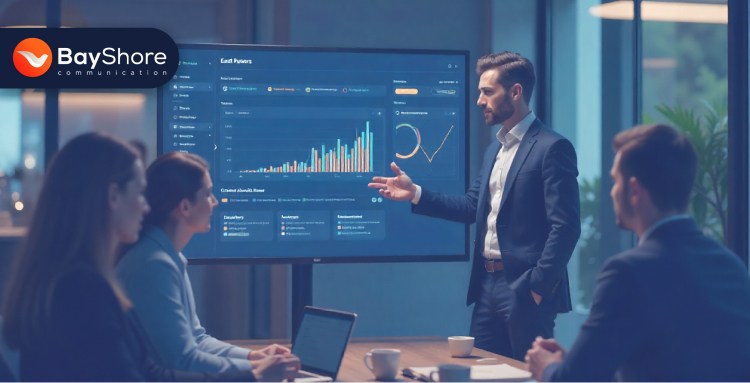
Dark mode is more than a stylistic choice; it delivers measurable business advantages. Meeting user expectations through thoughtful design builds trust, satisfaction, and loyalty. Visitors who experience a comfortable, visually appealing dark theme are more likely to stay longer, interact with content, and return to your site, reducing bounce rates and increasing session times.
Gain Competitive Advantage
Offering dark mode signals modernity and user-centric thinking. Brands that adopt it show attentiveness to digital trends and responsiveness to customer preferences, setting themselves apart in a competitive landscape.
Distinctive Brand Identity
Dark themes can evoke sophistication, minimalism, or dramatic flair. This creates a stronger emotional connection with users and reinforces brand identity, leaving a lasting impression of quality and professionalism.
Boost User Engagement
By reducing eye strain and improving comfort, dark mode encourages users to explore content more fully. Higher engagement often translates into longer visits, repeat interactions, and stronger user loyalty, reflecting a brand that values its audience.
Inclusive Accessible Design
Dark mode makes content easier to read for people with visual sensitivities or impairments. Prioritizing accessibility broadens reach, demonstrates inclusivity, and ensures a wider audience can interact with your website.
Thoughtful implementation of dark mode transforms a simple design preference into a strategic business asset.
We design dark mode with purpose, combining aesthetics, functionality, and brand identity. Our approach focuses on creating experiences that delight users and strengthen your digital presence.
Ensure text, icons, and interactive elements are easy to read and navigate for every user.
Optimize color contrast, spacing, and layouts to support visual sensitivities and inclusivity.
Adapt color palettes, logos, and brand assets to align with your unique identity and tone.
Combine modern aesthetics with functional usability to create a visually appealing experience that performs well.
Implement toggles and settings that allow users to switch between light and dark modes effortlessly.
Test and refine designs across devices to maintain consistency, speed, and engagement.
The result is a dark mode experience that adapts seamlessly to user preferences, strengthens engagement, and elevates your brand’s digital presence. Let Bayshore Communication help you implement a dark mode design that looks modern, performs flawlessly, and resonates with your audience.
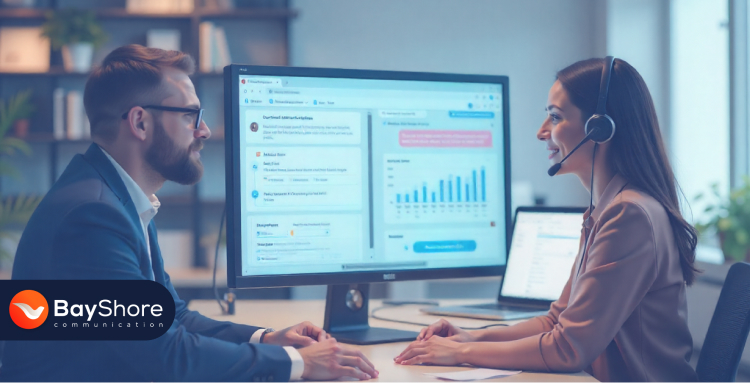
October 21, 2025
Ever waited on a website for an answer that never came? That silence often sends customers clicking away to a competitor. The shift is dramatic, as businesses using chatbots have lifted sales, while live chat has been linked to higher order values and stronger loyalty.
At the same time, gradually, small and medium-sized firms adopting digital tools have doubled in the past five years. This shift is proving that instant communication is no longer optional, it is expected.
Yet the debate still lingers. Are customers more likely to convert when a real person steps in, or when a bot delivers instant replies at scale? The answer isn’t as simple as it seems, and the real winner in this showdown may not be the one you think...
Chatbots are the always-on assistants built to answer common questions, guide customers through simple steps, and keep prospects from slipping away when staff are offline. Live chat, on the other hand, puts a human on the line, someone who can read tone, handle nuance, and shift a conversation toward closing a sale. Both tools live inside the customer journey, acting less like accessories and more like conversion levers when used well.
Bayshore Communication works with small businesses to identify which lever matters most. Some models thrive on the speed and consistency of automation, while others demand the trust only a real person can build. In Florida’s tourism sector, a chatbot can handle late-night hotel inquiries, freeing staff for in-person guests the next morning.
A local service company, such as a Tampa-based startup, can lean on live chat to reassure a hesitant customer before booking. Real estate agents often find that blending the two gives buyers instant responses while still offering a personal touch at the moment of decision.
These roles are not about choosing one over the other; they are about finding the right balance, and the real measure of success comes in the numbers...
The numbers reveal just how much difference a single conversation can make. According to Forbes, businesses using chatbots have seen sales rise by as much as 67 percent, a reminder that automation can do more than handle routine queries. It can move the revenue needle in a measurable way.
Live chat tells a similar story from another angle. According to Campaign Monitor, real-time live chat can increase conversions by 20 percent compared to websites with no chat support, and customers who use live chat tend to spend more, often adding higher-value items to their carts once their concerns are addressed.
For small businesses, those percentages translate into tangible outcomes. If a boutique hotel in Miami integrated live chat on its booking page, it would see reservations climb higher than before. By contrast, a local repair service leveraged a chatbot to qualify leads after hours, cutting response delays in half and doubling the number of confirmed appointments per week.
Both tools can boost conversions; however, the difference lies in how and where they are deployed, setting the stage for why human interaction still carries unique weight in closing sales. To get more insight, especially for beginners, here you can read on: How to Get Started with Digital Marketing for Your

Live chat offers a human touch that chatbots often cannot replicate. Customers prefer interacting with people over automated systems, especially when dealing with complex issues. Live agents can respond with empathy, handle objections, and upsell or cross-sell effectively, building trust and rapport that drive conversions.
Bayshore’s Approach to Training Live Chat Agents
Bayshore Communication emphasizes comprehensive training for live chat agents to ensure effective customer interactions:
Scripts and Escalation Protocols: Providing agents with structured scripts and clear escalation procedures to handle various customer scenarios.
Tone and Speed: Training agents to maintain a friendly tone and appropriate response speed, ensuring a positive customer experience.
Here is a local example demonstrating a Florida business success with Apex Advisors. Apex Advisors, a financial services firm, was struggling with an outdated website and minimal online presence.
After partnering with Bayshore Communication, they underwent a comprehensive digital transformation. This included a revamped website, enhanced social media engagement, and improved search engine visibility. As a result, Apex Advisors experienced a significant increase in client inquiries and overall business growth.
Chatbots are the silent workhorses of digital engagement. They don’t take breaks, they don’t sleep, and they don’t leave prospects waiting. In a world where customers expect immediate answers, bots handle the first touchpoint, answering common questions, qualifying leads, and keeping potential clients moving through the funnel without pause.
The growth reflects the scale potential. The more visitors a business has, the more efficient chatbots become at capturing leads and reducing bounce rates. Bayshore Communication takes chatbots beyond simple Q&A. Their designs incorporate intelligent routing, natural language understanding, and contextual awareness, ensuring that every interaction feels purposeful.
Bots can detect intent, prioritize hot leads, and escalate more complex queries to human agents without losing any context, bridging the gap between automation and human touch.
In customer engagement, a hybrid approach where chatbots handle initial interactions and live agents manage more complex queries has proven to be the most effective strategy. This model combines the efficiency of automation with the empathy of human interaction, leading to enhanced customer satisfaction and improved conversion rates.
Bayshore's Smooth Handoff Design
Bayshore Communication excels in creating simple transitions between chatbots and live agents. Their approach ensures that:
Chat History and Context Preservation: All interactions are logged, allowing human agents to pick up conversations without any loss of context.
Intelligent Routing: Queries are directed to the appropriate agent based on complexity and urgency.
Consistent Customer Experience: Whether handled by a bot or a human, the customer experience remains smooth and coherent.

When small businesses weigh investing in chatbots or live agents, cost becomes an immediate consideration. Staffing human agents involves salaries, benefits, training, and managing shift coverage, all of which can quickly add up. Chatbots, by contrast, require upfront licensing fees, ongoing maintenance, and periodic updates; however, their operating costs are generally lower and more predictable over time.
Return on investment (ROI) is equally important. Small businesses can start seeing measurable benefits in as little as three to six months, as chatbots capture leads and handle routine queries around the clock. Over a longer horizon, twelve to eighteen months of optimized engagement can result in higher conversion rates, improved customer retention, and meaningful revenue growth.
However, the adoption of automated tools comes with risks. Bots may misinterpret customer questions, leading to frustration or errors. Escalation delays can occur when complex issues need human attention. Security vulnerabilities are also a concern; chatbots can be exploited for malicious activities if not properly monitored
Bayshore's Approach to Managing Costs and Risks
Fallback Paths: Clear escalation protocols ensure customers are promptly transferred to human agents when needed.
Monitoring and Analytics: Continuous oversight of chatbot interactions allows immediate identification of issues and optimization of responses.
Human Oversight: Regular audits and updates to chatbot scripts maintain accuracy, relevance, and a consistent positive experience.
Digital adoption is no longer a luxury for small and medium-sized businesses; it has become a survival strategy. Companies that embrace digital tools gain a competitive edge by engaging customers faster, capturing leads more efficiently, and scaling operations without a proportional increase in costs.
According to the World Bank, the share of micro and small firms adopting digital solutions has doubled in the past five years, signaling a clear global trend toward automation and online engagement. This surge is reflected in the U.S., where businesses are investing in chatbots, live chat, and hybrid communication systems to meet rising consumer expectations.
The impact of digital adoption extends beyond efficiency. Small businesses that integrate conversational tools report higher conversion rates, faster response times, and improved customer satisfaction. By embracing these technologies, firms can handle increased demand during peak seasons, manage after-hours inquiries, and maintain a consistent brand voice across channels.
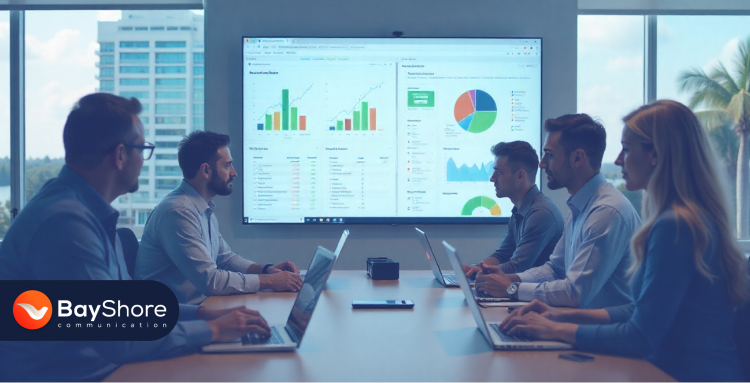
At Bayshore Communication, we don't just implement solutions. We transform businesses. Our methodology is rooted in a comprehensive approach that ensures every client receives proper strategies to meet their unique needs.
Our Proven Methodology:
Audit: We begin by thoroughly assessing your current digital presence, identifying strengths and areas for improvement.
Strategy: Based on our audit, we develop a customized plan that aligns with your business goals and target audience.
Tool Selection: We recommend the most effective tools. Be it chatbots, live chat systems, or hybrid solutions to enhance customer engagement.
Implementation: Our team seamlessly integrates the chosen tools into your existing platforms, ensuring minimal disruption.
Training: We provide comprehensive training to your team, empowering them to leverage new tools effectively.
Optimization: Continuous monitoring and adjustments are made to ensure optimal performance and maximum conversions.
The question for many businesses is no longer whether to adopt digital tools, however, how to implement them effectively. A thoughtful strategy that combines automation with human oversight can turn technology into tangible growth and ensure that every customer interaction has the potential to convert.
Ready to turn every chat into a conversion? Reach out, and let Bayshore build your next conversation, not just a reply. Let’s talk, and start transforming your customer interactions into measurable growth.

October 14, 2025
Every morning in Tampa gives you a glimpse of how modern business truly works. For small businesses, the competition is no longer just the storefront or the street corner, it is the search bar. A bakery that appears on the first page of Google can draw a steady line out the door, while another, just a few blocks away, struggles in silence.
This is why the central question for every business owner has changed. It is no longer just about what to sell or how to serve, it is about who can make them visible in the first place. In a city where dozens of firms claim to be the best SEO agency Tampa, that choice often feels less like an opportunity and more like a maze.
What separates the agencies that deliver from the ones that only promise? The answer is not as simple as rankings or price, and that is where the story begins.
Before walking into a store or calling for service, most Tampa residents begin with a search. They type “best brunch near me,” “emergency plumber Tampa,” or “wine shop open late,” and within seconds, they are choosing from the first handful of results. That single moment of visibility often decides where the money goes.
For small businesses, this makes Tampa SEO services for small businesses less of a marketing add-on and more of a survival tool. Visibility in those search results is what turns a casual browser into a paying customer. Without it, even the most beloved shop can feel invisible in a city that is moving faster online each year.
Unlike billboards or mailers, search engine optimization does not fade when the campaign ends. It builds a foundation, one that keeps placing a business in front of the right eyes month after month. Owners who treat SEO as an investment in staying relevant, rather than a cost to trim, find that the returns compound.
And yet, knowing the importance of SEO only raises the next challenge. What exactly should small businesses look for when choosing an agency to trust with their growth? That is where the checklist begins.
Choosing an SEO partner is less about flashy promises and more about how they work behind the scenes. The strongest agencies are open about what they deliver and when. Clear reporting, with metrics that make sense to a business owner, is a sign that the relationship is built on accountability, not mystery.
Equally important is fit. Small businesses do not need enterprise-sized blueprints, they need affordable SEO Tampa solutions that respect the reality of tighter budgets. The right agency adjusts the strategy so every dollar spent has a measurable impact.
Whether that means prioritizing local search visibility, creating content that answers neighborhood queries, or strengthening map listings.
National surveys show that nearly 63% of small businesses now invest in SEO, however, in Tampa the pressure is even sharper. With one of the fastest-growing metro areas in Florida, competition for local visibility means that working with a neighborhood-focused agency can be the difference between steady growth and being overlooked online.
Proven experience matters too. Look for a track record in the Tampa market, where search behavior often reflects the city’s unique mix of neighborhoods and seasonal patterns. Case studies and client examples are not just marketing material, they are evidence of whether the agency understands how people here actually search and buy.
However, even when the basics are in place, one question remains. Does the agency have the local knowledge to turn search into foot traffic? That is where the advantage of true neighborhood expertise comes into play.
▍Tip to Know: “When interviewing agencies, ask them to walk you through one recent local campaign, step by step. The way they explain keyword choices, reporting methods, and results will tell you more than any sales pitch.”
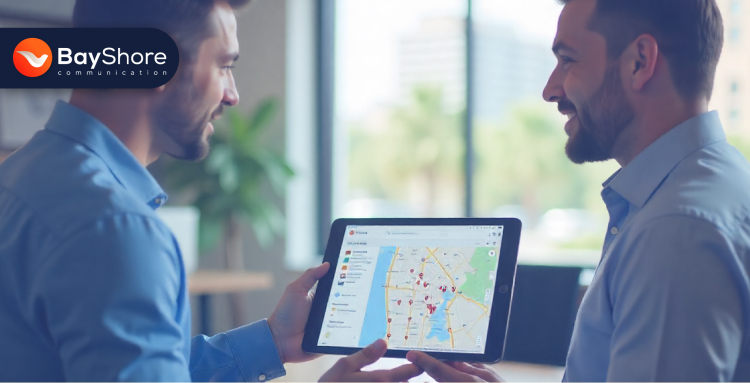
National agencies can map trends, though only local SEO experts Tampa understand the subtleties of this city’s search behavior. When someone in Hyde Park searches for “wine shop near me,” or a parent in Carrollwood types “after-school tutoring Tampa,” Google does not show national chains first, it highlights businesses that are closest, relevant, and trusted.
This is where local expertise changes the outcome. Agencies rooted in Tampa know how to optimize for map packs, how to track seasonal search surges around Gasparilla or holiday shopping, and how to weave in neighborhood-specific signals that outsiders often overlook. For small businesses, that kind of precision is what turns a casual search into a new customer walking through the door.
At Bayshore Communication, the focus is not on chasing vanity rankings instead on strategies that connect businesses directly with nearby customers. That means building content designed for local intent, strengthening location pages, and ensuring reviews appear where Tampa residents are actually looking.
▍Quote to Know: “Local SEO is not about reaching everyone, it’s about reaching the right someone, at the right time,” notes Salman H. Saikote, lead strategist at Bayshore Communication. “In Tampa, the difference between page two and the top three map results can be the difference between a steady stream of customers and a quiet storefront.”
And while local expertise gives businesses an immediate edge, it also raises the question of what happens when an agency promises more than it can deliver. That is where recognizing red flags becomes essential.

The search for the right partner often begins with a promise, however in SEO, the promises themselves can be the warning signs. An agency that guarantees a number-one ranking should raise eyebrows. Algorithms shift constantly, and no firm, no matter how skilled, can control the outcome overnight.
Another danger is the standardized package. A template designed for a nationwide retailer rarely serves a family-owned business in Tampa. Local search requires nuance, not generic checklists. If an agency cannot explain how its strategies adapt to the rhythms of your neighborhood market, that is reason to pause.
Transparency is just as important. Hidden fees, vague deliverables, or reporting that buries results in jargon all point to a lack of accountability. Small businesses cannot afford to waste resources chasing unclear goals.
▍Stat to Know: “A survey of small business owners found that 47 percent who left their SEO agency cited lack of transparency as the main reason. In Tampa’s competitive market, that kind of misstep can set growth back months.”
Spotting red flags early not only protects budgets, it clears the path to what really matters, finding a partner who invests in your business as deeply as you do. That is where the idea of partnership, rather than transaction, comes into focus.
For small businesses, SEO is not a short campaign, it is an ongoing dialogue with the digital world. That is why the strongest results come from agencies that act as collaborators, not vendors. The relationship should feel like having a dedicated strategist by your side, not just an outsourced service.
True collaboration brings clarity. Business owners deserve open communication, regular updates, and the freedom to ask questions without confusing jargon. When strategies and reports align with real business goals, trust develops naturally and the partnership delivers lasting value.
At Bayshore Communication, the approach is simple yet deliberate. Every engagement begins with listening, then tailoring strategies that reflect the specific realities of a business, whether that is a boutique retailer in Ybor City or a service provider in Brandon. The focus is always alignment, not pre-packaged solutions.
▍Tip to Know: “A reliable agency should be able to show you how each recommended tactic connects directly to your business goals. If you cannot draw a straight line between strategy and outcome, ask why.”
And once collaboration becomes the foundation, the final step is about more than strategy, it is about confidence. That is what matters when choosing the best SEO agency in Tampa.

Choosing an SEO partner is not just another line on a marketing budget, it is a decision about who will help guide your business through the next stage of growth. The right agency is more than a service provider, it is a steady ally who knows how Tampa thinks, shops, and searches.
Working with the best SEO agency Tampa means having a partner who understands the rhythm of this city, from the seasonal surges in tourism to the everyday habits of neighbors searching for trusted local businesses. It is that mix of insight and precision that makes the difference between simply being online and truly being found.
Bayshore Communication stands ready to be that ally. With strategies rooted in local expertise, a commitment to clarity, and results that can be measured, we help small businesses compete with confidence. For owners who want their story to be discovered, not lost, the choice is clear.
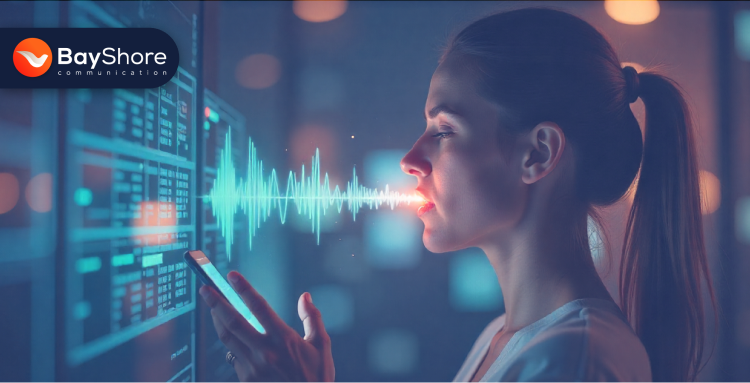
October 7, 2025
What if you’re asking your phone a question and getting an answer before you even finish your coffee? Voice assistants like Siri, Alexa, and Google Assistant have transformed the way we search, making conversations with technology feel effortless, almost human. For businesses, this shift is more than a tech trend; it’s a seismic change in how customers discover products, services, and brands.
We’ve seen very clearly how brands that adapt to this conversational era gain visibility and deepen connections with their audience. However, optimizing for voice search is not the same as traditional SEO. It requires understanding how people actually talk, not just what they type.
So, what does it take to ensure your content speaks the language of today’s voice-first world, and how can your brand rise above the noise?
When it comes to voice search, single keywords no longer cut it. People don’t speak to their devices in shorthand. They ask full questions like, “Where can I find the best local coffee?” or “How do I get my car detailed nearby?” Optimizing for these natural phrases is where Bayshore Communication makes the difference.
Our approach begins with understanding your audience’s language. We research the real questions your customers are asking, then craft effective content that mirrors their conversational style. It’s not about stuffing phrases into a page, however; it’s about weaving your brand with high-quality content. Exactly in the way people naturally communicate.
Long-tail keywords, questions, and even casual phrasing can unlock higher visibility for voice queries. We focus on how people actually talk. Bayshore Communication ensures your content is not only found. However, it resonates for turning searches into meaningful connections.
In 2025, nearly 20% of Google searches feature a snippet at the top of the results page, a significant increase from previous years, as per research by amra & elma. These concise, direct answers are favored by search engines and are also the primary source of information for voice assistants.
For businesses aiming to enhance their visibility in voice search, optimizing content to appear in these snippets is essential.
Bayshore Communication employs a strategic approach to optimize content for featured snippets. This involves:
Targeting Common Questions: Start by pinpointing the questions your audience is already asking. These are the “who, what, where, when, and how” queries people voice into their devices every day. We identify recurring themes in your industry, like pricing, availability, or step-by-step processes, and that’s why you can position your brand as the go-to authority with answers ready at their fingertips.
Providing Clear, Concise Answers: Voice search thrives on brevity. Craft responses that are crisp, to the point, and easy for search engines to pull as featured snippets. Like you’re explaining your answer in one or two sentences to a friend. That level of clarity boosts visibility and builds trust with your audience.
Utilizing Structured Formats: Breaking down complex information into digestible formats. Use lists, bullet points, or comparison tables that make scanning effortless. This improves readability for users. Plus, it signals to search engines that your content is well-organized and ready to serve as an authoritative result.
Implementing Schema Markup: Go a step further with schema markup, the hidden code that tells Google exactly what your content means. Whether it’s marking up FAQs, product details, or reviews, schema helps your content surface in rich results like featured snippets or “People Also Ask” boxes. Done right, it makes your answers shine in voice search.
We carefully align content with these practices, so your businesses can increase their chances of being featured in snippets. Thereby improving their visibility in voice search results.
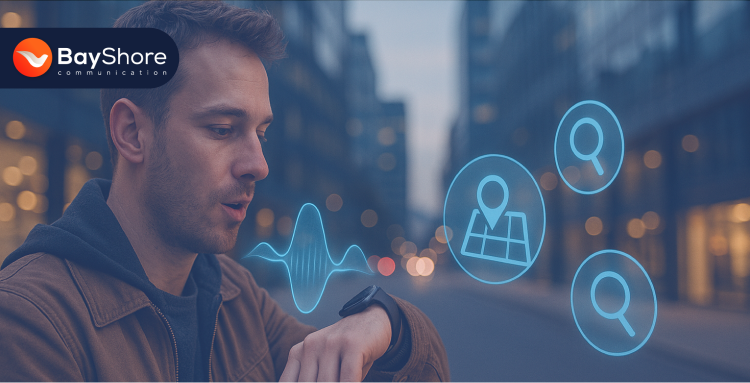
In 2025, voice search is no longer about convenience. It's an important tool for local discovery. According to Forbes, over 125 million people conducted voice searches in 2024, with a significant portion seeking local businesses and services.
For businesses aiming to capitalize on this trend, optimizing for local voice search is essential. This involves ensuring that your Google Business Profile is complete and accurate, incorporating location-specific keywords into your content, and utilizing structured data to enhance visibility in local search results.
Bayshore Communication specializes in crafting strategies that align with these practices, helping businesses improve their local search rankings and connect with nearby customers more effectively. For guidance on creating and managing a Google Maps listing, see our blog: The Importance of Regular Google Maps Listing Updates
Mobile devices are the primary gateway to the internet for billions. According to the World Bank's Global Findex 2025 report, 86% of adults worldwide own a mobile phone, with 68% possessing smartphones. This widespread mobile penetration underscores the necessity for businesses to optimize their websites for mobile-first experiences, especially in the realm of voice search.
Voice search queries are typically longer and more conversational, reflecting natural speech patterns. To cater to these, websites must be designed to load swiftly and display correctly across various mobile devices. A delay of just one second in page load time can lead to a reduction in conversions . Therefore, ensuring fast loading times is crucial for retaining visitors and improving search engine rankings.
Moreover, with the increasing use of mobile devices for voice searches, it’s imperative to implement structured data and schema markup. These tools help search engines understand and display content more effectively, enhancing visibility in voice search results.
We, Bayshore Communication, specialize in creating mobile-optimized, voice-friendly websites that meet technical standards and provide a smooth user experience.
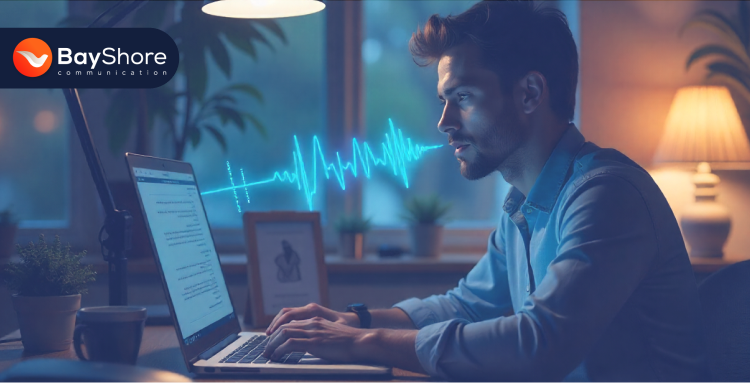
The power of voice search isn’t just technical; it’s human. People don’t type in clipped phrases in real life. They speak naturally, with curiosity, hesitation, and personality. Questions like “What’s the fastest way to get my car detailed nearby?” or “How do I make my small business stand out online?” reflect real intent, and the brands that answer in kind win attention.
Bayshore Communication creates content; in other words, we craft conversations. Every sentence mirrors the way real people talk, turning search queries into a dialogue rather than a monologue. We infuse charm and clarity into every word, guiding readers while subtly showcasing expertise. It’s persuasive without being pushy, informative without feeling formal, and always tuned to the rhythm of natural speech.
With this approach, your content becomes more than discoverable; it becomes relatable. Voice assistants favor clarity and relevance, and audiences respond to authenticity. As queries become more conversational, expectations for fast, clear, and helpful answers will only grow. The brands that anticipate these changes, however, will be the ones that capture attention, trust, and loyalty.
Optimizing for voice search isn’t complete without tracking results. Voice queries behave differently than traditional searches, which means standard analytics may not capture the full picture. Bayshore Communication uses advanced tools to measure impressions, clicks, and conversions from voice-driven traffic, ensuring every strategy is data-driven.
We analyze which questions bring users to your site, how long they engage with content, and which pages convert best. This allows us to continuously refine your voice search strategy, helping your brand stays ahead of the curve. With measurable insights, Bayshore Communication transforms every voice search interaction into an opportunity for growth and connection.

Appearing in voice search results is only half the story. The real turning point is what happens next. Visibility is good; however, conversion is where the real magic lies.
That’s why the content we shape doesn’t just stop at giving an answer. Moreover, it draws people in, nudges them closer, and makes it easy for them to take the next step.
Consider it in the following terms:
Calls to action that feel irresistible. Not just “click here,” but phrases that invite trust, spark curiosity, or promise real value.
Navigation that feels intuitive. Every button and link flows like a natural continuation of the conversation, guiding users without friction.
Answers that anticipate follow-up questions. Instead of stopping at one reply, the content opens doors to deeper engagement.
A tone that mirrors a trusted friend. Direct, conversational, and reassuring, so the audience feels heard, not pitched to.
Micro-moments that encourage action. Whether it’s a quick link to book, a one-tap purchase option, or a gentle nudge to learn more, small details create big results.
From booking a consultation to signing up for a newsletter, even making a purchase on the spot, the journey feels effortless. We believe in tuning content to the way people actually talk. In fact, we help brands do more than get found; we help them spark connections that last.
Bayshore Communication is at the peak of this shift regarding voice search, helping businesses adapt and also thrive. From crafting natural, engaging content to optimizing for local and mobile-first searches, our strategies are designed to meet your audience exactly where they are. Speaking their language, answering their questions, and building lasting connections.
Partner with Bayshore Communication and turn every voice search into an opportunity. Let’s talk about content that speaks, connects, and converts. Your audience is talking, and we know exactly how to help you answer.
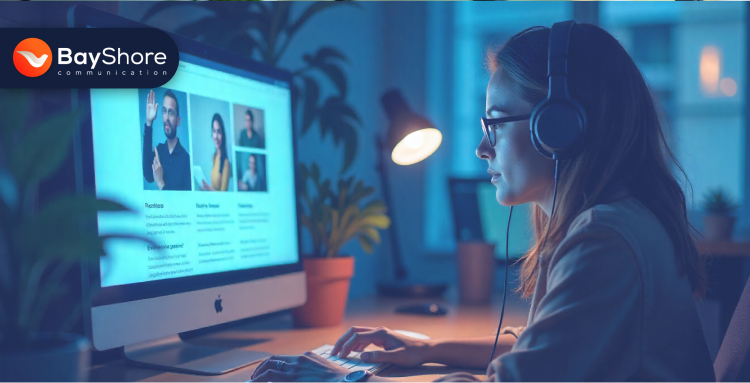
September 30, 2025
The internet in the United States moves faster and touches more parts of life than ever, powering e-commerce, healthcare, education, and government services. Yet, for millions of Americans living with disabilities, websites remain confusing, frustrating, or completely unusable. Accessibility is no longer just a checkbox on a compliance list, it is a business-critical strategy that determines who can engage with your brand and who is left out.
Bayshore Communication helps U.S. businesses turn digital barriers into opportunities, creating websites that are ADA compliant, sleek, intuitive, and welcoming to all users. The question is, are your digital experiences truly inclusive, or could your website be silently pushing away thousands of potential customers without you even realizing it
Accessibility is no longer optional for American businesses. The legal outlook has shifted, with the Americans with Disabilities Act (ADA) and Section 508 increasingly shaping digital compliance standards. Lawsuits against inaccessible websites are growing each year, showing that ignoring accessibility carries tangible financial and reputational risks.
At the same time, accessibility opens doors to a significant audience. According to the CDC, over 61 million Americans live with a disability, representing a substantial portion of consumers with buying power.
How Bayshore helps:
Conducting compliance audits to identify potential gaps before they become legal or financial problems.
Advising businesses on practical design strategies that satisfy legal requirements while enhancing usability.
Educating teams on long-term accessibility planning so websites stay functional and inclusive as they evolve.
Understanding these numbers makes it clear that inclusive design is both a responsibility and a business advantage.

Accessibility affects real people in tangible ways. Small design oversights can prevent users from accessing critical information, creating frustration and exclusion. Bayshore Communication addresses these challenges by focusing on human-centered solutions:
Incorporating user feedback from people with diverse abilities
Bayshore actively tests websites with users who rely on screen readers, voice navigation, or other assistive technologies. An educational platform discovered that interactive charts were inaccessible for students using screen readers. Bayshore redesigned them with descriptive tables and audio labels, allowing students to complete assignments independently and without assistance. By grounding design decisions in real user experience, accessibility becomes practical, meaningful, and effective.
Ensuring features such as screen reader compatibility, keyboard navigation, and readable layouts are standard
Accessibility is embedded into every project rather than added as an afterthought. A healthcare website, for example, needed patients to book appointments efficiently. Clear labeling, logical form structures, and full keyboard navigation reduced errors and made online scheduling straightforward. These improvements benefit all users, enhancing usability and overall satisfaction.
Designing experiences that anticipate user needs before issues arise
Bayshore takes a proactive approach to prevent obstacles. An e-commerce company needed product filters usable by visually impaired shoppers. Bayshore implemented accessible filters with text labels and logical tab order, enabling smooth navigation and shopping. Anticipating potential barriers ensures websites remain inclusive even as content evolves, making accessibility an integrated part of the user experience.
Reducing cognitive load through predictable layouts and clear navigation
Websites that follow consistent visual hierarchies and labeling help users with cognitive differences process information efficiently. Bayshore restructures complex pages into logical flows so visitors can easily complete tasks or locate content. This improves engagement, satisfaction, and confidence in using the website.
Making accessibility a long-term habit, not a one-time fix
Accessibility is an ongoing process. Bayshore trains client teams to maintain standards as new pages, content, and features are added. A financial services client reported a significant drop in customer support calls after implementing Bayshore’s guidance, demonstrating how accessible design reduces friction and empowers users.
By focusing on these strategies, Bayshore Communication shows that accessibility is more than compliance. It creates digital spaces where users feel included, capable, and respected, transforming websites into meaningful, inclusive experiences that strengthen engagement and trust.
Accessible web design relies on four main principles that make websites usable and inclusive. When applied thoughtfully, these principles transform digital spaces so all users can engage seamlessly
Perceivable: Content must be visible and understandable for everyone. Images need alt text, videos need captions, and typography should be easy to read. Bayshore Communication ensures these elements are standard. An online retail client improved engagement after alt text allowed screen reader users to navigate products independently
Operable: Navigation must work for every user, regardless of how they interact with the site. Keyboards, voice commands, and assistive devices must be supported. Bayshore redesigned a healthcare platform so patients could book appointments using only a keyboard. Completion times improved and errors decreased, showing smoother experiences for all.
Understandable: Content and interfaces should be clear and predictable. Labels, menus, and error messages guide users rather than confuse them. A student registering for an online course received clear instructions if a form field was incomplete, reducing frustration and cognitive load.
Robust: Websites must remain compatible with new browsers, devices, and assistive technologies. Bayshore tested a financial dashboard across platforms to ensure consistent performance. Robust design protects the website as technology evolves and ensures all users can access information
Bayshore Communication applies these principles throughout design and development. We provide teams with guidance to maintain accessibility as sites grow. Following these principles creates digital experiences that are inclusive, functional, and engaging while building trust with users
Bayshore’s integration:
Embedding these principles into every stage of design and development.
Offering guidance to ensure accessibility remains a priority rather than an afterthought.
Following these principles allows businesses to create digital experiences that are inclusive, functional, and engaging.

Creating a fully accessible website is not just about checking boxes. Bayshore Communication combines technology, strategy, and design expertise to deliver websites that meet ADA standards while remaining visually appealing.
Implementation examples:
Conducting accessibility audits using tools like WAVE and axe to pinpoint issues early.
Integrating accessibility from wireframes to prototypes, avoiding costly redesigns later.
Testing websites with real assistive technologies, including screen readers and voice navigation.
Updating and refining websites continuously to accommodate new content and technological changes.
A survey from the American Chiropractic Association found that 92% of Americans working from home report new or increased back, neck, or shoulder pain, highlighting how digital experiences can impact everyday usability and wellness. Bayshore applies the same attention to user comfort, ensuring accessibility improves engagement and satisfaction.
Accessible websites do more than comply with regulations. They expand market reach, strengthen brand trust, and improve user engagement. Clear layouts, consistent navigation, and optimized content also help search engines index sites more effectively, providing an indirect boost to visibility.
Retail websites serving more customers
A retail site that incorporates features such as voice search, alt text for product images, and keyboard-friendly navigation allows a wider range of customers to shop independently. Bayshore Communication worked with a mid-sized apparel brand to make its product catalog accessible, which increased online purchases from users with disabilities and reduced support inquiries from all shoppers.
Government and healthcare portals improving completion rates
Clear, accessible forms prevent errors and frustration for all users. A city government portal redesigned its utility payment forms with guidance from Bayshore, adding logical tab orders, clear labels, and screen reader compatibility. As a result, form submission errors dropped by nearly 30 percent, reducing call center traffic and improving overall efficiency.
Education platforms enhancing participation
Online learning platforms that provide accessible video content, interactive elements, and readable materials reach more students, including those with disabilities. Bayshore helped a university course portal implement captions, transcripts, and structured navigation. Students who previously struggled with enrollment or content access reported smoother experiences, demonstrating how accessibility directly impacts engagement and retention.
Corporate websites building brand trust
Businesses that prioritize accessibility signal inclusivity and social responsibility. As reported by The Economist, companies embracing accessibility see stronger customer loyalty and long-term engagement. A corporate consulting firm worked with Bayshore to redesign its client portal with readable dashboards, alt text, and keyboard navigation. Clients reported increased confidence in using the platform, which enhanced the firm’s reputation for user-centered service.
Driving innovation across industries
Accessibility improvements often lead to innovations that benefit all users. For example, a travel booking platform implemented predictive text, voice-assisted navigation, and accessible filters with Bayshore’s support. These enhancements helped users with disabilities and sped up booking for all travelers.
Bayshore Communication ensures that every website we build is welcoming, functional, and effective for all visitors. Accessibility becomes not just a compliance measure, but a growth opportunity that enhances engagement, builds trust, and strengthens the business in a competitive market
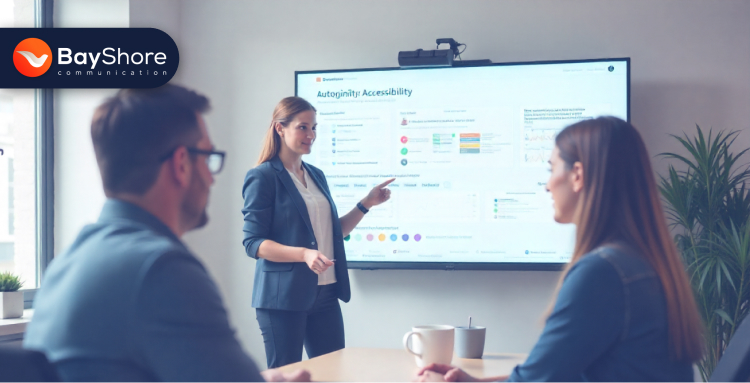
Bayshore Communication combines U.S.-based expertise, design creativity, and technical know-how to make every website accessible and functional. Our team works across healthcare, education, retail, and finance, ensuring inclusivity becomes a strategic advantage.
What sets Bayshore apart:
Accessibility is incorporated from the first wireframe to website launch.
Teams receive training to maintain compliance as websites grow.
Design solutions are crafted to satisfy both accessibility regulations and user expectations.
By prioritizing accessibility, Bayshore Communication helps businesses expand our audience, build trust, and future-proof their digital presence. So, contact us and see how your website can become a space where everyone feels welcome and able to participate

September 25, 2025
In 2025, from South Tampa condos to Seminole Heights bungalows, residents are browsing, clicking, and buying with a fluency that would have seemed ambitious 5 years ago. More people trust Google Maps than their own instincts, and product reviews from strangers often matter more than a neighbor’s advice.
What drives this shift is not just faster internet or trendier apps. It is a lifestyle recalibration. Remote work, rising local commerce, and an appetite for convenience have formed the pillars of Tampa’s new online identity.
Businesses that once relied on foot traffic now compete in search engine rankings. Consumers expect same-day delivery and one-minute customer service. In this climate, understanding how and why Tampa shops online is a survival tool.
So, let’s explore what Tampa’s online consumers care about, how they behave in 2025, and why businesses must adapt or fall behind.
If you want to understand Tampa’s online marketplace, start by looking at who is driving the clicks. The city’s digital behavior in 2025 is powered by three core groups, each shaping the ecosystem in their own way.
At the forefront is Generation Z. These are consumers who grew up tapping before they could talk. They prefer texts over calls, short videos over long ads, and personalization over mass appeal. For them, the line between social and shopping has all but disappeared.
Not far behind are technologically talented retirees, many of whom relocated to Tampa for its weather but stayed for its convenience. They may skip TikTok, but they rely on Alexa for reminders and use telehealth platforms with confidence. This group is often overlooked in digital marketing, but their purchasing power is real and steady.
Then there are the remote workers, a growing population that blends work and life from home offices in Davis Islands, Westchase, and even converted vans near Clearwater. They shop during odd hours, rely on location-agnostic services, and fuel demand for smart home devices, digital subscriptions, and productivity apps.
What connects these groups is a search-first mindset. Whether it is finding a coffee shop or a dog walker, they type before they try. Consumers favor fast-loading mobile sites, are quick to abandon anything bloated or broken, and show a growing loyalty to hyper-local brands that speak to their neighborhood, not just their city.
Since 2022, Tampa has seen a 41 percent increase in mobile search activity, while voice search queries have jumped by nearly 65 percent, according to regional analytics data from third-party platforms.

The Tampa consumers are buying with intent. Their carts reflect local culture, seasonal needs, and a preference for both value and speed.
Food delivery continues to lead, but the category has matured. It is less about Friday night takeout and more about daily meal subscriptions, groceries on-demand, and even pet food scheduled on repeat. Platforms that partner with local vendors are gaining traction over national chains.
Home improvement and lifestyle rank high, especially during storm season. The uptick in sales for backup generators, window treatments, and weatherproof storage tells a story about practical spending habits shaped by geography. Likewise, smart thermostats and solar panels are quietly trending in newer developments.
Tampa’s pet lovers are also opening their wallets. With more residents working from home, demand for pet products and veterinary teleconsultations has grown. This is no longer considered a niche market. It serves as a regional pillar for e-commerce.
Consumer behavior in 2025 also reflects a “micro-moment” mindset. Purchases are made in real-time, influenced by hyper-local events. A pop-up food festival in Ybor City might cause a same-day spike in online searches for parking passes, boutique hotels, or vegan menu items.
In today's ever-changing society, you must understand what your target audience is likely to buy. Knowing why they buy it, and when, is what separates casual sellers from brands with staying power.
Bayshore Communication uses neighborhood-level data and behavior insights to help our clients match the rhythm of Tampa’s evolving online habits. In a city where behavior can swing with the tides, precision beats scale every time.
Tampa’s consumers may be diverse, but their shopping patterns are strikingly aligned. The journey rarely starts in a store and almost never begins without a search bar.
Google remains the go-to platform for discovery. Whether someone is looking for a late-night locksmith or the best Cuban sandwich in Hyde Park, it starts with a search. Local SEO has become a necessity for small businesses.
Facebook Marketplace is where Tampa hunts for bargains. From used kayaks to antique mirrors, residents treat the platform like a rolling garage sale. It is fast, hyper-local, and trusted enough to make deals with a stranger in a Publix parking lot.
Instagram and TikTok have become Tampa’s trendsetters. What begins as a dance video or recipe reel often ends as a purchase. These platforms are storefronts disguised as feeds.
Working families in the area are leaning heavily on Buy Online, Pick Up In Store. BOPIS orders have surged, especially in suburban neighborhoods where flexibility is currency. Parents use mobile apps to stock up during lunch breaks, then collect items on the way home from after-school pickups.
Reviews matter more than advertising, especially when they come from neighbors. Whether it is a local spa, a dentist, or a landscaping service, consumers want to hear from someone who lives down the street, not a polished brand ambassador.
Short-form video has become the most effective content type. Tampa residents are not reading five-paragraph product descriptions. They are watching 15-second clips that show, explain, and persuade in one swipe.
In this fast and fragmented environment, brands that sound corporate get ignored. Brands that sound local get business. Bayshore Communication has helped dozens of Tampa-based companies build that authentic voice, boosting their online presence and translating complex services into simple content that works across platforms.

Tampa’s consumers are thinking harder about where those clicks lead. In 2025, the digital shopping scene is crowded and loud. Banner ads chase people across apps. Email inboxes fill with promotions no one remembers subscribing to. Push notifications interrupt family dinners.
The result is a rising sense of digital fatigue. Consumers are tired of being followed, tracked, and sold to at every turn. What once felt like convenience now feels like surveillance.
Privacy is no longer a niche concern, it is a mainstream expectation. People want to know how their data is used, who gets to see it, and why. Tampa residents, especially those under 40, are using privacy-focused browsers, installing ad blockers, and actively avoiding apps that feel intrusive.
This shift is reshaping consumer loyalty. Shoppers are gravitating toward brands that are transparent, responsive, and human. Businesses that clearly state their policies, respond quickly to complaints, and sound like real people instead of bots are earning trust in ways paid campaigns cannot replicate.
Bayshore Communication has built its strategy around that reality. We advise our clients to prioritize consent-driven marketing, lean on organic reach, and drop the standard model in favor of audience-informed messaging. In an age of algorithm fatigue, ethical digital practices are just the right and smart thing to do.
Rather than overwhelm users with retargeting ads, Bayshore helps businesses craft helpful content that draws people in. The message is simple. If you want people to trust your brand, start by treating their time and data with respect.
Small enterprises across the city are learning that survival in 2025 means understanding what customers are searching for, when they are searching, and what makes them stop scrolling.
Take Carter Injury Law, a Tampa-based personal injury firm that saw an opportunity in the rising volume of mobile searches related to auto accidents and insurance disputes. Instead of relying solely on paid ads, they restructured their website around high-intent local search terms. They introduced educational blog posts, client FAQs, and page titles specifically for voice search. Within months, their organic traffic saw a double-digit increase, and inbound leads began to show clearer intent and stronger conversion rates.
Then there is Apex Advisors, a Florida-based tax consultancy serving individuals and small businesses. As filing seasons grew more competitive, Apex launched short-form video explainers on Instagram and LinkedIn. These covered topics like common IRS red flags and small business deductions. Each clip was under a minute and shot with simple visuals. The approach attracted younger entrepreneurs and time-strapped professionals who preferred quick, clear advice over lengthy tax guides.
These businesses share one thing. They worked with Bayshore Communication.
Bayshore does not offer generic advice. We deliver targeted audience analysis, local SEO optimization, and paid ad strategies designed around Tampa’s rhythms. We know the difference between someone searching for “best tacos near me” and someone planning a catering order. One needs directions, while the other needs a long-term relationship.
▍Quote to Know: “In 2025, success is about reaching the right 500 people at the right time, on the right platform,” said Salman H Saikote, lead strategist at Bayshore Communication. “If you sound like you understand Tampa, Tampa will listen.”
In a city that is part beach town, part tech hub, small businesses that embrace smart data and clear messaging are finding their edge. With the right guidance, many of them are outperforming their national competitors.
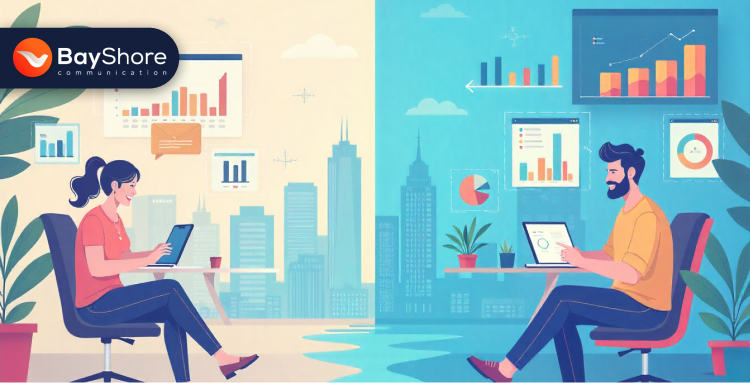
For Tampa’s residents, the digital shift has created a marketplace that listens better, responds faster, and feels more local than ever before.
Consumers are getting smarter deals, often from businesses just blocks away. With better access to reviews, price comparisons, and same-day pickup options, shopping online no longer means buying from across the country. In many cases, it means buying from across the street.
This has led to the rise of local loyalty loops. A parent finds a kid-friendly café on Instagram, shares it in a neighborhood group, and the café sees a bump in orders that same week. The loop tightens, and both customer and business benefit.
For entrepreneurs, the message is clear. Trust, speed, and relevance are the minimum requirements. Businesses that speak directly to Tampa’s identity and meet its residents on their terms are seeing measurable growth.
Bayshore Communication has leaned into this shift by offering free consultations to startups and toolkits for solo entrepreneurs. These are not vague webinars or bloated downloads. They are custom-built resources focused on the needs of Tampa’s local business owners, from SEO checklists to social media templates that match neighborhood trends.
Tampa’s online consumers are not distracted. They shop with purpose, filter noise with instinct, and reward businesses that respect their time and intelligence.
This is not a city waiting to be discovered. It is a city already online, already buying, already making choices based on speed, trust, and relevance. For residents, the shift brings more power to their fingertips. For businesses, it brings more pressure to keep up or fall behind.
The companies that will thrive here are the most tuned in. They will know when to speak, where to show up, and how to be useful in a moment that matters.
Bayshore Communication is part of that future. By offering real insights, grounded strategies, and a clear sense of what makes Tampa tick, we are helping businesses stay connected, stay competitive, and stay local in the best sense of the word.

September 21, 2025
Tampa’s dining scene is cutthroat. From family-run Cuban sandwich shops in Ybor to sleek brunch towers on Water Street, the city is fueled by flavor and competition. However, in 2025, discovery does not happen by strolling through neighborhoods or scanning chalkboard signs.
According to the U.S. Census Bureau, 64 percent of Americans search online for local information weekly, and restaurants are among the most-sought categories (U.S. Census Bureau, American Community Survey).
Diners turn to Google Maps, voice search, and “near me” queries to decide where to eat. If your restaurant is not ranking in those results, you are invisible.
This is why Local SEO is crucial for Tampa-based restaurants. Online visibility has become as vital as the food itself, and the restaurants that thrive are the ones that appear first. Bayshore Communication has built its reputation by making sure local kitchens surface at the right time in the right search. The only question left is whether your restaurant will be the one they find…
In Tampa, dinner now begins with a screen. More than 90 percent of consumers look up restaurants online before deciding where to eat, which means the first impression is no longer the hostess at the door, it is how a business appears on Google (GetSauce).
Voice is taking over the search bar. According to DemandSage, 76 percent of voice queries are “near me” searches, and restaurants are the top target. That means a simple request like “best Cuban sandwich near me” can be the deciding factor in where locals actually dine (DemandSage, Voice Search Statistics).
A simple request like the best Cuban sandwich near me is now a deciding factor in where locals end up dining.
Reviews seal the deal. People put more trust in the opinions of strangers on Google Maps than in recommendations from friends.
The shift is clear. A restaurant’s online profile has become its new front door, and when that door is cracked or left shut, the consequences go well beyond a missed reservation.

Even the most inventive menu cannot rescue a restaurant that no one can locate online. In Tampa, countless kitchens vanish from sight not because of flavor, but because of overlooked digital missteps.
Hours listed incorrectly on Google send potential diners to locked doors, while blurry or poorly lit photos fail to spark appetite or curiosity. Mismatched addresses and phone numbers scatter signals across the web, leaving search engines unsure where to point hungry patrons. Reviews go unanswered, eroding trust one comment at a time.
These small lapses add up fast, draining tables and dulling a brand’s presence. In a city where searches happen on screens before shoes touch the pavement, invisibility comes at a cost restaurants cannot afford to ignore. Next, the challenge is turning those digital checkmarks into real-world visits, ensuring clicks convert into full seats.
In Tampa, reputation is no longer passed from neighbor to neighbor over backyard fences, it is coded into algorithms that decide which restaurants surface first on a screen. Local SEO has replaced gossip as the currency of trust.
The closer you are to the searcher, the sharper your relevance, and the stronger your reputation, the higher you climb. A steady stream of positive reviews signals reliability, while optimized profiles make booking a table feel frictionless.
For restaurants, visibility is no longer optional. Diners will not scroll endlessly when competitors are a single tap away. The kitchens that invest in Local SEO shape the first impression before a guest even walks through the door. The next frontier is knowing how to translate that digital edge into sustained loyalty once the meal begins.
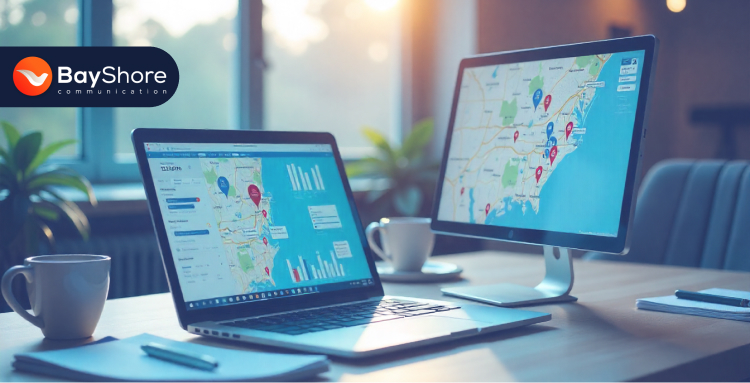
Bayshore does not import generic SEO strategies from elsewhere. It builds digital systems that reflect Tampa’s food culture block by block. Every move connects to how locals actually search, book, and eat.
Neighborhood Keywords
Diners rarely type “Tampa restaurants.” They look for “best Cuban sandwich Ybor City,” “Hyde Park date night,” or “Davis Islands brunch near me.” Bayshore captures those hyperlocal phrases so restaurants appear in the exact searches that lead to bookings.
Profile Engineering
A Google Business Profile is now a restaurant’s storefront. Bayshore ensures it works like one, with high-impact photos that spark appetite, keyword-rich descriptions that highlight both food and atmosphere, and structured data that makes listings show up in voice searches. For example, when someone asks Siri for “gluten free pizza near Curtis Hixon Park,” an optimized profile is the difference between being suggested or being skipped.
Review Management
Diners in Tampa trust reviews as much as personal referrals. Bayshore helps build a steady flow of authentic reviews and ensures that every comment receives a response. A well-handled one-star review often builds more trust than a row of five-star ratings with no replies.
Mobile-First Websites
In Tampa, reservations are made while waiting in traffic on Kennedy Boulevard or riding to Ybor on a Friday night. Bayshore designs restaurant websites to load fast, display menus clearly, and make booking just one tap away. Click-to-map functions guide diners directly from screen to table.
Real-Time Adjustments
Search behavior changes with the season and even with the weather. A summer storm can trigger spikes in “comfort food near me,” while Gasparilla weekend fills feeds with “late-night food Tampa.” Bayshore tracks those shifts daily and updates campaigns instantly so restaurants ride every wave of demand.
This is not broad SEO for any city. It is precision tuned for Tampa’s dining scene, adjusted to the neighborhoods, moods, and micro-moments that shape where people eat. The next step is learning how success is measured and which signals prove that visibility is turning into loyalty.
Visit our other posts to understand more about SEO services in Tampa
When Local SEO clicks, the results show up in the dining room. A map search becomes a car pulling into the lot. A late-night “near me” query turns into a table filled with new faces. For smaller restaurants, this visibility levels the field, letting a neighborhood café in Seminole Heights compete with the national chains lined up on Dale Mabry.
The connection is direct. Online presence is no longer separate from the dining experience, it mirrors it. A polished profile and strong reviews are the digital equivalent of a welcoming host and a well-set table. For Tampa restaurants, that means streams of diners who first discover you on a screen, then return because the physical experience matched the promise.
The next layer is sustainability, making sure this flow of new customers is not just a spike but a lasting cycle of loyalty and growth.

Most agencies promise SEO. Bayshore Communication practices it like a craft, tuned to Tampa’s neighborhoods, dining habits, and cultural rhythm. We do not deliver pre-built templates. We build strategies that mirror the way people actually choose where to eat in this city.
Local Roots, Local Insight
We know the search intent behind a Hyde Park brunch crowd is different from a family night in Carrollwood. That knowledge shapes the campaigns we build.
Visibility That Converts
It is not enough to show up in search. We engineer visibility that translates into foot traffic, reservations, and repeat diners. A search for “best seafood in Tampa” should not just find you, it should lead customers straight to your table.
Culture-Driven Strategy
Tampa’s dining scene pulses with events like Gasparilla, Lightning playoff runs, and summer storms. Our campaigns adapt to those cultural shifts in real time so your restaurant stays top of mind when demand spikes.
Beyond Rankings
Many agencies stop at page one. We go further by aligning digital visibility with your brand identity, so the story told online matches the experience delivered in person.
In today’s Tampa market, Local SEO is the modern form of word of mouth that decides where people eat tonight. Bayshore Communication makes sure your restaurant is both listed and leading.
Ready to fill more tables? Contact Bayshore Communication, and let’s put your restaurant at the top where it belongs.

September 14, 2025
Tampa’s heartbeat is its events. From the swashbuckling spectacle of Gasparilla to the cultural vibrance of Ybor City festivals, the city is full of live experiences that bring people together. The challenge for organizers is not merely creating unforgettable moments; it is making sure the right audience shows up to witness them.
Video has emerged as the most powerful way to capture attention; 65% of event marketers report that video content is highly effective in driving engagement. Video marketing amplifies the energy, the atmosphere, and the story behind it.
It is the creative force that transforms ordinary promotion into dynamic campaigns built for Tampa’s unique audience. The question is, in a city packed with festivals, concerts, and celebrations, how do you ensure your event is the one everyone is talking about?
A photo can freeze a moment, but video brings it to life. For Tampa’s crowded event calendar, that distinction is everything. Whether it is the roar of a Gasparilla crowd, the rhythm of a Latin street festival, or the glow of a waterfront concert, video captures energy, atmosphere, and emotion in ways static promotions never can.
On social media, that power multiplies. Platforms like Instagram, TikTok, and Facebook push video to the top of feeds, rewarding content that feels authentic and immersive. For event organizers, that means a well-crafted video is an add-on. In fact, it is the main driver of reach and buzz.
This is where Bayshore Communication plays a transformative role. Their creative team produces high-quality, audience-driven video campaigns that resonate with Tampa’s diverse community. By tailoring visuals and messaging to the local pulse, Bayshore ensures events stand out in a saturated market.
Why Bayshore’s video strategies deliver results:
Immersive storytelling that captures emotion and atmosphere.
Platform-optimized content designed to thrive on TikTok, Instagram, and Facebook.
Audience-driven targeting to connect with Tampa’s different communities, from families to nightlife crowds.
High-production quality that elevates local events into can’t-miss experiences.
And with Bayshore Communication at the helm, that key turns into a spotlight.

Promotion is more than spreading the word. It is about creating anticipation that feels impossible to ignore. Where weekend calendars overflow with choices, video becomes the difference between an event that blends in and one that commands attention.
Bayshore Communication builds campaigns that go beyond traditional promotion. Our approach blends cinematic visuals with storytelling rooted in Tampa’s unique culture. Whether it is showcasing downtown’s skyline as a backdrop, the vibrant streets of Ybor City, or the energy of Curtis Hixon Park during a live show, Bayshore turns every frame into an invitation.
Our ways to promote events through video:
Cinematic cityscapes that spotlight Tampa landmarks, making events feel larger than life.
Behind-the-scenes storytelling that gives audiences an inside look at preparations, performers, and personalities.
Mobile-first content crafted for vertical screens, meeting audiences where they scroll most.
Social-first campaigns that leverage reels, shorts, and stories to spark conversation and sharing.
Community-focused visuals that highlight Tampa’s culture, diversity, and spirit, creating stronger local connections.
The result is improved online presence and momentum. With Bayshore’s strategies, event promotion turns into a countdown that builds buzz long before the doors even open.
Teasers are more than just a sneak peek, they are a countdown to anticipation. In Tampa’s crowded weekend scene, capturing attention early is essential, and video teasers from Bayshore Communication do exactly that.
Whether it is a 15-second clip of spark-filled fireworks over the Hillsborough River or the sound of footsteps marching toward the Gasparilla parade, these visual previews keep audiences hooked long before event day arrives.
94 percent of events that used video as a promotional tool found it effective, according to Eventbrite data cited by Forbes.That kind of statistic speaks volumes about what a well-executed teaser campaign can accomplish.
Bayshore also leverages precision social ad campaigns that speak directly to Tampa’s varied communities. We create top digital marketing strategies for tampa Startups by targeting messages tailored to families in South Tampa. Plus, young professionals downtown, or art-lovers in Ybor, they ensure every clip lands with cultural resonance and relevance.
Livestreaming is another area where Bayshore shines. Not everyone can make it in person, however, in today’s networked world, event excitement can be shared live. A performance or a behind-the-scenes glimpse of a festival can reach far beyond those in the venue and expanding audience reach and building anticipation for next year.
Here is how Bayshore elevates event promotion through video:
Custom teaser clips and countdowns that build early excitement and anticipation
Hyper-targeted social ad campaigns designed to engage Tampa’s diverse demographic segments
Livestream solutions that broadcast the event experience beyond physical attendees, amplifying reach and impact
Video is not just part of the strategy, it is the strategy. And when Bayshore Communication handles the production, the result is merely not jattendance, it is buzz that spreads.
Tampa’s festivals are are cultural gatherings that pulse with tradition, community stories, and local pride. Bayshore’s approach runs deep into the heart of each festival. We capture the laughter in the crowd, the colors of the costumes, the way the rhythm of the music vibrates through the air. That emotional storytelling transforms each frame into an invitation rooted in Tampa’s spirit.
Authenticity, though, must spread beyond gear and edits. Influencer partnerships amplify the festival vibe with real people whose audiences trust their voice. Forbes reports that influencer marketing can return as much as $6.50 in earned media value for every dollar spent. This data is proving that the right partnership delivers both buzz and bottom-line results
Once the final note fades, the story continues. Bayshore repurposes festival footage into highlight reels that make sponsors feel like star partners and attendees feel like part of the legacy. Those reels become the visual heartbeat of sponsorship decks and the brand aura that carries excitement into next year’s ticket sales.
Here is how we amplifie Tampa festival stories through video:
Tradition-driven storytelling that captures the culture, community, and unique spirit of each festival
Influencer partnerships that ignite authentic buzz and turn followers into attendees.
Highlight reels and sponsorship packages that extend the event’s impact long after it ends
In a city rich with tradition and celebration, Bayshore’s video strategies make it unforgettable along with elevating it.

The way audiences consume content is shifting fast, and Tampa’s event scene is no exception. Short-form video, livestream interactivity, and AI-driven targeting are reshaping how organizers connect with their communities. Staying ahead of these shifts is not optional, it is survival.
According to The GlobeNewswire video already accounts for more than 80 percent of consumer internet traffic worldwide, and that share is only rising as streaming and mobile platforms expand . For event promoters, this means the screen is now the first stage.
Bayshore Communication has already embraced this future. We are experimenting with AI-enhanced editing that adapts video length and format based on audience behavior. We are testing interactive livestreams that let online viewers vote, comment, and shape the experience. We’re also preparing Tampa clients for a world where events are discovered primarily through mobile-first short clips that feel personal and urgent.
The Bayshore edge in future-ready video promotion:
AI-driven content strategies that adapt campaigns to audience behaviors. Our effective content marketing builds credibility both locally and globally.
Interactive livestreams that pull virtual audiences into the crowd. It’s like etting them cheer, comment, and engage as if they were right there in the front row.
The short-form surge on TikTok, Instagram Reels, and YouTube Shorts, where quick, punchy clips spark instant excitement and keep your event trending in real time.
Data-driven insights that go beyond vanity metrics. It is helping refine campaigns, pinpoint what resonates most, and stretch every marketing dollar for maximum ROI.
The future of event promotion in Tampa is already unfolding, and our team is not just keeping pace. We are setting the standard. The only question is, are organizers ready to ride the next wave of video innovation?

Tampa’s events are more like are opportunities to connect, inspire, and create lasting impressions. The right video marketing strategy can transform each moment into a story that captivates audiences, drives attendance, and elevates your event above the rest. Bayshore Communication combines deep knowledge of Tampa’s culture. With data-driven insights to ensure every campaign reaches the right people at the right time.
Don’t let your event blend into the calendar; let it stand out, create exitement, and leave a lasting impact. Take the next step and connect with Bayshore Communication today. Let’s craft a video marketing strategy that turns your Tampa event into an unmissable experience.

August 31, 2025
Before a potential client ever calls you, emails you, or walks through your door, they’ve already met your business. Through your website. In fact, studies show it takes users less than 0.05 seconds to form an opinion about your site.
And that opinion? It sticks. It’s the difference between someone clicking “Contact” or closing the tab. Between trust and doubt.
For service-based businesses, that snap judgment holds even more weight. You’re asking people to believe in your skills, your reputation, and your ability to show up and deliver, not just selling a product. And your website is where they decide if you're worth it.
So how do you build a site that makes people feel confident in your services before they’ve even spoken to you? Let’s start there.
When someone lands on your site, they’re not just browsing; they’re quietly evaluating. Can I trust this business? Do they seem competent? Will they actually deliver?
The truth is, most users won’t scroll far to find those answers. You’ve got to earn their confidence quickly and genuinely. So what builds that trust right away?
Clear, Human-Focused Message: Not a clever slogan. Not buzzwords. Just a simple, confident explanation of what you do, who you help, and what results people can expect. Make sure it's the first thing they see above the fold.
Real Testimonials and Proof of Results: Social proof matters. Whether it’s client quotes, before-and-after examples, or case studies. Show that other real people have trusted you, and it worked out for them.
Mobile-Friendly, Lightning-Fast Experience: If your site doesn’t load quickly or look right on a phone, you're instantly seen as outdated. That’s not fair, but it’s real. 53% of mobile users abandon sites that take longer than 3 seconds to load.
Clean Navigation and Zero Confusion: If visitors can’t find what they need, such as your services, pricing, and contact info. They’ll assume you’re disorganized. A clear structure makes them feel taken care of.
Consistent Visual Identity: Your logo, fonts, photos, and colors should all tell one story: that you’re put-together and professional. It’s a quiet form of credibility, but powerful nonetheless.
A trustworthy website doesn’t shout. It reassures. Subtly, confidently, and quickly. And when that happens? Visitors stay longer, and they also start to believe you might be the right choice.
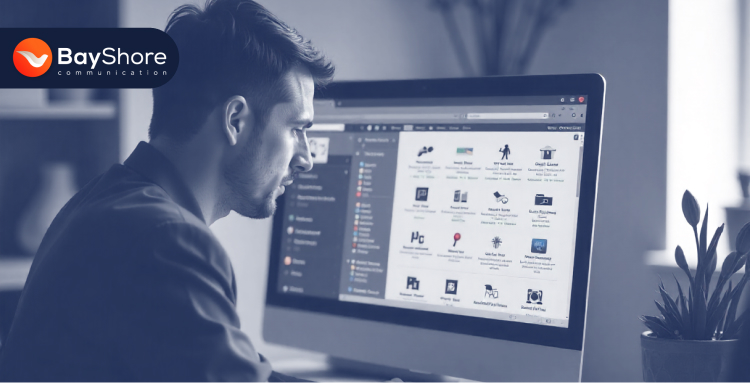
Most service-based business websites don’t fail because people don’t care. They fail because they’re built backwards. Instead of starting with clarity and a conversion strategy, too many businesses get swept up in surface-level aesthetics. They chase trendy visuals, stock slogans, and flashy features that don’t actually speak to the people they’re trying to reach.
Bayshore Communication, we believe good design begins where your customer’s decision-making starts with trust, emotion, and clarity. That means asking the right questions before we ever open a design file. What makes your offer different? What makes someone hesitate before booking your service? What will make them feel heard, understood, and ready to take action?
Most agencies focus on making your site look good. We focus on making it work.
We dig deep into your message, refine your voice, and build copy that reads like a real conversation, not like a brochure. No AI jargon, no buzzwords. Just real words that real people understand. The result is visitors don’t bounce; they stay on the website we build, they read, and they convert.
“Users decide whether to stay on a site within 10 to 20 seconds. Clear value proposition and user-focused content are key to keeping them.”
Source—Nielsen Norman Group
And yes, your website will look stunning. However, every single design element, from color palette to button placement, is chosen with a clear purpose: to build trust and guide your visitor toward saying “yes.”
At the end of the day, we don’t just build websites. We build experiences rooted in strategy, empathy, and business growth. That’s what makes Bayshore different. And that’s why our clients don’t just get clicks; they get proper online visibility even on a small budget.

Great websites don’t happen by accident. They’re built with intention, clarity, and a deep understanding of the people they're designed for. In Bayshore Communication, we follow a proven 5-step process that’s designed especially for companies that provide services. Because when you're selling trust, every click, scroll, and word matters.
It all starts with listening. In the Discovery & Research phase, we take the time to understand not just what you do but also who you do it for. We ask questions most agencies overlook: What makes your clients hesitant? What do they need to feel before they say yes? We treat your audience like our own, digging into their pain points, motivations, and decision patterns until we know them better than your competitors do.
Next, we move into UX Strategy & Wireframing. Think of this as the architectural blueprint for your site. A layout built for clarity, not chaos. Visitors shouldn’t have to guess where to click or what to do next. We map user journeys that guide people gently but confidently from interest to action.
Then comes the part most agencies rush through, the words. Our SEO-Friendly Copywriting isn’t about stuffing in keywords; it’s about crafting language that makes your visitors feel understood. We write like real people, for real people, with messaging that builds trust and earns search visibility.
The design stage is where things get beautiful, however, never just for beauty’s sake. Our conversion-focused design approach uses visual hierarchy, thoughtful spacing, and intentional color psychology to guide attention and spark action. Every button, headline, and visual cues work together to move your visitor one step closer to booking, calling, or signing up.
And finally, Launch is just the beginning. We don’t disappear after going live. Our ongoing optimization ensures your site grows with your business. From A/B testing key pages to improving speed, we continuously tweak and tune based on what’s working and what could be working harder.
“A one-second delay in load time can reduce conversions by 7%.”
Source—Neil Patel / Akamai Research
When the strategy is solid, the design is intentional, and the content is impactful, your website looks impressive. It becomes your best sales tool. Let us build you a site that doesn’t just exist online and wins trust, drives action, and grows your business long after launch.

We believe trust isn’t just built with good design; it’s built with clarity, consistency, and results. When service businesses come to us, it’s often because they’ve done everything and are still not getting real results. We believe in building a brand that connects with people, not just search engines. These are some examples:
Apex Advisors had the expertise. However, their online presence told a different story. Their outdated, cluttered website and inactive social media left visitors confused and disengaged. Leads were slowing down, and client trust was beginning to fade.
What we fixed:
Simplified and modernized the website with a clean, intuitive UI
Rewrote the copy with SEO-driven language that speaks directly to prospects
Reignited their social media with valuable, trust-building content
The outcome:
A polished, professional online presence that restored brand credibility
Higher-quality leads flowing in through both organic search and social
Renewed client confidence and a brand that finally matched their real-world impact
Catflix was a vibrant idea. A blog and store for cat lovers. But its disorganized layout, low visibility in search, and lack of engagement features made it hard to grow an audience or build trust.
What we did:
Conducted UX research to restructure the site around real user behavior
Implemented SEO strategies, resulting in top rankings for keywords like “cats face away from you”
Rolled out community engagement features, influencer partnerships, and strategic content campaigns
The results:
A significant spike in organic traffic
Deeper engagement and stronger brand loyalty from cat lovers across the web
A brand transformation from “cute site” to trusted resource in the pet niche
We don’t just make you look good. We make sure your website, content, and digital strategy work. Let’s build your brand from the inside out.
Working with Bayshore really means custom strategy, not templates. We crafted a a website around your goals, market, and audience behavior. From day one, we write and design with search in mind. Because if no one finds your site, no one hires you.
It’s a Partnership, Not a Project Handoff. We’re in your corner doing testing, tweaking, optimizing, and advising as you grow. Digital trends change fast. We help future-proof your platform so your business stays relevant and ready for what’s next.
You don’t have to figure this out alone. You don’t need to “get tech” or understand design principles. That’s our job.
What you can expect from a conversation with us:
A friendly walkthrough of what’s possible based on where you are now
Real examples of service businesses we’ve transformed
Honest insights, no pressure.
Want to see what your brand could actually become? Book a consultation, and let’s talk through it. Even if you’re just exploring, we’re happy to talk. Because your website isn’t a brochure; it’s your best salesperson.
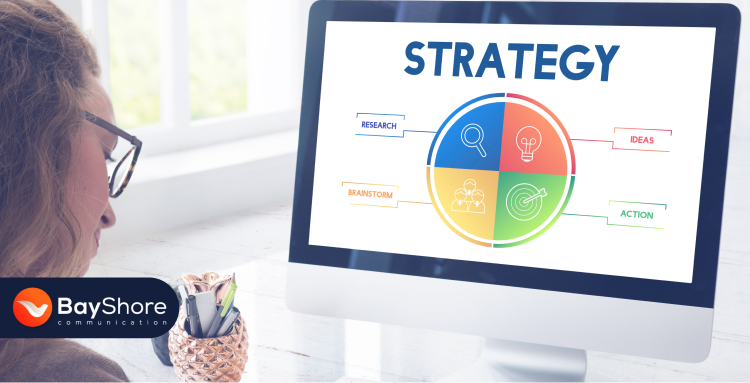
August 24, 2025
Startups often ask how they can build visibility without exhausting their budget. Bayshore Communication regularly sees early-stage businesses struggle with the high costs of traditional PR services, which can range from $3,000 to $10,000 per month (HubSpot). These costs rarely suit businesses trying to grow.
Bayshore encourages founders to focus on scalable, DIY strategies designed to support growth without adding financial pressure. In this blog, we’ll explore practical and affordable digital PR approaches Bayshore recommends for startups working to build their presence without relying on expensive campaigns.
A founder’s personal story often builds the strongest foundation for startup visibility. Bayshore Communication works closely with startups to help craft and share these stories where they matter most, LinkedIn founder posts, Medium articles, and even Reddit industry forums. These are spaces where audiences value authenticity over advertising.
For instance, one founder we worked with shared their transition from corporate life to building a sustainable packaging startup. The result? Consistent engagement and several collaboration inquiries, all without spending on press releases.
“92% of consumers trust real stories over traditional advertising.”
Source: Nielsen Research
Instead of paying for scripted PR campaigns, Bayshore advises founders to speak about what led them to launch their startup and the challenges they are solving today. People respond to stories, not slogans.
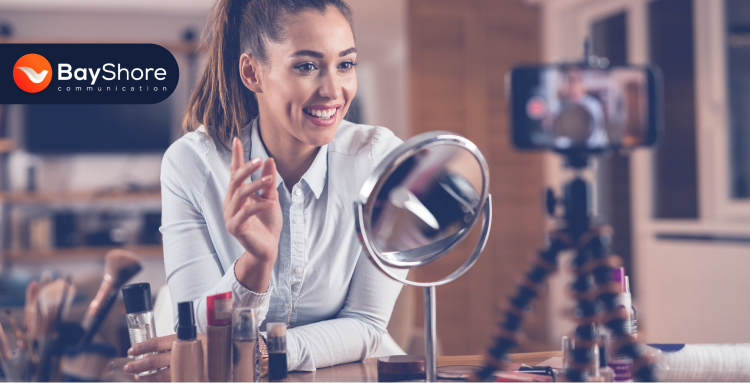
Rather than aiming for influencers with hundreds of thousands of followers, Bayshore recommends working with creators who feel more like genuine advocates, often called micro influencers. Their smaller audiences are usually more loyal and engaged.
Take the case of a wellness startup we worked with. Rather than approach national health influencer
s, we identified six local yoga instructors, each with around 4,000 followers. Their casual Instagram Reels using the product brought in early customers far more effectively than traditional ads.“Micro influencers generate up to 60% higher engagement rates compared to larger accounts.”
Source: Influencer Marketing Hub
Bayshore helps startups find niche creators who align with their brand story, whether that’s a local café owner, a tech blogger, or a student sharing entrepreneurial content.
Bayshore often finds startups chasing large media outlets from day one, which typically leads to silence. Our approach prioritizes niche journalists and local publications that are more accessible and genuinely interested in small business stories.
Consider a craft beverage startup that Bayshore worked with. Instead of pitching national lifestyle magazines, they reached out to regional food bloggers and local newspapers. Within two weeks, they secured coverage in a community magazine and two popular foodie blogs.
“Only 2% of PR pitches convert into media coverage.”
Source: Propel Media Barometer
Bayshore trains startups to simplify their pitches: offer a personal angle, a clear news hook, and avoid corporate jargon. Reporters want a story, not a sales pitch.
Help A Reporter Out (HARO) is an underused tool where journalists request expert input directly from businesses. Bayshore introduces startups to HARO early, knowing it’s a powerful free method to secure credible mentions.
One fintech startup we supported contributed quotes on digital payment trends via HARO and later found themselves cited in an article on Business Insider. That one mention led to increased LinkedIn inquiries from prospective clients.
“Journalists post between 50 and 100 HARO queries daily across industries.”
Source: Cision HARO
Bayshore’s tip? Focus on industry knowledge, not promotional lines. Sharing genuine insight improves your chances of being quoted.

Paid ads often lead to fleeting visibility. Bayshore prefers interactive formats like webinars and live Q&As to build long-term brand familiarity. Instead of delivering a message, you’re opening a dialogue.
One SaaS startup we worked with started monthly LinkedIn Live sessions where their CEO answered audience questions about small business software. Over six months, their sessions consistently attracted 200+ attendees without spending on paid promotions.
“73% of B2B marketers rate webinars as the most effective method for high-quality lead generation.”
Source: Content Marketing Institute
Bayshore recommends founders treat these sessions as conversations, not presentations. Use polls, casual Q&A, or share product stories to foster connection.
Good blogging does more than help your website rank on Google. Journalists searching for expert opinions often stumble upon startup blogs when researching a topic. Bayshore leverages this by guiding startups to create resource-driven blog content.
A cybersecurity startup we worked with blogged consistently about common data protection challenges. Over time, a tech journalist researching password security quoted their blog in an online magazine, without any direct pitch.
“Companies with blogs see a 434% increase in indexed pages compared to those without.”
Source: TechClient
Bayshore advises startups to focus blogs on industry challenges, lessons learned, and customer success stories. These become passive PR assets over time.
Bayshore encourages founders to watch industry conversations and participate thoughtfully, even when not directly tagged. Reacting to new regulations, sharing opinions on tech shifts, or commenting on customer challenges positions your startup as active and aware.
A legal tech startup we supported shared its insights whenever regulatory updates were announced. Within weeks, their posts began getting reshared by legal journalists and consultants.
“Businesses engaging in trends see 33% higher visibility rates.”
Source: Social Media Today
Bayshore reminds startups that consistency and authenticity matter more than chasing trending hashtags without context.
Customer stories are one of the most underutilized PR tools. Sharing photos, videos, or case studies from real clients builds credibility. Bayshore helps startups curate this content naturally, avoiding staged testimonials.
For example, a small fashion brand we worked with reposted customer photos wearing their products at local events. These genuine moments drove better engagement than polished photoshoots and led to features in two fashion blogs.
“79% of consumers say user-generated content directly influences their purchase decisions.”
Source: Stackla Study
Bayshore encourages highlighting customer voices through short stories, social reposts, or even casual interviews featured in blogs.

Being listed in industry directories or winning local awards signals credibility that PR dollars often struggle to buy. Bayshore advises startups to submit applications wherever relevant,local chambers, industry associations, even small competitions.
A food delivery startup we worked with earned ‘Startup to Watch’ recognition from a regional business journal. That single listing led to interview requests and new partnerships.
“81% of startups gain early-stage visibility through online awards and directories.”
Source: Startup Grind Data
Bayshore also supports startups in launching small, creative campaigns like product giveaways or founder-led challenges, which can gain media attention when framed as human-interest stories.
Curious to see how these strategies work in real scenarios? Read our related posts to explore more practical insights for startups.
From Branding to Conversions: Creating a Successful Marketing Funnel
Cost-Effective Business Expansion with Offshore Support Solutions
Instead of pursuing every digital PR channel, Bayshore guides startups to evaluate their resources and select two or three methods that feel sustainable. Whether it’s a focus on founder-led content and HARO, or customer stories and influencer collaborations, a focused effort consistently outperforms scattered attempts.
PR is a long-term effort. By choosing what works for your team now, your startup builds visibility naturally, without exhausting energy or budget.
PR thrives on connection, real people, real stories, and the right timing. We’ve seen that every startup carries something worth sharing. Not every journey starts with a headline. Some begin with a simple post that hits the right note or a journalist who connects with your perspective.
We don’t push loud campaigns or expensive layers. Instead, we guide founders toward choices that reflect their voice and match their pace. A customer win, a thoughtful founder insight, a timely industry take, these often bring more value than polished press releases.
Our focus stays on visibility that works with your resources. If you're shaping your startup story and want to explore what might support that next step, contact us. We’re here to help you think through the options.

August 21, 2025
Scrolling has become the new way to attract attention. That is the world we are living in now. Before anyone comes to your open house, they check out your Instagram. Your next buyer could be sitting on their couch, sipping coffee and casually swiping through listings, and if your name doesn't appear, they'll move on. Fast.
Great listings do not sell themselves. Not any longer. The agents getting callbacks and showing requests? They have perfected the art of showing up online, establishing trust before the first hello. Don't worry, you don't have to dance on TikTok or write a novel in your captions to accomplish this.
We're breaking down what works in social media marketing for Tampa real estate agents and showing you how Bayshore Communication can help you stay visible, relevant, and ahead of the competition.
Consider this: your listings compete not only with other houses, but also with puppies, foodies, and vacation posts in an endless scroll. 96% of buyers start their home search online.
If almost everyone starts their house hunt online, shouldn’t your first impression be digital? On top of that, 80% of real estate agents burn out within their first two years.
Why? Because traditional marketing methods such as printing flyers, knocking on doors, and awkward open-house greetings are time-consuming and low-return.
Posting on social media allows you to gain momentum without depleting your energy. Then there's the results-driven momentum. 54.2% of real estate agents now invest over half their marketing budget into digital channels. Because smart digital moves drive 300% more traffic than traditional methods.

Posting the same old listing photo with "Just Listed!" at the top will no longer suffice. If you want to catch people's attention (and hearts), your social media presence must be creative, consistent, and have that distinct Tampa touch. Here's how to get it done:
Reels That Feel Real
Use Reels to share mini home tours, sneak peeks of your day, or even quick tips for first-time buyers. Show off the view from the backyard, a cool feature in the kitchen, or a sunset on Bayshore to give them a reason to feel something.
Keep it casual. Add trending audio, use natural lighting, and talk like you’re chatting with a friend, not pitching to a client.
Smarter Hashtag
Hashtags are more than just text; they're a free billboard. Mix general ones like #TampaRealtor or #FloridaHomes with more neighborhood-specific tags like #HydeParkLiving or #RiverviewHomes. Think about where your ideal buyer wants to live and tag accordingly.
And, yes, remove the 30-hashtag copy-paste blocks. Keep them clean, relevant, and rotated to keep your audience engaged.
Stories That Start Conversations
Magic takes place in stories. Use them to express personality and generate interest. Polls, "this or that" sliders, behind-the-scenes clips, and quick Q&As encourage people to tap and talk.
You do not need to post every hour; simply show up a few times per week in an authentic manner. Whether you're at a closing, getting some Cuban coffee in Ybor, or staging a new home, keep your followers updated.
Tampa Vibes Over Templates
Do not just post houses in Tampa. Share the lifestyle. Feature your favorite local café, take a walk along your favorite trail, highlight family-friendly neighborhoods, or promote a weekend event. People are buying into a community rather than just a home.
Our motto is "Be the brand they remember, not just the agent they scroll past." Your brand is what remains visible after the scroll. It's more than just your logo or headshot; it's how you appear online, how you sound, and how people feel when they visit your page. You don't have to rely on guesswork with Bayshore Communication. We help Tampa agents build a brand that speaks volumes even when they're not working.
Look the Part with Bayshore's Visual Branding Kits
A disorganized feed with conflicting fonts and random colors? Nope. Bayshore designs cohesive visual branding kits specifically for Tampa agents. We assist you in selecting a clean logo, strong colors, consistent font styles, and graphic templates that make your posts instantly recognizable. You will appear polished, professional, and put together because you are.
Find Your Voice (And Let Bayshore Amplify It)
It is not necessary to sound like every other agent in town; instead, you should sound like yourself. Bayshore can help you define a memorable personal voice, whether it's warm and friendly or sharp and direct. We'll even create custom caption templates, bio ideas, and post themes to ensure your feed conveys your message clearly and confidently.
Showcase the Tampa Lifestyle—Bayshore Will Lead the Way
Your audience isn't just looking for square footage. They want to get a sense of the kind of life they could lead. That is why Bayshore generates content ideas and visual themes based on local lifestyle, such as park spotlights, café shoutouts, and weekend event plugs. We ensure that your brand feels integrated into the Tampa community rather than floating outside of it.
Bayshore all-in-one branding kits in a nutshell:
Logo design and brand color palette
Monthly content calendars tailored to Tampa real estate
Caption writing, visual mockups, story post templates
And guidance from people who actually understand this market
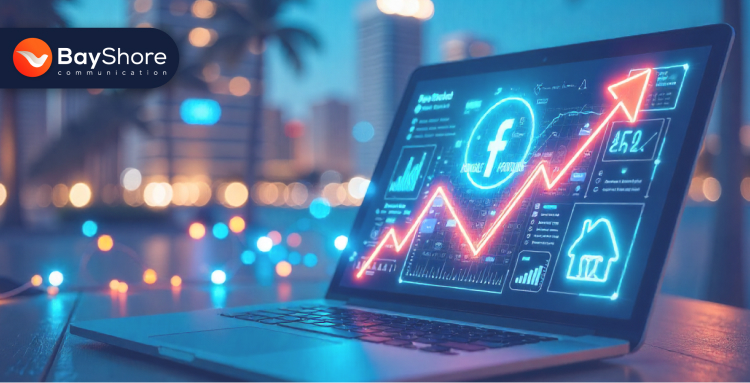
Stop wasting the money. Start boosting precisely. If you spend money on ads without a strategy, you're likely wasting money on likes that never convert into leads. Bayshore teams bring a smarter, sharper approach tailored to Tampa's real estate scene.
Target the Right Buyer, Not Just Any Buyer
We design campaigns with purpose. Whether you're selling a downtown condo or a family home in Carrollwood, we customize each ad to attract the right buyers based on location, interests, budget, and purchasing habits. Our advertising specialists understand how to tap into Tampa's micro-markets and get your listing in front of people who are actively looking.
From Budget Burn to ROI Gold
You don't need a large advertising budget; all you need is one that is used properly. Bayshore creates Facebook and Instagram ad funnels that convert interest to action. Instead of wasting money on random clicks, we prioritize retargeting strategies, lead forms, and call-to-action setups that convert.
Boosting ≠ Paid Ads (Here’s the Difference)
Boosting a post generates likes. Perhaps a few comments. However, true paid ads? They increase traffic, generate leads, and move listings. We set up full ad campaigns using Facebook Ads Manager, giving you complete control over objectives, targeting, and tracking.
Tampa Agents Are Already Seeing the Results
We’ve helped local agents double their showing requests in just a week. One South Tampa realtor saw her new listing fill up with tour appointments within 48 hours of launching a Bayshore campaign. Why? Because we fine-tune every step from creative to copy to where your ad appears on screen.
We know Tampa zip codes like our morning coffee order. From Davis Islands to Brandon, Bayshore knows which pockets move quickly, which require extra attention, and how to target each appropriately. Whether you're targeting out-of-state investors or local buyers, we'll help you hit the mark every time.

Between juggling showings, managing contracts, and following up with leads, most Tampa agents barely have time to eat, let alone plan content, track ad metrics, or film a reel. And that’s okay. You don’t have to do it all.
We help you stay visible, consistent, and competitive online without you lifting a finger. Whether you're just starting out or you're already busy with back-to-back closings, we step in as your behind-the-scenes marketing team.
We get what makes Tampa real estate unique, and we use that local insight to create branding, content, and ad strategies that match your goals and your calendar.
So if social media feels overwhelming, if branding feels confusing, or if digital marketing just keeps falling to the bottom of your to-do list... it’s time to call in help that gets it.
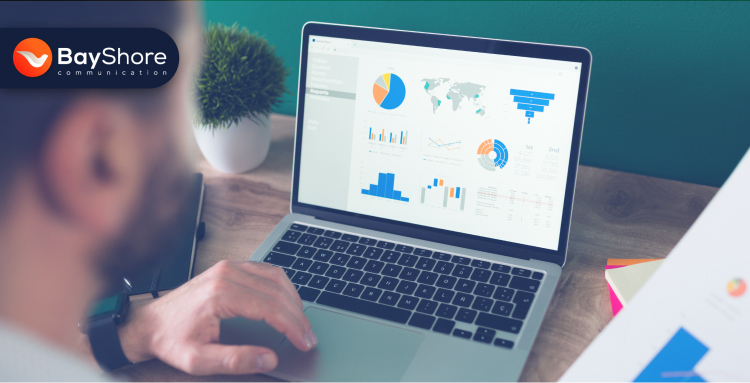
August 11, 2025
No one scrolls to Page 2 on Google. If you’re a plumber, electrician, pest control pro, or any other service-based business in Tampa, your next customer is probably searching right now. And chances are, they’re not even clicking your website; they’re checking your Google My Business (GMB) listing.
46% of all Google searches are looking for local info. And if it’s a listing with a complete profile, it’s 2.7x more likely to be seen as reputable.
So if your GMB listing looks half-baked or outdated, you’re basically handing leads to your competitors. Don’t worry. I’ll break down exactly how Tampa service-based businesses can make the most of GMB.
If you're still treating Google My Business as just another listing site, it's time for a reality check. This is no longer 2015. Today, your GMB profile is the first thing people see when they search for local services, and it has a significant impact on whether they choose you over someone else.
It can be compared to your digital handshake. A strong one establishes trust quickly. Is it a weak or out-of-date one? That is how leads slip away. Here's why GMB is more important than ever for Tampa service businesses.
The Local Pack Offers Prime Real Estate.
When you search for "AC repair near me," do you see the box with the top three businesses? This is known as the Local Pack. Showing up there means more attention to you and fewer clicks for your competitors.
Your Reviews Speak Volumes.
People place their trust in others. GMB prominently displays your best reviews. That social proof frequently determines whether someone calls you or moves on.
Accelerates Real-World Outcomes.
This is not just about visibility. Someone can call, text, or get directions with a single tap without ever visiting your website.
“Businesses that show up in the Google 3-Pack receive up to 70% of local traffic clicks.”
Source — Search Engine Journal
Google wants to reward businesses for maintaining accurate, active, and helpful listings. This means that optimizing your GMB profile isn't just smart; it's also required if you want to compete locally.
It's no secret that Tampa's service area is crowded. Plumbers, HVAC technicians, cleaning crews, pest control services, you name it. If you want to be visible and stand out, your GMB listing must go beyond simply existing. It must serve your purpose. Here is a step-by-step guide to dialing it in:
Choose The Appropriate Business Category.
Google matches you with searchers based on your primary category. Make sure you are specific. Instead of simply saying "Contractor," use "General Contractor" or "Drainage Service". This single field determines everything from visibility to which features you can unlock.
Upload Authentic, High-Quality Photographs.
Stock photographs will not suffice. Post real photos of your work, your team, your truck, or anything else that will help build trust. Businesses that have photos receive more calls and directions, plain and simple.
Create A Clear, Keyword-Rich Business Description.
Speak as if you are a local. Mention the services you provide, the areas you serve, and anything unique about your business. Include location-specific keywords, such as "Tampa pressure washing" or "South Tampa handyman."
Smartly Add Service Areas.
You are not limited to a single zip code. Add all of the neighborhoods you actually serve, such as Hyde Park, Carrollwood, and Brandon, so that people searching nearby can find you.
Use Google Posts and Q&A weekly.
Think of posts as mini-advertisements. Share news, promotions, or seasonal advice. Also, do not forget to answer common questions in the Q&A section to build trust. It helps with ranking.
“Businesses that post weekly on GMB get 17% more customer actions, like calls and website visits.”
Source — BrightLocal

Most Tampa businesses are unaware that simply polishing their Google profile is insufficient. Google scans your entire web presence. If your business information is inconsistent or scattered across directories, Google becomes suspicious and your ranking suffers. That is where Bayshore Communication's local listing expertise truly shines through.
Full-Scale Local Audit
We do not just fix one listing; we check Google My Business, Bing Places, Yelp, Apple Maps, Facebook, and other relevant Tampa directories. We uncover duplicates, old business names, and out-of-date contact information, all of which Google flags.
Nap Sync And Cleanup
We standardize your name, address, and phone number to ensure that everything matches across the web. That clean consistency is a trust signal that Google values, and it helps you rise in Local Pack rankings.
Building Citations Using Local Credibility
Bayshore does not go after generic directories. We prioritize high quality. Tampa-specific options include local business associations, blogs, and event websites. This increases relevance and authority in areas where it matters.
Automation And Alerts For Future Changes
Have you moved your office? Changed your phone? No need to worry; our team monitors all listings and automatically pushes updates. There will be no manual tracking. Your information is consistently accurate.
Reputation Management With Review Strategy
We do not just ask for reviews. Bayshore assists in developing a process that encourages satisfied customers to leave and labels them where they are most important. We also respond quickly to reviews, making your listing appear active and engaged.
Transparent Reporting And Analytics
You receive monthly insights, not just guesses. You'll see which directories drive traffic, how your reviews are trending, and which listings have been updated. You can track all of your progress based on data.
“78% of location-based searches result in an offline purchase.”
Source — Google Think
When someone types "air duct cleaning Tampa FL" or "emergency plumbing South Tampa," all of your synced listings send Google a clear message: you're local, active, and dependable. Google consistently provides you with prime real estate in the Local Pack.
In comparison, many Tampa agencies simply fix your GMB listing and call it a day. Bayshore takes it a step further, aligning your entire online presence with your Tampa service area.
More clicks.
More calls
More clients walking through the door

Ranking higher on GMB is not a matter of luck; it is the result of consistent signals that inform Google that your Tampa business is legitimate and active. Here's what matters and how Bayshore Communication outperforms the competition:
1. Reviews: Quantity and Speed Are Important.
More reviews equals more trust. However what about timely responses? That is what really captures Google's attention.
Google rewards businesses that respond quickly, particularly within a few days.
We create triggered review requests and handle responses in your voice, so you don't miss a beat.
2. Frequent And Genuine Photo Uploads
Regularly uploading photos tells Google that your listing is active.
Bayshore creates a content calendar that highlights your team's day, completed jobs, tools, and even behind-the-scenes shots with a Tampa twist.
We also properly tag photos so Google knows which services to rank you for.
3. Pin Placement That’s Spot-On
One misplaced marker can drop you in search by miles.
We manually verify your point on the map, double-check competitor pins, and ensure that every area you serve is correct, which is especially useful for multi-zip service zones.
4. Keyword-Rich, Client-Oriented Descriptions
Google reads your descriptions, as do potential customers.
Bayshore writes concise, local-focused blurbs such as "Emergency AC repair South Tampa" and "Hyde Park light plumbing."
We also A/B test various phrases to see which ones generate more clicks and optimize accordingly.
5. Citations & Backlinks from Local Tampa Sites
Google prefers signals from reliable local sources.
Bayshore researches Tampa blogs, charities, and chamber sites to get your company mentioned with links.
Unlike competitors who spam low-quality directories, we prioritize credibility, such as TampaBay.com features, Tampa Chamber links, and local event sponsorships.

Running a Tampa service business is difficult enough without having to battle Google listings, updates, and SEO every time the phone rings. Bayshore Communication steps in with a smarter, data-driven strategy that outperforms the competition.
Tampa-based local SEO expert.
Unlike generic agencies, Bayshore understands Tampa's neighborhoods, slang, and seasonal service demands. That local edge allows you to customize your GMB listing in ways that others cannot.
Data-driven success with GMB
Our clients consistently rise to the coveted Local Pack and remain there. While competitors frequently perform one-time cleanups, Bayshore runs ongoing campaigns. This includes fresh photo uploads, keyword updates, and review campaigns to ensure that your listing never stalls.
Managing full-stack listings and reviews
We handle everything, including GMB, Yelp, Bing, Apple, niche Tampa directories, manual review responses, review request automation, citation cleanup, and complete building from start to finish.
Crystal-clear reporting with dedicated support
You receive a monthly dashboard that displays your review count, photo uploads, ranking gains, and traffic from listings. Our team explains everything so you understand exactly where your money is going.
Therefore, with Bayshore on your side:
Your GMB, reviews, citations, and maps are always accurate, active, and fresh.
When you reclaim your workday you focus on service, not software.
You start ranking higher, getting more calls, and converting more leads without wondering, “What now?”
Visit Bayshore Communication and send a quick message through the contact form. Our team will review your needs and guide you toward becoming Tampa’s most visible service provider.

July 29, 2025
Tampa is buzzing with startups, new ideas, remote-first teams, and fresh investor dollars fueling growth. It’s no surprise Tampa landed in the top 10 emerging tech cities in the U.S., according to CBRE’s Scoring Tech Talent Report.
While many startups focus on flashy branding, the real breakthrough for 2025 is digital marketing, the difference between a bright idea and a brand that actually scales. That’s why smart strategy matters. Not cookie-cutter plans, but approaches built around Tampa’s unique market, its business pulse, and what local customers truly expect.
Ready to see what’s working right now and what could leave your startup stuck in the noise? Let’s get started...
New businesses often face crowded markets, limited resources, and pressure to build traction quickly. Many jump into content, ads, or social media without a proper roadmap. That’s where smart strategy changes the equation.
We start from the inside out. Rather than focusing solely on the product or service, we build strategies around the buyer. What are their behaviors? What platforms do they frequent? What type of messaging resonates in a Tampa context?
We create layered strategies:
We develop clear positioning so your business is never mistaken for the competition.
We match the message with the moment, helping you stay relevant to what your audience actually wants.
We select platforms that reflect how your audience engages, not just where you hope they’ll show up.
This thoughtful, layered process results in a strategy that isn’t just organized, it performs.
Buyer-first strategy is a structural shift in how successful Tampa startups think. Instead of chasing general visibility, they build intentional systems that keep prospects moving toward action. That’s the difference between noise and traction.
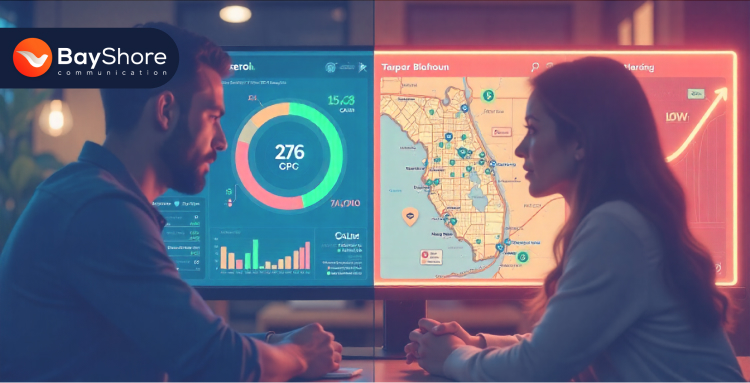
Online advertising costs have climbed sharply. In Tampa, the average cost-per-click (CPC) reached $2.76 in 2024, according to WordStream. Many startups spend thousands on ads that simply don’t convert. This isn’t due to a lack of effort; it’s often a mismatch between audience targeting, message clarity, and timing.
We take a more refined approach. We recognize the importance of return on investment from the first dollar.
Our campaigns use:
Geo-targeting that breaks the city into relevant, neighborhood-specific zones
Lookalike audiences developed from actual customer engagement patterns
Mobile-first ad designs that match how Tampa consumers interact throughout the day
We launch ads with minimal risk, run quick A/B tests, and expand only after validating what works. This way, ad spend becomes scalable, not stressful.
Rising costs haven’t erased opportunity; they’ve sharpened the need for precision. When Tampa startups pair creative ads with localized targeting, the outcome isn’t more spending, it’s better spending.
People in Tampa aren’t just searching, they’re acting on their searches. When someone types in "coffee shop near Hyde Park" or "tech recruiter in Tampa," they’re often just minutes from making a decision.
"78% of local mobile searches lead to purchases within 24 hours."
Source: Think With Google
That’s why local SEO holds power for startups. It brings your business closer to the people already looking for it. You don’t have to fight for attention; you just need to show up accurately.
Bayshore’s Local SEO process includes:
Google Business Profile optimization with photos, reviews, and Q&A sections
Schema markup to help search engines interpret your content correctly
Neighborhood-based keywords that reflect how locals search ("near Curtis Hixon Park," "in Westshore Plaza," etc.)
These refinements allow your startup to rank for highly targeted searches, making every view more likely to turn into a visit, call, or purchase.
Local SEO isn’t about chasing page-one rankings on broad terms. It’s about relevance at the hyperlocal level, meeting real people where they search, in the context of their neighborhood, not just their city.
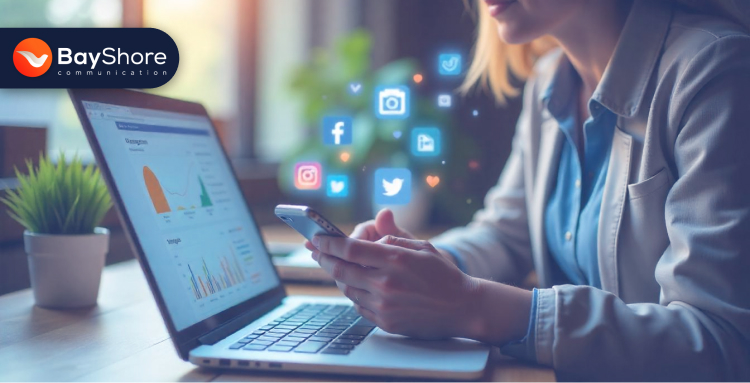
Your website is often the first impression, the digital storefront, and your strongest closer, if it’s built with intent.
"70% of users say website design directly affects their trust in a brand."
Source: Stanford University, 2023
In Tampa, where consumers are presented with local and national options alike, your website’s design and speed influence everything from bounce rates to conversion.
Our approach is focused on:
Load speeds under 2.5 seconds, especially for mobile users
Clean interfaces that reduce decision friction
Call-to-action placements that align with browsing behavior
One Tampa-based e-commerce brand doubled its lead conversions in less than 60 days after a full redesign. Traffic remained the same, experience made the difference.
We view web design as part of your marketing strategy, not a separate design task.
When a site performs as an engine rather than a placeholder, it changes how every campaign behaves. Ads convert better. SEO delivers more value. Emails get more clicks. That’s the kind of shift that shapes growth.
Many startups feel the urge to be present on every social media platform. It often leads to burnout and diluted messaging. The more impactful route? Focus.
Bayshore helps new businesses choose one or two platforms that align closely with their audience’s habits.
For Tampa-based brands, that often means Instagram, Facebook, or even Threads, depending on the demographic. Once we’ve selected platforms, we build content strategies that speak directly to local culture.
Our process includes:
Visual storytelling through photography and video
Real-time event coverage to tie your brand to city moments
Founder-focused posts that build personal connection
A wellness brand in South Tampa is committed to IG Lives and intentional visuals. Over the next 90 days, their engagement rate jumped fivefold because they told stories, not just posted promotions.
"Brands that focus on two or fewer social channels see 38% more engagement per post."
Source: Sprout Social, 2024
Fewer channels mean more room for meaningful content. It means showing up with consistency, not noise. And it gives early-stage brands the ability to measure what actually works, instead of trying to be everywhere at once.
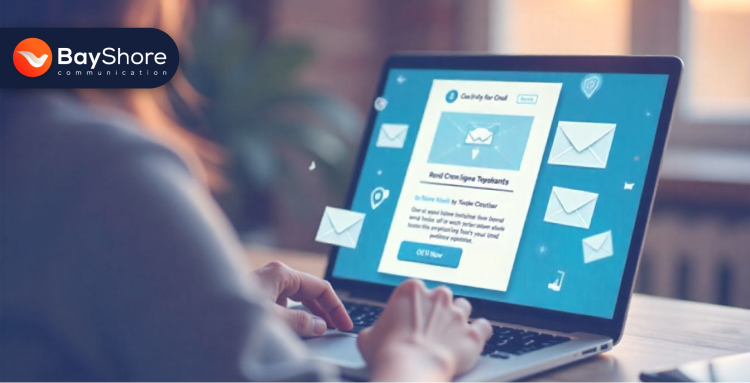
Email isn’t outdated, it’s simply underutilized. When used well, email drives conversation, conversions, and retention.
Startups have the opportunity to make their email strategy foundational from day one. Bayshore builds email systems that work with your overall marketing goals.
We create:
Welcome flows that introduce your values and offerings
Behavior-based triggers for product views, cart activity, and sign-ups
Geo-targeted newsletters that reflect Tampa events, weather, and seasonal preferences
Rather than overloading your audience with promotional blasts, we build rhythms. Weekly or biweekly communication with a consistent tone and clean formatting creates trust.
When startups treat email like a brand-building tool rather than a sales channel, the difference shows. Subscriptions grow. Responses increase. Conversion paths become clearer. It’s simple, structured communication that scales.
Data only works when it’s readable. Most startups gather metrics across multiple dashboards without knowing what to focus on, or how to respond to what they see.
That’s why we create focused dashboards that answer real business questions. No graphs for the sake of graphs.
What we track:
CAC (Customer Acquisition Cost)
ROAS (Return on Ad Spend)
Retention and bounce rates segmented by source
We set monthly check-ins with our clients to talk through numbers in plain language. If the data shows a drop in engagement on a specific channel, we pivot. If a certain offer drives higher click-through, we amplify.
Planning your digital moves in Tampa this year? These follow-up posts add more direction.
From Branding to Conversions: Creating a Successful Marketing Funnel
Cost-Effective Business Expansion with Offshore Support Solutions
Bayshore Communication works at the intersection of refinement and relevance. As a boutique, full-service digital partner, we bring Tampa-rooted awareness and big-league execution to every project, whether that’s SEO built to win locally, PPC campaigns with measurable returns, or brand design that actually reflects who you are.
We operate with precision, not volume. Each engagement is grounded in startup realities, tight timelines, shifting goals, and the need for lean systems that perform. That’s why founders trust us to shape not just campaigns, but momentum.
If you're building something in Tampa and need a digital partner who works with clarity and care, reach out to Bayshore Communication for a private consultation.

July 29, 2025
Most emails never get opened. They're lost somewhere between a coupon for dog treats and a reminder to review your last order. Inboxes are noisy. People scroll fast.
But when an email feels personal, like it actually sees the person behind the screen, it makes someone pause. Maybe even click. Maybe even buy.
For Tampa-based e-commerce stores, where competition is growing and customer attention is fleeting, email is both a marketing channel and a lifeline. So what separates the emails that get ignored from the ones that drive sales? Let’s break it down.
Sending the exact same email to your entire list might seem efficient, though it creates a message so broad it barely lands with anyone. Tampa’s neighborhoods reflect a range of preferences and shopping behaviors. A subscriber in Westchase may not be drawn to the same promotion as someone in Ybor City. The challenge lies in recognizing these distinctions and responding to them with thoughtful segmentation.
“72% of shoppers ignore emails that aren’t personalized.”
Source: SmarterHQ
Blanket campaigns feel impersonal because they are. Instead of building relationships, they create digital noise. People want to feel seen, and they act when content feels specifically written with them in mind.
What Bayshore Does: We design segments that reflect real-time behavior, location data, purchase history, and engagement trends. Tampa audiences receive content that fits their context, not just a general announcement.
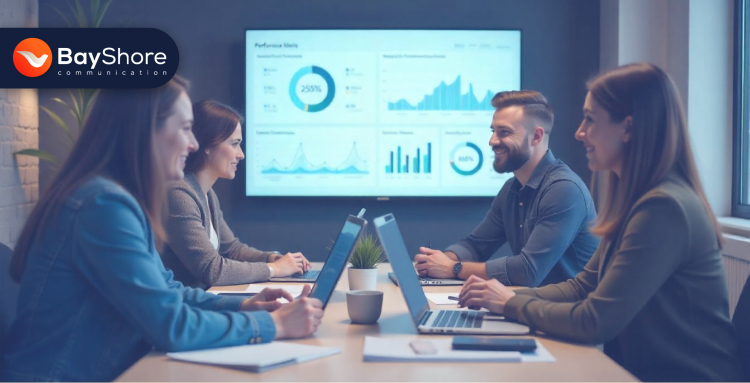
Most emails are fighting for attention in already crowded inboxes. If your message lands during a commute or while someone’s multitasking midday, it’s likely to be missed—even if the content is great. Timing isn’t just about hitting “send”; it’s about understanding when your audience is actually ready to engage.
“Florida’s highest open rates happen mid-morning on Tuesdays and Wednesdays.”
Source: Campaign Monitor
Generic scheduling often relies on national averages. Local behavior patterns vary, and so should your email timing. Tampa shoppers have their own flow, work routines, school pickups, and weekend rhythms that influence how they interact with brands.
We don't rely on intuition. Instead, we analyze your unique open rates, align them with Tampa-based engagement trends, and time your campaigns to land when your audience is most likely to pay attention.
The average inbox is flooded with subject lines every day. Shouting things like “FLASH SALE” or “LAST CHANCE” just doesn’t cut through the noise anymore. It’s about being sharper and more intentional with your words.
“Personalized subject lines increase open rates by 26%.”
Source: Experian
People don’t ignore emails randomly. They assess value within seconds. If the subject line feels templated or impersonal, it signals that the message inside will be too. Strong open rates begin with subject lines that feel relevant, timely, and genuine.
We create subject lines that connect with your audience’s mindset using local touches, behavioral insights, and timely angles. Every campaign includes A/B testing to find the wording that grabs attention without coming across as pushy or overdone.

Tampa’s a city in motion. Shoppers are checking emails on the go between errands, in line, or during quick pauses in their day. If your emails are built for desktops first with cluttered layouts, tiny fonts, or links that are hard to tap, you’re likely losing their attention before they even see your offer.
“74% of emails are opened on smartphones.”
Source: Statista, 2024
Mobile optimization is more than resizing content. It’s about rethinking how emails are structured for screen size, reading behavior, and touch interaction. If visuals don’t load quickly or links aren’t easily clickable, you risk immediate drop-offs.
Our design team builds emails for thumb-friendly reading. That means mobile-first layouts, tap-sized buttons, short preview text, and responsive design that holds attention on every screen, from the latest iPhone to older Androids.
Open rates may offer a quick metric, though they rarely tell the whole story. A campaign can look successful on the surface while silently underperforming in conversions. Without knowing how far readers scroll, where they click, or when they abandon, stores are left guessing.
“Only 32% of small businesses actively track email conversions.”
Source: Ascend2 Report
Even well-crafted emails require context. What happens after a reader opens? Do they explore the site? Make a purchase? Revisit the cart later? These answers come from performance mapping, not assumptions.
We go deep into user behavior. Scroll depth, heatmaps, device type, and dwell time we study all of it. Then we adjust the creative, layout, and links based on that behavior so the next email builds on actual results, not speculation.

Automation saves time. However, if flows aren’t intentional, they create friction. A cart abandonment email that arrives days late or a welcome message that sounds like it was built five years ago doesn’t foster loyalty; it creates distance.
“Well-executed automations significantly increase engagement and revenue.”
Source: GetResponse
Templates that sound too corporate or disjointed make emails feel automated in the worst way. Your customers don’t want to be funneled through a system; they want to feel like there’s a person behind the send.
What Bayshore Does: We map dynamic email journeys that move naturally. From purchase follow-ups to reactivation messages, each step feels personal. Messaging is written with intention, so automation supports your relationships instead of replacing them.
When people unsubscribe, it’s usually not due to one bad campaign. It’s cumulative, too many irrelevant messages, poorly timed content, or a voice that doesn’t feel aligned with the brand. Over time, readers stop seeing value and choose to opt out entirely.
Volume without clarity often leads to fatigue. It’s not always about how often you send. It’s about how well each message fits the reader’s expectations.
We help brands rebuild trust and stay welcome in the inbox. That starts with adding preference centers, fine-tuning email frequency, and regularly checking list health. When subscribers feel in control, they’re more likely to stay engaged.

Email marketing works when every part of it is intentional. Design, timing, targeting, and message all need to align. Many Tampa e-commerce stores know this in theory. Execution, however, is where things tend to slip.
Our Full Process Includes:
Real-time segmentation driven by local trends and customer behavior
Mobile-first design suited to Tampa’s daily rhythms
Custom-written subject lines tested to find what truly connects
Automated flows that feel timely and personal
Continuous monitoring and live tweaks to keep performance sharp
Our approach is about building a complete system that treats email as an evolving conversation, not a broadcast. And that’s where Tampa stores begin to see a shift from passive opens to meaningful clicks to loyal repeat buyers.
If precision and performance matter to you, our related pieces offer valuable context and direction:
From Branding to Conversions: Creating a Successful Marketing Funnel
How Emerging Technologies are Transforming Business Operations
In a city where expectations are high and audiences are discerning, Tampa’s e-commerce brands are choosing partners who value clarity, substance, and a refined approach. Bayshore Communication works with businesses that view email not as a task to check off, rather as a core part of how their brand is experienced.
We approach every project with intention, grounded in data, shaped by tone, and built around how your customers prefer to engage. Our clients often reach a stage where their communication needs to evolve. They’ve grown, their audience has shifted, and the messaging must reflect that progression.
Bayshore offers that next level, not through volume, rather through balance, relevance, and consistency. If your brand is ready for that step, we’d be pleased to speak with you. Reach out to schedule a consultation or request a complimentary review of your current email strategy.
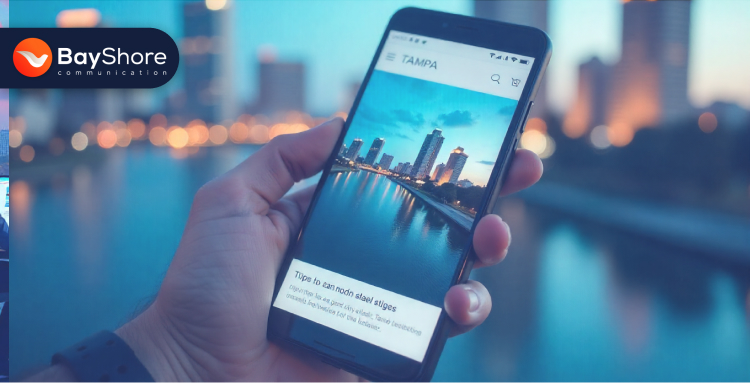
July 29, 2025
In Tampa, where the sun’s bright and the pace is faster than ever, screens aren’t just screens anymore. From busy commutes to quick coffee breaks, people reach for their phones first, scrolling through a world that never slows down.
Ignoring mobile optimization today is both a missed opportunity and a silent invitation to fall behind. However, mobile optimization goes beyond simply shrinking websites to fit smaller screens. It's about creating seamless, intuitive experiences that meet people right where they are regardless of device, time, or location.
So, what does mobile optimization really mean in Tampa’s digital scene? Let’s explore.
Tampa users expect digital experiences that feel effortless. When a page stalls, menus vanish, or forms ignore basic input tools, most won’t hesitate to leave. There’s a clear expectation now—one rooted in efficiency, not patience.
“79% of users leave a site that’s difficult to use on mobile.”
Source: Google UX Report
Frustrations like misaligned text, buttons too small to tap, or forms that won’t support autofill aren’t minor flaws. They’re signals, telling users that your site isn’t worth the extra effort. And in a market where convenience wins, those signals matter.
We redesign mobile layouts based on how users actually behave. Every element is positioned to encourage easy scrolling and fast decision-making. Buttons have enough space to prevent accidental taps, and forms work smoothly without frustrating retyping or hidden fields. The result is a site that feels natural and reliable, whether visitors are exploring from downtown Tampa or on the move.
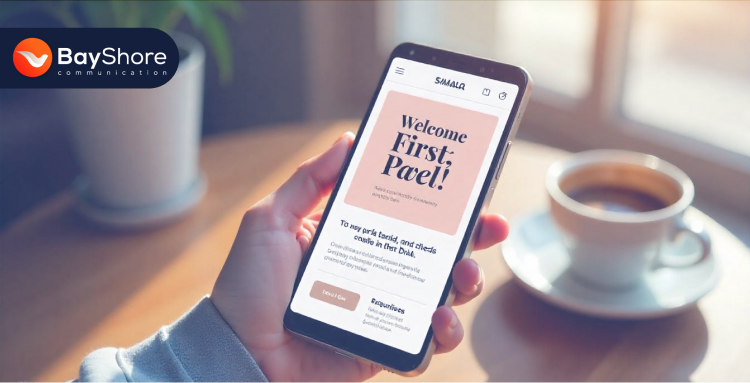
Every second counts when a potential customer is ready to take action. And yet, something as simple as tapping a phone number often fails. Users expect to click a number and start a call instantly. If that feature doesn’t work, they won’t try again. They’ll just move on.
The same goes for contact forms. On mobile, even the slightest delay, awkward formatting, or malfunctioning submission can derail a service inquiry or booking attempt. The issue here is functional neglect. Many businesses launch a site with working features, only to let those features decay with time or mobile updates. A clickable number becomes plain text.
A once-smooth form now gets stuck midway or won’t submit at all on certain devices. These are missed opportunities, especially when users are ready to connect.
We start by testing usability on real devices to pinpoint where users struggle and understand why. Then we fix those issues right at the source. Our team implements fully responsive, device-friendly tap-to-call buttons that work seamlessly across all platforms.
Contact forms are configured for fewer fields, quicker load times, and neat alignment. We also embed maps that display properly on mobile, so users don’t have to switch apps. It’s all about making every interaction as smooth and effortless as the intention behind it.
Search engines now view your mobile site as the primary version. This is a major shift in how discoverability works. Google uses your mobile version to determine rankings, especially for local searches. When your site doesn’t function well on mobile, you lose visibility right from the source.
A slow-loading mobile site signals to Google that it’s a poor user experience. If the layout breaks, menus don’t render, or content shifts unpredictably, the algorithm pushes it down. For businesses in Tampa trying to compete for local eyes from South Howard Avenue to Ybor City, it can be devastating.
We conduct comprehensive mobile SEO audits to see exactly how search engines view your mobile site. Our analysis goes beyond design, checking backend setup, CSS delivery, and content formatting. Using industry-standard tools and real-device emulators, we identify and fix the specific issues that hurt your mobile rankings. Then, we optimize your site structure to ensure it performs smoothly and gets noticed when it counts.
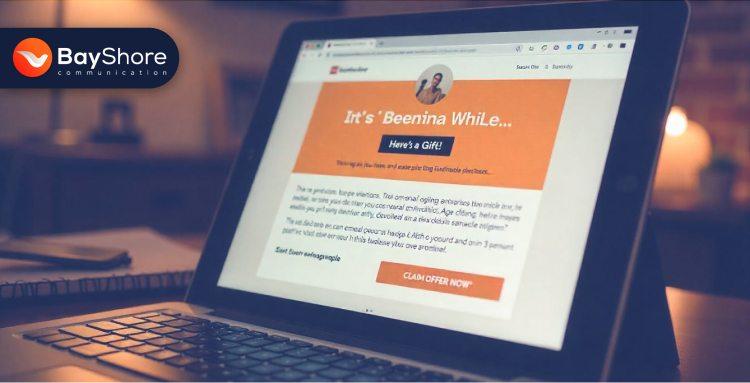
Business owners naturally check their websites from a place of convenience. Often, this means using a single, updated device on a stable Wi-Fi network. Everything loads fast, interactions seem smooth, and the layout appears intact. From that view, everything does seem fine.
Users access your site in all kinds of situations, like late at night, during lunch, or on the move, often using older phones, limited data plans, or slow networks. What runs smoothly in your office can lag, glitch, or crash when faced with real-world conditions.
We challenge assumptions by testing under conditions that your actual users face. We simulate lower-end devices, throttled networks, and unpredictable usage scenarios. This is how we find the gaps that aren't visible in standard testing. Once those friction points are mapped, we prioritize fixes that remove barriers without compromising the look and feel. Our reports show you what users experience, not just what developers see.
Speed issues often don’t come from your layout. They come from behind-the-scenes clutter: bloated plugins, poor image compression, outdated themes, or generic site builders that load more than you need. These problems are especially common for small and mid-sized Tampa businesses relying on templated platforms or years-old CMS setups.
A website can appear polished and still drag its feet. The homepage may look good, but the code may be tangled with features that aren’t even in use. This leads to excessive server requests, inefficient rendering, and ultimately, a mobile site that takes too long to load or fails to fully render.
We thoroughly audit your site’s underlying infrastructure to uncover hidden technical issues. Our team eliminates unnecessary plugins, simplifies code libraries, and optimizes media files for better performance. We also assess your hosting setup to ensure it supports quick mobile delivery. The outcome is a faster, cleaner user experience achieved not through a full rebuild, but through smarter, behind-the-scenes improvements.
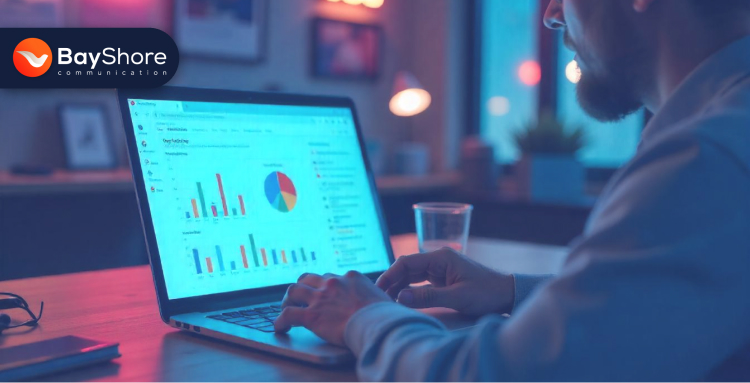
One of the most common misconceptions we hear from Tampa business owners is that poor mobile performance means they need to start over. A redesign might sound like the only answer, but in many cases, the foundation of the site is strong. What’s missing is a focused fix where the mobile experience falls short.
There’s often no need to rebuild when strategic mobile tuning can resolve the issues. Cluttered layouts, slow-loading pages, or unusable forms don’t require a complete overhaul. They require someone who understands how to make practical adjustments that deliver results.
We start with a comprehensive review to highlight what can be improved. We pinpoint where users struggle or drop off, then apply focused fixes that boost usability, speed, and reliability. Whether it’s refining mobile navigation, streamlining code, or enhancing responsiveness, we tackle improvements in layers, making the experience better without disrupting what already works.
Enjoyed this perspective? Our other posts offer more to think about:
You’ve already done the heavy lifting, built a business people trust, earned your place in the community, and delivered real value. Yet when your mobile site fails to reflect that, the disconnect quietly works against you.
A clunky interface or slow loading time doesn’t just frustrate, it sends the wrong signal about a brand that otherwise performs. In a market where most users engage first through their phones, every interaction on mobile either reinforces your credibility or erodes it.
Bayshore Communication exists to close that gap. We align your mobile experience with the strength of the business behind it, whether that means refining user flow, improving load times, or rebuilding for full responsiveness.
Our audits are clear, actionable, and focused on results. No overhauls unless they’re needed. Just thoughtful improvements that keep your users in motion. Let’s start with a free mobile performance snapshot. Reach out today, we’ll show you exactly what’s working, what’s not, and how to elevate the experience.

July 27, 2025
89% of healthcare consumers turn to search engines before they ever pick up the phone to book an appointment. That stat should stop any Tampa healthcare provider in their tracks.
Because of your future patients? They’re not flipping through brochures. They’re Googling symptoms at midnight, comparing clinics on their lunch break, and judging the credibility of your care before you ever meet them. And if your content isn’t showing up with answers that feel relevant, real, and local? You’re not just missing clicks. You’re missing trust.
Let’s talk about how to change that, how to build a content strategy that’s helpful, searchable, and unmistakably yours. And it all starts with one simple question...
Visibility is only the first layer of digital marketing. To truly attract patients, your content has to do more than just appear in search results; it has to invite the click. Tampa healthcare providers are competing not just with other local clinics, and with health blogs, hospital networks, and ad-heavy platforms that flood the digital space with medical information. So why would a patient choose your page?
It comes down to relevance. A piece of content that's tailored to what a local patient is searching for and written in a way that clearly answers their question is far more effective than a generic blog post stuffed with medical terminology. If someone searches "urgent care open late near Westchase," the content that gives a clear answer, accurate location, and helpful next steps will win their trust.
“70% of patients say content and reviews influence their choice of provider.”
Source: Doctor.com, 2020
Content that resonates leads to action. And pairing useful, patient-focused language with properly researched SEO terms is the balance Tampa clinics often miss.
At Bayshore Communication, we don’t create content just to fill a page; we build it to bring patients closer to your care Every blog, landing page, and service overview starts with what Tampa residents are already searching for. Then we craft it with clarity, empathy, and intent.
Our goal is to make sure every piece of content doesn’t just show up in search,it leads somewhere meaningful. When someone just clicks to your site, they can take real steps toward your clinic.

Patients don’t trust a website just because it looks polished. They believe in it when they feel something, when the content speaks with empathy. That’s when trust starts to build.Because good content connects. And that connection is what gives people the confidence to trust the care you offer.
When Tampa healthcare providers lean into real-world language and practical advice, patients listen longer and absorb more. Localized, specific content improves engagement not just because it’s clear and because it feels real.
That might mean writing about how Tampa’s rising humidity can trigger asthma, or explaining when to seek care for heat exhaustion after Gasparilla weekend.
“Blogs with specific, local examples increase time on page by up to 60%.”
Source: Nielsen Norman Group, 2022
It’s not about dumbing things down. It’s about making things understandable. When readers feel like they’re being spoken to, not talked at, trust builds naturally.
Bayshore Communication pays attention to what actually matters to your patients right here in Tampa. From allergy spikes during spring blooms to the real worries of managing chronic conditions during hurricane season, we create content that reflects their everyday lives. Because when your care feels local and personal, patients see your clinic as someone in their corner.
A video does more than deliver information; it creates a connection. When patients can see a provider smile, hear their voice, and get a glimpse inside the clinic, it eases the nerves around that first appointment. It turns the experience from clinical to comforting. From distant to human.
Video content doesn’t need to be a full documentary. In fact, short-form works best, like a 60-second clip explaining flu symptoms, a tour of the pediatric waiting room, or a "What to Expect During Your First Visit" explainer. These pieces put a face to your practice and calm uncertainty before it starts.
“72% of patients prefer video for understanding care topics.”
Source: Wyzowl,
We know video is more than just visuals. The focus is on making your message easy to understand, warm, and genuinely helpful. Whether it’s a tour of your clinic or a doctor answering common questions, we create videos that make your practice feel familiar and welcoming long before anyone walks through the door.
That’s the kind of thoughtful video strategy you get when you work with Bayshore Communication.

People care about what’s happening where they live. That’s why content that speaks to general health concerns often performs worse than content tied to a specific place or event. When someone sees a blog titled "How Tampa’s Rainy Season Affects Joint Pain," they don’t just read it; they feel like it’s for them.
Geo-targeted content also helps with search. When patients use "near me" or location-based queries, your content has a much higher chance of surfacing if it speaks directly to local experiences, events, or conditions.
“Searches with “near me” are up 500%+ in five years.”
Source: Think With Google, 2022
Localized content isn’t just about SEO. It’s about building trust through familiarity. When your clinic can speak to the neighborhood, it feels more approachable, even online.
How Bayshore Helps
We go beyond "serving the Tampa area." Bayshore Communication builds content around local events, seasonal health trends, and neighborhood-level needs. Whether it’s managing dehydration during heatwaves or flu updates for downtown workers, we help your practice become part of the community conversation.
No one is waiting around for an email about "20% off sports physicals." What does get opened? A well-timed reminder about flu season. A helpful checklist after a procedure. A note about how rising pollen counts could affect asthma patients this week.
Email marketing is most effective when it mimics what good care already feels like: personal, timely, and useful.
“Healthcare emails see open rates of 23.46%, higher than most sectors.”
Source: Campaign Monitor
Your email list isn’t just a group of addresses—it’s a group of people you’ve already helped or hope to help. When your tone sounds like a continuation of care rather than a call to action, engagement naturally improves.
How Bayshore Helps
We write email sequences that feel like conversations. From seasonal reminders tied to your content to follow-up summaries that build patient loyalty, Bayshore manages every detail, tone, cadence, and content to make sure your emails support care rather than interrupt it.

Patients don’t just look at your homepage. They scroll through your reviews. They scan how you respond. And they make decisions based on what they see in those quiet moments of digital research.
A single unresolved complaint or dismissive reply can overshadow a five-star average. On the other hand, thoughtful, timely responses to real concerns show that your clinic takes every patient seriously, even the dissatisfied ones.
Reputation isn’t passive. It’s a form of content in motion. Every reply, every thank-you, every acknowledgment tells a story about how your clinic values its patients.
Want to see how content can actually support patient engagement? You’ll find the answers in these related reads.
Content without strategy rarely leads anywhere. Tampa clinics require more than scattered posts or keyword-heavy blurbs. Success comes from a thoughtful, consistent system, one that reflects your values, speaks directly to your patients, and supports long-term goals.
That system includes:
Developing Tampa medical content strategies shaped by your actual patient base, not generic personas or templates.
Managing every stage of execution: writing, editing, reviewing, and publishing, allowing your team to focus on care.
Prioritizing healthcare SEO, Tampa providers benefit from the high-intent, locally relevant terms that attract the right audience.
Designing a sustainable content flow that works quietly in the background, strengthening visibility week by week.
If your clinic is ready to move from content that simply fills a calendar to content that earns attention and trust, reach out to Bayshore Communication. We’ll show you what a strategic approach truly feels like.

June 30, 2025
According to the Content Marketing Institute, 61% of the most effective B2B marketers meet daily or weekly with their content marketing team. Blogging has quietly become one of the most powerful levers for growth, but only when it’s done right. The digital world is flooded with content; small businesses face a deeper challenge: not just to be heard but to be trusted, remembered, and chosen.
Yet for many, blogging remains a cycle of inconsistency, great intentions buried under client deadlines, half-finished drafts, or content that fails to generate results. High-converting blog content requires intentionality, structure, and strategy.
So, how do small businesses get that level of consistency and performance? Let’s begin where most content efforts fall apart and where the right approach changes everything.
Your customers are looking for more than just a product or service, they’re looking for someone they can trust. When your business consistently publishes helpful, relevant blog content, you position yourself as a knowledgeable, reliable expert. That kind of builds trust and authority vver Time, it makes people more comfortable doing business with you.
“Content marketing generates 3x more leads than traditional marketing—at 62% lower cost.”
Source: Demand Metric
Blogging isn’t just about visibility; it’s about attracting the right visitors who are already searching for what you offer. When you publish strategic, resourceful content around topics your customers care about, you improve your organic rankings and show up more often in search results. That means more people are landing on your website without paying for ads.
“Companies that blog get 55% more website visitors than those that don’t.”
Source: HubSpot
Traffic without strategy is just noise. High-converting blog content is built to do more; it educates, builds rapport, and guides readers to act. Whether that’s downloading a guide, booking a call, or signing up for a service, each piece should move your audience one step closer to becoming a customer. Businesses that create blogs generate more leads, convert traffic into qualified leads and customers per month.
Blog posts don’t expire like ad campaigns. With the right topics and SEO strategy, a well-written blog can continue driving traffic, leads, and brand visibility for months, even years, after it's published. That’s why consistent content is one of the most scalable, cost-effective growth tools for small businesses.
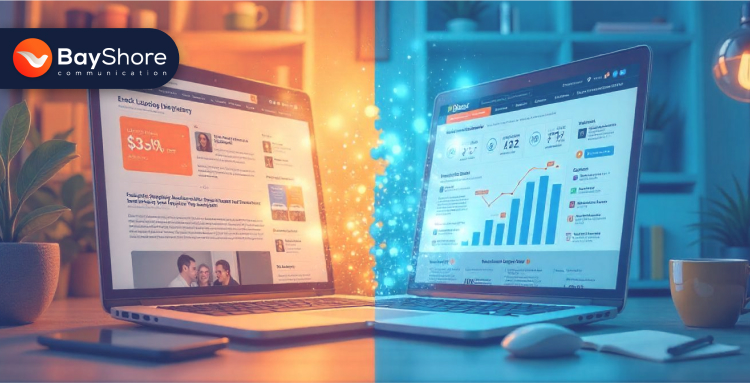
Using Data to Research Audiences and Target Keywords
We never guess what your audience wants to read; we find out. Every blog we create starts with in-depth audience research and smart keyword targeting. Using tools like SEMrush, Google Trends, and customer insight data, we analyze what your ideal buyers are searching for, what questions they’re asking, and what content gaps your competitors are missing.
This approach ensures your blog speaks directly to the right people, at the right time, with the right message. Creating high-converting, modern websites with relevant content is the most effective SEO tactic.
Strategic Topic Planning Aligned with the Buyer’s Journey
We don't only write about what's popular. We create a strategy that aligns with your customers’ journey. That means planning content for each stage:
Awareness (introducing the problem),
Consideration (exploring solutions),
Decision (why your business is the right choice).
This structure helps you meet customers wherever they are in their decision-making process and move them naturally toward conversion.
Proven Blog Post Framework for Maximum Engagement and Conversion
A blog post is only as good as its structure. That’s why we use a proven framework to keep your content clear, compelling, and built for action. From headline optimization and opening hooks to problem-solution storytelling and strategic CTAs, every element is designed to keep readers engaged and get them to take the next step.
Customized Content Calendars Designed to Stay Ahead
Great content doesn’t happen by accident, it happens by planning. At Bayshore Communication, we create tailored content calendars that align with your business goals, seasonal opportunities, and the evolving needs of your customers. This keeps your messaging proactive, not reactive, and ensures you always have high-converting content going out at the right time.
Professional Writing, SEO Optimization, and Content Repurposing
Every blog we produce is written by professionals who understand how to balance storytelling, clarity, and search optimization. However, we don’t stop at just one channel; each piece is designed to be repurposed across your email campaigns. social media, newsletters, and more. You get more mileage from every word while staying on brand and message.
Continuous Performance Tracking and Data-Driven Refinements
We don’t hit publish and walk away. Using tools like Google Analytics, Search Console, and heatmaps, we track how your content performs, down to the clicks, scrolls, and conversions. This data helps us refine future posts, adjust content marketing with SEO strategies, and double down on what works best for your audience.

We Understand Your Challenges
We recognize that small business owners are often packed with multiple responsibilities, leaving limited time and resources for content marketing. This is more common than you think; many small businesses face similar hurdles. However, this is one of the most effective marketing strategies for small businesses.
A 2024 report highlights that 51% of small businesses struggle with creating content, including writing copy and sourcing images.
Source: Forbes
Expertise in Small Business Content Marketing
Our team specializes in crafting content strategies that align with your unique business goals and audience needs. We don't offer generic solutions to everyone; instead, we develop personalized plans that drive results.
“Small and medium enterprises (SMEs) represent the vast majority of the business population in low-income countries... SMEs also suffer the majority of job destruction/contraction.”
Source: World Bank
For instance, when The Catflix, a niche streaming platform for cat enthusiasts, partnered with us, they were looking to increase user engagement and expand their reach. Through a combination of data-driven content strategies and continuous optimization, we helped Catflix enhance its user experience and grow its audience.
Scalable Solutions That Fit Your Budget and Timeline
We understand that budget constraints are a reality for many small businesses. That's why we offer scalable content solutions that fit your financial and time resources. Whether you need comprehensive content production or guidance for your in-house team, we adapt to your needs. Our collaboration with Apex Advisors, a financial consultancy, involved revamping their online presence and optimizing content, resulting in a significant boost in client engagement.
We approached their challenges with empathy, rebuilt their website, optimized their content, and improved their social media presence. This comprehensive transformation helped them regain their footing in the digital space.
“27% of businesses keep their content marketing expenses under $1,000 monthly, suggesting that content strategies can be effective even with limited budgets.”
Source: Forbes Advisor
A Committed Partner in Your Growth Journey
Choosing Bayshore Communication means gaining a dedicated partner invested in your long-term success. We work closely with you, offering continuous support and strategic insights to help grow your audience and revenue. We expanded our client’s global reach through targeted content strategies and attracted clients from various regions, leading to substantial business growth.
“Small and mid-sized enterprises (SMEs) play an important role in economies across the world... create 85% of new jobs.”
Source: Economist Impact

The truth is that writing high-converting blogs consistently is hard. It takes research, planning, SEO expertise, and the kind of insight that comes from truly understanding your audience. With us, you get a content provider as well as your strategic content partner. So, if your blog has been sitting idle or you’ve been stuck in the cycle of writing without results, it’s time to hand it off to a partner who knows how to turn content into real business impact.
We’ll analyze it and show you exactly what’s working, what’s not, and how to turn things around with a smarter strategy and stronger content. Book a free consultation today, and let’s talk about your concerns. Let’s Get Your Blog Working for You.
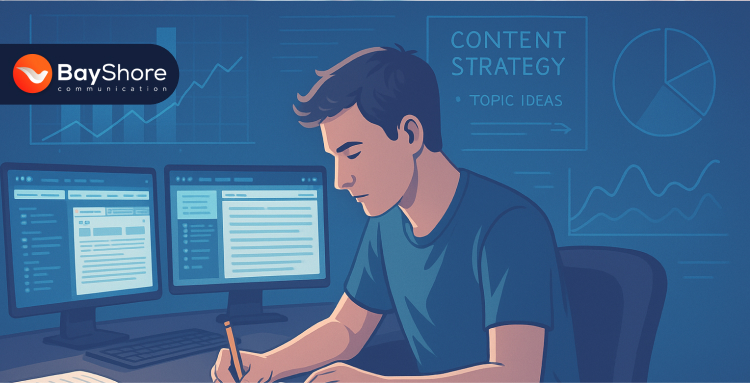
June 23, 2025
Yes — long-form content is worth doing as a new channel in 2025. Quick posts and short videos may grab attention. Long-form content, however, helps businesses go further by shaping ideas clearly and keeping people engaged through well-developed stories and insights.
Recent data reflects this shift. Blog posts with over 1,200 words receive more backlinks, higher time-on-page, and stronger SEO rankings compared to shorter pieces. When done right, this type of content builds direction and consistency across new platforms.
Let's take a look at how long-form content works across new channels in 2025, what steps are involved in creating it, how we use it with our clients, and why it continues to support sustainable growth.
In 2025, long-form content continues to deliver results. It doesn’t rely on trends—it thrives through structure, clarity, and the ability to hold a reader’s attention with thoughtful detail.
Search Visibility That Holds Its Ground
Search engines favor content that shows depth. When a page explores several layers of a subject, includes related questions, and stays relevant from start to finish, it stands out. Long-form content gives space for that kind of development, which leads to higher rankings and stronger impressions over time.
Time on Page That Tells a Story
Readers stay longer when content follows a natural rhythm. Rather than rushing through headlines, they move from one section to the next with interest. This kind of pacing creates trust. It tells search engines that the page delivers real value—and that readers aren’t simply passing through.
Conversions That Do Move the Needle
When Crazy Egg extended one of its landing pages with thoughtful, long-form content, conversions increased by 30% (Source: Stellar). The reason was simple: visitors found everything they needed to understand, evaluate, and decide—all in one place. Long-form content made that possible.
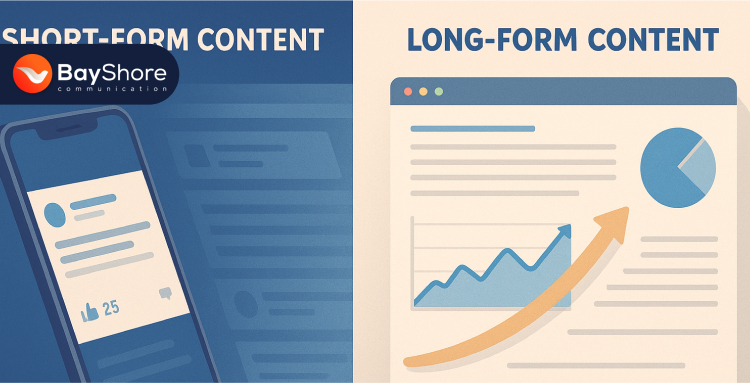
Long-form content becomes meaningful when it reflects purpose, not just length. We approach each project with care, shaping every piece to reflect the identity, clarity, and focus our clients deserve.
Strategic Planning with Precision
We begin with intent. Each piece is mapped to the client’s voice, audience expectations, and the rhythm of the platform where it will live. For instance, when working with TSG Pro Advisor, we aligned topics with seasonal shifts and platform behaviors, allowing their content to resonate with relevance. The tone isn’t guessed—it’s crafted, shaped to feel natural while remaining distinctive.
Stories Rooted in Real Outcomes
We write from experience. Our content is grounded in real progress, drawn from what our clients have built and delivered. With Apex Advisor Group, we highlighted their community ties and financial guidance by translating real-world impact into thoughtful storytelling. This kind of content doesn’t rely on abstraction—it reflects lived results, giving readers something concrete to connect with.
Tailoring for the Platform, Not Just the Message
Every platform has unique expectations. A blog invites depth. LinkedIn rewards sharp, reflective insight. YouTube calls for structured pacing and visual clarity. For Robert J. Johnson, we designed content that carried his legal insight across channels without losing tone and intention. The format shifts, though the content remains steady. We adapt thoughtfully so the message continues to feel composed and complete.
Long-form content isn't written to simply fill space—it’s crafted to answer questions, guide decisions, and shape reputation. Each project is rooted in purpose and clarity, and the results speak for themselves.
Challenge:
Their platform was technically sound, yet user drop-off rates remained high. They needed a way to communicate how workflow automation genuinely improved productivity and retention.
Solution:
We created a detailed case study that went beyond surface-level descriptions. It documented real client outcomes, visualized workflow efficiency, and presented automation not as a feature, but as a transformation.
Outcome:
The study became a touchstone for conversations with new leads. Visitors spent more time on the page, conversions rose, and the piece began circulating among partners seeking similar automation solutions.
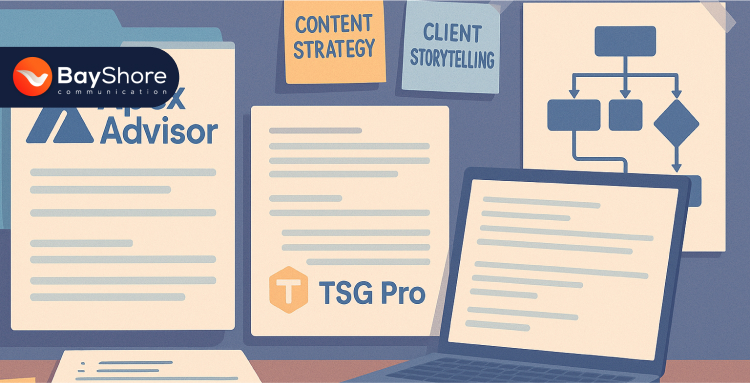
Challenge:
They required a clear, digestible explanation of their SaaS model—one that could connect across departments, from executives to implementation teams.
Solution:
Our team developed a long-form breakdown of their SaaS deployment model. We translated technical workflows into accessible language and built in scenarios that reflected real client concerns.
Outcome:
This piece improved their visibility in organic search and became a reliable resource for onboarding and investor communication. Inquiries increased, and prospects arrived already informed.
Challenge:
They wanted to grow recognition in a competitive space and offer content that reflected both expertise and approachability.
Solution:
We wrote a series of long-form articles focused on financial clarity. Topics ranged from retirement readiness to planning through economic uncertainty. Every piece aligned with their consultative tone.
Outcome:
The articles attracted repeat readership and were regularly shared in industry circles. Apex gained a stronger foothold among those seeking dependable, practical guidance, turning readers into clients.
Challenge:
He aimed to evolve his public profile—not just as a practicing attorney, but as a thought leader who shaped conversations in his field.
Solution:
We co-developed long-form LinkedIn essays and guest blog features that blended professional insight with personal narrative. Each post revealed something about his values and his approach to advocacy.
Outcome:
These essays extended his influence well beyond his firm. Engagement rose across platforms, peers began to reference his content, and reposts helped introduce his work to new professional audiences.

Every strong piece of long-form content begins with clarity—knowing what needs to be said, why it matters, and who it’s meant for. The process requires more than writing skills; it calls for alignment, depth, and intention at every step.
Identify Core Topics with Meaning
We start by defining subjects that reflect our client’s field knowledge. The focus remains on topics where they can contribute something distinct, whether through lived experience, strategic thinking, or expert-level problem-solving. These aren’t general talking points. They’re crafted to resonate with people who want more than surface-level commentary.
Research That Brings Insight to the Surface
The next step is to collect what adds substance. We look into trusted reports, data-driven trends, relevant studies, and, when possible, internal case notes. This background work gives the content weight, ensuring it educates, not just entertains. It also helps avoid common errors or shallow repetition.
Build Content That Holds Attention
Once the direction is clear, we develop the piece with care. This may take the form of a well-structured article, a walkthrough video, or a detailed guide. Each format is approached thoughtfully, with a strong beginning, focused sections, and a resolution that adds value. We include relevant examples or narratives where they help explain or reinforce the message.
Shape for SEO with Precision
Every content asset is structured for visibility without sacrificing flow. Keyword placement is planned rather than crowded, meta descriptions are written to clarify the piece’s intent, and links—both internal and external—are selected to guide the reader and support authority.
Distribute Content with Strategy
Where the content appears matters as much as how it’s written. We prepare each asset to fit its intended platform—whether that’s an article meant to gain traction through LinkedIn, a guide that fits within a blog ecosystem, or a case breakdown that finds reach through YouTube. No content is published without considering where and how it will land.
Create Space for Audience Connection
Content performs best when it lives beyond the post date. That means inviting the audience into the conversation. We build prompts and visual cues to encourage responses, and we pay attention to what the audience shares back, making future pieces sharper, clearer, and more aligned with what the audience truly wants to understand.
In a world full of noise, where words flicker past faster than we can feel them, long-form content is a kind of rebellion. It doesn’t beg for attention. It earns it.
We do not create content solely to fill space. We craft narratives with weight, pieces that don’t evaporate the moment they’re read. Because your ideas deserve more than a scroll and a skim. They deserve room to breathe, to unfold, to matter.
This is content built with care. With direction. With the patience to last.
If your story is bigger than a tagline, reach out to Bayshore Communication. We’re here to shape content that leads to sustainable growth.

June 18, 2025
Content teams work tirelessly, churning out blog after blog. Yet, somehow, their reach barely hits the surface. It’s like a brilliant novel locked away in a private library, unread and unnoticed. It’s frustrating. You’re putting in the effort, but the audience isn’t growing, engagement isn’t spiking, and the ROI feels elusive.
The truth is, real power lies in doing more with what you already have. Strategic repurposing is the art and science of transforming one solid blog post into a month’s worth of scroll-stopping, platform-tailored social content.
However, how do we turn that single blog post into a content system without overwhelming your team or watering down your message? The answer lies in our proven process designed for maximum.
We believe every great campaign begins with intention. That’s why our repurposing process starts with clarity. We begin by auditing your blog archive with precision. This isn’t just about cherry-picking your most popular posts. We analyze content for long-term relevance, performance trends, and alignment with your current brand positioning. The goal is to decide which assets should be elevated and which should be left behind.
From there, we craft a customized repurposing strategy. It’s a brand-specific roadmap designed to serve your audience, sync with your campaign calendar, and support your sales pipeline.
"Between 60% and 70% of content created by marketing departments at B2B companies sits unused."
Source: Forbes, 2016
Whether your goal is to increase awareness, encourage interaction, or strengthen leadership, we make sure every content strategy advances the overall goal.
We reimagine rather than merely repurpose. Every line, frame, and asset is restructured. Therefore, we can reflect your voice, reinforce your value, and resonate across every platform that matters to your brand.

We know that your audience isn't always in blog-reading mode. They're on the go, scrolling, tapping, reacting. That’s why we transform long-form blog content into snackable, strategic pieces that stop thumbs and spark interest.
We reframe the content to meet your audience where they are, in the format they’re most likely to engage with:
Social Media Carousels: We create eye-catching, swipe-friendly content for LinkedIn and Instagram that guides your audience through important ideas; each slide is made to capture interest and motivate action. Consider it the best content from your blog in a stylish package.
X (formerly Twitter) Threads: We turn your blog into smart, sequenced posts that build momentum with every tweet. Each thread tells a story, breaks down insights, and keeps followers hooked from start to finish.
Bite-Sized Tips & Hooks: These are punchy, catchy lines or quick value drops, perfect for Reels, TikToks, or post captions. They’re designed to educate, intrigue, or tease the full blog.
Pull-Quote Graphics: We highlight your strongest statements in branded visuals that are made for sharing. It's a signal of your authority and style.
Story Polls & Question Prompts: We turn your blog’s insights into interactive story elements that invite feedback, opinions, and clicks, boosting your online visibility and relevance.
Modern audiences crave content that’s fast, visual, and personal. That’s not a guess; it’s backed by data.
“Short-form content generates up to 30% more engagement than long-form across major platforms like LinkedIn and Instagram.”
Source: LinkedIn
We recraft. Every format is personalized to the platform, the algorithm, and, most importantly, your brand's voice. It’s how we turn one blog into a week’s worth of high-impact social content.
Words still matter, but video owns the spotlight. We translate your blog’s most compelling messages into dynamic, on-brand video content that doesn’t just grab attention; it holds it. We simply turn your existing blog into a suite of polished, platform-optimized video assets to educate, entertain, and convert.
Here’s how we do it:
Instagram Reels & TikTok Tips: We break down key takeaways into fast-paced, trendy clips that feel native to each platform. Short, sharp, and built to spark engagement.
YouTube Shorts & Explainers: Whether it’s a 60-second summary or a bite-sized explainer, we deliver vertical video content that educates while maintaining your brand’s tone and authority.
Voiceover Animations: Perfect for complex topics. We script, animate, and narrate short clips that bring your message to life with motion, no face time required.
Talking Head Videos: Want a more personal touch? We turn your blog into a branded script you or your team can deliver confidently, or we’ll handle the voiceover and visuals for you.
Audiences crave clarity, speed, and personality. Our video delivers all three. And it’s more than just a trend; it’s a conversion engine.
"A whopping 91% of businesses used video as a marketing tool in 2024, with 90% claiming it has provided them with a good ROI."
Source: Forbes, 2025
From concept and scripting to editing and optimization, we manage the full video lifecycle. No on-camera stress, no extra effort. Future trends and innovations in online marketing are demanding high-performing, high-converting video content, ready to launch.

Most people don’t read; they scan. Visuals are how you stop the scroll and start the story. They're the entry point. We transform your written content into a library of scroll-stopping, brand-forward visuals that command attention in seconds.
We don’t just add images for flair. We engineer them for function, strategy, and shareability—each asset is tailored to your audience, platform, and funnel goals. Here’s what we craft from your blog:
Infographics: We distill data, timelines, or step-by-steps into clean, compelling visuals that make complex information instantly digestible and share-worthy.
Branded Quote Cards: We elevate standout lines from your blog into eye-catching social assets, styled in your brand’s colors, fonts, and voice for easy recognition.
Custom Illustrations: Need a unique visual metaphor or brand-friendly graphic? We create unique illustrations that align with your tone and storytelling goals.
CTA-Based Visuals: We design clickable, action-driven graphics for social ads, retargeting campaigns, and email headers that guide users to your next conversion point.
Your audience wants visual clarity. And high-quality graphics don’t just enhance content; they multiply its reach.
“Articles with relevant visuals see 94% more views than those without.”
Source: MDG Advertising, 2024
From the first pixel to the final polish. Every visual we create is tailored to your brand’s identity, color language, and tone of voice. As a result, we deliver designs that complement your message and amplify your authority in every feed it lands in.
Each platform possesses its unique language, audience expectations, and engagement patterns. We deeply adapt your content to resonate authentically across various channels. Here's how we recalibrate your content for optimal impact:
LinkedIn: We present your insights with a professional tone, emphasizing data-driven narratives and industry relevance to engage a corporate audience.
Instagram: We transform your content into visually compelling stories and posts, leveraging aesthetics and succinct messaging to capture attention.
X (formerly Twitter): We distill your message into concise, impactful tweets that encourage interaction and sharing among a broader audience.
TikTok: We reimagine your content into short-form videos that align with trending formats, fostering engagement through creativity and relatability.
This strategic adaptation is about rephrasing your message to meet your audience where they are, in the way they prefer. Our commitment extends beyond content adaptation. We manage your entire social media calendar, ensuring each post is optimized with appropriate hashtags and scheduled during peak engagement times.
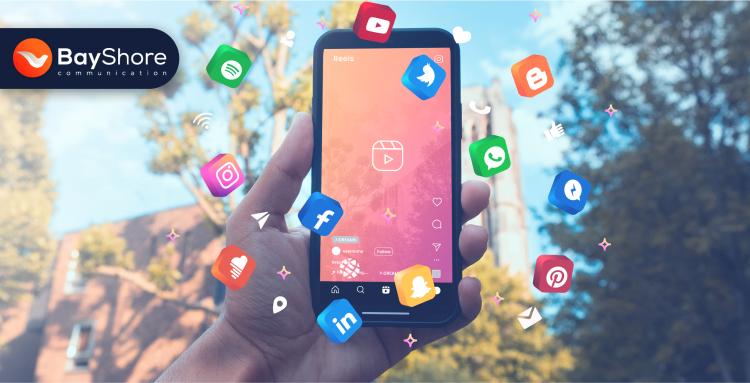
You’ve already done the heavy lifting, written the blog, shared your expertise, and and put your voice out there. But what if that one piece of content could go further? What if it could speak to ten different audiences in ten different ways without needing to start from scratch?
We take what you’ve built and make it work harder for you. We repurpose with intention, redesign with care, and distribute with strategy. So, your message reaches farther, lands stronger, and stays longer in front of the people who matter most.
From social graphics to video snippets, we handle every detail so your team can stay focused. Talk to our team today. Let’s get you a content system that works harder so you don’t have to.

June 4, 2025
Somewhere between the scroll and the play button, between a fleeting 15-second clip and a seven-minute brand story, we lose the plot. Or maybe we find it.
Because in this strange digital theatre, where algorithms decide what lives and what dies, business owners sit at their desks, asking a seemingly simple question: "Should we go short, or should we go long?"
It's not just about the format. It never is. It’s about attention, how to earn it, hold it, and turn it into something more than a click.
And in the face of this modern absurdity, we don’t ask which video length will save your strategy. We ask what your story needs in order to be remembered…
Long-form doesn’t mean long-winded. This isn’t our grandpa’s corporate training tape. Today’s long-form videos are lean, focused, and emotionally resonant. They’re the kind of content that redefines the way your audience sees you.
In practical terms, we’re talking about video content that runs anywhere from 2 minutes to 10 minutes, sometimes more if it’s earned. It’s your brand’s opportunity to say, “Here’s who we are. Here’s what we stand for. Let’s go deeper.”
And guess what? People do watch.
“Watch time matters: YouTube’s algorithm favors videos over 2 minutes, with average session durations of 5–10 minutes leading to better visibility and reach.”
Source — Backlinko
This kind of video works well when the goal is to educate, explain, or inspire. Think:
Explainer videos that make your value crystal clear
Brand storytelling that builds emotional connection
Customer testimonials that speak louder than ads
Webinars or mini-documentaries that establish your expertise
Business owners often want to share their why, their origin story, their mission. However, the minute someone says “long-form,” panic sets in. “What if people don’t watch the whole thing? What if we bore them to death?”
Let me tell you it’s not about the length, it’s about the layers. And we, Bayshore Communications, know how to build those layers beautifully.
With our approach, every second serves a purpose. We script with intention, shoot with precision, and edit like poets with scalpels.
“68% of people say long-form videos help them make purchasing decisions.”
Source — Wyzowl, State of Video Marketing 2024
That’s not just a number. That’s trust. That’s clarity. That’s potential customers leaning in and saying, “Okay, now I get it.”
And isn’t that what great storytelling should do?

We’re living in the age of the scroll. Your audience is thumbing through a firehose of content, and you’ve got maybe eight seconds to earn a flicker of interest before they swipe you into oblivion. That’s where short-form video shows up as a lifeline.
We’re talking 15 to 60 seconds of razor-sharp storytelling (or up to 90 seconds if we’re playing in TikTok or IG Reel territory). The format is fast. The impact? Blisteringly effective if it’s done right.
“Short-form videos generate 2.5x more engagement than long-form content on platforms like TikTok and Instagram Reels.”
Source — HubSpot
Short-form is a trendy tool and it works best when you use it to:
Launch a new product with punch and precision
Show the real behind-the-scenes that builds authenticity
Drop tutorials that solve problems instantly
Ride the algorithm waves on Reels, TikTok, and Shorts—without selling your soul
Now keeping up with short-form trends feels like trying to sprint on a treadmill set to chaos. Every day there’s a new sound, a new dance, a new hack, and most brands don’t have the time or team to ride that wave.
That's why Bayshore doesn't simply chop videos and call it content. We produce short-form series designed to build momentum. We analyze your audience, match the message to the medium, and create gripping narratives that actually serve your goals.
Because at the end of the day, it’s about being remembered and, more importantly, being chosen.
“TikTok users spend an average of 95 minutes per day on the app.”
Source — Statista
That’s your audience, right there. Not bored. Not distracted. Just waiting for something worth watching.
You simply must make sure that something is you.
The “should we go long or short?” question is contextual. It depends on who you're talking to, where they are in the buying journey, and what you actually want them to do next.
So instead of flipping a coin, let’s walk you through a dead-simple framework to help you make smarter video decisions.
1. What’s your audience doing?
Just browsing? → Short-form grabs the eye.
Actively researching? → Long-form builds the trust.
2. Where are they in the funnel?
Awareness: Hook them with a short-form burst.
Consideration: Go deeper with long-form explainers or testimonials.
Decision: Mix both—highlight value fast, then invite them into the story.
3. Where will this video live?
TikTok & Reels: Short, punchy, visually driven.
YouTube & your website: Long-form, high-retention content wins here.
LinkedIn: Short or mid-length with thought leadership tone.
Email: Keep it tight. Under 60 seconds or link to long-form hosted content.
4. What’s your budget—and how do you make it work harder?
Short-form lets you produce in batches and distribute wide.
Long-form gives you pillar content to slice, dice, and repurpose.
However, you don’t have to choose.
“Brands using a mix of long- and short-form video see 34% higher conversion rates than those relying on a single format.”
Source — Animoto x Social Media Today Report
That’s not a small bump. That’s your ROI multiplying because the right mix doesn’t just reach more people, it reaches them the right way.
And that’s exactly what Bayshore Communications does best. We design content ecosystems. We give your brand depth where it matters, and speed where it counts.

Anyone can make a video. But making the right video, for the right platform, with the right purpose? That’s a craft. That’s strategy. And that’s our sweet spot.
We don’t silo long-form and short-form into separate campaigns. Instead, we weave them together:
Top of Funnel (TOFU): Short-form teasers spark curiosity and drive viewers to your site or YouTube channel.
Middle of Funnel (MOFU): Long-form explainers and case studies deepen understanding—think 3–7 minute videos that unpack your value proposition.
Bottom of Funnel (BOFU): Testimonials and mini-documentaries close the deal by showcasing real results and building trust.
This multi-touch approach ensures that your audience experiences your brand story in layers rather than just seeing content.
Storyboarding with Intent: Every frame serves a purpose. We map out viewer emotions and calls to action before a single camera rolls.
Scripting That Speaks: Our copywriters craft dialogue and narration that feels human, not robotic. We script transitions that flow, punchlines that land, and taglines that stick.
Platform-Focused Edits: We mold each cut to the platform’s rhythm. Quick cuts and punchy graphics for Reels; clean pacing and chapter markers for YouTube; subtitles and bold text for LinkedIn scrolls.
Each video emerges optimized for where and how your audience watches.
Client: The Catflix
Challenge: Low engagement on LinkedIn and stagnant demo requests.
Strategy: Launched a series of 30-second “ask me anything” Reels that doubled engagement in two weeks. Viewers were then funneled to a 6-minute customer success story on YouTube.
Result:
2× increase in short-form views and engagement
1.8× uplift in demo requests within 30 days
50% higher click-through rate from video to landing page
By layering snackable content with substantive deep dives, we transformed fleeting attention into measurable action.
That isn't a coincidence. It's the power of strategy-driven storytelling, created by a team passionate about your success.
Visit our related posts to enhance your understanding:
The Intersection of Content Marketing and SEO: Driving Organic Growth
When do you need to stop investing money in digital marketing

The format is just the container. The strategy? That’s the fuel. And without it, even the slickest videos fall flat.
We make a video ecosystem that adapts to your funnel, your platform mix, and your business goals. One that turns casual viewers into loyal customers. Not with gimmicks, but with smart, high-performing creative grounded in real data.
So no, you don’t have to choose between attention and depth. You just need the right partner to help you balance both.
Ready to stop winging it and start winning with video? Book your free strategy session with Bayshore Communications. Let’s stop guessing what might work and start implementing what will work.

May 27, 2025
In 2025, small businesses continue to see impressive results from email marketing, often with just one well-timed message. Consider a neighborhood bakery that sends a brief morning email promoting fresh pastries. By lunchtime, pre-orders have doubled, and foot traffic picks up without relying on social media trends.
While social media visibility depends on ever-changing platforms, email offers consistency and control. According to Constant Contact’s 2025 Benchmark Report, it brings a $36 return for every $1 spent. For small businesses looking to grow their audience, drive sales, and maintain long-term customer relationships, email remains a practical and high-return strategy.
Today, we will look at the most effective email marketing strategies for small businesses in 2025.
A message that feels generic rarely earns attention. Most people don’t mind hearing from a business. They just want the message to reflect who they are and what they care about. Relevance isn’t a luxury in email marketing anymore; it’s the baseline.
When segmentation is done with care, it turns an email from a broadcast into a conversation. One subscriber clicks on a product, another signs up for an event, and a third hasn’t opened anything in weeks. Each of those actions offers a different cue. Using behavior as a guide, rather than guessing, keeps your emails in step with real people.
A demographic and geographic details layer that is relevant even further. A subscriber in Miami might want summer promotions when someone in Chicago is preparing for snow. A local customer may appreciate in-store offers, while someone across the country might respond better to free shipping.
These choices make a measurable difference. Segmented campaigns see 14.31% higher open rates and 101% more clicks.
(Source: Mailchimp, Data Analysis).
When emails feel personal, they stop sounding like marketing. They sound like someone paying attention.

The first impression you make with a new subscriber is crucial. Imagine meeting someone at a party and immediately launching into a sales pitch—chances are, they’d walk away. Instead, what if you greeted them like an old friend, offering a warm handshake and sharing a bit about yourself? That’s the power of a thoughtful welcome.
Take, for instance, an Etsy seller whose welcome email prompted a 22% repeat order rate. It wasn’t just the product that intrigued the customers—it was the way the brand made them feel valued from the first moment.
Welcome emails stand out for a reason. They’re far more than an introductory note. In fact, they generate 320% more revenue per email than other types of promotional content
(Source: Omnisend, Annual Report).
To make it work, structure matters. A simple sequence can nurture that connection:
Day 1: Welcome + Discount — Start with gratitude and a small thank-you for subscribing, paired with a limited-time offer to create a sense of urgency.
Day 3: Story — Share your brand's story—why you started, what you believe in. This builds a connection and humanizes your brand.
Day 5: Social Proof — Show them they’re not alone. Share testimonials or user-generated content that highlights real customer experiences.
It’s an opportunity to lay the foundation for trust. When you welcome subscribers like friends, they’re far more likely to return.
It’s time to go beyond the typical “Hi [Name]” and create emails that truly speak to the recipient. Think about it: people want to feel understood, not like they’re just another name on a list. Personalization is about crafting an experience that feels tailored to each individual’s unique journey with your brand.
Take, for example, personalized subject lines. Emails with subject lines that reflect a personal touch are 26% more likely to be opened
(Source: Campaign Monitor).
A simple email that reminds them of a product they recently viewed or offers something complementary can spark interest.Smart product recommendations take it further. With data in hand, suggest items that align with their style, preferences, or even their previous shopping habits. This kind of personalization isn’t just nice to have—it’s expected.
We’ve all been there—checking emails first thing in the morning, while lying in bed, or even sneaking a glance between tasks. The secret isn’t just about sending emails; it’s about meeting your audience where they are, at the right time.
Timing matters more than we often give it credit for. Emails sent between 9–11 a.m. on Tuesdays typically see the highest engagement
(Source: HubSpot Email Trends)
Still, there’s no universal answer. Your audience might have a different rhythm, which is why it’s worth experimenting. Testing send times with A/B tools can help you pinpoint the perfect moment to connect. When you hit the right time, you're not just adding another email to the pile; you're offering value exactly when they’re ready to receive it.
Sometimes, all it takes is a gentle nudge to bring dormant subscribers back into the fold. Think of a florist who sent a re-engagement email that revived 38% of her inactive list. Rather than simply asking for attention, she offered something valuable—a reminder of what her brand had to offer and a compelling reason to return.
Re-engagement emails can have an extraordinary impact. In fact, 45% of subscribers will open a re-engagement email—if it’s done right
(Source: ActiveCampaign)
To make sure your re-engagement email stands out, consider using subject lines like:
“It’s Been a While. Here’s a Special Gift Just for You”
“Still Interested? Let’s Pick Up Where We Left Off”
A strong call-to-action can be just as important:
“Claim Your Exclusive Offer”
“Revisit Your Favorites Now”
When executed correctly, re-engagement emails do more than just bring back subscribers; they also re-establish a bond, transforming silence into renewed interest.
Explore the related posts to guide your business growth.
Why You Should Maintain a Social Media Content Calendar for Your Business
Creating Impactful Visual Content: Best Practices for Digital Success
What are the most effective marketing strategies for small businesses?

Most of us check emails while doing something else. One hand on a coffee cup, the other casually scrolling. In those moments, no one has time to pinch, zoom, or decipher a cluttered layout. That’s why design should feel quiet, clear, and made for the way we live now.
More than 71% of email opens now happen on mobile devices
(source: Litmus, Email Client Market Share Report).
If your emails aren’t easy to read and act on from a phone, they’re likely getting swiped away before they’re even considered.
Clean, mobile-first design is about clarity, not bells and whistles. A one-column layout allows the content to flow naturally. Big buttons mean no missed taps. Short, well-spaced paragraphs make the message easy to digest, even in the middle of a busy day.
Design that does not compete for attention frequently gets the most of it. The goal is not to impress; rather, to connect clearly and without friction.
In today’s inbox culture, trust isn’t a bonus—it’s the foundation. Respecting someone’s inbox is the modern loyalty program. When people feel their data is handled with care, they’re far more willing to engage, return, and refer.
Clarity builds confidence. A striking 89% of consumers say they’re more likely to trust companies that clearly explain how their data is used
(Source: Deloitte Digital Consumer Trust Study).
Earning that trust begins the moment someone joins your list and continues with every interaction after. Double opt-ins ensure subscribers truly want to hear from you. Clear unsubscribe links say, “We respect your time.” And regular list cleaning helps you maintain relevance without forcing anyone to tune out.

You don’t have to rely on guesswork—your audience already shows you what works every time they open, click, or scroll past. The numbers don’t just tell a story—they offer direction.
Businesses that regularly run A/B tests on their email campaigns see a 37% boost in performance
(Source: Campaign Monitor)
Track the metrics that matter: open rates, click-throughs, bounce rates, conversions, and unsubscribes. Each one tells you something specific about what’s landing and what’s falling flat.
Small businesses rarely lack heart—what they often lack is clarity. The inbox, full of potential, becomes just another item to survive on a long list of demands. It hums in the background, waiting to be more than a chore.
Bayshore Communication does not provide shortcuts or noise. We offer rhythm. Email strategies shaped by your brand's voice, paced with intention, and designed to connect rather than convert.
If your emails feel aimless, or you sense they could do more, Start Here. Let’s give your message a path and your audience a reason to follow it.

May 24, 2025
We used to think we had time. Time to plan, to adjust, to catch up. But somewhere between a global pandemic, rising market volatility, and the quiet revolution of artificial intelligence, the rules changed. Businesses don’t just need to move fast; now they need to bend without breaking. And the more unpredictable the world becomes, the more we crave structure. Yet that structure cannot be rigid. It must be responsive, intelligent, fluid, and designed to evolve.
We’ve witnessed this shift unfold in real time. The businesses succeeding now aren’t always the largest or the most established. They are the most adaptable ones, leveraging flexible software solutions to maintain and define their operations.
This post is about how those companies lead and how your business can do the same.
Business doesn’t wait. Neither should your software. Markets shift. Customer demands change. One rigid system, and suddenly your growth plan turns into a backlog of delays. Now, what do we mean by “Flexible Software Solutions”? It means adaptable software, tools that shift when you do. Especially updates with market changes.
A static platform may have worked when growth was linear and operations were predictable. But modern business demands tools that can pivot quickly, scale intelligently, and evolve without downtime. That’s why flexibility isn’t just a feature, it’s a solid foundation.
70% of digital transformation initiatives fail because of inflexible technology.
(Source: McKinsey & Company)
In reality, you can’t afford to build today’s strategy on yesterday’s systems. Flexible software lets you move with the market, launch updates without red tape, and respond to real-time needs without calling IT every hour.
The benefit? You stay agile. You stay ready. And your business keeps moving forward, no matter what the market throws at you.

Generic software is built for everyone. That’s the problem. If your team is juggling multiple markets, workflows, or customer bases, one generic solution won’t cut it. You need tools that speak your language, whether that’s regional compliance, local workflows, or niche industry needs.
That meansTailored software bridges that gap. It aligns with your unique workflows and flexes with your priorities, not the other way around. Whether you're managing compliance in Florida, coordinating teams in multiple time zones, or integrating with legacy systems, customization ensures your tools reflect the way you work.
When your tools are built around you, not the market average, every part of your operation becomes more efficient. It’s how local businesses grow global and how global teams stay aligned.
From Tampa startups to global brands, from branding to conversion, the message is the same: Your software should flex to fit your business, not the other way around. The result? Better alignment, fewer workarounds, and a system that supports the way you work.
You can have all the tools in the world, however, if they don’t talk to each other, you’re not getting the full story. It means disconnected systems create data silos. Teams work off outdated info. Decisions get delayed. Opportunities slip through the cracks.
Businesses lose over $140 billion a year in productivity due to disconnected data.
(Source: Digitalisation World)
This means it’s not only a financial loss; however, it’s directly impacting productivity. In the long run, it will only hurt the business.
Flexible software solutions are built to integrate smoothly. Whether it’s your CRM, finance tools, or marketing strategies for small businesses, everything stays in sync. That means real-time insights, faster responses, and fewer blind spots.
Data should move freely across departments, tools, and decision-makers. A flexible tech stack with open APIs and smart integrations helps unify your business intelligence. That’s how a conversation in sales informs strategy in operations and shapes the next customer interaction in real time.
Scalability should support your growth, not squeeze your budget. Yet too often, companies get locked into expensive systems packed with features they don’t need and pricing models that don’t flex.
According to Deloitte, organizations that shift to scalable tech reduce IT costs by up to 30%.
(Source: Deloitte, 2024)
It means you stay lean, agile, and ready to reinvest where it counts, without compromising on performance.
Software for Cutting Costs: Smart businesses are doing it differently. They’re choosing modular software platforms that scale with them, so they’re never paying for what they’re not using.
More importantly, cost-efficiency doesn’t mean cutting corners; it means spending smarter. With the right setup, you can reallocate saved resources toward innovation, talent, or customer experience, things that truly move the needle.
The Solution: Flexible solutions give you control over your tech spend. Add tools when you need them. Drop what you don’t. And skip the costly migrations.

Every day, businesses lose valuable time and talent to outdated, inefficient software. What starts as a minor inconvenience, like slow loading times or confusing interfaces, quickly becomes a roadblock. Teams spend more time fighting the system than using it. project stalls. Morale dips. Customers notice.
Did you know nearly 4 in 10 employees cite outdated digital tools as the top reason they can’t do their best work?
(Source: CIO Dive)
These inefficiencies stack up, impacting timelines, morale, and even customer satisfaction.
Modern growth depends on operational fluidity. That means tools need to remove friction, not create it. When your software doesn’t align with your processes or business model, it does more than waste time, it holds back creativity, dampens innovation, and ultimately affects your bottom line.
Therefore, don’t let legacy systems define your future. Better tools mean better output and a stronger bottom line.
Technology should do more than function, it should fuel momentum. For growing businesses, that means your stack needs to be lean, connected, and built for real-time performance.
Here’s what to look for:
Scalability that keeps pace with your growth, without costly rebuilds.
Open integrations to break down data silos and boost collaboration.
Intuitive, user-friendly interfaces so your team can hit the ground running.
Real-time dashboards that turn insights into action, fast.
A smart stack isn’t just a checklist. It’s your business edge built to grow, adapt, and deliver.
At Bayshore Communication, we don’t just plug in solutions and walk away. We align tech to your goals, then optimize for impact.
Are your current systems holding you back? Take a moment to assess where your technology might be falling short. If you’re facing sluggish performance, disjointed tools, or an inability to keep up with change, it’s time for a shift.
We believe in more than just software. We’re here to be your partner in building flexible, growth-ready solutions that will grow with your business, no matter where the market takes you.
It’s time to get ahead of the curve. Let’s chat about how Bayshore can help you organize your operations, enhance your agility, and set the stage for long-term success.
Ready to make your business durable? Schedule a strategy session with us today. We’ll help you transform your tech stack and unlock your full potential.

May 15, 2025
There was a time when offshore support meant invisible hands behind distant screens. Efficient, maybe, often distant and disconnected. You felt the gap in quality, in rhythm, in understanding. And then, something shifted. Slowly at first. Then all at once.
The evolution of offshore support in the digital age isn’t just about tools or time zones. It’s about alignment. Intention. Building with people who see your vision and move with it. Not just tasks delivered, strategy carried, campaigns shaped, trust earned.
Bayshore Communication doesn’t outsource. We integrate, fully, and intentionally. That’s how we build something that lasts. Let’s explore what offshore support becomes when it’s done right.
Offshore support began as a simple numbers strategy that cut costs, increased margins.
Let’s take a closer look at the important points so that you can implement them in your business and stay ahead.
Offshore Support Was Built on Cost, Not Quality
Offshore support started as a budget move. Companies outsourced customer service and back-office work to cut costs fast. For decades, companies leaned on outsourcing to handle customer service, data entry, and back-office tasks.
Countries like India and the Philippines became global hubs, offering large labor pools at a fraction of the cost of in-house teams. It made sense on paper: lower labor costs, 24/7 support, and quick scalability. However, there was a downside. Let’s also talk about that.
The Trade-Offs: Gaps That Hurt the Brand
Too often, businesses sacrificed quality for savings. Teams worked from scripts, not strategy. Cultural mismatches and communication barriers led to misaligned messaging, slow turnaround, and frustrated customers. The support felt distant, and so did the brand.
Bayshore’s Take: Offshore Support, Reimagined
At Bayshore Communication, we knew that model wouldn’t cut it anymore. Offshore support should strengthen your brand, not thin it out. That’s why we built a smarter model. One that prioritizes collaboration, alignment, and real results. We don’t just deliver tasks. We deliver brand-consistent, high-performance support that grows with your business.

Technology is evolving too fast. And, companies should be considering that. Therefore, you need to understand these core facts:
Modern Tools, Smarter Support
Offshore support has evolved. Cloud platforms, shared dashboards, and automation tools now allow teams to collaborate in real-time. No delays, no disconnects. Tasks that once took days are done in hours, with full online visibility and faster results.
Tech That Drives Results
Digital tools have just transformed how offshore teams deliver value. Project tracking is smooth. Reporting is instant. And creative, customer, or technical tasks move forward with clarity and speed.
Bayshore’s Advantage: Built for the Digital Era
We’ve fully integrated these tools into how we work. From automated workflows to live campaign tracking, our systems are designed to keep you informed and ahead. It’s not about using more tools, it’s about using the right ones to drive real performance.
Offshore teams aren’t just handling repetitive tasks anymore, they’re driving real business growth. As digital operations expand, the demand for skilled, strategic talent has grown. And offshore support has stepped up to meet it.
From Tools to Transformation: How Tech Rewired Offshore Support
Offshore support isn’t what it used to be, and that’s a good thing. The shift didn’t happen overnight. It was driven by smarter tools, faster connectivity, and a global workforce that no longer needs to sit under one roof.
Cloud platforms like Google Workspace, Slack, and ClickUp now allow teams to collaborate in real-time, no matter the time zone. Workflow automation tools reduce bottlenecks and keep projects moving. Shared dashboards bring visibility. And version control? It means nothing gets lost in translation. These are enablers, not just an upgrade.
More Than Tasks: Offshore Roles That Move the Needle
Today, offshore professionals are managing SEO campaigns. Plus, it is producing branded content, launching PPC ads, and maintaining CRMs with precision. These roles require more alignment with brand voice, data fluency, and a strong understanding of digital strategy. We all know digital marketing is important for business, and offshore can complement that. It’s no longer about filling gaps. It’s about fueling growth.
Bayshore’s Difference: Curated Teams with Strategic Focus
We don’t just staff projects, we build purpose-driven offshore teams. Every team member is carefully selected, trained to understand your goals, and integrated into your workflow. Whether it’s the latest trend in marketing, support, or operations, our experts are ready to contribute where it matters most.
The Outcome: Faster Execution, Smarter Campaigns, Better ROI
With the right people in the right roles, you move faster. You launch stronger campaigns. You see measurable results. That’s the Bayshore approach: talent with purpose, impact you can measure. We don’t chase trends, we integrate technology that delivers actual value.
Our focus is on building systems that work quietly in the background while your business runs smoothly in the spotlight. You get visibility, accountability, and better results without the usual hand-holding.

The COVID-19 pandemic acted as a catalyst, transforming remote work from a temporary measure into a lasting business practice. Before the pandemic, only about 5.7% of U.S. employees worked from home five or more days per week. By late 2020, this figure surged, with projections suggesting that 20-30% of the workforce would continue to work remotely post-pandemic.
Remote Work Is Now Business as Usual
The pandemic demonstrated that remote work could maintain, if not enhance, productivity. Studies found that employees working remotely were as productive as their in-office counterparts. This realization led many organizations to embrace flexible work arrangements, acknowledging the benefits of a distributed workforce.
Bayshore’s Foundation: Built for Global Collaboration
Our infrastructure was designed with global collaboration in mind. The shift to remote work validated our approach, allowing us to integrate with clients worldwide. Our offshore teams remained aligned with client goals, delivering consistent and efficient support across various time zones.
Flexible Teams, Consistent Results
Time zones don’t slow us down, they extend our reach. While you rest, we execute. But flexibility never comes at the cost of quality. We hold every team member to clear KPIs and use transparent reporting to keep you in control, no matter where work gets done. This isn’t just remote work, it’s remote done right.
Nowadays, businesses require offshore support that goes beyond mere task execution. They need teams that understand their brand, adapt in real-time, and deliver measurable outcomes.
Offshore Support That Understands Your Brand
Effective offshore support isn't just about answering queries; it's about representing your brand's voice consistently. According to a report by the Project Management Institute, 34% of projects fail due to miscommunication. This underscores the importance of cultural alignment and clear communication in offshore teams.
Transparent Communication, Measurable Outcomes, and Shared KPIs
Transparency and accountability are crucial for successful offshore partnerships. Establishing clear Key Performance Indicators (KPIs) ensures that both parties are aligned with business objectives. For instance, setting goals like reducing customer response times by 30% or achieving a 90% Customer Satisfaction (CSAT) score can drive performance and service quality.
Data security and compliance
Another rising issue is data security. With growing concerns over data privacy, companies need offshore partners who can meet international security standards and protect sensitive customer information.
Bayshore’s Customized Approach: No Cookie-Cutter Solutions, Just Results
We recognize that each business is unique. We don't offer off-the-shelf solutions. Instead, we tailor our offshore support to your specific needs, ensuring that our teams integrate seamlessly with your operations and contribute to your success.

Offshore support has come a long way. It’s about smart partnerships. And, growth favors the bold, however, it rewards the prepared. We believe in doing offshore differently. We combine talent, tech, and process to help your business grow smarter, faster, and stronger without losing your identity along the way.
Let’s build something together. Your future-ready offshore team is just a conversation away. Let’s make it the Bayshore way. Reach out today and let’s discuss how Bayshore can help you sustain your success.

May 7, 2025
Did you know that Businesses that delay digital transformation risk losing up to 45% in revenue growth over five years? It’s a gap nearly impossible to close once it starts widening. In a world where AI, automation, and cloud technologies are setting the pace, standing still means falling behind. Take a moment to consider how these emerging technologies are transforming business operations.
At Bayshore Communication, we help our clients move differently. Smarter and Faster. We don’t just talk about innovation, we implement it. From smooth operations to creating new revenue streams, our tech solutions are already helping forward-thinking businesses lead with confidence.
Wondering what that kind of success could look like for you? Let’s take a closer look.
If your team is still bogged down by repetitive tasks, inefficient workflows, or manual data entry, you lose more than hours. You're losing the opportunity to scale smarter and compete harder.
Manual workflows are slow, error-prone, and resource-heavy. Whether it's data entry, report generation, or approval routing. Every task done by hand increases the risk of mistakes and slows down your team. The result? Wasted time, rising costs, and missed opportunities.
Use automation to offload repetitive tasks and optimize internal operations. From employee onboarding to invoicing and customer service, automation tools can help your business:
Reduce costly errors
Improve turnaround time
Empower your team to focus on strategic growth
According to McKinsey, businesses that implement automation can cut operational expenses by up to 30% and complete tasks twice as fast.
Companies embracing automation are gaining a serious edge: Steady workflows, faster project delivery, and scalable operations without expanding payroll. This is where real growth begins, not just working harder, but working smarter.
At Bayshore Communication, we help businesses move beyond manual. We identify the friction points in your processes. Considering that, we implement automation solutions to meet your needs. Our goal is to turn everyday operations into seamless, efficient systems that support your long-term success.

Businesses are flooded with data, yet many still rely on outdated dashboards or gut instinct to make high-stakes decisions. That delay in clarity can cost you market share.
Decisions made on past trends or intuition simply can’t keep pace with today’s change. Markets shift, customer behaviors evolve, and competition moves fast. If you're not making decisions based on real-time data, you're already behind.
Artificial Intelligence and Machine Learning are tools that empower you to:
Detect patterns your team can’t see manually
Predict outcomes based on live data
Respond faster to changes in customer demand, inventory needs, or financial risks
According to Deloitte’s 2024 State of AI in the Enterprise, 67% of companies have already adopted AI solutions to improve decision-making speed and business efficiency.
Companies using AI and ML are reducing decision-making time by up to 50%. It is leading to better forecasting, faster market response, and improved customer targeting. That kind of agility doesn’t just reduce risk, it positions your business to lead, not follow.
We design AI-powered solutions that turn your raw data into clear, strategic action. Whether it’s through predictive analytics, intelligent reporting, or smart automations, we help you cut through the noise and make decisions that move the needle fast.
When it’s time to grow, will your systems keep up? If you still rely on old-school servers, scaling can mean delays, downtime, and rising costs. In today’s fast-paced market, that’s a risk you can’t afford.
Traditional IT setups are expensive to maintain, rigid to expand, and difficult to secure across a growing workforce. Every new user, site, or upgrade adds complexity and cost.
Cloud computing makes scalability seamless. You get:
Infrastructure that automatically adjusts to your needs
Real-time access to data and tools from anywhere
Built-in disaster recovery and security
No need for costly physical upgrades
No more clunky servers, no more downtime surprises, just organized, scalable operations that flex with your business, whether you're growing locally or expanding globally.
At Bayshore Communication, we guide you through every phase of cloud adoption from custom planning to secure implementation. Our cloud strategies don’t just move your operations, they position you for limitless growth. Growth should never be gated by your tech. With Bayshore, it won’t be.
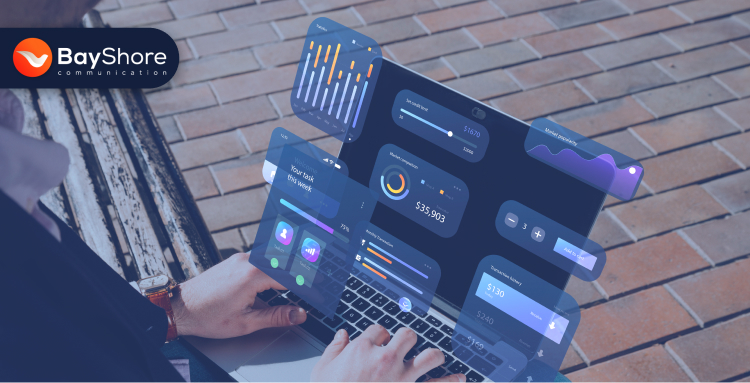
Operational inefficiencies are more than just minor setbacks, they're significant drains on your company's profitability and growth potential.
According to Forbes, integrating AI with IoT in manufacturing leads to increased efficiency, cost savings, enhanced product quality, and improved decision-making. The Internet of Things (IoT) bridges the gap between physical operations and digital intelligence, enabling:
Predictive Maintenance: Sensors detect equipment anomalies early, reducing downtime and maintenance costs.
Logistics: Real-time tracking of assets enhances supply chain visibility and efficiency.
Data-Driven Decision Making: Continuous data collection offers insights that inform strategic choices.
Companies adopting IoT solutions report substantial improvements in operational efficiency. For instance, the World Bank highlights that digitalizing sectors like maritime trade through IoT and related technologies enhances performance and economic competitiveness.
⇒How Bayshore Can Assist
We specialize in seamlessly integrating IoT technologies into your existing operations. Our tailored solutions provide the real-time data necessary to enhance performance, reduce costs, and drive continuous improvement.
Do you know the real challenge? Fraud and data breaches are not just occasional setbacks, they're significant threats that drain resources and enhance trust.
The evolution is blockchain technology. It offers tamper-proof transactions, decentralized record-keeping, and unparalleled transparency, making it a powerful tool in combating fraud and enhancing data security.
Integrating blockchain can drastically reduce fraud and bolster customer trust:
Fraud Reduction: Blockchain's immutable ledger makes it highly resistant to fraud. While specific percentages can vary, the technology's design significantly diminishes fraudulent activities. For instance, blockchain helps detect fraud by ensuring transaction data is secure and tamper-proof.
Enhanced Trust: The transparency inherent in blockchain allows customers to trace transactions and verify authenticity, strengthening trust in your brand. This increased transparency can lead to higher customer satisfaction and loyalty.
Our expertise ensures that your operations benefit from enhanced security and transparency, safeguarding both your data and your reputation.
6. Revolutionize Training and Engagement with AR & VR
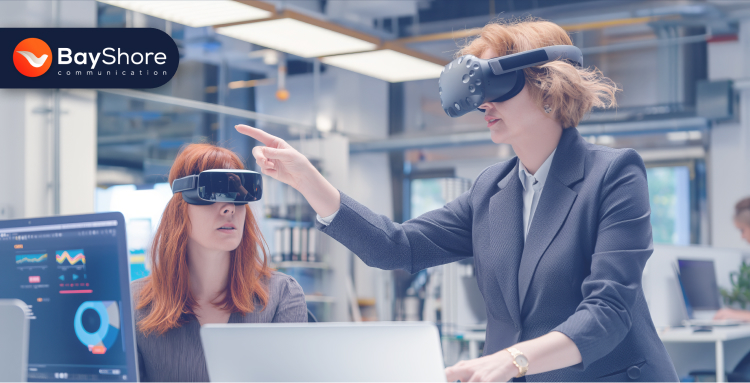
Traditional training methods are expensive, ineffective, and fail to engage employees. Integrating Augmented Reality (AR) and Virtual Reality (VR) into training programs offers a transformative solution.
⇒The Solution: Immersive Learning with AR/VR
AR and VR offer immersive, interactive training experiences that improve engagement, accelerate learning, and reduce costs. Employees can practice skills in realistic, virtual environments, leading to better knowledge retention and application.
Engagement Boost: According to Forbes, AR and VR capture attention more effectively, driving higher employee engagement.
Faster Learning: Studies show VR training can reduce learning time by up to 40% compared to traditional methods.
Cost Efficiency: VR training offers a 300% ROI, reducing training time, travel costs, and physical materials.
30% higher employee engagement with immersive training methods.
20% improvement in learning efficiency with AR and VR training.
Significant reduction in employee turnover due to more engaging training experiences.
Bayshore Communication specializes in integrating AR and VR into your training programs. Our solutions enhance engagement and deliver tangible results. Let us help you equip your workforce with the skills they need to succeed.
Do you know the actual threat? Cyberattacks and data breaches pose significant risks to businesses, with the cost of cybercrime projected to reach $10.5 trillion by 2025.
The solution is emerging cybersecurity technologies. Along with AI and machine learning, enable businesses to proactively detect and neutralize threats before they cause harm. These technologies analyze vast amounts of data to identify patterns and anomalies that indicate potential security breaches.
Companies leveraging advanced cybersecurity solutions have seen significant improvements in threat detection and prevention. For instance, Amazon reported an increase from 100 million to 750 million attempted cyber threats per day, attributing this rise to both heightened cybercriminal activity and the company's enhanced AI-driven threat monitoring capabilities.
At Bayshore Communication, we offer state-of-the-art cybersecurity solutions tailored to your business needs. Our AI and machine learning-driven approaches ensure your data remains secure and your operations continue smoothly, protecting what matters most to your business.
Dominate Your Market With Knowledge From These Related Blogs:
The Future of Digital Marketing with the Best SEO Company in Tampa
What are the most effective marketing strategies for small businesses?

The time to embrace emerging technologies is now. By integrating smart, scalable solutions into your operations, you’ll be setting your business up for sustainable success. The best part? You’ll start seeing tangible results sooner than you think.
Ready to take the next step? Partner with the right experts, make smart investments, and watch your business unlock unmatched growth and efficiency. The future is waiting for you. Let’s make sure you're leading the way. Contact Bayshore today and get started.

April 29, 2025
Marketing has always been about one thing- getting in front of the right people at the right time. What’s changed? The way people find, research, and choose businesses. Your customers aren’t flipping through phone books or waiting for TV commercials; they’re scrolling through social media, searching Google, and reading online reviews. You're invisible if your business isn’t showing up where they are.
Digital marketing isn’t about chasing trends or burning cash on ads that don’t convert. It’s about reaching the right people, capturing attention, and turning clicks into customers. Each piece plays a role in SEO, PPC, social media, and email. Mastering them all at once? Impossible. However, building a system that works? Let’s see how Bayshore built that system to drive growth for businesses like yours.
The biggest mistake businesses make in digital marketing is skipping this essential first step: defining the target audience. Before you start posting on social media or investing in ads, you need to know exactly who you're speaking to and more importantly, who you're selling to. Without this clarity, you're just throwing your message into the void and hoping it sticks.
So, who is your ideal customer? It’s not about guessing. At Bayshore Communication, we use advanced audience research tools to identify the right people for your business We ask the tough questions:
What are their pain points?
We dig deep into search queries, competitor analysis, and consumer behavior to understand the challenges they face. The more we know about their struggles, the better we can offer solutions.
Where do they spend time online?
Is it Google? Instagram? LinkedIn? Or TikTok? Knowing where your audience spends their time allows us to focus on the right platforms, maximizing your visibility and engagement.
We don’t just make assumptions; we use data-driven insights to shape every marketing move. We ensure that your efforts reach the right people at the right time. This is how we help our clients save time, money, and resources by marketing effectively, not just broadly.
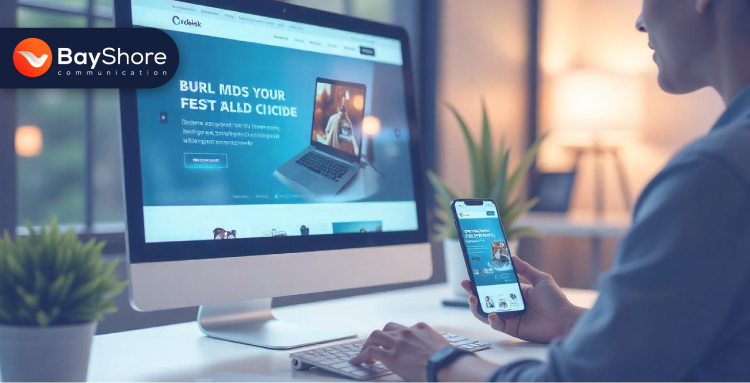
Think just having a website is enough? Think again. In today’s fast-paced digital world, your website is your digital storefront, and if it’s slow, confusing, or poorly designed, visitors will leave before they even see what you offer.
A website is more than a place for potential customers to land, it’s a powerful tool for converting visitors into leads and sales. At Bayshore, we don’t just design websites; we optimize them for performance. Here’s how we do it:
Fast Load Speed: In a world where consumers expect instant results, slow websites are a killer. According to Forbes, 53% of mobile users will abandon a site if it takes more than three seconds to load. Slow load times directly impact your sales and conversion rates. That's why speed is a top priority for us.
Mobile Responsiveness: With over 60% of global web traffic coming from mobile devices, your website must be mobile-friendly. If it's not, you're not just losing out on potential customers and you're actively turning them away. Mobile optimization isn’t optional; it’s a must. Check this out: How to Design a High-Converting Website: Key Elements for Success
Clear Call-to-Action (CTA): Every page on your website should have a clear, compelling CTA. Whether it's to buy, book a consultation, or contact you, a well-designed CTA guides your visitors toward the next step. In fact, a strong CTA can increase conversions by as much as 121%.
SEO-Optimized Structure: If Google can’t find you, your website is practically invisible. We structure every website with SEO best practices to ensure it’s optimized for search engines and ranks well. With Google’s algorithm updating hundreds of times a year, staying on top of SEO trends is critical for visibility and lead generation.
Our clients don’t just get pretty websites, they get lead-generating machines that drive business growth. Businesses that optimize their website for conversion can see conversion rates increase by up to 200%. With Bayshore, we ensure your website isn’t just another digital brochure—it’s a powerhouse that works for you.
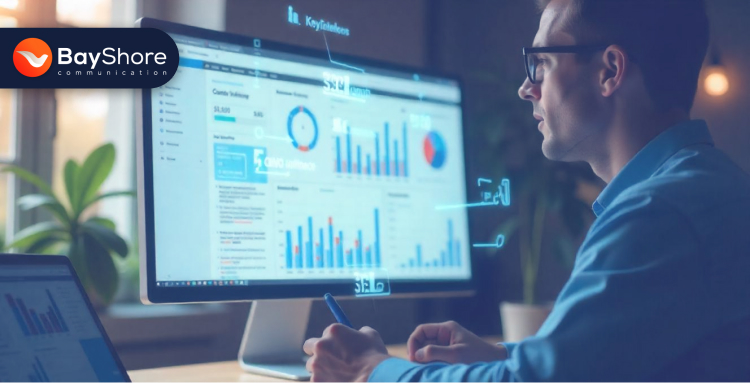
Want to rank on Google without draining your budget on paid ads? That’s where Search Engine Optimization (SEO) comes in. However, SEO isn’t just about stuffing keywords into a webpage. It’s about understanding search intent and delivering exactly what users need when they need it.
Keyword Strategy That Brings Leads, Not Just Traffic
Many businesses focus on high-volume keywords, hoping for more visitors. However, traffic alone doesn’t pay the bills, conversions do. We target buyer-intent keywords, which are search terms used by people ready to take action. According to Forbes, 75% of users never scroll past the first page of search results meaning if you’re not ranking for the right keywords, you’re invisible to potential customers.
Content That Ranks and Converts
Google prioritizes valuable, well-researched content that answers users’ questions. That’s why we create high-quality blogs, FAQs, and resource pages designed to not only rank However, drive engagement and trust.
Technical SEO: The Hidden Factor That Can Make or Break Your Rankings
A slow or broken website can tank your rankings—Google’s algorithm takes site speed, mobile usability, and crawl errors into account. In fact, a one-second delay in page load time can reduce conversions by 7%.
Slow site speed (which increases bounce rates)
Broken links (which damage user experience)
Crawl errors (which prevent Google from indexing your site properly)
With Bayshore, SEO is a measurable, results-driven strategy. Our clients don’t wonder why they aren’t ranking—we show them exactly how we’re getting them on page one and keeping them there.
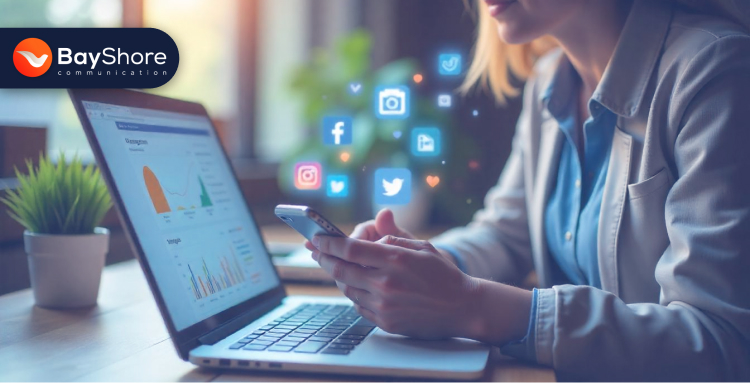
Too many businesses treat social media like a billboard; posting content and hoping people notice. However, social media isn’t about broadcasting; it’s about building relationships. With us, you can build communities. And that’s what drives real business growth.
Content With a Purpose; No Filler, Just Results
Every post should serve a goal: brand awareness, engagement, or sales. Random posts don’t drive revenue. According to Forbes, 78% of consumers are more likely to buy from a brand they’ve interacted with on social media. That’s why we create strategic, high-impact content that speaks directly to your audience’s needs.
Engagement Matters: Because the Algorithm Says So
Social platforms reward interaction. The Economist reports that brands that actively engage in comments and direct messages see up to 40% higher organic reach than those that just post and walk away. We don’t let engagement opportunities slip by—we respond to:
Comments (to keep the conversation going)
DMs (to turn interest into action)
Discussions (because real engagement builds trust)
Paid Ads That Drive Revenue, Not Just Clicks
Boosting posts isn’t a strategy. Running highly targeted, data-driven campaigns is. Studies show that Facebook and Instagram ads deliver a 10x higher ROI when backed by audience research and strategic targeting. We analyze audience behavior to craft ads that convert whether it’s for lead generation, product sales, or brand awareness.
For our clients, social media isn’t just about likes—it’s about leads, revenue, and long-term brand loyalty. And we make that happen.
Many businesses burn through their ad budgets without seeing real results because they fail to test, tweak, and target the right audience.
A/B Testing: We Let Data Decide, Not Guesswork
Most companies launch one ad and hope it works. We test multiple versions (headlines, visuals, calls to action) to see which performs best. According to Forbes, A/B testing can increase conversion rates by up to 30%, proving that small optimizations lead to big wins.
Laser-Focused Targeting: Audience Precision That Drives Sales
Many advertisers target broad demographics and hope for the best. We go deeper. We refine audiences based on behavior, interests, and intent, ensuring that ads reach people ready to buy.
ROI-Driven Campaigns: Every Dollar Must Deliver
Clicks don’t pay the bills—conversions do. That’s why we track:
Conversion rates (to measure real success)
Cost-per-acquisition (to ensure efficient spending)
Return on ad spend (ROAS) (because profitability is the goal)
According to a Google Ads study, businesses earn an average of $2 for every $1 spent on PPC However, only when managed correctly. Our clients don’t just see more traffic; they see more customers and revenue.
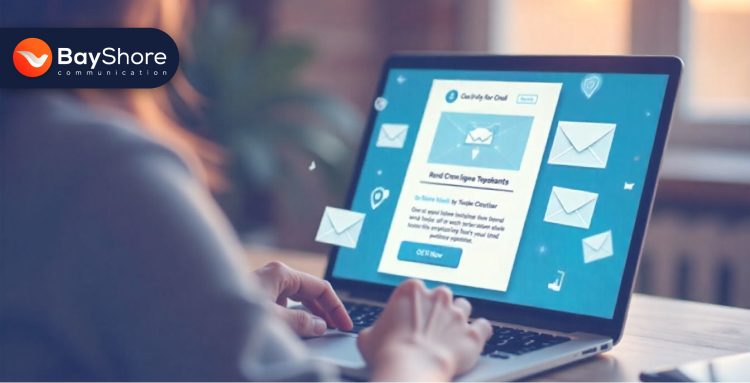
Email marketing remains one of the highest ROI strategies, generating $42 for every $1 spent, according to Forbes. When executed strategically, it builds long-term customer relationships and increases lifetime value.
Automated Lead Nurturing
Drip campaigns guide leads through the sales funnel, improving conversion rates. Statista reports that 80 percent of businesses using email automation see higher customer engagement.
Segmentation for Personalization
Mass email blasts no longer work. We tailor messages based on user behavior, preferences, and purchase history. Campaign Monitor found that segmented email campaigns drive 760 percent more revenue than non-segmented ones.
High-Conversion Copywriting
Email open rates improve when subject lines and content are optimized for engagement. A well-crafted email subject lines increase open rates up to 50 percent.
A common mistake businesses make is assuming a digital marketing campaign will succeed without continuous adjustments. In reality, continuous optimization is what separates profitable campaigns from wasted budgets.
Google Analytics & Heatmaps
We track user behavior, identify drop-off points, and optimize pages to improve conversions. Businesses that utilize user behavior analytics see a higher increase in customer retention.
Social Media Insights
Not all content performs equally. By analyzing engagement metrics, we refine strategies to ensure posts drive real interactions, not just impressions. Brands using data-driven social media strategies achieve higher engagement rates.
A/B Testing Across the Board
From ad creatives to website landing pages, we test and refine every element for maximum performance. Harvard Business Review reports that businesses using A/B testing improve conversion rates by an average of 49 percent.
Digital marketing isn’t about blindly spending on ads or posting just to fill up your feed, it’s about smart strategy, precise targeting, and continuous optimization. Getting started can be challenging, however, with the right approach, the results speak for themselves.
Ready to launch or optimize your digital marketing? Let’s talk. Our team is prepared to craft a personalized strategy that drives real growth for your business. Schedule a free consultation with Bayshore Communication today.

April 21, 2025
People process visuals 60,000 times faster than text. That means in the time it takes someone to blink, your image can hit them harder than a whole paragraph ever could. In a world where folks scroll past hundreds of posts a day, that speed isn’t just cool—it’s everything. It’s the difference between someone stopping to check out your stuff or just swiping by without a second thought.
Why’s this a big deal? Because in 2025, digital success is about grabbing attention fast and holding it tight. With attention spans dipping to like 8 seconds (less than a goldfish, seriously), visuals are your secret tactics to stand out. Let’s walk you through the best practices to make your visuals outstanding.
You can’t create impactful visuals if you don’t know who you’re creating them for. It’s like throwing darts in the dark—you might hit something, however, chances are, you’ll miss. Many top marketing sites mention audience research, but they barely scratch the surface. Let’s go deeper.
How to Get Inside Your Audience’s Head
Instead of guessing what your audience likes, use data to find out:
Google Analytics & Social Media Insights – Track who’s engaging with your content. Age, location, device type—it all matters.
X (formerly Twitter) & Instagram Polls – Quick and dirty way to test visual preferences. Post two image styles, and ask “Which one do you love?” Boom—instant feedback.
Heatmaps (Crazy Egg, Hotjar) – Want to know which part of your visual people focus on the most? Heatmaps show where users’ eyes (and clicks) go.
Also read: Why You Should Maintain Social Media Content Calendar for Your Business
Visual Personas
Every audience has a distinct visual language that resonates with them. Your job? Learn it and speak it fluently.
Gen Z – Loves bold colors, meme aesthetics, and casual, unfiltered content. Think BeReal vibes.
Millennials – Gravitate toward clean, aesthetic, slightly nostalgic visuals. Soft gradients? Yes, please.
Corporate Professionals – Appreciate polished, minimalistic designs with clear messaging. No fluff, just impact.
The more aligned your visuals are with your audience’s style, the more they’ll engage. Do a 5-minute hack to nail your audience’s visual taste. Run a poll on X or Instagram Stories. Show two different visual styles and ask, “Which one speaks to you?” It’s quick, free, and gives you real-time insights straight from your audience.
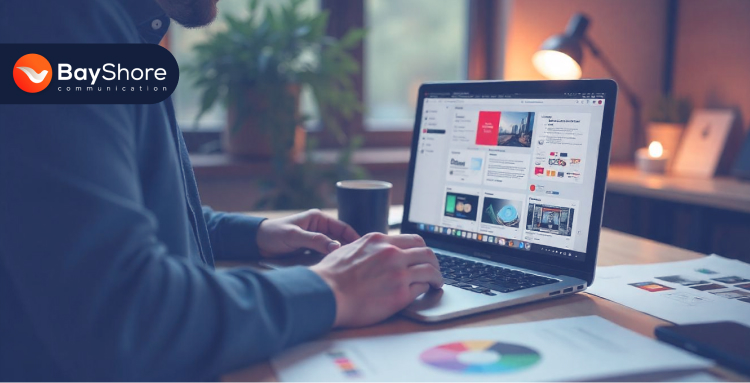
You’ve probably heard the usual design advice: “Keep it simple.” “Use good colors.” “Make it readable.” However, if you really want visuals that stop the scroll and drive engagement, you need to dig deeper. Big sites like Canva and Hootsuite touch on these principles; however, let’s take it up a notch.
Contrast & Hierarchy: How to Make Your Visuals Grab Attention
Ever wonder why some visuals immediately catch your eye while others just… fade into the background? That’s because of contrast and hierarchy.
Contrast: High contrast (like dark text on a light background) makes content easier to read and more attention-grabbing. Want to highlight something? Increase contrast.
Hierarchy: Your eyes naturally follow a visual path. Use size, boldness, and spacing to control where people look first. Example:
BIG, BOLD HEADLINE (grabs attention).
Medium-sized subtext (keeps them engaged).
Small, detailed text (for those who want to dive deeper).
Emotional Triggers: Make Them Feel Something
People don’t just look at visuals—they feel them. If you tap into the right emotions, your content becomes memorable and persuasive.
Trust & Reliability → Blue tones (Used by banks, tech brands, and social platforms like Facebook).
Urgency & Excitement → Red accents (Think “SALE” signs, breaking news banners).
Optimism & Energy → Yellow tones (McDonald's, Snapchat).
Nostalgia & Comfort → Retro filters (Soft grain, muted tones—used by brands like Nike & Levi’s).
Another example for you: Duolingo’s viral social posts use bright green text, meme energy, and playful design—because they know their audience loves chaotic, fun visuals.
Micro-Animations: Small Moves, Big Impact
Static images are cool, however a little motion goes a long way—especially in 2025’s increasingly interactive web.
Pulsing CTA buttons → Can boost clicks by up to 20%
Subtle hover effects → Make your site feel dynamic without overwhelming users.
Handwritten or “shaky” text animations → Add personality (especially for Gen Z & meme culture).
Do you remember that viral X (Twitter) post with neon green text + shaky animation? It worked because:
The neon contrasted hard against the dark background.
The movement made it impossible to ignore.
It felt handmade and personal, which increased the relatability.
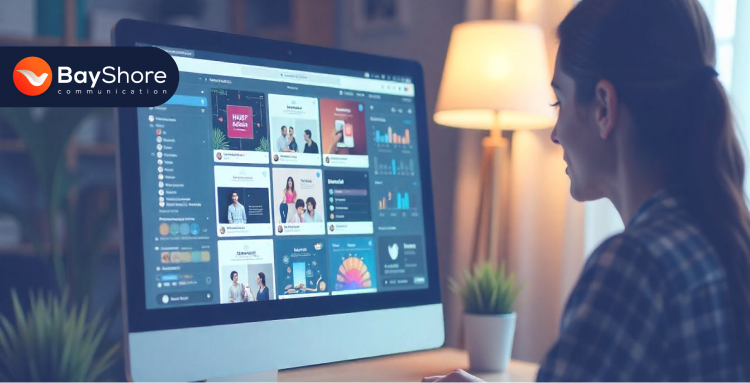
Most blogs give you the same tired advice: "Optimize for social media." Cool, however, what does that actually mean? Every platform has its own algorithmic preferences, user behaviors, and ideal formats. A killer LinkedIn post won’t necessarily work on Instagram, and a TikTok graphic might flop on X (formerly Twitter).
If you want to maximize reach and engagement, you need to customize your visuals for each platform in strategy.
X (Twitter): Snappy, High-Contrast Visuals Win
Ideal Size: 1200x675px (always landscape-friendly).
Key Strategy: Bold text overlays + 5-10 second loops for auto-play engagement.
Algorithm Hack: X prioritizes native images/videos over external links—upload directly for better reach.
Special tip for you: Tweets with memes, short GIFs, or high-contrast infographics get 3x more shares than plain text posts. A simple before-and-after comparison image with big, bold captions tends to go viral because it’s instantly digestible.
Instagram: Carousel Hacking for Dwell Time
Ideal Sizes: For feed, 1080x1350px (portrait format gets more engagement than landscape). If you go for stories & reels – 1080x1920px (vertical, full-screen).
Key Strategy: Use carousels to break down complex info—Instagram rewards posts that keep users swiping.
Split a long infographic into 10 slides (each revealing new info) to extend dwell time and boost reach. Instead of a single infographic, a step-by-step "how-to" guide split into 10 slides can increase saves and shares by 40%.
LinkedIn: Data-Driven Visuals Over Generic Stock Photos
Ideal Size: 1200x627px
Key Strategy: Charts & graphs > stock photos. LinkedIn’s professional audience engages more with data visualizations than with generic images.
Overlay key statistics on visuals—people are more likely to share a powerful data point than a random office pic. Instead of a boring “teamwork” stock image, post a simple bar graph showing a trend in your industry—it positions you as an expert and gets more engagement.
Trend Alert: AI-Generated Visuals (The Right Way to Use Them)
AI tools like Midjourney, DALL·E, and Runway are blowing up, however, here’s the challenge: AI visuals can feel robotic and generic. The trick is to mix AI efficiency with human creativity.
Use AI for: Rapid prototyping, background images, and concept visuals.
Avoid: Overly polished AI-generated faces (people can tell they’re fake).
Combine AI art with hand-drawn elements or text overlays to make it feel authentic and unique. A brand used AI to generate product mockups,and then added real-user photos to make the campaign feel personal. Result? 30% higher engagement than AI-only visuals.
Here’s one tip if you want to save time while still optimizing for multiple platforms. Create one design, then resize it automatically using a free tool like Photopea or Canva’s Magic Resize.
More for you: How Do I Boost My Brand Online Presence with Content Marketing?

People don’t just consume content—they connect with stories. That’s why an emotionally charged image can go viral while a fact-packed chart gets ignored. If you want your visuals to stick, you need to show, not just tell. Most marketers mention “storytelling,” however few actually explain how to execute it visually. Let’s fix that.
Turning Your Visual into a Story
Every great story follows the problem → struggle → solution arc. Your visuals should, too.
Before & After Images → Show transformation (e.g., a messy desk vs. an organized workspace).
Step-by-Step Graphics → Guide the viewer through a process (e.g., “How I grew my brand in 6 months”).
Contrast Emotions → Show frustration first, then relief (makes the “solution” feel stronger).
Multi-Frame Posts Build Suspense
One image is good. A series of images is better.
X (Twitter) Threads: Post a numbered sequence of images to guide viewers through a story.
Instagram Carousels: Instead of one infographic, break it into multiple slides to increase dwell time.
TikTok & Reels: A “reveal” at the end of a video makes people watch longer, boosting engagement.
Let me give you an example, a viral X thread showed a brand’s rebranding journey in 5 images—each one revealing a new phase. It kept users scrolling and engaged.
Show What People Feel
Do you know what gets more engagement than a sales chart? A photo of a happy customer holding a product. Why? Because emotions drive action.
A smiling child > A donation graph.
A frustrated user > A generic “bad UX” statistic.
A teary-eyed reaction > A press release about an award.
So, before jumping into Canva or Photoshop, grab a notebook and write down a 3-part story:
Setup: What’s the starting point? (Problem, challenge, or situation).
Conflict: What’s the struggle? (Tension, frustration, effort).
Resolution: What’s the transformation? (Solution, relief, success).
This simple trick forces you to think in stories, not just designs.

The design world moves fast. If you're still using the same tools from three years ago, you’re missing out on AI speed boosts, real-time team collaboration, and next-level analytics. Most blogs will tell you about Canva and Adobe, however, let’s go deeper—into the fresh, must-know tools shaping 2025.
AI Boosters: Work Smarter, Not Harder
Runway → AI-powered video editing, auto-removes backgrounds, and generates clips from text prompts.
DALL-E 3 → Generate unique, high-quality images in seconds (great for custom illustrations).
Khroma → AI-driven color palette generator—perfect for branding and theme consistency.
Pro-Level Tools Without the Price Tag
Photopea → A full-fledged Photoshop alternative—works in your browser, no installs needed.
CapCut → TikTok and Reels edit like a pro with free transitions, auto-captions, and effects.
Inkscape → Vector graphics on a budget—great for logo design and illustrations.
Analytics Add-Ons: See What Works (and What Flops)
Hotjar → See where people hover, click, and drop off on your website’s visuals.
Attention Insight → AI predicts how eye-catching your design is before you publish it.
Meta Business Suite → Real-time insights on which visuals perform best across Facebook & Instagram.
Collaboration Is the Future of Design
Figma → The ultimate team-based design tool—multiple people can edit at once.
Miro → Digital whiteboarding for brainstorming visual ideas together.
Descript → Video editing + transcription in one tool—edit your video by editing the text.
Once you’ve created your visuals, you need to measure how they’re doing, make adjustments, and then keep improving. Here’s how to stay ahead of the game.
Metrics That Matter
Instead, focus on things that show real engagement—like the engagement rate, click-throughs, and dwell time. These metrics give you a better idea of how your audience is interacting with your content.
Find Out What Works and What Doesn’t
Try testing a blue vs. a red call-to-action button (CTA) on your landing page, and track the results using UTM links to see which color grabs more clicks. The data will help you decide which direction to take.
How to Improve Your Visuals Fast
If your image isn’t converting, change something simple like the font style or size and repost it. Try to turn this around quickly—within 48 hours if possible—so you can gather data while the momentum is still fresh.
To wrap it all up, creating impactful visuals is more than just adding together some nice pictures. It’s about understanding your audience, following design principles that make your visuals pop, mastering platform-specific strategies, and telling a story that people connect with. But here’s the kicker: even once you’ve nailed that perfect visual, the work’s not done. Keep measuring, tweaking, and optimizing to make sure your content is always hitting the mark.
Now, if you’re thinking, “This sounds awesome, but where do I start?”—let me point you to Bayshore Communication. With our expert design and digital marketing services, we can help you create visuals that grab attention, drive engagement, and keep your audience coming back for more. Reach out to us today and let them help you elevate your content to new heights.

April 15, 2025
Did you know organic search accounts for 53% of all website traffic? This just highlights the essential role of SEO in driving visibility and engagement. Yet, without high-quality content, this traffic may not convert, leading to missed opportunities. Moreover, 81% of marketers are using content marketing in the B2B sector, highlighting its widespread adoption and importance. However, without effective SEO strategies, even the most compelling content can remain undiscovered, limiting its impact.
The technical cooperation between content marketing and SEO is undeniable. When integrated effectively, they can significantly enhance a brand's online presence and drive sustainable growth. But how can businesses merge these strategies to elevate their digital success? Let’s find out.
Content marketing and SEO go hand in hand when it comes to growing your business online. Together, they help you reach more people, build credibility, and drive traffic in a way that feels real and sustainable. Here’s how they work when integrated:
While producing high-quality content is essential, without effective SEO strategies, this content may remain unseen by the intended audience. It's noteworthy that only 15% of search traffic clicks on paid advertisements or tries a different search, leaving the vast majority—85% clicking on organic search results. This statistic shows the importance of optimizing content to appear in organic search results, as failing to do so means missing out on a substantial portion of potential traffic.
Conversely, implementing SEO tactics without delivering valuable content can lead to high bounce rates. The average bounce rate ranges from 41% to 55%, indicating that a significant number of visitors leave websites without engaging further. High bounce rates often result from content that doesn't meet user expectations or lacks relevance, signaling that attracting visitors through SEO is only half the battle; retaining them requires meaningful content.

In today’s fast-changing digital world, businesses need strategies that boost visibility and support lasting growth. We do this by combining smart keyword research with top-notch, SEO-friendly content that actually works.
Effective keyword research is the cornerstone of any successful SEO strategy. By identifying the terms and phrases potential customers use, businesses can tailor their content to meet search intent, thereby attracting targeted traffic. Bayshore Communication employs advanced AI tools to analyze vast amounts of search data, uncovering trends that inform proactive content strategies.
Furthermore, understanding the competitive field is important. Through comprehensive competitive analysis, Bayshore ensures that clients not only identify opportunities but also benchmark their performance, inspiring innovative marketing and product development ideas.
Once the right keywords are in place, the next step is crafting content that not only informs but also captivates and converts. At Bayshore Communication, we specialize in creating a range of content. From blog posts and landing pages to case studies and multimedia pieces that truly connect with your audience.
But simply creating great content isn't enough. Optimizing it is vital. By strategically placing relevant keywords, writing irresistible meta descriptions, and using smart formatting, we help ensure your content gets the attention it deserves. Did you know that content with relevant keywords ranks 434% better than content without? .This kind of optimization boosts your visibility and drives meaningful, organic engagement, helping your business grow.
Effective on-page and technical SEO strategies are crucial for improving search engine rankings and user experience. Bayshore Communication focuses on:
Optimized Headlines, Meta Descriptions, and Internal Linking: Engaging headlines and compelling meta descriptions do more than attract search engines. They capture user interest and encourage higher click-through rates. Strategic internal linking plays an important role as well, guiding visitors effortlessly through your site while strengthening page authority. These deliberate yet often overlooked elements work together to enhance both user experience and search rankings.
Technical SEO Improvements: Addressing technical aspects such as site speed and mobile optimization is vital. According to the World Bank, global Internet penetration continues to rise, with mobile browsing accounting for more than half of all web traffic. Ensuring a fast-loading, mobile-optimized website is no longer optional; it’s essential for reaching and retaining your audience
A well-structured website with fast load times. A mobile-friendly design ensures that users can browse your site effortlessly on any device. It also helps search engines access and index your content more efficiently, leading to better rankings and improved user satisfaction.

Building a strong backlink profile is essential for establishing your website's authority. Bayshore Communication implements:
High-Quality Backlinks: Acquiring backlinks from reputable and relevant websites signals to search engines that your content is trustworthy and valuable, which can improve your site's authority and ranking.
Guest Blogging and Outreach Strategies: Engaging in guest blogging and outreach initiatives allows you to showcase your expertise on external platforms, attracting new audiences and earning quality backlinks. This approach not only enhances your site's authority but also broadens your brand's reach.
To ensure ongoing success, Bayshore Communication emphasizes:
Ongoing Performance Audits and Data-Driven Refinements: Routine audits uncover opportunities for improvement, ensuring your SEO strategy evolves with search engine algorithms and industry trends. By closely analyzing key performance metrics, Bayshore makes precise, data-backed adjustments that keep your website competitive and optimized for growth.
Clear, Actionable Reporting: Transparency is at the core of Bayshore’s approach. Detailed performance reports provide a clear breakdown of your SEO results. It gives you full visibility into what’s working, what needs refinement, and how your investment is driving measurable success.
Looking to expand your knowledge? Have a look at these related articles:
Let’s talk about what actually works. Not empty promises, not trends that fade, not SEO tricks that crumble at the first algorithm change.
The internet is crowded, noisy, and full of brands shouting all the time. Most disappear. A few stand tall. Why? Because they have a foundation, a structure, and a plan that isn’t just about ranking today but owning the space for years to come. That’s what we do. No fluff, no shortcuts—just sharp, deliberate strategies that make your brand impossible to ignore.
Ready to stop blending in? Let’s build something that lasts. Contact Bayshore Communications today.

April 6, 2025
80% of small businesses fail within the first five years. Not because they lack great products or services but because no one knows they exist. You’ve seen it before—a small coffee shop tucked between two big-name chains, fighting for attention. At first, it’s empty. Then, one day, a line stretches out the door. No flashy ads. No giant billboards. Just a loyal crowd that keeps coming back.
What changed? Smart marketing. Small businesses don’t need the biggest budget to win. They need the right strategies to turn a quiet corner shop into the go-to spot. The kind that helps you stand out without shouting. So, what’s the secret? Let’s find out.
Social media isn’t just for sharing updates; it’s a powerful marketing tool that connects businesses with their ideal customers. Small businesses boost brand awareness on platforms like Facebook, Instagram, LinkedIn, and TikTok, engage directly with their audience, and drive real sales. However, simply having a profile isn’t enough; consistent, strategic content is important to making an impact.
How Bayshore Communication Helps:
At Bayshore Communication, we take the guesswork out of social media marketing by crafting custom strategies that align with your business goals. Here’s how we do it:
Audience-Driven Strategy: We analyze your ideal customers, where they spend time online, what content they engage with, and how they make purchasing decisions.
Engaging Content Creation: From eye-catching graphics and short-form videos to educational posts and interactive polls, we create content that sparks conversations and keeps your brand top of mind.
Targeted Ad Campaigns: We design and manage high-performing ads that reach the right people at the right time.
Performance Tracking & Optimization: We monitor campaign results and adjust strategies to keep engagement and conversions growing. Check this out for more: Why Does Your Business Need a Strong Social Media Presence?

By consistently producing valuable content such as blogs, videos, and guides, companies can position themselves as leaders in their industry. Notably, content marketing can generate 3 times the leads per dollar spent compared to paid search, making it a cost-effective strategy for small businesses.
How Bayshore Communication Assists:
SEO-Optimized Blogging: We craft well-researched, SEO-friendly blog posts that not only resonate with your target audience but also improve your search engine rankings, driving sustainable organic traffic.
Engaging Visual Content: Our team produces high-quality videos and infographics, recognizing that over 90% of businesses utilize video marketing to reach and engage their audience effectively.
Strategic Content Planning: We develop comprehensive content strategies that ensure the consistent delivery of valuable information. This keeps the audience engaged and coming back for more.
How Bayshore Communication Helped Catflix Dominate Its Niche
Catflix aimed to become the top streaming service for cat lovers, but standing out required a strong content strategy. Bayshore Communication crafted SEO-driven blogs and engaging videos. These helped organic traffic and subscriber growth. Our efforts established The Catflix as both an entertainment hub and a trusted resource, and we built audience trust and loyalty.
Our content marketing approach increased engagement, strengthened brand identity, and drove revenue growth. As a result, “The Catflix” became the leading platform for cat enthusiasts, proving the power of strategic content in transforming a brand.
Email marketing remains a powerful tool for nurturing leads, engaging customers, and driving repeat business. Despite evolving digital landscapes, email marketing continues to deliver a high return on investment, with an average ROI of approximately $40 for every dollar spent.
How Bayshore Communication Assists:
Automated Email Sequences: We design automated email sequences that guide potential customers through the sales funnel, delivering timely and relevant content to nurture leads effectively.
Personalized Campaigns: Recognizing the importance of personalization, we craft email campaigns according to individual subscriber preferences, increasing open rates and engagement.
List Building and Segmentation: Our team focuses on building and segmenting email lists. This approach ensures that the right messages reach the right audiences, enhancing the effectiveness of each campaign.
Enhancing Catflix's Engagement
For Catflix, Bayshore Communications created a strong email marketing strategy for “The Catflix”. We built a targeted list of cat lovers and sent regular newsletters with fresh content, special deals, and updates. This kept subscribers engaged, built a loyal community, and boosted sales.

Local Search Engine Optimization (SEO) is essential for businesses aiming to attract customers in their vicinity. When individuals search for services "near me," local SEO strategies ensure that your business appears prominently in the results, increasing visibility and potential customer engagement.
How Bayshore Communication Assists:
Optimizing Google My Business (GMB) Profiles: We enhance your GMB profile by ensuring all information is accurate, adding high-quality images, and regularly updating posts. This optimization significantly boosts your business's visibility in local searches.
Ensuring Mobile-Friendly, Keyword-Optimized Websites: Recognizing that a significant portion of local searches occur on mobile devices, we ensure your website is mobile-responsive and highly converting. Plus, we ensure the website is optimized with relevant keywords for better user experience and search rankings.
Encouraging and Managing Customer Reviews: We implement strategies to encourage satisfied customers to leave positive reviews, enhancing your business's credibility. Engaging with these reviews also positively influences your rankings in local search results.
Triplaw’s Digital Transformation: A Global Reach Success
When Triplaw needed to expand its global reach, Bayshore Communication delivered a powerful digital overhaul.
Enhanced Website for Smooth Navigation: Bayshore redesigned Triplaw’s website to be intuitive, user-friendly, and accessible to clients worldwide. The streamlined interface made navigating immigration processes effortless, turning complexity into clarity.
SEO for Maximum Visibility: A great website needs visibility. Bayshore implemented strategic SEO, keyword research, meta tag optimization, and technical improvements, enhancing Triplaw’s search rankings and making it a top choice for immigration services.
The result? Increased traffic, higher engagement, and a growing international client base. Bayshore’s expertise turned Triplaw into a trusted global resource.
Paid advertising platforms like Google Ads and Facebook Ads enable businesses to swiftly connect with their target audiences, driving immediate visibility and engagement. For instance, Google reports that advertisers earn an average of $8 for every $1 spent on Google Ads, highlighting the platform's effectiveness.
How Bayshore Communication Assists:
Developing High-Converting Ad Campaigns: We personalize ad campaigns to align with your specific business objectives, ensuring each advertisement resonates with your target audience and prompts action.
Continuous Analysis and Optimization: Our team monitors ad performance, making data-driven adjustments to reduce costs and enhance conversion rates, thereby maximizing your return on investment.
Implementing Retargeting Strategies: We employ retargeting techniques to re-engage website visitors, ensuring potential customers remain connected to your brand and move closer to making a purchase. Likewise, all of our clients got 5x the minimum ROI.

In a digital world overflowing with ads, consumers crave authenticity. Studies show that 61% of consumers trust influencer recommendations over traditional brand advertisements. Partnering with the right influencers allows businesses to connect with audiences genuinely, increasing brand awareness and credibility.
How Bayshore Communication Helps:
Finding the Right Fit: Not every influencer is a good match for your brand. We identify individuals whose audience aligns with your business goals, ensuring engagement from potential customers, not just passive followers.
Building Strong Partnerships: Effective influencer marketing is more than just paying for a post. We negotiate collaborations that create authentic content, positioning your brand as a trusted solution rather than just another ad.
Tracking Performance for Real Results: We go beyond vanity metrics like likes and views. By analyzing engagement rates, conversions, and audience sentiment, we ensure that influencer campaigns drive measurable business growth.
According to Forbes, 74% of consumers trust online reviews and content more than traditional advertisements. This secures placements in respected online publications, blogs, and industry-specific websites so you can build brand authority and enhance your credibility.
How Bayshore Helps:
We connect your business with key media outlets to increase visibility and enhance brand recognition.
Our team fosters relationships with journalists, bloggers, and influencers to position your brand as an authority in your industry.
We track campaign performance to ensure your brand reaches the right audience and generates meaningful engagement.
Marketing automation saves time. It streamlines emails, social media, and lead nurturing. Small businesses boost efficiency and ROI with it. With the right tools, you can engage prospects, nurture leads, and convert them into loyal customers all on autopilot.
How Bayshore Helps:
We implement the latest marketing automation tools to help you engage prospects at every stage of the buyer’s journey.
Our team sets up automated email workflows, and social media posting schedules, and leads nurturing campaigns, enabling you to maintain a consistent and efficient presence.
We constantly monitor and optimize your automated campaigns to ensure maximum return on investment and customer engagement.
A brand isn’t just a logo or a tagline—it’s the feeling people get when they see your name. It’s the reason they remember you, trust you, and come back to you. However, without consistency, a brand is just noise, scattered across platforms, lost in the shuffle.
We create style guides that make sure your brand speaks the same language everywhere—on social media, in ads, and on your website. We design logos, templates, and visuals that don’t just look good but mean something. And we build messaging that sticks, words that don’t just fill space but define who you are.
Because a brand isn’t built in a day. It’s built in the details, in the moments where customers realize they know you, they trust you, and they’ll choose you again. Let’s make that happen. Let’s make your business unforgettable.

March 25, 2025
Ever notice how some brands stay in your mind while others disappear? A great logo or a catchy tagline might grab attention. However, the real goal is to lead people from that first spark of interest to actually doing something with it.
The same challenge exists on a larger scale. In Northern Mali, the World Bank found that development agencies provided government-funded services but branded them as their own. As a result, people didn’t trust the government because they didn’t realize it was behind the support they received.
Now, think about marketing. If people recognize your brand but never actually buy, sign up, or get in touch, then all that effort isn’t really paying off. In this guide, we’ll walk you through how to create a marketing funnel that turns awareness into conversions, step by step.
The first step in any marketing funnel is creating awareness. It’s about making sure your target audience knows who you are and what you offer. So, how do you make a memorable impression when you're competing for attention on crowded platforms?
Identifying Target Audiences
To create a brand that truly connects, start by understanding your audience beyond basic demographics. Technographic data plays a key role in analyzing the technology they use, their preferred devices, and the social platforms they engage with most. These insights allow you to refine your marketing, ensuring your message reaches the right people in the right way.
Building Brand Presence
Once you know your audience, the next step is visibility. Social media helps you get noticed and engage with a broad audience. From eye-catching posts to relevant conversations, it makes your presence felt instantly.
Content marketing positions you as an authority. Blogs, podcasts, and videos boost engagement while sharing valuable knowledge. Meanwhile, SEO ensures your website ranks when customers search for solutions you offer.
Emotional Engagement
To develop brand loyalty and long-term relationships, your brand's messaging should resonate on an emotional level. Think about the feelings you want to evoke in your audience. Craft messages that leave an unforgettable experience, and you'll create a community that is more than just customers.
More for you:
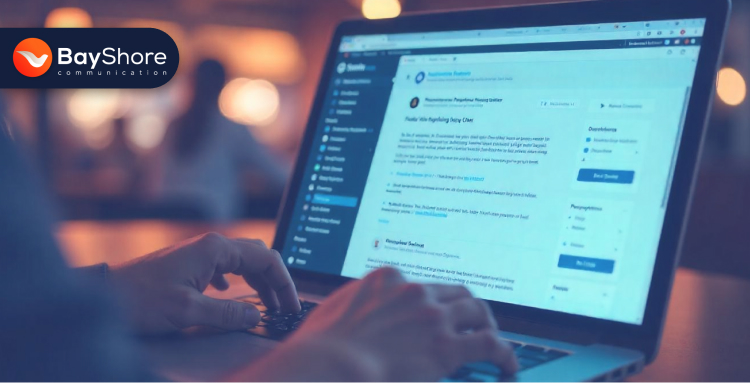
Once you’ve captured your audience’s attention, the next challenge is nurturing that interest. Now that potential customers know who you are, how do you keep them engaged?
Educational Content Creation
At this stage, your audience wants more than just a catchy motto or pretty picture. They want information that can solve their problems. Educational content is important to engage these individuals and establish trust. Think blogs, webinars, e-books, and infographics—anything that offers value and demonstrates your expertise.
Personalized Communication
Nowadays people are looking for personalized experiences that speak directly to their needs. That’s where email marketing comes in. With the help of automation, you can send customized content based on user behavior and preferences. This isn’t just about sending the same email to everyone; it's about creating segments based on interactions, interests, or past purchases. By doing so, you ensure that every piece of communication is relevant and adds value to your prospect’s journey.
Social Proof and Testimonials
When people see others have had positive experiences with your brand, they’re more likely to trust you. Social proof—through reviews, success stories, and testimonials—builds credibility.
Rather than just telling your audience how great you are, show them. Highlight real-life examples of how your product or service has made a difference. Testimonials, ratings, and case studies provide the confidence potential customers need to take the next step.
By now, your potential customers are engaged and interested. It’s time to push them closer to making a decision. This stage is about providing them with the information and experiences they need to feel confident in their choice.
Retargeting Strategies
Not everyone who interacts with your brand will immediately make a purchase. That’s where retargeting ads come in. If someone visits your website or engages with your content but doesn’t convert, you can retarget them with ads that bring them back to your site. These ads can remind them of your product, highlight features they might have missed, or offer incentives to finalize the decision.
In-Depth Case Studies
At this point, your audience is likely weighing their options. Case studies offer a deeper dive into how your product or service can help them. Detailed examples of how you've solved similar problems for other customers can help alleviate any lingering doubts. Case studies are a powerful tool for illustrating the tangible benefits of your offering, showing your prospects that they are making a smart choice by opting for your solution.
Free Trials and Demos
Sometimes, people need to see the product in action before committing. Offering free trials or demos lets potential customers test out your product or service with no strings attached. This hands-on experience can provide the reassurance they need to make an informed purchase decision.

Now, it’s time to close the deal. Your prospects are ready, but how do you ensure that they take the final step and make a purchase?
Optimizing Landing Pages
Your landing page is your sales pitch in digital form. Every element of the page should be designed with the customer’s journey in mind, from headlines to images to calls-to-action (CTAs). Make sure your CTAs are clear and direct, urging visitors to take the next step. A well-designed landing page can make all the difference between a completed purchase and a bounced session.
Simplified Checkout Processes
Cart abandonment is a major issue for e-commerce businesses. If your checkout process is too complicated, your customers may bail at the last minute. Simplify the process by cutting unnecessary steps, offering multiple payments, and clarifying shipping details to reduce friction. A smooth checkout experience can make the difference between someone walking away and someone completing their purchase.
Limited-Time Offers
Creating a sense of urgency can often be the push that prompts a customer to make a purchase. Limited-time offers or flash sales can drive immediate action. Whether it’s a percentage off, a bundle deal, or an exclusive bonus, time-sensitive promotions can create a fear of missing out (FOMO), which often drives conversions.
Acquiring new customers is important. However, retaining them is just as crucial. In fact, loyal customers are often your best brand advocates. Here's how you keep them coming back.
Post-Purchase Engagement
Your relationship with customers doesn’t end once the sale is complete. Post-purchase engagement is all about maintaining the connection and keeping customers happy.
Personalized follow-ups thanking them for their purchase, offering support, or providing exclusive deals can strengthen your relationship. Continuing to deliver value after the sale shows that you care about their experience and not just their money.
Community Building
Customers who feel like they belong are more likely to stick around. Community building can take many forms, from social media groups to loyalty programs or even offline events. Creating a space for your customers to connect with each other and with your brand enhances a sense of loyalty and belonging. It turns a transactional relationship into a community-driven one.
Loyalty Programs
Rewarding repeat customers with exclusive discounts, early access to new products, or special perks is a great way to ensure they stay loyal to your brand. Loyalty programs not only increase the lifetime value of a customer but also encourage them to spread the word about your brand.
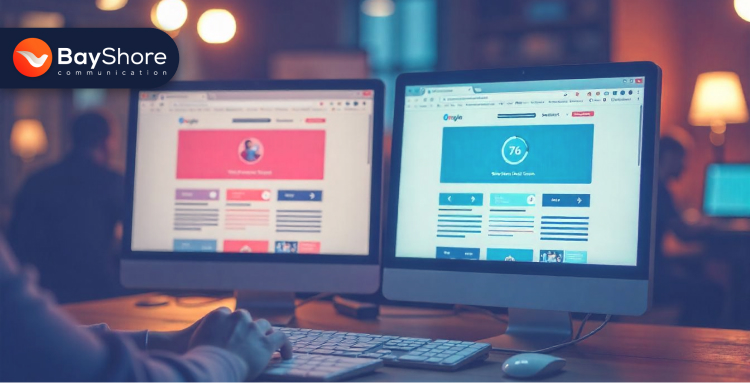
Use data-driven decision-making and A/B testing to fine-tune each stage. Monitoring funnel performance with analytics tools can reveal where customers are dropping off and help you refine your approach. Additionally, technographic segmentation allows you to apply deeper insights into consumer technology usage to further personalize your marketing efforts.
Continue Your Learning with More Tips
How to Design a High-Converting Website: Key Elements for Success
Mobile Excellence: How a Responsive Website Can Transform Your Business
We recognize that the path from building a brand to securing conversions goes beyond just drawing attention. It’s about cultivating meaningful connections that turn prospects into committed customers. Our approach is built around helping you succeed at every phase of the marketing funnel. Here's how we can help:
Effective Branding
Our first step is understanding your brand and its audience thoroughly. We use advanced tools like technographic data to identify the most effective ways to connect with your target market.
Engaging Content and Education
Once we’ve captured your attention, we ensure your audience stays interested. Our team excels at creating content that resonates with potential customers, whether it’s blogs, e-books, or webinars. Each piece of content is designed to address your audience’s challenges while positioning your brand as a trusted resource. This educational approach keeps customers engaged as they move through the funnel.
Driving Conversions
With interest in your brand established, we focus on guiding prospects to the final decision. We use retargeting ads, case studies, and trials or demos to help customers experience the value of your product or service. We also ensure the buying process is simple, with clear calls to action and a seamless user experience that encourages final purchases.
Building Loyalty
The work doesn’t end once a customer makes a purchase. We help you keep the connection alive through follow-ups, exclusive offers, and community-building initiatives.
So, if you’re ready to take your marketing efforts to the next level and see real, lasting results, contact us today. Let’s work together to turn your branding into a conversion-driven strategy.

March 20, 2025
Did you know as per Forbes nearly 80% of consumers conduct online research before purchasing? Businesses without a solid digital marketing strategy risk being left behind. In fact, companies investing heavily in digital marketing see a nearly 50% higher ROI than those relying solely on traditional marketing methods.
The truth is, digital marketing isn't just a trend—it can transform the trajectory of your business. But here’s the question: How do you use it effectively to ensure you’re not just another business in the digital crowd?
Let’s break down why digital marketing is essential for your business and how you can stay ahead of the competition in 2025.
Global digital channels and SEO are the foundation of any successful marketing strategy. They drive both immediate and sustained growth, here’s how :
Digital marketing enables businesses to reach both local and global markets, with over 60% of the world’s population now having internet access, which continues to grow. This global reach allows you to target a diverse audience, 24/7, and scale your efforts quickly and cost-effectively. With 5.1 billion mobile users worldwide, businesses can tap into vast customer bases, even in international markets. This enables your business to grow faster than ever before
Search Engine Optimization (SEO) is a cornerstone of digital marketing, essential for enhancing your business's online visibility. Approximately 68% of online experiences begin with a search engine, underscoring the importance of a robust SEO strategy. As of January 2025, Google commands about 89.79% of the global search engine market share, making it imperative for businesses to secure prominent positions in Google search results to reach a vast audience.
Effective SEO practices are important for business growth, such as keyword optimization, quality content creation, and strategic backlinking, which drive organic traffic to your website, which is almost 1,000% more traffic than organic social media. This targeted traffic leads users to actively seek products or services you offer actively, continually attracting potential customers with enduring benefits.

Digital marketing offers businesses an array of cost-effective tools that can drive significant results even at a minimal cost. Here are affordable methods beneficial for the business:
Social media ads, content marketing, and email campaigns are prime examples. Social media platforms like Facebook and Instagram allow businesses to run highly targeted ads starting at just a few dollars a day, offering remarkable reach at a fraction of the cost of traditional ads.
For instance, businesses that invest in content marketing see conversion rates 6 times higher than traditional methods, and it's 62% cheaper to acquire leads through content marketing than traditional marketing. With tools like Google Analytics, businesses can optimize campaigns on the fly, making quick adjustments to improve results and maximize ROI.
Email marketing delivers impressive results, with an average ROI of $42 for every $1 spent. This makes email one of the most cost-efficient marketing strategies available today, especially for nurturing leads and building customer loyalty over time. These affordable methods enable businesses to establish meaningful connections with their audience, promote brand awareness, and generate sales without overspending.
When comparing the cost-efficiency of digital marketing to traditional marketing, the difference is striking. According to Forbes, digital marketing provides businesses with the ability to use precise targeting, ensuring that marketing dollars are spent efficiently. Traditional advertising, such as TV and radio, can cost companies huge amounts per campaign, such as the cost of a 30-second TV ad can range from $5,000 to $50,000 for production, and individual 60-second radio ads can cost between $5 to $750 ( depending on various factors) and the results are often broad, making it harder to measure ROI.
On the other hand, digital marketing tools such as Google Ads, which reached a global spend of $278 billion in 2023 enable businesses to target specific audiences by offering better cost-per-conversion rates.
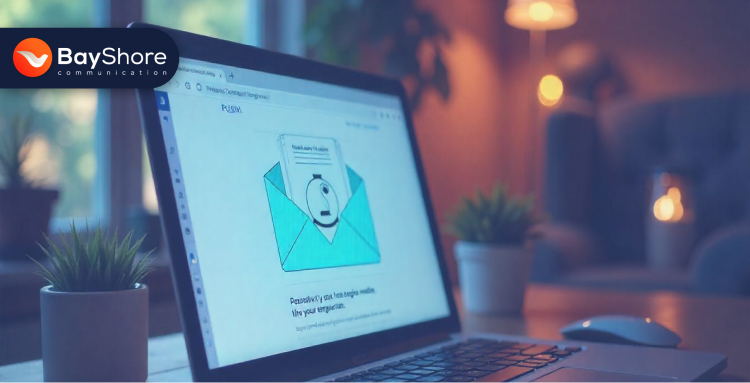
Let’s take a closer look at Precision targeting with data-driven personalization, and how businesses can craft marketing campaigns that resonate deeply with their audience, drive higher engagement, and ultimately, increase conversions.
Successful marketing is no longer about casting a wide net; it’s about reaching the right people with the right message at the right time. With advanced data analytics and AI-driven insights, businesses can now refine their targeting like never before. Tools like Google Ads, Meta Business Suite, and CRM systems allow companies to segment audiences based on demographics, interests, online behavior, and past interactions.
This level of precision ensures that marketing budgets are spent effectively, reaching customers who are most likely to convert. Businesses using real-time analytics can adjust their strategies instantly, ensuring maximum engagement and minimal wasted spending.
Consumers expect personalized experiences, and brands that deliver them see significantly higher engagement rates. A study found that 80% of consumers are more likely to purchase from a brand that offers personalized interactions. Whether it’s tailored email campaigns, dynamic website content, or AI-powered chatbots, personalization makes customers feel valued, increasing loyalty and lifetime value.
Email marketing is a prime example. Personalized subject lines alone can boost open rates by 26%, and targeted email campaigns generate 760% more revenue than generic blasts Similarly, e-commerce platforms that use AI-driven recommendations see conversion rates jump by 30% or more.
When you combine expert content with authentic social proof, brands gain visibility, credibility, and long-term customer trust in the digital space. Here’s how they stand out:
Valuable content builds trust. Blogs, videos, and social media establish expertise, with content marketing generating 67% more leads and costing 62% less than traditional methods. Video marketing accelerates revenue growth by 49%. Consistent, high-quality content keeps brands top-of-mind and creates long-term trust. Check this out to know more: Should we write our website content using AI tools?
Consumers trust real experiences—92% prefer recommendations over ads. Reviews, testimonials, and user-generated content boost credibility, with businesses seeing 34% higher conversions when featuring testimonials. Encouraging customer feedback on platforms like Google, Yelp, and Trustpilot strengthens brand reputation and loyalty.

Digital marketing ensures businesses never close. A strong digital presence means businesses stay accessible, responsive, and profitable—anytime, anywhere. Here’s how you can never miss the scale:
Always-On Business Model
Customers expect accessibility, and websites, e-commerce platforms, and automation tools keep brands available 24/7, driving continuous engagement and sales. Global e-commerce sales surpassed $5.8 trillion in 2023, proving that businesses with an online presence capture revenue beyond traditional hours. AI-driven tools like automated emails and sales funnels make operations easier and smoother, converting leads even while you sleep.
Instant Interaction
Modern consumers demand immediate responses. Chatbots and live chat services reduce response times, with 79% of businesses reporting increased customer satisfaction after implementing AI-powered interactions. Meanwhile, social media engagement boosts conversion rates by up to 20% and emphasizes the value of real-time connections.
Incorporating data-driven strategies optimizes marketing performance and creates a culture of continuous improvement, leading to sustained growth.
In today's competitive landscape, data-driven marketing is essential for success. Utilizing advanced analytics tools, businesses can monitor key performance indicators (KPIs) such as click-through rates, conversion rates, and return on investment (ROI) in real time. This immediate insight allows for timely adjustments, ensuring marketing strategies remain effective and aligned with business objectives.
The digital marketplace is dynamic, requiring businesses to be agile. Real-time data empowers companies to swiftly modify their marketing tactics in response to emerging trends and consumer behaviors. With a data-driven approach, organizations can enhance their marketing effectiveness, leading to improved customer acquisition and retention rates.
Businesses can secure a competitive edge in this ever-evolving field by embracing these helpful and latest digital marketing trends.
Latest Trends and Tools
In 2025, staying competitive requires embracing cutting-edge digital marketing trends and tools. Artificial intelligence (AI) has become indispensable, enabling personalized customer experiences and efficient content creation. Brands are leveraging AI to analyze consumer data, predict behaviors, and tailor marketing strategies accordingly. AI-driven dynamic content adapts in real-time to viewer interactions, enhancing engagement and conversion rates.
Voice search optimization
Voice search is another critical trend, with the proliferation of smart speakers and voice-activated assistants changing how consumers seek information. Businesses are optimizing their content for voice queries to improve search visibility and capture this growing segment.
Augmented reality (AR)
This is transforming customer interactions by providing immersive experiences. Brands are integrating AR into their marketing strategies to allow consumers to visualize products in real-world settings, thereby enhancing purchasing confidence and reducing return rates.
For example, IKEA’s AR-powered app, IKEA Place, allows customers to virtually place furniture in their homes before making a purchase. This not only helps users make informed decisions but also reduces the likelihood of returns due to sizing or style mismatches.
Innovative Campaigns
Differentiation in a crowded marketplace hinges on creativity and innovation. Brands are developing unique campaigns that resonate with their target audiences and stand out from competitors. For example, the Ukrainian edtech startup Headway utilized AI tools like Midjourney and HeyGen to create engaging, personalized advertisements. This approach led to a 40% increase in return on investment for their video ads, demonstrating the effectiveness of combining AI with creative strategy.
Moreover, understanding and aligning with cultural moments can significantly boost brand relevance. These culturally attuned campaigns foster authentic connections and drive brand loyalty.
In today’s dynamic business environment, a strong online presence isn’t optional; it’s essential for growth. Companies that invest in strategic digital marketing see higher conversion rates, increased brand awareness, and a strong ROI. At Bayshore Communication, we don’t just follow trends; we anticipate them.
Our team crafts strategies that increase reach, boost engagement and drive revenue. From SEO and high-converting ad campaigns to compelling content and optimized websites, every move aligns with your business goals.
The question isn’t whether you need digital marketing, it’s how effectively you use it. Partner with Bayshore Communication to build a strategy that delivers real results.

March 13, 2025
According to Forbes, over 87% of consumers begin their purchasing journey with an online search, and for many companies, the digital realm has become their lifeline. Yet, as more businesses flood the online space, distinguishing your brand has become an art of its own.
The world is full of agencies, each promising results, each claiming to be the one. But where does one begin? A simple search won’t do—it never does. It’s not about algorithms or rankings; it’s about finding a partner who sees what you see, and who understands not just the mechanics of the digital world but the rhythm of your business.
When you’re looking for the best digital marketing agency, there are a few key things that should set them apart from the crowd. Here’s what makes a top digital marketing agency truly stand out:
Proven Track Record
One of the easiest ways to spot a top-tier agency is by looking at their success stories. If an agency can show you case studies or testimonials from clients who’ve seen significant growth, that’s a good sign they know what they’re doing. A proven track record means they’ve done the hard work of creating strategies that get results. Whether it’s helping a small local business boost its online presence or transforming a major brand’s digital footprint, its past success speaks volumes.
Strategies Backed by Data
It’s not enough to just run a few ads or post on social media. Data is the backbone of every successful campaign. The best agencies use analytics to track performance, tweak strategies, and keep improving. This approach ensures that your marketing budget is spent wisely and that each campaign is optimized for maximum impact.
All-In-One Services
A full-service agency covers all your digital marketing needs under one roof. From SEO (Search Engine Optimization) that helps your website rank higher in Google, to PPC (Pay-Per-Click) campaigns that drive traffic quickly, they’ll have the expertise to tackle multiple channels. Social media management, content marketing, email campaigns, and even website design—a top agency that provides all the services that work together to give your business a strong online presence.
Industry Expertise
Each industry has its own unique challenges, and a great agency knows how to adapt its strategies to fit. Whether you’re in e-commerce, healthcare, or real estate, they should understand the specific trends and pain points of your industry. They’ll know what works, and what doesn’t, and how to create campaigns that resonate with your audience.
Your Goals at the Heart of Their Work
Finally, the best agencies put you at the center of everything they do. They don’t just send you a report once a month and hope you’re happy with it. They listen, understand your goals, and build customized strategies that match your unique needs. They also communicate openly, keeping you in the loop with regular updates and clear explanations. A client-centric agency isn’t just interested in making a sale—they want to build a lasting partnership that drives your business forward.

Different industries face different challenges, and no two brands have the same journey. That’s why we take the time to understand what works best for each business and build strategies that deliver real results. And the proof is in our client’s success. So, let’s take a closer look at how we make that happen with smart strategies and continuous improvements.:
Years of Experience Helping Businesses Succeed Online
We’re not new to the digital marketing game. For years, we’ve been helping businesses of all sizes grow their online presence and achieve measurable results. Whether it’s increasing website traffic, or improving conversion rates and expanding brand awareness, we’ve seen it all and know how to tackle any challenge. Our long history in the industry means we understand the nuances and trends of online marketing and can apply proven strategies that work.
Real Success Stories from Satisfied Clients
Our clients’ success speaks for itself. Many businesses come to us facing the same struggles—low online visibility, a weak brand presence, or slow sales. We step in with smart SEO strategies, engaging content marketing, and website improvements that actually convert visitors into customers.
Take Digital Xperience Group (DXG), for example. They needed a stronger online presence, so we fine-tuned their website for search engines, sharpened their messaging, and ran targeted ad campaigns. The result? More leads, better brand recognition, and a serious boost in their growth.
We’ve also worked with Apex Advisor INC and TSG ProAdvisor, two business and tax consulting firms that wanted to establish themselves as industry leaders. We helped them get there by creating insightful blog content, boosting their social media presence, and managing their online reputation.
A Results-Oriented Team Specializing in High-ROI Strategies
We’re all about delivering results. We don’t just run campaigns for the sake of running them—we focus on high-ROI strategies that drive great results for our clients. Whether it’s through targeted social media ads, SEO optimization, or PPC campaigns, prioritize activities that give you the best return on investment.
We noticed that The Catflix was facing some issues—conversion rates were low, and the click-through rate (CTR) had dropped significantly. After SEO optimization and PPC campaigns, we found a significant increase in ROI, yet we're in a stronger position now. Our goal isn’t just to help your business grow; it’s to help it grow smartly.
Personalized Marketing Solutions for Different Industries
No two businesses are alike, and we don’t treat them that way. We understand that each industry has its own needs and challenges, and we specialize in creating personalized marketing solutions to meet those unique requirements. Whether you’re in real estate, e-commerce, or healthcare, we’ve got the expertise to make a digital marketing strategy that fits your specific goals.
Using the Latest Technology to Improve Every Campaign
We use the latest tech to track, analyze, and improve every campaign. From advanced analytics platforms to AI-driven marketing tools, we rely on smart resources to ensure every decision is backed by data. This helps us adjust campaigns in real time, keeping your business ahead of trends and ready to seize new opportunities
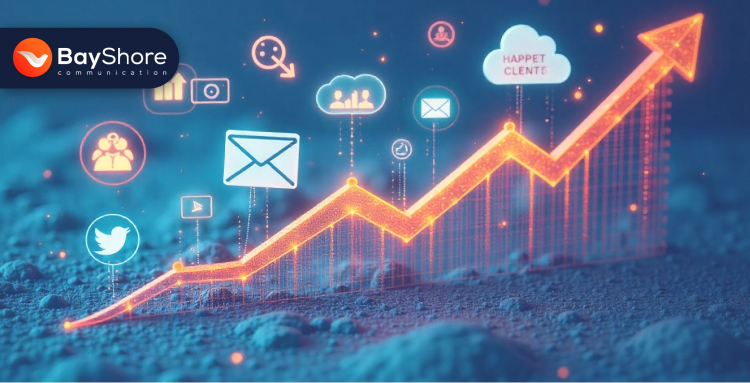
Every business has unique goals, and our services are designed to meet them head-on. Whether you need to improve your search rankings, generate leads, or build a stronger brand presence, we have the tools and expertise to make it happen. Here’s how we do it:
SEO & Content Marketing: Get Found by the Right People
Ranking on Google isn’t about stuffing keywords anymore—it’s about providing value. Our SEO and content marketing strategies focus on creating high-quality, relevant content that attracts the right audience and keeps them engaged. From on-page optimization to authoritative backlinks, we ensure your business appears in front of the people actively searching for your products or services.
PPC & Paid Advertising: Maximize ROI with Smart Targeting
Throwing money at ads without a strategy is a waste—we make sure every dollar counts. Our PPC (Pay-Per-Click) and paid advertising campaigns are backed by data and designed to drive conversions. Whether it’s through Google Ads, Facebook & Instagram Ads, or LinkedIn, we use smart targeting and constantly tweak campaigns to make sure you get the best return on your investment.
Social Media Management: Build a Brand That People Trust
Social media is more than just posting content; it’s about engagement and connection. We manage your social media presence across platforms like Facebook, Instagram, LinkedIn, and TikTok, ensuring your brand stays relevant and top-of-mind. We create compelling posts and respond to customer inquiries, helping you build a loyal community that drives long-term growth.
Web Design & Development: Turn Visitors into Customers
We design and develop modern, user-friendly websites that not only look great but also convert visitors into customers. Our sites load quickly, work perfectly on phones, tablets, and desktops, and are built with SEO in mind, so your audience gets a smooth experience no matter what device they're on.
Email & CRM Marketing: Keep Your Leads Engaged
Most businesses lose potential customers because they fail to follow up. Our email and CRM marketing services ensure you nurture leads and keep your audience engaged. Through personalized email campaigns, automation, and CRM integration, we turn cold leads into loyal customers, increasing retention and repeat sales.
Most businesses don’t fail because they lack great products or services. They fail because no one knows they exist. They wait, hoping customers will find them, while their competitors take action—investing in digital marketing that gets them seen, heard, and chosen.
If you’re tired of waiting, let’s change that. Book a free consultation today, and let’s talk about how we can help you dominate your industry. Your audience is out there. It’s time they find you.

March 8, 2025
If your business isn’t showing up on Google, you're losing potential customers. Florida’s market is competitive, and without the right SEO strategy, your website gets buried under competitors. The right SEO company doesn’t just boost rankings; it drives real business growth by attracting people who are ready to buy.
However, with so many SEO agencies making big promises, how do you know which one actually delivers? In this discussion, we’ll explain what makes an SEO service truly effective and guide you in choosing the right company to deliver the results you’re looking for.
The competition in Florida is fierce, and merely having a website is no longer sufficient. To truly excel, your business must appear in search results and captivate the right audience.
SEO helps your business get found online
Most consumers begin their journey by searching on Google for solutions to their problems or answers to their questions. Whether you're offering a service or a product, SEO ensures that your website appears on the first page of search results. The higher your ranking, the more likely potential customers will find you.
More website visitors mean more customers
It’s a simple formula: more visibility leads to more traffic, which leads to more conversions. SEO strategies increase the chances of your website being discovered by relevant audiences, driving organic traffic to your site without the hefty cost of ads.
Florida has tough competition—SEO gives you an edge
The Sunshine State has a booming economy, and with that comes stiff competition. Whether you’re in Miami, Orlando, or Tampa, standing out in the crowded marketplace is important. The right SEO approach gets your business noticed and helps you keep up with bigger competitors in your industry.

With so many SEO companies out there, it can be tough to know where to start. It’s important to do your research and find a reliable partner who can help your business grow at a reasonable cost.
Look for proven results and real success stories
The best SEO companies have a track record of success. Look for case studies or client testimonials that showcase their ability to drive results. If a company can’t provide concrete examples of how they’ve helped businesses similar to yours, it might be a red flag.
Make sure they offer clear reports and honest work
Transparency is essential in the world of SEO. You should expect clear communication regarding the strategies being implemented, the results achieved, and the metrics used to measure success. Avoid companies that promise overnight results—they likely don’t understand the long-term nature of SEO.
Pick a company that understands your business goals
SEO is not a generic solution. Every business has its own vision, mission, goals, and objectives, and these should guide the strategies put in place. Your vision reflects the long-term impact you wish to create, while your mission defines the core purpose and values driving your business.
Your goals are the measurable milestones you strive to reach, and your objectives are the specific actions required to get there. Working with an SEO company that understands your business ensures their strategies fit your needs and deliver better results.
Now that you understand the importance of SEO and how to choose the right company.
Here's why Bayshore Communication is the best option for your business.
Expert team with years of SEO experience
Bayshore Communication brings years of combined experience to the table. Our SEO experts are highly skilled in the industry, staying up to date with the latest trends and Google updates. This ensures that our clients maintain a competitive edge in the market.
Customized strategies for different businesses
Every business is unique, and Bayshore Communication recognizes that. We don’t offer cookie-cutter solutions. Instead, we create customized strategies that address your specific needs, goals, and target audience. Whether you're a small local business or a large enterprise, Bayshore customizes an SEO plan just for you.
Proven success in helping Florida businesses grow
Bayshore Communication has helped businesses all over Florida rank higher on search engines, resulting in increased traffic and business growth. Our impressive portfolio and client satisfaction speak for ourselves.

So, how exactly does Bayshore Communication help businesses improve their online visibility? The answer lies in a comprehensive, data-driven approach.
Researching the best keywords for your business
A core element of SEO is keyword research. Bayshore Communication identifies the search terms your potential customers are using, ensuring your website ranks for those highly relevant terms. The right keywords drive the right traffic to your site, increasing the chances of conversion.
Upgrading your website for better rankings
On-page optimization is a crucial aspect of SEO. Bayshore Communication focuses on optimizing your website’s structure, meta tags, headers, and content, ensuring that your site is search engine-friendly. This enhances your chances of ranking higher on search results.
Creating high-quality content that attracts customers
Content is the king, and Bayshore Communication excels at creating compelling, SEO-friendly content. We understand the importance of providing value to our customers through informative, engaging, and shareable content that boosts both your rankings and credibility.
Improving your website’s speed and user experience
Google prioritizes websites that provide a good user experience, including fast loading times. Bayshore Communication ensures that your website is optimized for speed and mobile responsiveness, improving your ranking and ensuring a positive experience for visitors.
Building links to boost your website’s authority
Link building is a critical component of SEO, as backlinks from reputable websites signal to Google that your site is trustworthy. Bayshore Communication has an established network of partners and strategies to acquire high-quality backlinks that improve your website’s authority and rankings.
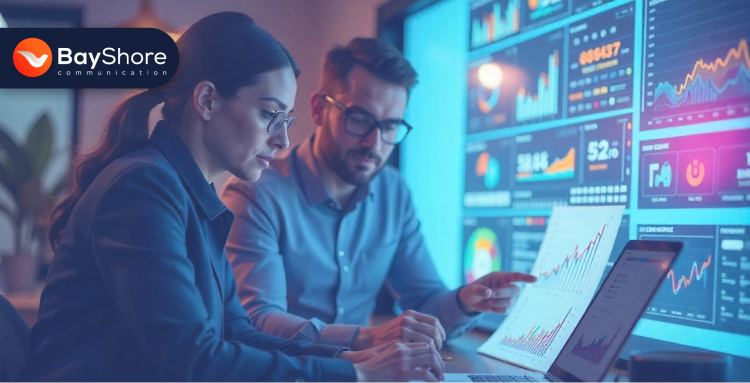
When comparing Bayshore Communication to other SEO companies in Florida, a few key factors set us apart:
Personalized strategies instead of cookie-cutter solutions
Unlike many other agencies that use generic approaches, Bayshore Communication customizes its strategies to address the unique needs of your business. We don’t just focus on rankings—we focus on results that matter to your business.
Clear pricing—no hidden fees or confusing contracts
Transparency in pricing is essential when working with an SEO company. Bayshore Communication offers clear, upfront pricing with no hidden fees or complicated contracts, ensuring you understand exactly what you’re paying for.
A focus on long-term success, not just quick fixes
SEO is a marathon, not a sprint. Bayshore Communication takes a sustainable, long-term approach to SEO, ensuring that the strategies they implement will continue to provide value over time. While some companies might promise quick fixes, Bayshore focuses on building a solid foundation for lasting success.
As we fine-tune your website’s SEO, we’re also keeping a close eye on the latest trends that could make a real difference for your business. According to a recent report from Forbes, the rise of GPT and AI-driven search is reshaping how people search online. Rather than sticking to short, specific queries, users are now asking longer, more conversational questions. To stay ahead of this shift, we focus on optimizing your content to align with these evolving search habits, ensuring that your website remains at the forefront of this new search era.
Getting started with Bayshore Communication is simple. Here's how you can begin boosting your business's visibility:
Contact us for a free consultation
Reach out to our team for a free, no-obligation consultation. We’ll assess your business’s current SEO status and discuss your goals to ensure we fully understand your needs before moving forward.
Get a customized SEO plan for your business
Once we know what you need, we’ll create a personalized SEO strategy designed to meet your specific goals and target audience. Our experts will guide you through each step of the process to achieve the best results.
Watch your business grow with more visitors
With our expert SEO services, you’ll start to see a noticeable improvement in your website’s rankings, traffic, and overall growth. We’re here to help your business succeed.
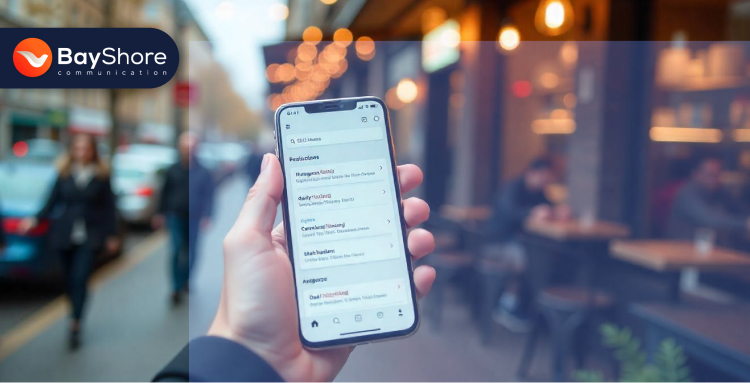
February 26, 2025
Did you know that nearly 78% of mobile searches for local information result in an offline purchase? It's almost as if the internet has become a virtual shopping mall where the real transactions happen in the streets, in the shops, and in the businesses around the corner.
Yet, so many local businesses remain invisible to the very people standing just blocks away. It's a curious thing, this modern paradox: while we're all more connected than ever, the local businesses that could thrive in this digital ecosystem often don’t know how to make their presence felt.
However, there’s a way to bridge this gap. SEO (search engine optimization) offers a map to guide your business through this crowded digital world to the doorstep of the customer next door. And while the idea may sound technical, it's rooted in something quite simple: making sure the right people find you when they need you most. Let’s explore how…
Your Google Business Profile is one of the most powerful tools to enhance your local visibility. Here’s how to make the most of it:
Claim and Verify
The first step is to claim and verify your business on Google. This step ensures that Google officially recognizes your business, giving you the ability to manage your profile and appear in local search results.
Complete Information
Make sure your profile includes accurate NAP (Name, Address, Phone) details, business hours, and your website URL. Incomplete or outdated information can confuse potential customers and hurt your rankings.
High-Quality Visuals
Upload professional photos and videos that showcase your business. Visuals can help build trust and make your business more appealing to potential customers. Show off your storefront, products, team, and behind-the-scenes moments.
Regular Updates
Post updates, offers, and event information regularly. This keeps your profile active and engaging. For example, you can post about seasonal promotions or community events to attract local customers.
Customer Reviews
Encourage happy customers to leave reviews on your profile. Reviews not only build trust but also play a significant role in improving your rankings. Be sure to respond to all reviews — positive or negative — to show that you care about customer feedback.
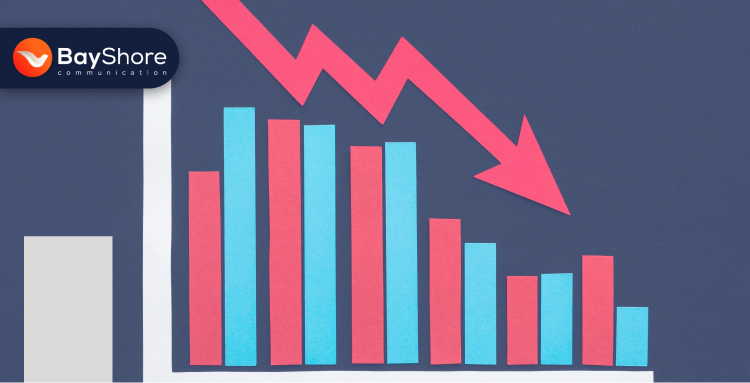
Consistency in your business information is crucial for local SEO. Search engines and potential customers need to find the same information across all platforms to trust your business.
Uniform Listings
Make sure your NAP details are consistent across your website, social media profiles, and online directories. Even small discrepancies, like a misspelled street name, can hurt your rankings.
Audit Tools
Use tools like Moz Local, BrightLocal, or Yext to audit your listings and identify inconsistencies. Correct any errors you find to maintain uniformity.
Keyword research is the backbone of any successful SEO strategy. For local businesses, it’s essential to focus on terms that your local audience is using to search for products and services.
Identify Local Search Terms
Use tools like Google Keyword Planner, Ahrefs, or SEMrush to discover keywords relevant to your business and location. For instance, if you run a bakery in Tampa, “best bakery in Tampa” or “fresh bread near me” are valuable keywords.
Long-Tail Keywords
Focus on longer, more specific phrases that indicate a strong purchase intent. For example, instead of “pizza,” target “gluten-free pizza delivery in Miami.” These keywords are less competitive and more likely to convert.
Competitor Analysis
Study your local competitors to see which keywords they are targeting. This can give you insights into what works and help you refine your strategy.
Your website needs to be optimized for local search to appear in relevant search results.
On-Page SEO
Incorporate local keywords into your website’s titles, meta descriptions, headers, and content. For example, instead of a generic title like “Our Services,” use something more specific like “Landscaping Services in Orlando.”
Localized Landing Pages
Create landing pages that target specific locations or services. If you serve multiple areas, having separate pages for each location can help you rank better for local searches.
Schema Markup
Implement local business schema on your website to help search engines understand your business information. This can improve your chances of appearing in rich search results.

Creating content that resonates with your local audience can boost your visibility and engagement.
Blog Posts
Write about local events, news, and topics relevant to your community. For instance, if you own a fitness center, you could write about upcoming charity runs or health tips for residents.
Resource Guides
Develop helpful guides that cater to local interests. A restaurant could create a “Best Places to Eat in [City]” guide or a real estate agent could offer a “Moving to [City] Checklist.”
Customer Spotlights
Feature stories of your local customers. This not only builds community connections but also encourages more engagement and word-of-mouth marketing.
Local citations and backlinks signal to search engines that your business is trustworthy and relevant to the community.
Local Directories
List your business in reputable local directories and industry-specific sites. Ensure your information is accurate and up to date.
Community Engagement
Collaborate with local bloggers, sponsor community events, or participate in local activities. These efforts can earn you valuable backlinks and increase your visibility.
Press Releases
Share newsworthy content with local media outlets.This can help you gain media coverage and backlinks.
Reviews play an important role in local SEO and customer decision-making.
Review Acquisition
Encourage satisfied customers to leave positive reviews on platforms like Google, Yelp, and Facebook. Make it easy for them by providing direct links.
Review Monitoring
Regularly check your reviews and respond promptly. Thank customers for positive feedback and address any negative feedback professionally.
Address Negative Feedback
Handle criticisms constructively. Apologize if necessary, and offer solutions to resolve the issue. This shows potential customers that you value feedback and are committed to customer satisfaction.
With the rise of mobile and voice searches, optimizing for these channels is essential. According to a recent report of Forbes, search engines favor websites that offer a seamless mobile experience, which helps improve your SEO and user satisfaction.
Responsive Design
Ensure your website is mobile-friendly with a responsive design that adjusts to different screen sizes. Fast loading times are also critical.
Voice Search Optimization
Adapt your content to natural language queries. Include FAQ sections to address common questions that voice search users might ask.

Social media can be a powerful tool for connecting with your local audience.
Platform Selection
Focus on social media platforms that are popular in your area. For example, if your community is active on Instagram, prioritize that platform.
Localized Content
Share content relevant to your local audience. This could include posts about local events, promotions, or community stories.
Community Interaction
Engage with your followers by responding to comments, messages, and participating in local discussions. Collaborate with local influencers or businesses to reach a broader audience.
Regular monitoring and analysis are key to improving your local SEO strategy.
Analytics Tools
Use tools like Google Analytics, Google Search Console, and local SEO platforms to track your performance.
Key Metrics
Focus on metrics like local search rankings, website traffic, and conversion rates. These insights can help you identify what’s working and what needs improvement.
Continuous Improvement
Based on your data insights, regularly update and refine your local SEO strategies. SEO is an ongoing process, and staying proactive will keep your business competitive.
Want to expand your understanding? Have a look at these related articles:
When do you need to stop investing money in digital marketing
Why is a marketing agency better than your internal marketing team
Getting Found: The Importance of Regular Google Maps Listing Updates
We specialize in boosting local businesses’ online visibility with customized SEO strategies that deliver real, measurable results.
Optimize Your Google Business Profile
We claim, verify, and optimize your Google Business Profile (GBP) to ensure accurate business information, upload professional photos, and post regular updates. Our efforts ensure that your business appears in Google’s Local Pack and Google Maps, driving more local traffic and enhancing your online presence.
Conduct Thorough Local Keyword Research
We identify and target the right local search terms by researching keywords specific to your area and industry. Through competitor analysis, we uncover high-value keywords that attract high-intent customers, ensuring your business ranks for terms that matter most.
Create Localized Content
We develop content that resonates with your community—be it through local event coverage, service-specific blog posts, or guides tailored to local interests. Localized content builds authority and trust, helping your business connect with the community and rank better in search results.
Build Citations and Backlinks
We ensure your business is listed in local directories and industry-specific sites. Through local partnerships and press releases, we secure quality backlinks, boosting your website’s authority and improving your search rankings.
Monitor and Refine SEO Performance
Our team continuously tracks your SEO performance using tools like Google Analytics and Search Console. By regularly reviewing key metrics, we make necessary adjustments to optimize your strategy and ensure sustained growth in local search rankings.
Full-Service Support
Beyond SEO, we offer comprehensive support in areas like social media engagement, review management, and customer outreach. This integrated approach ensures a cohesive online presence that attracts and retains local customers.
Let us help you elevate your local presence and attract more customers. Contact Bayshore Communication today and discover how our SEO expertise can help your business succeed.

February 22, 2025
Creating a strong online presence today is a bit like bridging the global prosperity gap. In the early 1990s, the World Bank reported that regions like East Asia faced significant challenges in reducing poverty. But fast forward to 2024, and they've made remarkable progress, cutting their prosperity gap from 16.5% to just 2.8%. The lesson? Big changes are possible, even with limited resources.
In the same way, businesses with smaller budgets can still make a big impact online. You don’t need a massive marketing fund to get noticed. By using smart, cost-effective strategies, you can build your brand, connect with customers, and grow your presence without feeling overwhelmed by expenses.
The question is, how do you do it? Let's explore some practical steps to help you maximize your online reach without breaking the bank.
The great news is that affordable platforms exist that can help you design a sleek and functional site without draining your resources.
Affordable Website Builders
There are several website builders that offer budget-friendly solutions perfect for those who aren’t tech-savvy or don’t have a large marketing budget. WordPress, Wix, and Squarespace are some of the most popular platforms that offer easy-to-use templates and intuitive drag-and-drop editors. These platforms allow you to create a visually appealing website without needing to hire a developer. For instance, WordPress has a variety of free themes, and Wix and Squarespace both offer free or low-cost plans.
Essential Features
While you’re keeping costs low, ensure that your website incorporates a few essential features that will help establish credibility and improve user experience. This includes intuitive navigation, mobile responsiveness for smartphone users, and clear calls to action that drive visitor engagement. For budget-conscious clients, prioritizing these features builds trust and encourages action, whether scheduling a consultation, reaching out, or exploring services.
SEO Basics
One of the most cost-effective ways to boost your visibility is through Search Engine Optimization (SEO). SEO is the process of optimizing your website content to rank higher in search engine results, making it easier for people to find your services. Optimizing title tags, meta descriptions, and local SEO with relevant keywords boosts your website's chances of ranking high on SERPs. For law firms and other local businesses, this can significantly increase web traffic without needing a paid marketing campaign.
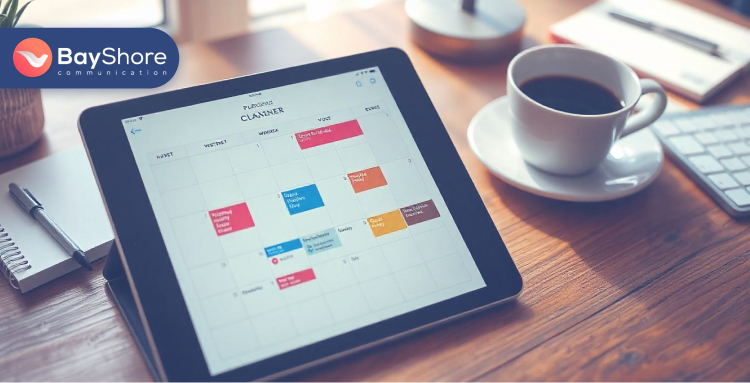
Social media is an invaluable tool for creating an online presence, and it doesn’t have to come with a hefty price tag. In fact, most social media platforms are free to use, making them perfect for businesses with a limited marketing budget.
Platform Selection
The key to success on social media is selecting the right platforms. You don't need to be everywhere—focus on platforms that cater to your target audience. For instance, if you’re running a law firm or providing professional services, LinkedIn is ideal for reaching business professionals. Facebook and Instagram, on the other hand, can help you connect with local clients who may need legal services. Research where your audience spends their time and tailor your strategy accordingly.
Consistent Posting
With a minimal budget, the goal is to maximize your organic reach. Consistency is important for keeping your audience engaged. A regular posting schedule doesn’t require paid ads—just a time commitment to creating valuable content that speaks to your target audience’s needs. Use tools like Buffer or Hootsuite to schedule posts in advance, saving time and ensuring consistency.
Engagement Strategies
Engagement on social media is a two-way street. Responding to comments, participating in relevant discussions, and sharing valuable insights will help build relationships and establish authority in your industry. For a tighter budget, this approach is more effective than paid ads, fostering organic engagement and trust with your audience.
Content marketing is one of the most effective ways to build a strong online presence, especially if you’re operating on a limited budget.
High-Quality Content Creation
Quality over quantity is the power of content marketing on a budget. When resources are scarce, it’s better to focus on creating high-value content that addresses your audience’s needs. In the legal industry, sharing insights on common questions or offering tips for resolving issues can establish you as an expert. Even one well-crafted blog post per month can significantly improve your visibility.
Blogging
Starting a blog is an excellent, low-cost way to share your expertise and improve search engine rankings. A blog lets you explore topics that engage your audience, offering valuable insights while boosting your website's visibility on search engines. Regular blog posts also give you fresh content to share on social media platforms, driving traffic back to your website.
Repurposing Content
Repurposing content is a clever way to maximize your efforts. You don’t always have to create new content from scratch. You can turn a blog post into a video or infographic or share the key points as a social media post. This allows you to reach a broader audience without investing in the creation of entirely new materials. It’s a great way to stretch your content marketing budget.

There are several free and affordable tools available. These can help streamline your marketing efforts, making them accessible even for businesses on a tight budget.
Email Marketing
Email marketing is a powerful tool that can build and nurture relationships with potential clients. Platforms like Mailchimp and Brevo offer free tiers that allow you to manage email campaigns with ease. These platforms provide templates, automated workflows, and analytics to help you connect with your audience without the need for a big budget.
Graphic Design Tools
Creating visually appealing graphics doesn’t need a professional designer if you use free tools like Canva. This easy-to-use platform allows you to design social media posts, blog headers, flyers, and more. It’s ideal for law firms and small businesses that need high-quality visuals on a shoestring budget.
Analytics Tools
To ensure your efforts are paying off, it’s important to track performance. Google Analytics is a free tool that provides valuable insights into how visitors are interacting with your website. Similarly, most social media platforms have built-in analytics tools to track engagement, follower growth, and post performance.
Online communities such as forums, Facebook groups, and Reddit can be great resources for connecting with potential clients and expanding your network.
Forums and Groups
Participating in industry-related forums or groups is an excellent way to build relationships and establish yourself as an authority. Joining legal-focused Facebook groups or Reddit communities lets you share your expertise and solve common issues without relying on paid ads.
Providing Value
In online communities, it’s important to focus on providing value rather than overtly promoting your services. By answering questions, offering useful insights, and being genuinely helpful, you’ll build trust and credibility with potential clients. Over time, this approach can drive organic leads without any investment in paid marketing.

Partnerships and collaborations allow you to tap into new audiences and gain exposure in places where you might not be able to reach otherwise.
Partnerships
Collaborating with complementary businesses or influencers is a great way to share resources and gain exposure. For example, a law firm could partner with a local business to offer joint services or cross-promotions. This collaboration benefits both parties by expanding their respective audiences and increasing visibility.
Guest Posting
Writing guest posts for reputable blogs or websites in your industry is another low-cost way to increase your reach. Guest posts provide you with backlinks to your website, which improves your SEO ranking, as well as giving you access to a wider audience.
For businesses that rely on local clientele, such as law firms, local search optimization is essential. Fortunately, there are several free and affordable ways to improve your local visibility.
Google My Business
Setting up and optimizing a Google My Business profile is one of the most effective ways to improve your visibility in local search results. It’s a free tool that lets businesses manage how they appear on Google Search and Maps, which is vital for attracting local clients.
Local Directories
Listing your business in local online directories is another low-cost strategy to improve local SEO. Various websites and local Chamber of Commerce sites can help you build credibility and drive traffic to your website.
The digital landscape is constantly evolving, so it’s important to regularly review your strategies and make adjustments based on what works best for your audience.
Performance Tracking
Using analytics tools, track key metrics such as website traffic, social media engagement, and email open rates. Regular monitoring helps you identify what’s working and what isn’t, allowing you to refine your strategies to make them more effective.
Flexibility
Be flexible and open to changing your approach as needed. Trends in digital marketing can shift, and consumer preferences may evolve. By staying adaptable, you can continue to grow your online presence even on a minimal budget.
Building an online presence doesn’t have to be limited to promoting existing services. You can also explore profitable home-based business ideas that leverage your skills and resources.
Forbes recently highlighted that ventures like freelance writing, virtual assistance, online tutoring, and digital marketing consulting require minimal upfront investment. These opportunities can seamlessly complement your primary business or even thrive as independent income streams, offering both flexibility and financial growth potential.
We hold fast to a belief that lies at the core of everything we do: quality digital marketing should never be a privilege reserved for companies with deep pockets. It’s not about the size of your budget; it’s about the size of your ambition. We understand the struggles of small businesses, the startups with dreams bigger than their bank accounts, and the seasoned companies striving to adapt to a digital world that moves at the speed of light.
Every campaign we design, every piece of content we create, every SEO tweak we make is done with one goal in mind: to amplify your voice in a way that resonates. And we know how to do it without making your accountant wince.
But it’s not just about tactics and strategies—it’s about belief. The belief that every business has a story worth telling. The belief that no dream is too small to deserve a chance. And the belief that, with the right guidance, even the smallest pebble can create ripples in the largest pond. Come, let’s build something extraordinary together. Let’s make your voice the one they can’t ignore.
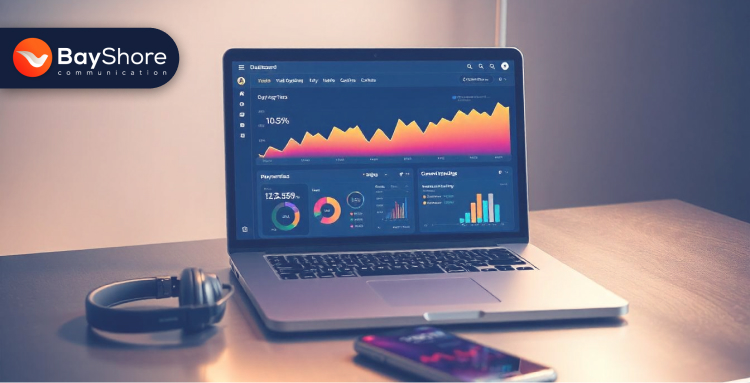
February 18, 2025
Have you ever wondered how to take your business to the next level in the digital age? With so many digital marketing agencies out there, how do you choose the right one?
According to the World Bank, businesses that enhance their digital presence often experience significant growth, particularly in expanding exports. Their findings reveal that many businesses initially struggled with using digital tools but saw substantial improvements once they received the right guidance. Success comes from expert advice for specific sectors and markets, helping businesses target the right customers and make necessary adjustments.
Choosing the right digital marketing agency isn’t just about boosting your visibility; it’s about ensuring you have the knowledge and support needed to succeed in the global marketplace. Let’s explore how to make the right choice and unlock your business’s full potential.
Before diving into the world of digital marketing agencies, it's essential to clearly define your business goals. Here are a few steps to consider as you assess your needs:
Identify Specific Marketing Objectives
Every business has different goals when it comes to digital marketing. Some may focus on increasing brand awareness, while others prioritize lead generation or sales growth. Pinpointing your objectives allows you to seek an agency with expertise in those areas. Whether you want to boost your online visibility, nurture customer relationships, or drive conversions, your marketing objectives will guide your search.
Determine the Scope of Services Required
Digital marketing spans a wide range of services, including SEO, pay-per-click (PPC) advertising, social media management, content creation, and email marketing. According to Forbes, the first step in choosing the right agency is understanding your specific needs and budget.
Clearly outlining your needs for services like website development, SEO, advertising, social media, or graphic design makes conversations with prospective agencies more effective. Consider which services are essential for your business and where external expertise might be needed. Are you looking for a full-service agency that can manage all aspects of your digital marketing, or do you need specialized support in specific areas?
Evaluate Internal Capabilities vs. External Expertise
It’s important to evaluate your internal marketing team’s strengths and weaknesses. Do you already have skilled professionals in-house who can manage certain aspects of digital marketing, or will you need to rely entirely on an agency? Understanding your internal capabilities helps you determine how much external expertise you’ll require to achieve your goals.

Now that you have a clear understanding of your needs, it’s time to start researching potential agencies. The digital marketing space is crowded with options, so it’s important to narrow down your choices to those that align best with your requirements.
Compile a List of Agencies with Experience in Your Industry
Not all digital marketing agencies are created equal. While many agencies are generalists, others have specialized expertise in specific industries. Look for agencies that have a proven track record working with businesses in your industry or similar sectors. Industry experience can provide them with valuable insights into your target audience, competitors, and marketing challenges.
Review Portfolios and Case Studies
A reputable agency will showcase their previous work through case studies and portfolios. Take the time to review their past campaigns to see if they align with your marketing objectives. Look for measurable success—such as increased website traffic, improved conversion rates, or greater social media engagement. This will give you a sense of what the agency is capable of and whether they can deliver on their promises.
Check for Industry Recognition or Awards
Awards and recognition from industry organizations can serve as an important indicator of an agency’s credibility and expertise. Check for certifications, partnerships, or accolades that demonstrate industry peers or authoritative bodies recognize the agency’s expertise. These recognitions are often a sign that the agency is committed to delivering high-quality results.
Not all agencies offer the same level of proficiency or service quality, so it’s important to determine whether their capabilities align with your business needs.
Research the Range of Services Offered and Their Alignment with Your Needs
Different agencies specialize in different areas of digital marketing. Some may excel in SEO, while others are experts in social media strategy. It’s crucial to ensure that the agency offers the specific services you need to achieve your goals. If you require a full-service agency, look for one that offers a comprehensive suite of digital marketing services and can create an integrated strategy.
Inquire About Proficiency with Current Digital Tools and Technologies
A good agency will stay up-to-date with the latest trends and innovations. Ask about the tools and technologies they use to manage campaigns, track performance, and optimize strategies. This can include analytics platforms, automation software, and content management systems. Their ability to leverage the right tools can greatly impact the success of your campaigns.
Understand Their Approach to Staying Updated with Industry Trends
Inquire about how they stay updated—whether through ongoing training, attending conferences, or following industry thought leaders. An agency that invests in continuous learning is more likely to deliver innovative solutions and keep your marketing strategies fresh.

Client testimonials and references can help you gauge whether an agency will be a good partner for your business.
Read Client Reviews and Testimonials for Insights into Client Satisfaction
A reputable agency should have client testimonials available on their website or third-party review platforms. Take the time to read these reviews, paying attention to how the agency’s work has impacted clients. Look for feedback on key aspects such as communication, results, and overall satisfaction. While no agency will have a perfect track record, consistent positive feedback is a good indicator of quality.
Request References to Discuss Experiences with Past Clients Directly
If you’re still unsure about an agency’s capabilities, don’t hesitate to ask for references. Speaking directly with past clients allows you to get an honest assessment of the agency’s strengths and weaknesses. Ask about their experience working with the agency, the results they achieved, and how the agency handled challenges along the way.
Investigate Reasons for Client Retention or Termination
Understanding why clients stay with or leave an agency can provide valuable insight into their performance. Inquire about the agency’s client retention rate and ask if they’ve ever lost a client. If they have, find out the reasons behind it. This can help you assess the agency’s reliability and ability to deliver on long-term goals.
One of the key advantages of digital marketing is the ability to track performance through data and analytics. Let’s discuss them in details…
Discuss the Metrics and KPIs Used to Measure Campaign Success
A great agency should be able to provide clear metrics and key performance indicators (KPIs) to measure the success of your campaigns. These might include website traffic, conversion rates, return on investment (ROI), customer acquisition costs, and more. Ask how they define success and how they plan to measure and report on it.
Ensure They Provide Transparent and Regular Reporting Practices
You need to know how your campaigns are performing and what adjustments are being made to improve results. Ask the agency about their reporting practices—how often will you receive updates, and what information will be included in those reports? Regular, clear reports help ensure that both parties are aligned on expectations and goals.
Evaluate Their Ability to Adapt Strategies Based on Data-Driven Insights
A truly effective digital marketing agency will continuously analyze campaign data and adjust strategies as needed. Ask about their approach to optimization—how do they use data to refine campaigns and improve performance over time? The agency should demonstrate a commitment to ongoing improvement based on measurable results.
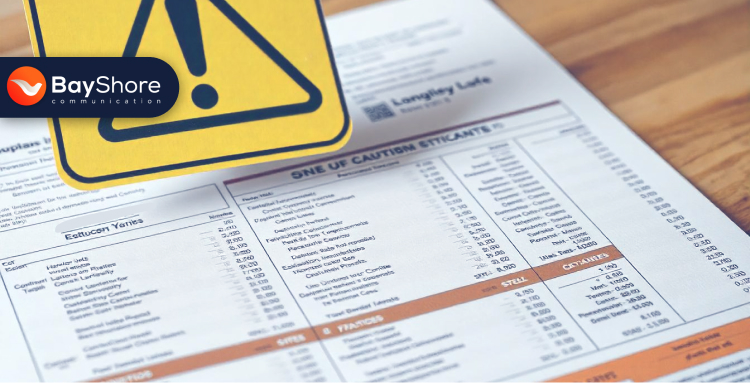
Pricing and contract terms are important factors to consider when selecting a digital marketing agency. It’s essential to ensure that you’re getting value for your investment and that the terms are clear and fair.
Obtain Detailed Proposals Outlining Services, Deliverables, and Costs
Once you’ve narrowed down your list of agencies, ask for detailed proposals. These should outline the services being offered, the expected deliverables, timelines, and costs. A well-structured proposal helps you understand exactly what you’re paying for and ensures that there are no surprises down the line.
Clarify Contract Terms, Including Duration, Termination Clauses, and Flexibility
It’s important to understand the terms of the contract before committing. Ask about the contract duration, any termination clauses, and whether there’s flexibility if your business needs change. Be sure to review the fine print to ensure there are no hidden fees or long-term commitments that could be problematic.
Be Cautious of Agencies Offering Unrealistically Low Prices
While it can be tempting to go with an agency that offers rock-bottom prices, beware. Unrealistically low prices may indicate a lack of experience, resources, or quality. Digital marketing is an investment, and while it’s important to stay within budget, cutting corners on quality can lead to disappointing results.
In today’s world, where algorithms change and trends shift, having a partner who’s not only adaptable but deeply invested in your success is priceless. Bayshore Communication is that partner for you. With our expertise in SEO, content marketing, social media strategies, and more, we ensure your message reaches the right people, at the right time, in the right way.
We don’t simply follow a set of strategies; we seek to understand the essence of what makes your business unique. We listen to the story you’re telling, to the values that drive you, and to the goals you’re striving for. From there, we build a plan—one that merges the art of creativity with the clarity of data. With us, your brand won’t just grow; it will find its true place, gaining the recognition and success that’s earned, not given.
The path to success is not always clear, but with the right guide, it becomes a journey of discovery and achievement. Trust Bayshore Communication to be the agency that helps your business grow with purpose, passion, and precision.

February 5, 2025
Imagine a world where businesses, regardless of size or location, can tap into a global pool of talent with just a few clicks. That’s exactly what the rise of online marketing and digital platforms has achieved, creating a dynamic marketplace that continues to evolve. According to the World Bank, online platforms like oDesk and Elance (now called Upwork) helped smaller employers find skilled workers globally. In 2012 alone, these platforms posted 2.5 million jobs for tasks like writing, customer service, and software development.
So, what’s next? The world of online marketing keeps growing, and exciting new ideas are shaping its future. From smarter tools that use artificial intelligence to more personal ways of connecting with customers, there’s a lot to look forward to. Let’s explore the trends and innovations that are set to define the future of online marketing.
The power of AI and ML lies in their ability to transform how businesses connect with their audience.
AI-Driven Personalization
AI has transformed online marketing by enabling hyper-personalized user experiences. Sophisticated algorithms analyze consumer behavior, preferences, and purchase history to deliver tailored recommendations and content. For example, platforms like Netflix and Amazon excel at suggesting relevant products or shows based on individual user data. This level of customization strengthens customer relationships and drives conversions.
Predictive Analytics
Machine learning enhances personalization by predicting future consumer behavior. It analyzes historical data to anticipate trends, recommend optimal strategies, and refine campaigns in real-time. Businesses using predictive analytics can proactively address customer needs, leading to improved satisfaction and loyalty.

With the rise of voice-activated devices, businesses must rethink their approach to engaging audiences.
Voice Search Optimization
As smart speakers and voice-activated devices gain popularity, optimizing for voice search has become a priority. Unlike traditional searches, voice queries are often longer and conversational. Marketers must focus on natural language processing and local SEO to capture this growing audience. For example, a coffee shop might optimize for queries like, “Where’s the best coffee shop near me?”
Conversational Interfaces
Chatbots and AI-driven communication tools are revolutionizing customer engagement. These tools provide real-time assistance, answer queries, and even guide users through the sales funnel. Conversational marketing creates a better, interactive experience, ensuring customers feel valued and supported.
Video content continues to captivate audiences, offering unparalleled opportunities for engagement.
Short-Form Videos
Platforms like TikTok, Instagram Reels, and YouTube Shorts have redefined video marketing. These short, engaging clips capture attention quickly, making them ideal for today’s fast-paced digital audience. Brands that master this format can create memorable, shareable content that resonates with viewers.
Live Streaming and Interactive Content
Live streaming offers a unique opportunity to connect with audiences in real time. Whether it’s a product launch, Q&A session, or behind-the-scenes glimpse, live content fosters authenticity and trust. Adding interactive elements, such as polls or live chats, enhances engagement and builds a sense of community.
Immersive technology is revolutionizing how customers explore and experience brands.
Immersive Brand Experiences
AR and VR technologies are reshaping how consumers interact with brands. From virtual try-ons for clothing and makeup to 360-degree product tours, these innovations provide immersive experiences that help customers make informed decisions.
Enhanced Customer Engagement
Immersive technologies create memorable interactions, boosting engagement and loyalty. For example, IKEA’s AR app allows users to visualize furniture in their homes, bridging the gap between online and in-store shopping.

Social media is becoming a direct sales channel, reshaping the shopping experience.
Integrated Shopping Experiences
Social media platforms are increasingly becoming direct sales channels. Features like Instagram’s “Shop” tab or Pinterest’s “Buyable Pins” allow users to browse and purchase products without leaving the app. This seamless integration simplifies the buyer’s journey.
Shoppable Content
Creating visually appealing, clickable posts and stories that lead directly to purchase pages can significantly enhance conversions. Brands that excel in this space combine creativity with convenience, encouraging impulse buys and fostering repeat business.
The influencer landscape is evolving, focusing on authenticity and niche appeal.
Micro and Nano-Influencers
While celebrity endorsements remain popular, micro and nano-influencers—those with smaller, highly engaged audiences—are gaining traction. These influencers bring authenticity and relatability, making them ideal for niche marketing campaigns.
Authenticity and Transparency
Consumers value honesty and trust in influencer partnerships. Brands that prioritize genuine collaborations and disclose sponsorships effectively build credibility and long-term customer relationships.
Brands are aligning their practices with growing consumer demand for responsibility and transparency.
Eco-Friendly Initiatives
Sustainability is no longer a trend but a necessity. Brands adopting eco-friendly practices—such as reducing packaging waste or supporting renewable energy—appeal to environmentally conscious consumers.
Corporate Social Responsibility (CSR)
Highlighting ethical business practices, from fair trade sourcing to community support initiatives, strengthens brand reputation. Consumers are increasingly aligning their purchasing decisions with their values, making CSR a vital component of modern marketing.
In an age of increasing digital regulation, trust is built through robust privacy practices.
Compliance with Regulations
With stringent data protection laws like GDPR and CCPA, businesses must prioritize compliance. Transparent data collection and usage policies not only avoid legal issues but also build consumer trust.
Building Consumer Trust
Communicating how customer data is protected and used responsibly fosters confidence. Offering secure transactions and respecting user privacy are non-negotiable in today’s digital landscape.
Consumers now expect seamless experiences across multiple platforms.
Seamless Customer Journeys
Consumers expect consistent experiences across all touchpoints, whether online, in-store, or through mobile apps. Omnichannel strategies ensure a unified brand presence, enhancing customer satisfaction and loyalty.
Integrated Campaigns
Coordinating marketing efforts across platforms—such as email, social media, and search ads—maximizes reach and impact. Businesses that master integration can effectively guide customers through the purchasing journey.

Content that engages audiences dynamically stands out in today’s competitive landscape.
Interactive and Dynamic Content
Engaging formats like quizzes, polls, and infographics captivate audiences and encourage participation. Interactive content also increases time spent on-site, boosting SEO performance.
Personalized Content Delivery
AI tools enable dynamic content personalization, ensuring users receive relevant information at the right time. This approach improves engagement and drives conversions.
Transparency and security are redefining trust in digital marketing.
Enhanced Transparency
Blockchain ensures secure and transparent transactions, combating ad fraud and enhancing accountability. By verifying ad impressions and clicks, blockchain builds trust in digital advertising.
Combatting Ad Fraud
Through decentralized verification processes, blockchain technology ensures authenticity, reducing fraudulent activities and maximizing ROI.
Search behavior is shifting, with users relying on immediate answers.
Optimizing for SERP Features
To capture attention in zero-click searches, content must be structured for featured snippets. Answering common questions directly within search results increases visibility and drives traffic.
Adapting to Search Behavior
Understanding user intent and crafting concise, valuable content ensures relevance in an evolving search landscape.
Automation is reshaping how content is produced and managed.
Content Creation Tools
AI-driven platforms streamline content creation, generating high-quality articles, social posts, and ad copy. This automation saves time and resources while maintaining quality.
Automated Ad Campaigns
AI optimizes ad targeting, budgeting, and performance analysis, enabling marketers to achieve better results with minimal manual effort.
Email remains a powerful tool when paired with modern interactive technologies.
AMP for Email
AMP for Email allows users to interact directly within emails, enhancing engagement through actions like RSVPing to events or completing surveys. RSVPing means responding to event invitations to confirm attendance.
Personalized Email Journeys
Tailored email sequences based on user behavior and preferences increase open rates and conversions, making email marketing more effective than ever.
User experience defines how audiences perceive and interact with brands.
Website Performance Optimization
Fast-loading, visually stable websites enhance user satisfaction and improve search rankings. Prioritizing Core Web Vitals is essential for a competitive online presence.
Mobile-First Design
With mobile devices dominating web traffic, responsive design ensures a seamless experience across all screen sizes, catering to today’s on-the-go consumers.
We embrace the unexpected, bringing innovation to life with technologies like augmented and virtual reality, giving your customers new ways to engage with your brand. Social commerce redefines the shopping journey, making it smoother, simpler, and more intuitive. Through advanced analytics, we distill complexity into clarity, ensuring your campaigns are powered by insights that drive real impact.
We also believe in doing things right—ethically. We focus on building trust, respecting privacy regulations, and ensuring your brand remains a beacon of credibility in a world that often feels uncertain. Our approach is about creating meaningful, lasting connections that resonate with modern consumers. Contact us today, and let’s build strategies that not only elevate your brand, but bring it to life in ways that matter.

January 26, 2025
Have a look around you. The world isn’t what it was yesterday, and tomorrow will only bring more change. Innovation moves faster than we do, leaving us wondering: are we truly keeping pace? Are we wringing out every drop of potential from this strange, fleeting moment we call progress?
The ways we’ve worked, the ways we’ve lived—aren’t they starting to feel like cages? Geographies divide us. The clock rules us. Hierarchies weigh us down like stones. We cling to these structures as if they’ll save us, but maybe they’re the very things holding us back.
What if we could shatter these walls? Imagine a world where talent isn’t bound by borders, where the sun never sets on possibility. A way of working that doesn’t chain us to the same tired rhythms but sets us free to create, to build, to be more. This is what offshore support solutions offer: not just a way out, but a way forward.
Offshore support solutions are all about outsourcing specific business tasks to external providers in different countries. These tasks often include customer service, IT support, finance, human resources, and marketing. The goal is simple: get quality work done at a lower cost.
Countries like Bangladesh, India, Philippines, and Poland are leaders in providing offshore support. India, for instance, dominates the IT outsourcing market, projected to grow from $13.52 billion in 2024 to $20.81 billion by 2029. The Philippines stands out for its large pool of English-speaking professionals, producing over 470,000 graduates annually. Bangladesh (The Economist's No. 1 ranked country in 2024), with its young and skilled workforce, has also become an attractive destination for offshore services. Meanwhile, Poland has emerged as a strong contender in Europe, particularly in IT and finance outsourcing.

Offshore support solutions are a game-changer for businesses looking to grow without spending a fortune. Here’s why:
Cost Reduction
Hiring locally can get expensive, especially when it comes to salaries and benefits. Offshore support lets you save big—sometimes up to 70%—on operational costs. Countries like Bangladesh, India and the Philippines offer skilled workers at a fraction of the cost of hiring locally, without sacrificing quality.
Access to a Global Talent Pool
When you go offshore, you open the door to a wide range of skills and expertise. Bangladesh and India has many skilled IT professionals because of their strong focus on STEM education. The Philippines, on the other hand, is known for its top-notch customer service. You can tap into this global talent pool to find the right people for the job.
Round-the-Clock Operations
Time zones can actually work in your favor. With teams in different parts of the world, you can offer 24/7 customer support. This not only keeps your customers happy but also builds loyalty, as they’ll appreciate the availability and quick responses no matter the hour.
Flexibility and Scalability
Offshore support is incredibly flexible. You may need to scale up your team quickly to meet growing demands or scale down when things slow down. Offshore teams give you the ability to adjust without the delays or costs of hiring and firing locally. This makes it much easier to adapt to changing business needs.
Focus on Core Business Areas
When you outsource tasks like admin work or customer support, it frees up your team. This allows them to focus on what really matters—driving growth and innovation. And lets your business focus on what it does best, while the offshore team handles the rest.
While offshore support offers significant benefits, it’s not without its challenges. Being aware of these issues can help you manage them effectively.
Language and Cultural Differences
When teams are from different countries, misunderstandings can happen because of language or cultural differences. This can lead to frustration for both employees and customers, making it harder to get things done smoothly. To avoid this, it's important to focus on clear communication and understanding each other's cultures.
Time Zone Misalignments
Working with offshore teams in different time zones can be both a blessing and a challenge. While it can mean work is happening around the clock, it can also make it tough to coordinate meetings or quickly solve urgent problems. Being flexible with schedules and planning ahead can help keep things on track.
Quality Assurance Concerns
Making sure the quality of work stays the same across different locations can be difficult. Without clear instructions and regular check-ins, the level of service might vary. Setting clear expectations and keeping an eye on things can help make sure the quality remains consistent.

Overcoming these challenges isn’t impossible. With the right approach, you can ensure smooth collaboration and get the most out of your offshore support team.
Thorough Research
Don’t jump into choosing an offshore partner without doing some research first. Check out reviews, ask for client references, and see if they have experience in your industry. Picking a partner with a good track record and experience in what you do can save you time and trouble down the road.
Technology and Communication Tools
Staying in touch with your offshore team is easier than ever with tools like Slack, Zoom, and Trello. Slack lets you send quick messages. Zoom helps with video meetings no matter where you are. And Trello helps you keep track of tasks and deadlines. These tools make it easy to stay connected and keep everything running smoothly, even with different time zones.
Regular Performance Reviews
Set clear goals from the start and check in on your offshore team’s progress every so often. By reviewing their performance regularly, you can make sure they’re on track and meeting your expectations. If something’s not working, having these regular check-ins helps you catch it early and make adjustments so everything stays on track.

We help businesses grow efficiently without blowing the budget. Here's what we can do for you:
Save on Costs, Keep Quality High
We connect you with offshore teams worldwide, offering a cost-effective way to get high-quality work done. Whether you need customer service, IT support, or administrative help, you’ll get skilled professionals without the heavy local hiring costs.
Access a Global Talent Pool
No matter the expertise you need, we can connect you to a diverse range of professionals across the globe. Our offshore solutions give you access to the right skills for your business, without the hassle of finding local talent.
24/7 Business Operations
We help set up offshore teams in different time zones, allowing your business to operate around the clock. This boosts efficiency, ensures quicker response times, and improves customer satisfaction—all while keeping your costs low.
Scalable and Flexible Solutions
As your business grows, we help you easily scale your offshore team up or down to match your needs. You can adapt to new opportunities or challenges quickly without the delays and costs associated with hiring locally.
Focus on Growing Your Business
Outsourcing non-core tasks means your in-house team can focus on what truly matters—growing your business. Let us handle the rest, so you can stay ahead of the competition.
Want to explore how offshore support can help your business grow on a budget? Reach out to Bayshore Communication today, and let’s talk about how we can help take your business further.

January 21, 2025
Let’s start with a simple question. What does it mean for a website to truly succeed? Is it the brilliance of its design, the precision of its code, or the elegance of its layout? Perhaps it’s all these things or none of them. A website’s real success lies in its ability to connect, guide, and compel.
Imagine a visitor landing on your site, unsure of what they seek. They wander, hesitant as if walking into a strange town where the streets are unfamiliar. Your job, then, is to offer clarity, and to show the path. A high-converting website doesn’t shout or shock; it whispers, this is what you need, and leads the way.
It’s not an easy task, this art of digital persuasion. But like all meaningful endeavors, it begins with intention and thoughtful attention. Let’s explore what it takes to create a website that doesn’t just exist, but invites action, leaving no visitor indifferent.
First impressions matter—especially online, where visitors decide within 0.5 seconds whether to stay or leave your website. Your homepage should communicate your brand’s value clearly and captivate visitors at a glance.
Use a Clean, Modern Design: Prioritize simplicity with a visually appealing layout, high-quality images, and intuitive navigation. Avoid clutter by using white space effectively to create a sense of elegance and focus.
Convey Your Value: Craft a compelling, clear headline that highlights what makes your business unique. Add a concise supporting message and a bold call-to-action (CTA) button that encourages visitors to take the next step.
A well-designed homepage builds trust instantly and keeps potential customers engaged. By showcasing your unique value clearly and professionally, you reduce bounce rates and increase the chances of turning visitors into paying clients.

Imagine walking into a store where the aisles are mislabeled and products are scattered—frustrating, right? The same applies to your website. A seamless navigation system ensures visitors can find what they need without a second thought, keeping them engaged and encouraging conversions.
Use an Intuitive Menu with Clear Labels: Create a well-organized menu with straightforward labels like “Services,” “About Us,” and “Contact.” Use dropdown menus only when necessary to keep things streamlined.
Limit Navigation Options to Avoid Confusion: Stick to a few core menu items that cover your website's main sections. Avoid overwhelming users with too many choices—a concept known as the “paradox of choice.”
Clear navigation reduces frustration and boosts user experience, making it easier for visitors to explore your site and take desired actions. According to recent UX studies, sites with simple navigation see up to 40% longer visit durations and higher conversion rates.
With over half of global internet traffic now coming from mobile devices, ensuring your website is mobile-friendly is no longer optional—it’s a necessity. Following recent statistics, 63.8 % of the world's population, were social media users, as of October 2024. So, a flawess mobile experience is crucial for keeping visitors engaged and guiding them smoothly down the conversion path.
Use Responsive Design to Adapt to Any Screen Size: Employ responsive web design techniques that automatically adjust your website’s layout based on the device being used. This ensures your site looks and functions flawlessly across all screen sizes, from smartphones to tablets.
Test Usability on Smartphones and Tablets: Regularly test your site on various mobile devices to catch any glitches, such as broken links, images that don’t load, or slow load times. Tools like Google’s Mobile-Friendly Test can help identify issues quickly.
A mobile-optimized site reduces bounce rates and increases the likelihood that visitors will stay on your site longer and complete desired actions. 61% of users are unlikely to return to a site if they have trouble accessing it on mobile. By prioritizing mobile-friendliness, you not only improve user experience but also boost your site’s SEO rankings, as Google favors mobile-optimized websites in search results.

In the digital age, patience is in short supply—40% of users will abandon a website if it takes more than 3 seconds to load. Slow load times can cost you conversions, sales, and even search rankings. Ensuring your website loads quickly is essential for providing a seamless user experience and improving your site’s performance.
Compress Images and Enable Browser Caching: Large, uncompressed images are often the culprits behind slow load times. Use tools to compress your images without sacrificing quality, and enable browser caching to store certain elements locally, so they don’t need to be reloaded with every visit.
Use a Reliable Hosting Service: Choose a reputable hosting provider that offers fast load speeds and dependable uptime. Opting for high-performance servers, such as SSD-based hosting, can significantly enhance your website’s loading speed.
Faster load times don’t just improve user experience—they also enhance your SEO rankings, crucial for business growth. Google considers site speed a key ranking factor. Additionally, a fast website reduces bounce rates, encourages repeat visits, and ultimately increases conversion rates. Websites that load within 2 seconds have been shown to convert 40% more leads than those that take longer, proving that speed is not only a matter of convenience but also profitability.
A website without clear calls to action (CTAs) is like a store without signs—visitors might walk around aimlessly, unsure of what to do next. CTAs guide users toward the next step in their journey, whether that’s making a purchase, signing up for a newsletter, or contacting you for more information.
Add Action-Driven Buttons Like "Sign Up Now" or "Get a Free Quote": Use strong, directive language that motivates users to take immediate action. Your CTAs should be straightforward and clear, telling users exactly what you want them to do and what they will gain from it.
Use Bold Colors and Place CTAs in Key Areas: Make your CTAs stand out by using bold, contrasting colors that catch the eye. Position them prominently in areas where visitors naturally focus, such as at the top of the page, within the content, or at the end of a blog post.
Clear and strategically placed CTAs not only guide visitors but also boost conversion rates by making it easy for users to take the next step. A well-crafted CTA on a website can significantly improve lead generation and sales. Studies show that personalized CTAs perform 42% better than generic ones, highlighting the importance of tailoring your messages to specific user actions.

In a world where consumers are increasingly cautious about where they spend their money, trust is paramount. Social proof - whether in the form of customer testimonials, reviews, or partner logos, acts as a powerful endorsement that reassures visitors your brand is credible and reliable.
Display Testimonials, Reviews, and Certifications: Highlight customer feedback and success stories, ideally with names and photos, to humanize your brand and demonstrate real-world satisfaction. Industry certifications and accreditations also help establish your authority and reliability.
Show Logos of Trusted Partners or Clients: Including the logos of well-known companies or organizations you’ve worked with not only enhances your credibility but also aligns your brand with trusted names. This serves as an immediate trust signal for potential customers.
Social proof instantly builds credibility and offers reassurance to new visitors. Research indicates that 79% of people trust online reviews as much as personal recommendations, meaning positive feedback can directly influence buying decisions. When visitors see that others have had positive experiences with your business, they’re more likely to feel comfortable moving forward with their purchase or inquiry.
In today’s digital landscape, security is non-negotiable. Potential customers are unlikely to trust a website that appears vulnerable to cyber threats. Securing your website not only protects sensitive data but also signals to visitors that you take their privacy seriously.
Use SSL Certificates for Data Security: Ensure your website is protected with an SSL (Secure Sockets Layer) certificate, which encrypts data transferred between your site and its visitors. This creates a secure connection and triggers the "HTTPS" in your URL, reassuring users that their information is safe.
Include a Privacy Policy and Contact Information: Clearly outline how you collect, store, and use customer data in a transparent privacy policy. Additionally, include easily accessible contact information to further establish trust and provide a sense of accountability.
An SSL certificate not only protects sensitive customer data but also plays a key role in boosting SEO rankings, as Google prioritizes secure websites in search results. Furthermore, having a visible privacy policy and contact details mitigates concerns about data theft, fostering a safer, more trustworthy environment. Customers are more likely to make a purchase or share personal information when they feel confident that their data is protected.
Bayshore Communication combines cutting-edge design with data-driven strategies to create websites that are not only visually striking but also optimized for conversions. Whether it’s crafting irresistible content or a user journey, we ensure that every aspect of your site works smoothly to turn visitors into loyal clients. Our team integrates responsive design, SEO best practices, and strategically placed CTAs to ensure your website surpasses industry standards and performs at its best.
With us, you’re not just investing in a website—you’re building a powerful business asset that will engage your audience, drive conversions, and grow alongside your brand. Ready to take your online presence to new heights? Let’s create a website that performs as tirelessly as you do.

January 14, 2025
In today’s digital world, your brand is either recognized or overlooked. The choice is yours to make. A strong online presence is important—it’s where your success is built. Content marketing is your best tool to showcase your unique value.It’s the strategy that helps your brand rise above the competition and connect with the right audience.
Every blog, video, and post is an opportunity to connect with your audience. It’s your chance to share your knowledge and solve their problems. The right content doesn’t just inform; it builds trust and keeps people coming back.You have the power to take control of your brand’s story. By staying consistent and creating content that adds value, you can make a real impact. So, are you ready to start? Let’s make it happen.
Content marketing is the practice of creating valuable content to connect with your audience. It focuses on informing, solving problems, or entertaining rather than selling directly. A recent statistical report shows that 70% of consumers prefer learning about products through content rather than traditional ads. This builds trust and keeps people coming back, which can lead to lasting business growth.
The benefits are clear:
Builds brand recognition.
Establishes authority and expertise.
Attracts organic traffic that leads to conversions over time.
Helps position your brand as a valuable resource.

Building your online presence takes focus and strategy, but every step gets you closer to success. Follow these proven actions to create content that attracts, engages, and converts your audience.
Understand Your Target Audience
Knowing your audience is the foundation of effective content marketing. Understand their demographics, interests, and biggest challenges. Social media insights can reveal what topics spark engagement. Surveys and forums are great for gathering direct feedback. When you know your audience, you can create content that truly resonates.
Create Valuable and SEO-Optimized Content
Study shows that appearing on the first page of Google can dramatically boost your chances of driving traffic to your website. In fact, only about 6% of users click on results from the second page. That's why optimizing your content for top-tier SEO performance is important. So, focus on content that informs, solves problems, or entertains. Use keyword research tools like SEMrush to find topics people search for. Write headlines that grab attention and meta descriptions that encourage clicks.
Build a Consistent Content Strategy
Consistency builds trust and keeps your audience engaged. A content calendar helps you stay organized and publish your content regularly. Keep your tone and style consistent across all platforms to strengthen your brand. Repurpose content to save time and reach different audiences. For example, turn a blog into a video or infographic to maximize its impact.
Utilize Social Media Platforms
Social media connects you directly with your audience. Choose platforms where your audience spends the most time. Engage with them by responding to comments, running polls, and using relevant hashtags. Social media analytics show what works and what doesn’t. Use these insights to refine your approach and boost engagement.
Partner with Influencers and Collaborators
The Economist reports that American companies have tripled their spending on influencer marketing in the past 5 years, reaching $7 billion. This shift underscores the value of working with influencers who craft content that truly connects with targeted, niche audiences. Influencers can help expand your reach and introduce your brand to new audiences.
Find influencers who share your values and align with your niche. Build genuine relationships by reaching out with clear goals for collaboration. Many successful campaigns have grown through authentic partnerships with trusted voices.
Promote and Distribute Content
Creating content is only half the battle. Promote it to ensure it reaches the right people. Use email marketing, organic SEO, and social media to share your work for free. Paid ads on Google or Facebook can amplify your reach further. Test different strategies with A/B testing to see what performs best.
Monitor Performance and Improve
Track your progress by measuring traffic, engagement, and conversions. Google Analytics and HubSpot are great tools for monitoring performance. Social insights also help identify what content your audience loves. Update old content regularly to keep it relevant and maintain its impact. Learning and improving keep your strategy effective over time.

Every content strategy comes with its share of hurdles, but they are not impossible to tackle. With the right approach, even the toughest challenges can turn into opportunities for growth.
Limited Time or Resources
Creating quality content can feel so stressful when time is tight. Focus on tasks that bring the most value. Outsource writing, design, or video production to experts when possible. Platforms like Upwork and Fiverr can connect you with skilled professionals. Utilize AI tools like ChatGPT or Canva to save time and streamline your efforts.
Difficulty in Tracking ROI
Measuring content marketing success can seem tricky without clear goals. Set specific, measurable KPIs like traffic, leads, or conversions. Create a system to regularly review your content’s performance. Break down results by campaign to see what works best. Adjust your strategy based on data to improve your ROI over time.
Competition
Standing out in a crowded market requires creativity and consistency. Focus on creating content that adds real value to your audience. Offer insights or solutions your competitors overlook. Invest in research to understand their strategies and find gaps to fill. Unique, high-quality content keeps your audience coming back for more.
To take your content marketing to the next level, focus on creativity and connection. These pro tips will help you engage your audience and see real results.
Focus on Storytelling to Build Emotional Connections
People connect with stories more than facts. Share real stories that resonate with your audience’s emotions and experiences. This builds trust and makes your brand more relatable. Use storytelling to highlight how your product or service solves real problems. When your audience feels understood, they are more likely to engage with your brand.
Use Multimedia Formats to Keep Audiences Engaged
Variety is key in holding your audience's attention. Mix things up with blogs, videos, infographics, and podcasts. Different formats provide different preferences, helping you reach a wider audience. Visuals and videos, in particular, can simplify complex topics and make your message more memorable. Keep your content fresh and exciting to encourage regular engagement.
Experiment with Trends Like Interactive Content and AI-generated visuals
Stay ahead by embracing new trends. Interactive content like quizzes and polls invites your audience to participate and share their opinions. AI-generated visuals can help create unique, eye-catching images quickly. These tools help make your content stand out and encourage more interaction. Try new formats to see what resonates best with your audience.
Your brand’s online success starts with a powerful content strategy, and Bayshore Communication has the expertise to make it happen. We turn your vision into content that captures attention, builds lasting connections, and drives real growth. Our team will help you take the spotlight in the digital world and turn your audience into loyal customers. The next step is clear—reach out and let us help you transform your brand’s full potential. Contact Bayshore Communication today.

January 5, 2025
Yes, you can advertise your business on Google Maps using Google Ads. Local businesses need smart ways to reach their customers, and Google Maps is a powerful tool to do just that. Millions of people use Google Maps daily to find nearby businesses and make it a prime spot for advertising. You can showcase your business through local campaigns with Google AdWords. You can highlight your location on Google Maps and other platforms with these campaigns.
From branded pins on the map to "Promoted Places" in search results, these ads help your business stand out and attract customers in your area. Take the first step today and turn those map searches into foot traffic for your business.
Nowadays customers often search online before making decisions. Because of this, advertising on Google Maps has become very important for local businesses.
Over 1 billion people use Google Maps every month to find directions, nearby businesses, and services. This massive audience gives your business the opportunity to reach a large number of potential customers.
Around 84% of consumers conduct local searches each day. This indicates a strong preference for finding nearby businesses, making local advertising highly effective. According to Google, 76% of people who search for something nearby on their smartphone visit a business within a day, and 28% of those searches lead to a purchase.
Despite the rise of online shopping, approximately 90% of global sales still occur in physical stores. Let’s say you own a coffee shop. With Google Maps advertising, your business could appear as a branded pin when someone searches for "coffee near me."You could even promote special offers, like “20% off your first cup,” encouraging customers to choose your shop over competitors.
Google Maps advertising offers a high return on investment. You can earn around $8 for every $1 spent on Google Ads. When you integrate Google Ads with your Google My Business (GMB) profile, your ads can display your business location, hours, and reviews directly on Google Maps. This integration enhances your visibility and credibility. Statistics say GMB listings are particularly influential. About 96% of local businesses viewed at least 25 times monthly in search results. Also, 86% of these businesses receive more than 25 views in Maps.
Businesses with Google Maps ads stand out with features like branded pins, promoted places, and call-to-action buttons. All of these make it easier for potential customers to engage with them. These ads help businesses connect with customers at the right time and place, driving foot traffic and boosting sales.

Before you start setting up your ads on Google Maps, it’s important to first create your Google Map ads. If you haven’t already, check out our guide on How to Create Google Map Ads. There you can learn how to design your ads and choose the right targeting options. After preparing your ads, follow these steps to make them visible on Google Maps and easily accessible to customers.
Connect Your Google Ads Account to Your Google Business Profile
Before you can start advertising on Google Maps, you need to link your Google Ads account with your Google Business Profile. Here’s how:
Log into your Google Ads account and go to the Tools section (located in the upper right corner of the page).
From the dropdown menu, select Data Manager.
In the Data Manager, click on the option to Connect Accounts and choose Google Business Profile.
Follow the prompts to link the two accounts. Make sure the email addresses used for both accounts match, as this helps ensure a smooth connection.
You can easily connect your ads to the correct business location on Google Maps with this above step. .
Enable Location Extensions for Your Search Campaigns
Location extensions allow your business address, phone number, and a link to your Google Business Profile to appear alongside your search ads. To enable location extensions for your Google Maps ads:
Navigate to your Search Campaign in Google Ads.
On the left-hand side, click on Assets and then select Location under the available asset types.
In the location settings, link the desired location from your Google Business Profile (the business address you want to show in your ads).
Once selected, click Save to apply these changes.
Location extensions are only available for Search Campaigns. You can’t use them for Display or Video campaigns. Make sure your Google Business Profile has a verified address to ensure your business location is eligible for location extensions. Google will only show ads for businesses with verified addresses on Google Maps.
This setup will allow your ads to appear on Google Maps, increasing visibility and local search traffic.

Bayshore Communication simplifies Google Ads to help your business grow. Here’s how we make your advertising campaigns impactful and easy to manage:
Expert Setup and Management:
We handle profile optimization to set up your Google Ads account correctly. This includes adding accurate business information, linking to your website, and ensuring everything is ready to support successful campaigns. A well-optimized profile makes your business look professional and reliable to potential customers.
We also implement location extensions to add your business address and phone number directly to your ads. This feature helps local customers find you quickly, increasing in-store visits or calls. By using these tools effectively, we make sure your ads connect customers with your business effortlessly.
Creative and Compelling Ads:
Our team focuses on ad design to create clear, professional, and engaging ads. We tailor each ad to reflect your brand and highlight your services or products. Well-crafted ads grab attention and encourage users to learn more about what you offer.
We also include a strong call-to-action in every ad. Phrases like "Shop Now" or "Contact Us Today" motivate customers to take immediate action. These straightforward messages make it easy for users to decide their next step, driving better results for your campaigns.
Targeted Advertising Campaigns:
We specialize in running local campaigns that focus on customers in your area. These campaigns help you connect with people nearby who are likely to visit your business or use your services. This approach ensures your ads are relevant to your audience.
In addition, we use geo-targeting to focus your ads on specific locations. We narrow your audience to optimize your budget and minimize wasted ad spending. This strategy brings in high-quality leads who are more likely to convert into customers.
Local SEO Integration:
Our campaigns align with SEO strategies to boost your online visibility. We optimize your ads to work with organic search results, making it easier for customers to find you on Google. Combining paid ads with SEO helps you rank higher and attract more visitors.
We also help manage your reputation by encouraging positive reviews and addressing negative feedback. Reviews build trust and influence customer decisions. By improving your online reputation, we help your business appear credible and appealing.
Performance Tracking and Optimization:
We provide detailed analytics and reporting to help you understand how your ads are performing. Reports include data like clicks, impressions, and conversions, giving you clear insights into what’s working. This transparency helps you see the value of your investment.
Our team also focuses on continuous optimization. We monitor your campaigns regularly and make adjustments to improve performance. By refining targeting, keywords, and ad design, we ensure your ads consistently deliver better results over time.
Bayshore Communication takes the hassle out of Google Ads. From setup to optimization, we manage everything so you can focus on growing your business. If you want to reach out for a consultation visit our website and fill out our contact form, or give us a call. Get in touch today to start your journey toward smarter advertising and more customers. Let’s make your business the one they choose.

December 28, 2024
Did you know that over 3.5 billion searches happen on Google every day? This represents billions of opportunities for your business to stand out—provided you know how to navigate the digital maze. In this fast-moving landscape, staying ahead isn’t just an option; it’s a must. SEO is the foundation that drives visibility and success.
At Bayshore Communication, we don't just help businesses rank, we help them dominate in the continually shifting digital marketing world. Now, let’s reveal the plans that will set your business apart.
The digital marketing world moves fast—blink, and you might miss the next big trend. In 2024, this ever-changing industry is more dynamic than ever, with SEO standing tall as the cornerstone of success.
Let’s unpack what’s happening right now and why it matters to Tampa businesses.
Voice Search: Talking is the New Typing
Think about it: how often do you type out a full search these days? With smart assistants like Alexa and Google Assistant, voice search is reshaping the way people find information. Instead of typing “best coffee shop in Tampa,” someone might say, “Where’s a great spot for coffee near me?” These conversational queries are different, and SEO strategies need to adapt accordingly in 2024.
AI: Your New Marketing Sidekick
Artificial intelligence is no longer just a buzzword. AI improves algorithms, rewards user-friendly content, and predicts search trends. It’s changing digital marketing. Businesses using AI-driven insights for SEO gain an edge. Tampa companies need to keep up.
Mobile-First: The World in Your Hand
Over 60% of web traffic comes from mobile devices. If you don’t optimize your website for small screens, you risk losing customers. Google’s mobile-first indexing means clunky mobile sites won’t rank well. In Tampa, where people are always on the go, a smooth mobile experience is a must.
For Tampa businesses, local SEO isn’t just important—it’s essential. Imagine someone searching for the “best Cuban sandwich near me” while strolling through Ybor City. If you don’t optimize your business for local searches, those ready-to-buy customers won’t find you. Local SEO leverages tools like Google Business Profiles, location-specific keywords, and customer reviews to ensure Tampa businesses shine in their backyard.
In today’s landscape, success isn’t just about keeping up; it’s about anticipating what’s next. Bayshore Communication specializes in adapting to these trends, helping Tampa businesses not just survive but thrive in the digital marketing ecosystem. Are you prepared to leverage these trends for your business? Bayshore Communication knows the way forward.

In today’s digital world, ignoring SEO can cost a business big. Many companies struggle with common issues that hinder growth and online success. Let’s break down the key challenges and why having an expert on your side makes all the difference:
Low Website Traffic: The Silent Business Killer
Did you know that 75% of people never scroll past the first page of search results? Without proper SEO, your website becomes invisible to potential customers. A lack of traffic means missed opportunities and declining revenue, no matter how great your product or service might be.
Weak Local Presence: Missing Tampa’s Ready-to-Buy Customers
For Tampa businesses, neglecting local SEO can be disastrous. A staggering 46% of all Google searches are for local information, yet many businesses fail to optimize for their area. If your company doesn’t show up when locals search for “best pizza in Tampa” or “top HVAC services near me,” you’re handing business to your competitors.
Falling Behind Google’s Algorithm Updates
Google updates its algorithm hundreds of times each year. These changes can drastically affect your rankings. Businesses that can’t keep up often see their visibility plummet overnight. Experts adapt your SEO strategy to keep your site visible, ensuring it stays ahead of competitors who leverage updates to gain an edge.
Bayshore Communication: Your Solution to SEO Challenges
Bayshore Communication understands these struggles and offers personalized solutions. We increase your website traffic, strengthen your local visibility, and ensure your strategy evolves with every Google update. Don’t let SEO challenges hold your business back—partner with Bayshore to unlock your full potential.

Bayshore Communication has consistently delivered measurable success for Tampa businesses, making us the trusted choice for companies looking to dominate online. Here’s why we stand out:
Proven Results That Drive Success
Businesses on the second page of Google get less than 1% of all clicks. Bayshore Communication has helped countless Tampa businesses climb to the first page, where the real traffic and conversions happen. One local restaurant saw an 80% increase in website visits within six months of partnering with us.
Tailored Strategies for Every Business
We know every business is unique, so we don’t use cookie-cutter solutions. Whether you're a local café in Hyde Park or a national e-commerce brand, we craft strategies that target your specific audience. For a Tampa-based HVAC company, our local SEO approach led to a 40% rise in calls during peak seasons.
Expertise Across All SEO Areas
From on-page SEO to technical SEO, link building, and content marketing, Bayshore covers it all. Did you know that broken links or slow-loading pages can cost you valuable rankings? Our technical SEO fixes ensure your website runs smoothly and ranks consistently.
Delivering ROI That Matters
SEO is an investment, not an expense. Our focus is on delivering returns you can measure. A Tampa law firm we worked with saw a 50% increase in new client inquiries within three months, demonstrating the tangible impact of strategic SEO.

Bayshore Communication doesn’t just follow trends—we lead the way with cutting-edge solutions that deliver results. Our innovative services go beyond traditional SEO, helping Tampa businesses stay ahead in the competitive digital maze.
Did you know that 91% of online content gets zero traffic from Google? That’s where our AI-powered keyword research and content optimization come in. By identifying high-value keywords and optimizing your content with precision, we ensure your website ranks where it matters.
You can’t improve what you don’t measure. Bayshore Communication uses advanced analytics tools to track performance across every metric that matters—traffic, conversions, bounce rates, and more. For one Tampa retailer, our analytics revealed untapped opportunities that boosted their online sales by 35% in just three months.
By 2025, an estimated 50% of online searches will be voice-based. Bayshore’s expertise in voice search optimization ensures your business ranks for natural, spoken queries. And we don’t stop there—our video SEO services ensure your videos, often favored by search engines, reach the right audience.
No two businesses are alike, and neither are our strategies. Whether you’re in real estate, hospitality, or healthcare, Bayshore creates custom plans suitable to your industry. We helped a Tampa medical practice improve its local visibility, doubling patient inquiries in six months.
At Bayshore Communication, innovation is at the core of everything we do. We leverage advanced tools and expert knowledge to develop strategies that deliver measurable growth, boost engagement, and drive meaningful success.

The digital marketing industry evolves rapidly, and businesses that fail to adapt risk falling behind. We prepare our clients to lead the way with future-ready strategies.
Staying Ahead with AI-Driven Campaigns
By 2030, AI will reshape industries, including marketing, by adding $15.7 trillion to the global economy. Bayshore uses AI-driven tools to optimize campaigns, predict trends, and create hyper-targeted content, keeping clients ahead as technology transforms consumer behavior.
Personalization: The Future of Customer Engagement
Studies show that 80% of consumers are more likely to buy from brands that offer personalized experiences. Bayshore helps businesses leverage data to deliver marketing messages that resonate with their audiences. This approach builds trust and strengthens customer loyalty, key for long-term growth.
Preparing for the Metaverse
The metaverse is no longer science fiction—it’s becoming a part of our reality. With projections that the metaverse economy could reach $13 trillion by 2030, Bayshore equips clients to explore new opportunities in this virtual space, from immersive advertising to interactive customer experiences.
Building Long-Term Online Authority
Short-term wins are great, but sustained success requires a solid foundation. Bayshore focuses on strategies that build lasting online authority, such as quality content, ethical link building, and maintaining strong local visibility. These efforts ensure our clients remain competitive for years to come.
Leading Through Innovation
The digital marketing world changes daily, but Bayshore’s commitment to innovation keeps our clients ahead. We monitor algorithm updates and adopt the latest tools to equip businesses to thrive in any environment. At Bayshore Communication, we help you shape the future and achieve lasting success in the ever-changing digital arena.
The digital landscape moves fast—don’t get left behind. Bayshore Communication is your trusted partner for SEO strategies that deliver measurable results. Whether you want to boost rankings, attract more customers, or future-proof your marketing, we’re here to help. Let’s create a strategy that puts your business ahead in Tampa and beyond. Contact Bayshore Communication today to get started.

December 21, 2024
Digital marketing has become an indispensable tool for businesses seeking growth and visibility. However, the relentless pursuit of online dominance often comes at a significant cost. With budgets stretched thin and the digital landscape evolving rapidly, the question arises: When is it time to cut back on digital marketing investments?
Not all publicity is good publicity and that holds true in the digital age. While a strong online presence is crucial, excessive or ineffective spending can drain resources without providing substantial returns. According to a recent study by Cisco shows that a significant amount of businesses admit to overspending on digital marketing without seeing a corresponding increase in revenue.
As Peter Drucker famously stated, "What gets measured gets managed." It's imperative for organizations to track digital marketing performance, identifying which channels and campaigns deliver the highest ROI. When the numbers tell a story of diminishing returns, it may be time to rethink about your digital marketing strategy. But that's not all.
Digital marketing mainly uses digital platforms to promote your products, brands, or services. It involves strategically and tactfully using digital channels such as SEO, Social platforms, websites, and emails.
In today's world, businessmen invest in digital marketing to connect with people online and drive traffic to websites which is necessary to grow the business and eventually establish it. Therefore, people are more interested in investing in digital advertisements, pay-per-clicks, affiliate advertising, analytics, etc. But the challenge is figuring out when you need to stop. And, there you find us to guide you in the right direction.
The universe of the digital market is updating rapidly, and so are algorithms, technology, and consumer behavior. Monitoring them and making the right adjustments make a positive impact on your return on investment (ROI).
Website traffic, social media engagement, Revenue generated compared to investment in marketing (ROI), and Conversion rate ( how many leads you have generated, sales made, Cost) are the key factors where you require monitoring.
When you monitor effectively you have to invest in various CRM ( Customer Relationship Management )systems, automation software, and analytics tools. These tools will provide you with in-depth data about customer interactions in your marketing campaigns and help you track the progress and any lackings.
Once you have the data, you can personalize the strategy that boosts your business goal. You can see how your target consumer reacts, then reallocate your budget by investing more in ad creativity.
After monitoring you know how your website is working and according to that you can steep into improving user experience and responsiveness.
You can also experiment with new strategies to find out what works best. This is in line with refining your content based on your consumer behavior preference. Suppose your audience is more engaged with video content than image content. So, you should make new adjustments in your tactics and invest accordingly.
Consistent monitoring and timely adjustments in digital marketing can ensure you a better ROI. Both of these are required to get enhanced brand reputation and customer satisfaction.

Pouring more money into digital marketing can’t guarantee your desired result. You need to consider these key factors when you’re already struggling to make further investment decisions:
1. Poor ROI: Generally companies invest 8-10% of their revenue on digital marketing. But if you’re getting a low return on investment (ROI) with your digital marketing efforts, then you should stop spending money. To avoid epic failure you may change or adjust your marketing strategies.
Taking about new strategies, you may implement marketing automation if your company goals align with it and you don’t hesitate to reassess your budget a bit for the greater good.
2. Lack of engagement: When you’re not engaging with your audience through social platforms like Facebook, Twitter, and Instagram, you’re missing out on a loyal following base. This disconnection with the audience shows that your strategies need to be refined rather than bankrolled.
3. Changes in Your Target Audience or Industry: If you’re thinking of making any changes to your business objectives, your target audience will shift. Consumer behavior changes along with industry trends. Techworld is constantly updated. Here is the kicker: you must update your outdated strategies if they are not resonating with customers and stop investing more.
4. Inactive content: Suppose your content is not attracting your target audience enough and is failing to engage them. So, then, you should make wise use of your money by analyzing the cause and making necessary adjustments before it results in a poor ROI.
5. Choosing your marketing team over marketing agencies: If your competencies are outpacing you with new strategies while you still keep investing and relying only on your marketing team, then you should rethink. Choosing a good marketing agency and investing there will get you in the spotlight and help you achieve your business goals.
6. Lack of Data-Driven Decisions: When you don’t analyze the data and analytics, you may miss out on which areas to improve. This may lead to investing in the wrong areas where you don't need to spend anymore.

Before deciding to expand your investment, it's essential to consider key metrics. However, halting your investment entirely isn't advisable. While there are no definitive rules or numbers for investing in digital marketing, you can evaluate the following key points based on your business objectives, targets, and goals before deciding to stop your expenditure.
A/B Testing for Optimizing Campaigns: A/B testing compares your multiple campaigns and decides which one performs better. Such as you can change headlines or redefine the call to action and gather data about which engages your audience the most. Thus, you get the maximum effectiveness. You may spend here to identify the right campaigns.
Identify content: Figure out what's working well with our content, what's not so great, and what we should stop using altogether. This will help us keep only the best stuff that helps our business grow.
Refreshing Outdated Content: Investing in refreshing outdated content can breathe new life into your website or digital platforms. Updating facts, adding new insights, and improving SEO can make old content valuable again. Additionally, creating new, engaging content keeps your audience interested and helps attract new visitors.
Consulting a digital marketing specialist when you feel lost to ensure your digital presence can be a game changer. Specialists bring expertise and an outside perspective, helping to identify strengths and weaknesses in your current strategy.
Such as Bayshore, a reliable and experienced source where we can offer customized recommendations and innovative solutions, ensuring your digital marketing efforts align with your business goals maximize ROI, and improve your personal branding.
Now we are in the lowdown of this debate about when you can stop investing money and watch your business grow. When you have an overall understanding of your audience's demographics, interests, and behaviors, you can create tailored content, and marketing strategies that speak directly to their needs and preferences. This personalized approach increases engagement, conversions, and overall campaign success without breaking the bank.

December 15, 2024
If you're in digital marketing right now, you're in the right place at the right time. The future of this field is incredibly promising, and it's already highly beneficial in the present. So, staying still in digital marketing isn’t an option.
While you might feel stuck and unsure how to move forward, your competitors are making progress and leaving you behind. Digital marketing changes quickly, and to succeed, you need to keep up with these changes. If you’re feeling left out, it’s time to rethink your strategies and find new ways to get ahead. But for now, let’s see what can cause you to get stuck in DM-
Digital marketing changes quickly. Every year, there are fresh trends and techniques to try. But with so many options, it's easy to get overwhelmed. Picking the right tools and using them effectively takes enough knowledge and experience. That's why digital marketing isn't for everyone. Done wrong, it can actually have a bad impact on your brand's image instead of helping it.
While digital marketing shares some ideas with traditional marketing, it's like a whole new way to connect with customers and understand their habits. However, with so many digital tools and methods available, it can be hard to know which ones to use.
Reaching the right people with the right message at the right time is still the biggest hurdle, even with all this fancy new technology. An unprofessional approach can lead to poor results and wasted resources. To be successful in digital marketing, you need to stay updated, adapt to new trends, and create strategies that fit current consumer behaviors. Without these, your digital marketing efforts might not work as well as you hope.

Digital marketing indeed provides several ways to engage with customers and create company results. However, not every online marketing effort is effective, and failures can occur for a variety of reasons. Let's look at the common reasons why some digital marketers fail.
Reason Number #1. Your marketing plan has an absence of clear goals and strategy.
One big reason digital marketers fail is not having clear goals and a plan. Without a solid strategy, their efforts can be scattered and ineffective.
Reason Number #2. You have a lack of understanding of your target audience.
Not knowing your audience well can lead a digital marketer to fail. For example their preferences, needs, behaviors, and pain points. If you're not targeting the right people, your efforts may fall flat, and your messages might not connect with your intended audience.
Reason Number #3. Your content strategy is poorly executed.
A weak content strategy can cause failure. If your content isn't engaging, relevant, and valuable to your audience, it won't work well.
Reason Number #4. You have a limited or insufficient budget and resources for investment.
Digital marketing needs financial investment. If you don't allocate enough budget and resources, your campaigns may not reach their potential.
Reason Number #5. You lack a proper DDDM (data-driven decision-making) process for your business strategy.
Without data and analytics, you lack the insights to make informed decisions and optimize your efforts. Failing to measure and analyze campaign performance can waste resources and miss chances to improve.
Reason Number #6. Your brand marketing is inconsistent and ineffective.
Strong branding grabs attention and tells everyone who you are. It creates more credibility, popularity, and builds trust. If your message is confusing or forgettable, you'll get lost in the huge competition of digital marketing.
Reason Number #7. You have failed to adapt to new changes in tech trends, and algorithms.
The online world keeps changing, with new tricks and tools popping up all the time. If you're not keeping up, your marketing messages might get stuck in the past. Ultimately you will be a failure as a DM.
Reason Number #8. You give up too soon and lack of patience & persistence
Do not expect you will have instant success in digital marketing. It takes time and effort to see results. Some businesses give up too fast, hoping for quick success. Remember, ‘building an online presence is a marathon, not a sprint’. Lack of patience and persistence can make you lose.

As a digital marketer, it's easy to feel lost in the vast online crowd. But don't let that overwhelm you. Instead, focus on strategies to make your brand shine. Here, we've gathered winning tactics from Bayshore Communications to help you become a digital marketing champion.
1. Adopt a Constant Learning Approach
Staying ahead in digital marketing requires a commitment to continuous learning. It's essential to keep up with the latest trends, technologies, and strategies. Reading from reputable sources like Moz, Kissmetrics, and Hubspot can help you stay updated with industry developments. Attending webinars, taking online courses, and obtaining relevant certifications can further enhance your knowledge and skills.
2. Cultivate a Creative Mindset
Creativity is crucial in digital marketing. A creative mindset allows you to reinvent and adapt your strategies to engage your audience effectively. Experimenting with new approaches and thinking outside the box can help you attract and retain customers' attention.
3. Revisit and Update Your Concepts
Digital marketing strategies, especially SEO, have evolved significantly. What worked a few years ago may not be effective today. Regularly revisiting and updating your strategies is essential. Incorporate relevant keywords, optimize your content across your website, and stay informed about the latest SEO practices to stay competitive.
4. Monitor Competitors and Customer Behavior
Utilize web analytics tools to gather data on your competitors and customers. Analyzing this data can provide insights into market trends and customer preferences, allowing you to refine your marketing strategies. Understanding customer behavior helps you tailor your campaigns to meet their needs and expectations.
5. Reflect on Your Goals and Identify Problems

Regularly reflect on your career goals and aspirations in digital marketing. If you feel stuck, identify the root cause, whether it’s a lack of creativity, challenges, or opportunities for growth. Addressing these issues can help you stay motivated and focused.
6. Network and Seek Feedback
Networking with other professionals in the industry can provide valuable insights, opportunities for collaboration, and potential job leads. Additionally, seeking feedback from peers, supervisors, or clients can help you identify areas for improvement and professional growth.
7. Set New Challenges and Experiment
Setting new, ambitious goals within your current role can keep your work exciting and challenging. Don’t be afraid to experiment with new strategies or approaches in your digital marketing campaigns. Innovation is key to staying ahead in this field.
8. Take Breaks and Evaluate Your Options
Avoid burnout by taking regular breaks and prioritizing self-care. If you’ve tried various strategies and still feel stuck, it might be time to evaluate your options. Consider whether a change in job role, company, or even industry might be necessary to reignite your passion and motivation.
By adopting these practices, you can stand out from the competition and continue to thrive in your digital marketing career. Remember, feeling stuck is common, but proactive steps and openness to new opportunities can help you overcome challenges and succeed.
It’s okay to feel stuck in digital marketing. But staying the same is not okay. The competition in digital marketing is fierce, and keeping up can be a challenge. I hope this guide has given you enough insights to overcome those hurdles.
Remember, success comes from staying informed, adapting to new trends, and creating strategies that resonate with your audience. By following these tips and putting in the effort, you can transform your digital marketing efforts and watch your brand rise above the rest.

December 14, 2024
Suppose you're driving an unfamiliar road, following your trusty GPS to guide you. It's been working well, but suddenly, it glitches. The map is outdated, and you're feeling lost and frustrated, desperately trying to find your way.
In today's business world, think of your online presence as that GPS, and Google Maps as your guide. Having outdated information on your Google Maps listing can make potential customers feel annoyed and might never find your business, even if you have exactly what they're searching for.
But here’s the twist: just as GPS can update and give you correct directions, regularly updating your Google Maps listing can help your customers find you easily. It's like handing them a clear, up-to-date map to reach you. One fact that might surprise you: Businesses that update their Google Maps listings at least once a month get 70% more calls than those that don’t! That’s what Google Maps can do for your business.
Google Maps is like a big online directory that shows people where to find businesses near them. It helps local businesses get seen by millions of people who use it every day.
Being seen online is important for businesses because it helps them attract more customers, increase their sales, and grow their reputation. Google Maps, with its wide user base, offers businesses a prime platform to showcase their offerings, making it crucial for maintaining a competitive edge.
People find businesses on Google Maps in different ways, such as searching for a specific name or category, browsing the map, using the “Explore” feature, or using the “For you” feature.
Business information is constantly changing because of consumer expectations, search trends, updates, and time or day. For example, a business might have different hours, offers, or events depending on the season, holiday, or day of the week.
Outdated listings can harm Google rankings because they can make a business look unreliable, unprofessional, or inactive. Inaccurate information can lead to lower user engagement, negative reviews, and decreased visibility in search results.

Accurate information enhances customer trust and credibility because it shows that a business cares about its customers and provides them with the best service possible. Customers are more likely to choose a business that has up-to-date and consistent information across all platforms.
Regular updates boost website and foot traffic because they can increase the visibility, attractiveness, and engagement of a business. Up-to-date info makes people visit your website, while a well-maintained Google Maps profile can drive foot traffic to your physical location.
The parts of Google Maps listing that need regular updates are the name, address, phone number, website, hours, category, description, photos, and attributes. These are the basic information that customers look for when they search for a business on Google Maps.
Google My Business is a powerful tool for businesses to manage their Google Maps listings. Businesses can make the most of its features(e.g., Google Posts, reviews, Q&A, messaging, and booking) by utilizing them effectively can help your business stand out and monitor your online presence.
Here’s are the steps of claiming, verifying, and updating business information:
Claiming: Signing up for Google My Business and adding or claiming the business on Google Maps.
Verifying: Proving that the business is real and that the owner has the right to manage it on Google. This can be done by phone, email, postcard, or instant verification.
Updating: Editing and updating the business information on Google My Business dashboard or app.
Businesses can use Google Posts, reviews, and Q&A to showcase their business by creating and sharing posts about their products, services, offers, events, and updates. Encouraging and responding to customer reviews, answering and asking questions about their business demonstrates your commitment to customer satisfaction.

Customer reviews impact Google Maps rankings because they show how popular, reputable, and trustworthy a business is. Google considers the number, quality, and recency of reviews when ranking a business on Google Maps.
Businesses can use the following strategies to manage and respond to reviews:
Asking for reviews from happy customers and making it easy for them to leave reviews.
Responding to reviews promptly, politely, and professionally, and thanking customers for their feedback.
Addressing negative reviews calmly, sincerely, and constructively, and offering solutions or apologies.
Reporting or flagging inappropriate or fake reviews that violate Google’s policies.
Various methods, including Google Analytics and Google My Business insights, allow businesses to track their Google Maps listing's performance.
These tools can help businesses measure and analyze how customers find and interact with their business on Google Maps and Google Search.
Monitoring key metrics such as website visits, phone calls, and direction requests helps you assess your listing's effectiveness.
Businesses should make adjustments based on insights and data by identifying their strengths, weaknesses, opportunities, and threats; setting goals and objectives; implementing changes and improvements; and monitoring and evaluating the results.
To start something big, we need expert advice or guidance. But sometimes, we get lost, not knowing where to find that helping hand. Look no further, as Bayshore Communication is here to provide the expertise and support you need to stand out on Google Maps.
Bayshore Communication is a digital marketing and software development company that can help you with your online needs, specializing in optimizing Google Maps listings to help businesses like yours gain the attention and visibility they deserve on this essential platform.
With our expertise and guidance, you can navigate the intricacies of Google Maps, make the most of its features, and ensure that your business shines brightly in the online landscape. Don't miss the chance to take your business to the next level—partner with Bayshore Communication today!
In conclusion, the importance of regular Google Maps listing updates cannot be overstated. Your online visibility, credibility, and overall success hinge on the accuracy and relevance of your business information. By consistently updating your Google Maps listing can help you attract and retain customers, as well as stand out from the competition. So, don’t wait any longer, update your Google Maps listing today and see the difference!
If you have any questions or need guidance to start your Google Maps marketing journey, don’t be shy to contact us at Bayshore Communication. We are always happy to help you with your online needs and goals.

November 20, 2024
Agree or not, online videos are quite popular. I’m pretty sure you've watched a few shorts or video clips when you’re reading this article. Online videos have an audience reach of around 92.3% among internet users worldwide (according to video marketing statistics). In 2024, video streaming and downloads are expected to account for 82.5% of all worldwide internet traffic.
Bayshore understands how effective video can be in propelling your career, whether you're a single content developer, podcaster, or brand marketer.
However, getting started in video creation may be stressful, particularly for newcomers. I even remember, when I first thought about my own video production I was worried about where to start, how much equipment I needed or what budget I put on, do I need to start a really big setup or a small one that would be enough for my production. I know the last question most beginners have is – how big is the setup really necessary?
You see, most people have a video recorder in their pocket. When you can take out your phone to make a high-res video for TikTok or Instagram, do you really need to invest in dedicated tools for your videos?
The answer depends on your goals. How? For example, if you're just starting out, on a budget, or a hobbyist who cares more about content than high production quality, your phone might be all you need. It's a convenient and cost-effective way to create videos.
However, if you want to build an audience or market your brand, investing in the right videography equipment can improve your production process. High-quality equipment can significantly improve the audio and video quality of your content and reduce your recording and editing time. While you don’t need a large setup, the right tools can make a big difference in achieving professional results.

So, to get started with video production, you’ll need a few gears/equipment, and other necessary items that are a must. Let’s see what are they-
1. Camera: While professional video cameras are ideal, even a smartphone with decent video capabilities can work. Consider factors like resolution, frame rate, and low-light performance.
Additional-
Highly portable camera for carrying around easily.
A camera bag always comes in handy and protects your investment as well.
A shoulder mount rig for your camera improves stability during filming, especially for advanced users.
2. Lenses: During taking shots, you will need different types of lenses. A wide-angle lens captures more of the scene, a polarizer reduces glare and reflections, and a zoom lens allows you to get closer shots without moving.
3. Microphones: External microphones (such as Lavalier mics or shotgun mics) improve sound quality significantly. Avoid relying solely on your camera’s built-in mic.
Additional-
Boom poles position the microphone closer to the sound source for clearer recordings.
Audio cables connect your microphone to the camera or recorder.
Digital audio recorder provides even more control over audio capture.
Headphones are important for monitoring audio levels while recording.
4. Tripod: A sturdy tripod helps to take a steady shot. This item keeps your camera stable for clear, shake-free footage.
Additional-
Tripod dolly allows for smooth camera movements, especially for advanced users.
Other stabilization equipment like handheld gimbals or camera cages for more smooth, stabilized shots.

5. Lighting: Even basic light reflectors can dramatically improve the look of your video by softening shadows and adding brightness. Natural light or softbox lights indoors work well.
6. Battery: Always have spare batteries or a dummy battery for long shoots.
7. Editing software: Editing software is necessary for post-production. Choose video editing software (e.g., Adobe Premiere Pro, Final Cut Pro).
Additional-
Transcription service is also useful for adding captions or creating scripts.
8. Video editing hardware: A powerful computer with sufficient processing power and storage can handle video editing tasks efficiently. Depending on your setup, you might need additional hardware like graphics cards or external drives.
9. High-quality memory cards or videotapes: These are needed for storing your footage.
Additional-
Capture cards help transfer video from cameras to computers.
Hard drives for long-term storage so you can invest on that.
10. Script or Outline: Planning your content with a script or outline ensures a smooth production process and helps convey your message clearly.
11. Time and Patience: Video production can be time-consuming and challenging. Having enough time and patience is essential for creating high-quality videos.
However, there are some facts you need to consider when purchasing those equipment for video production. Whether your goal is creating a short clip for YouTube, Instagram, or a movie, choosing the right tools depends on your specific project. How can you decide that? Ask yourself-
First comes the budget. Do you have a limited amount? If yes then go for basic and must-have tools. Then you can add more later.
Then comes teams. Are you a one-person team or have a big group having a production manager, director, designer, scriptwriter, and other crew? Big teams need a big list of equipment.
Then comes formats. Are you planning to make a movie like Marvel or DC or just a simple marketing promotion video? Big shots like movies may require specialized technologies for recording diverse views, filming many scenes, and adding effects. Whereas a simple podcast won’t bother you that much.

Setting up a video production studio involves careful planning and organization. Here's a step-by-step guide to help you create a functional and professional space:
Step 1. Plan Your Content According to Your Goals
Before diving in, take a moment to define your video goals. Are you creating explainer videos, product demos, or interview-style content? This will influence the overall design and functionality of your studio.
Who are you trying to reach? For example, a studio for educational content might utilize whiteboards or charts, while a gaming channel might benefit from a more immersive set design.
Step 2. Choose a quiet, well-light location/space
Ideally, your studio should be a quiet, well-lit space. Look for areas with minimal background noise and consider ways to manage any unavoidable sounds (e.g., soundproofing materials).
If possible, utilize natural light for a more natural look in your videos. Large windows facing north (in the Northern Hemisphere) or south (in the Southern Hemisphere) provide diffused light that's flattering for filming.
Step 3. Color your back walls with neutral paint.
Paint the walls in a neutral color (white, gray, or beige) to avoid visual distractions and provide a clean backdrop for your content. This also offers flexibility for different video styles without needing to be repainted for each project.
Step 4. Your backdrop needs to be simple and clean
Select a clean, clutter-free background that complements your content. Solid-colored fabric (muslin) or paper backdrops are popular options. Consider using a green screen for special effects if your video style requires it.
You can think outside the box for creative set design. For example, bookshelves, plants, or themed decorations can add personality to your videos. But be mindful of keeping it visually organized.
Step 5. Buy high quality camera with interchangeable lenses
A good quality camera with interchangeable lenses gives you creative freedom for various video styles. Research cameras that suit your budget and video goals. Also buy Tripods, gimbals, external microphones, and boom poles (if you’re shooting interviews or presentations).
Select other camera accessories like a video monitor, camera remote, and separate audio recorder to create better redundancy.
Step 6. Install proper lighting with perfect angle or position

Softbox lights provide diffused, flattering light that minimizes harsh shadows. Experiment with different lighting positions (key light, fill light, backlight) to achieve the desired effect.
As mentioned earlier, natural light can be a valuable asset. However, be mindful of maintaining consistent lighting throughout your shoot. Invest in diffusers or dimmers to control the intensity of natural light if needed.
Most studios benefit from a simple three-point lighting setup:
The brightest light, positioned about 30 degrees to the side of your subject.
The second brightest light, placed 30-60 degrees on the opposite side of the key light to reduce shadows.
A small but bright light, positioned behind and above the subject, pointing down to create separation from the background.
Step 7. Set up microphones
Use a lavalier (lapel) mic, shotgun mic, or boom pole, to improve sound quality. Consider additional audio equipment like audio cables, a digital audio recorder, and headphones to monitor audio levels during recording. Here’s some tips for mic-
On-Camera Shotgun Mic
Attached to the camera's hot shoe mount.
Effective if the camera is less than 5 feet from the subject and the room has minimal reverb or echo.
Lavalier (Lapel) Mic:
Clips onto the collar with a wire running up the shirt.
Provides close proximity to the mouth, isolating unwanted sounds.
Recommended for most home studios.
Boom Mic:
A shotgun microphone positioned on a boom pole.
Allows for close placement to the subject while staying out of frame, ensuring high-quality sound.
Hand-Holding Mic:
Often used by podcasters and video game commentators.
Can be placed on a table stand or table clamp with an adjustable arm.
Viable if a large microphone in the frame is acceptable.
Step 8. Adjust your room's acoustics
Viewers are more likely to disengage with a video that has poor audio quality. Take steps to minimize background noise and echo in your recording space. Soft furnishings (rugs, curtains) or acoustic panels can help dampen sound and improve audio quality. Whereas Hard surfaces like bare walls can create unwanted echoes. For more professional-sounding audio, consider soundproofing materials or acoustic panels.
In the world of online videos, quality matters. Whether you're starting small or aiming big, choose tools that align with your goals. A smartphone can be a great start, but investing in professional equipment can elevate your content. Decide based on your ambitions and budget, and remember: great videos begin with the right setup.
If you’re ready to start creating impactful videos, check out our video production services to get you started today!

November 16, 2024
Think back to 2013—SEO was a simpler game. Stuffing keywords into your content, grabbing a few backlinks, and watching your website climb the ranks felt like a walk in the park. Fast forward to 2024, and the digital landscape has transformed beyond recognition. The rules have changed, algorithms have evolved, and businesses are either keeping up or getting left behind.
If you’re feeling overwhelmed by how fast things have shifted, you're not alone. Mobile-first indexing, voice search, AI-driven algorithms, and Core Web Vitals—terms that probably didn’t exist in your business vocabulary a decade ago—now dictate the fate of your website’s success. That’s why staying ahead of these changes is way more than just important for your business growth.
A decade ago, desktop was king. Websites were built with desktop users in mind, and mobile was often an afterthought. But as smartphone usage skyrocketed, everything changed. Mobile-first indexing—Google’s way of saying, "If your website doesn’t perform well on mobile, you’re going to struggle to rank." Now, search engines prioritize the mobile version of your site over the desktop version when determining rankings. So, your site has to be mobile-friendly. If it’s not, then it’s inconvenient for your users and bad for business.
The shift to mobile-first indexing means that speed, design, and usability on mobile devices are critical for SEO success. Slow load times, broken layouts, or difficult navigation on a phone? Say goodbye to high search rankings. Today’s users expect a smooth, seamless mobile experience, and Google’s algorithm rewards websites that deliver.
Remember when typing a few keywords into Google was the norm? Those days are fading fast. With smart speakers and voice assistants like Siri, Alexa, and Google Assistant becoming part of everyday life, voice search has exploded. People are no longer typing short, blunt queries like “best pizza near me.” Now, it’s more like “Where can I find the best pizza in town that’s open late?” This shift to conversational, long-tail searches is reshaping SEO as we know it.
But it’s not just voice search that’s changing the game. Behind the scenes, AI algorithms like RankBrain and BERT are working to better understand the intent behind these more complex searches. Google isn’t just looking for exact matches anymore; it’s reading between the lines, deciphering what users really mean. That’s why businesses need to rethink their keyword strategies. Instead of focusing on short, broad terms, the winning approach is now centered on conversational, long-tail keywords that match how people naturally speak and search.

Gone are the days when cramming your content with keywords was the golden ticket to climbing the SEO ladder. The landscape has shifted dramatically from keyword-stuffing to a much more nuanced approach: focusing on user intent. Search engines have gotten smarter, and they’re no longer fooled by irrelevant keywords crammed into content. Now, they want to understand what users are really looking for.
User intent is all about understanding the “why” behind a search query. Are people looking for information, seeking to make a purchase, or hunting for a specific service? By honing in on this intent, businesses can create content that not only ranks well but also resonates with their audience. When you align your content with user intent, you boost your SEO performance because you’re delivering what users actually want to see.
In today’s digital landscape, local SEO has emerged as a game-changer, especially for small and medium-sized businesses. With more consumers turning to their smartphones to find local services—like “best coffee shop near me” or “affordable plumbers in my area”—the need to optimize for local searches has never been more crucial. If you want to be the go-to option in your community, you need to make sure your business stands out in local search results.
One of the key players in this local SEO revolution is Google My Business (GMB). This powerful tool allows businesses to manage their online presence, providing essential information like location, hours, and customer reviews right at users’ fingertips. In 2024, having an optimized GMB profile isn’t just beneficial; it’s a must. A well-maintained GMB listing can significantly boost your visibility in local searches and help you connect with customers right when they’re looking for what you offer.

In the ever-evolving world of SEO, E-A-T—which stands for Expertise, Authoritativeness, and Trustworthiness—has become a cornerstone for ranking well in search results. Google wants to ensure that the content it serves to users is not only relevant but also produced by credible sources. This means that if you want your website to thrive, you need to prioritize high-quality content that showcases your expertise in your field.
Gone are the days when you could publish a few generic blog posts and expect to rank. Nowadays, thin or poorly written content can get you penalized, leading to a dramatic drop in visibility. In contrast, valuable, well-researched content establishes trust and authority with your audience and Google alike. When you consistently deliver high-quality information, you position your business as an industry leader, making it more likely that users will turn to you for guidance and solutions.
When it comes to standing out in search engine results, structured data is your secret weapon. By using schema markup, you can provide search engines with additional context about your content, allowing them to better understand what your webpage is all about. This not only improves your site's visibility but can also lead to rich snippets—those eye-catching results that include extra information like ratings, reviews, and even images.
Rich snippets grab users’ attention, making them more likely to click through to your site. For example, if your restaurant has a recipe featured, a rich snippet might showcase your average rating, preparation time, and a tantalizing image of the dish. This additional information gives users a reason to choose your link over others, directly boosting your click-through rates. In today’s competitive digital landscape, having structured data isn’t just an advantage; it’s a necessity.

If there’s one constant in the world of SEO, it’s change. Google’s algorithms are in a perpetual state of evolution, with updates rolling out frequently to improve the search experience. These changes can impact your rankings overnight, making it critical for businesses to stay informed and agile. Failing to keep up can leave your website in the dust, losing visibility and potential customers as a result.
Outdated SEO tactics, like keyword stuffing or relying on low-quality backlinks, can harm your rankings and even lead to penalties from Google. When you stick to old strategies, you risk falling behind competitors who are adapting to the latest best practices. In today’s fast-paced digital landscape, neglecting algorithm updates is a recipe for disaster—your website could be effectively invisible to your target audience.
When it comes to SEO and user experience, speed matters—a lot. If your website is slow, visitors aren’t going to stick around, and search engines will take notice. Google’s Core Web Vitals—which focus on page load speed, interactivity, and visual stability—are now key ranking factors. If your site is lagging, your rankings will too. Simply put, if your website doesn’t load quickly and provide a smooth experience, you’ll lose both traffic and search visibility.
Studies show that users expect websites to load within seconds. A slow site frustrates visitors, leading to higher bounce rates and fewer conversions. And it’s not just about speed—Core Web Vitals measure how users actually experience your site, from how fast pages load to how stable the layout feels as they interact with it. A website that delivers a poor experience won’t just struggle to rank—it’ll struggle to retain customers.

Whether you're looking to enhance your local SEO, optimize for rich snippets, or improve your site's speed and user experience, Bayshore Communications is here to help. Together, we’ll not only boost your search rankings but also foster long-term relationships with your customers.
We make sure you’re not left behind in this mobile-first world. We don’t just tweak a few settings; we fully optimize your website for mobile-first indexing—speed, responsiveness, and user experience are all covered. With our help, your site won’t just look great on mobile; it will perform exceptionally, giving you a major competitive edge in 2024 and beyond.
We know how to optimize your website for the rise of voice search, ensuring you rank for those long, conversational queries that are quickly becoming the new normal. Plus, we leverage AI-driven SEO strategies, aligning your content with algorithms like RankBrain and BERT. The result? More traffic, better rankings, and a website that speaks directly to how your audience is searching in 2024.
Our content strategies are designed to go beyond basic keywords, focusing instead on crafting messages that speak directly to your audience’s needs and desires. This approach doesn’t just attract traffic; it attracts high-quality traffic that converts into loyal customers. Your content will not only rank better but also engage and resonate with your target audience, setting you up for success in 2024 and beyond.
We specialize in optimizing local SEO strategies that help businesses like yours dominate the local market. We understand the nuances of local search and can enhance your GMB profile, ensuring it’s complete, accurate, and engaging. You’ll attract more local customers, improve your visibility, and position your business as a trusted choice in your area. In this competitive landscape, let us help you become the local hero your community needs.

Bayshore understands the vital role of E-A-T in today’s SEO landscape. Our content creation services focus on producing top-tier content that not only ranks high but also builds your brand authority. We craft articles, blog posts, and web copy that reflect your expertise and resonate with your audience, helping you foster trust and establish a loyal customer base. You’ll not only meet Google’s standards but exceed them, ensuring your business shines in the competitive digital marketplace.
We’re experts at implementing advanced SEO techniques like structured data. Our team will ensure that your website is equipped with the right schema markup to enhance your presence in search results. By optimizing for rich snippets, we help you capture the attention of potential customers, driving more traffic to your site and increasing your chances of conversion. Your business can rise above the competition and shine brightly in the world of search.
Our team is dedicated to staying ahead of every algorithm update, ensuring your website remains optimized and compliant with the latest standards. We monitor changes closely, adapting our strategies to keep your site in top form and protected from ranking penalties. You won’t just survive the shifting landscape of SEO; you’ll thrive in it, capturing the attention of your audience and staying at the forefront of your industry.
We make sure your website is optimized for both speed and user experience. Our team prioritizes improving your Core Web Vitals, ensuring fast load times, smooth navigation, and a seamless experience across all devices. This doesn’t just boost your site’s performance—it boosts your search rankings as well. You’ll not only have a website that loads lightning-fast but one that keeps visitors engaged and coming back for more.
In 2024, the strategies that drive success are all about embracing change, prioritizing user experience, and leveraging the latest technologies.
So why wait? Let’s partner together to elevate your online presence, attract the right audience, and foster lasting relationships that drive growth. Your journey to SEO excellence begins here—let’s make it a remarkable one.

November 12, 2024
The legal industry has seen a significant shift in recent years, and digital marketing is at the heart of this transformation. Gone are the days when law firms could rely solely on word-of-mouth referrals or print advertising to maintain a steady stream of clients. Today, over 90% of people use search engines to find legal services, and that number continues to rise. For law firms, having a strong online presence is no longer a luxury—it’s essential.
But digital marketing for law firms isn’t always easy. The legal field has its own unique challenges, from strict advertising regulations to balancing professionalism while still standing out in a crowded space. That’s why partnering with a digital marketing agency that truly understands legal marketing makes all the difference.
There was a time when traditional marketing—like TV commercials, print ads, and billboards—was the go-to strategy for law firms. Flashy ads on prime-time television, full-page spreads in local newspapers, and massive roadside billboards seemed like the perfect way to catch the public’s eye. But those days are quickly fading. In today’s digital age, these old-school methods just don’t pack the same punch.
Think about it—how often do you tune out TV commercials or skip past print ads without a second glance? The same goes for billboards. Sure, they’re big and bold, but are they really connecting you with your ideal clients? Probably not. Traditional marketing has its limits. It’s expensive, hard to measure, and often misses the mark in terms of reaching the right audience at the right time.
Now, contrast that with digital marketing. Instead of casting a wide, generic net, digital strategies allow law firms to target their ideal clients directly. People who are actively searching for legal help aren’t looking at billboards—they’re on Google, reading reviews, or scrolling through social media. A well-placed ad or a top-ranked blog post can reach them exactly when they need it most. This is where digital marketing shines. It’s precise, measurable, and allows you to connect with potential clients in a way that traditional advertising simply can’t.
Everything in this world has a replacement. As traditional marketing fades into the background, digital marketing steps in to offer a clearer and more organized way to connect with clients. So, let’s dive into how a digital marketing agency can help your law firm stand out and establish itself as a true authority in the industry

In today’s competitive legal market, simply having a website isn’t enough—you need potential clients to actually find it. SEO (Search Engine Optimization) exactly does that. A digital marketing agency can take your law firm’s website and turn it into a powerful tool that ranks higher on search engines like Google, ensuring that when someone searches for legal services in your area, your firm is one of the first names they see.
We specialize in optimizing law firm websites to improve visibility where it matters most: at the top of search engine results. Our SEO strategies are designed to do more than just boost rankings; we tailor every step to the legal industry and your specific practice areas, making sure you’re reaching the clients who are actively seeking your services.
Here’s how we do it:
Local SEO
Most law firms rely on local clients, which makes local SEO a key part of the strategy. We optimize your website for local searches, ensuring your firm appears in Google’s “local pack” when people search for things like “personal injury lawyer near me” or “top family law attorney in [your city].” Local SEO also involves optimizing your Google Business Profile, so your firm shows up in map listings and attracts clients right from their mobile devices.
Keyword Research
Understanding how potential clients search for legal services is crucial. We perform in-depth keyword research to identify the terms your ideal clients are using. These targeted keywords are then woven into your website content, helping you rank higher for searches that matter—whether it's "car accident lawyer" or "slip and fall attorney."
Content Marketing
Content is king in the SEO world. Blogs, case studies, and informative articles not only establish your firm as an authority in the legal space, but they also keep your website fresh and relevant in the eyes of search engines.
On-Page Optimization
We also handle all the technical aspects of SEO, from ensuring your website loads quickly to optimizing title tags, meta descriptions, and internal linking structures. These might sound like small details, but they play a big role in how search engines rank your site.

In the digital world, you can’t afford to waste time or money on ads that don’t reach the right people. Targeted advertising has the solution for this. Pay-per-click (PPC) and social media ads offer law firms the power to place their message directly in front of potential clients who are actively searching for legal help or are most likely to need your services. Instead of casting a wide net and hoping for results, you’re focusing your efforts on the exact audience that matters.
Pay-per-click ads, like those on Google, ensure that your law firm appears at the top of search results for specific keywords. For example, if someone searches for “personal injury attorney in Miami,” your firm’s ad can be the first thing they see. The best part? You only pay when someone clicks on your ad, so every dollar goes toward driving actual traffic to your website. PPC advertising gives you immediate visibility, and when done right, it leads to high-quality leads that convert into paying clients.
Social media ads are a powerful presence in digital marketing. Platforms like Facebook, Instagram, and LinkedIn allow for incredibly precise targeting. You can zero in on potential clients based on factors like location, interests, demographics, and even life events. This means your ads will be seen by people who are more likely to need legal services—whether they’re searching for a family lawyer or dealing with a personal injury case.
In digital marketing, content is more than just words on a page—it’s the bridge that connects law firms with potential clients. Producing high-quality legal content that resonates with your audience is essential for building trust, showcasing expertise, and ultimately converting visitors into clients.
Think about it: when someone is searching for legal advice or representation, they want to feel confident that the attorney they choose understands their needs and can effectively advocate for them.
Blogs, case studies, and infographics are powerful tools that can position your law firm as an authority in your field. Blogs allow you to share valuable insights, answer common legal questions, and provide tips that demonstrate your knowledge and expertise.
Case studies showcase your past successes, illustrating how you’ve helped clients navigate challenging legal situations. Infographics break down complex legal concepts into easily digestible visuals, making the information accessible and engaging.
We know what it takes to create content that speaks directly to your potential clients, addressing their concerns and guiding them through their legal journey. Our team understands the nuances of the legal industry, ensuring that every piece of content is not only accurate but also relatable and engaging.
By focusing on building trust through informative and relatable content, we help your law firm establish authority in the legal space. When potential clients see that you’re not just selling a service but genuinely care about their needs and concerns, they’re more likely to choose your firm over the competition. With Bayshore’s expertise, you can transform your website into a hub of valuable resources that not only attracts visitors but also converts them into loyal clients.

With potential clients turning to online reviews before making a decision, how your firm is perceived online can significantly impact your ability to attract and retain clients. A single negative review can deter potential clients, while a collection of glowing testimonials can open doors and build trust. That’s why managing your online reputation is not just a good idea; it’s a necessity.
Online platforms like Google and Yelp have become go-to resources for people seeking legal representation. They look for reviews, ratings, and feedback from previous clients to gauge whether your firm is trustworthy and capable. A strong reputation can set your firm apart from the competition, while a few bad reviews can sink your chances of securing new clients. Therefore, maintaining a positive digital reputation requires ongoing effort and attention.
We understand the importance of managing your firm’s online presence. Our team monitors reviews across various platforms, ensuring that you’re aware of what clients are saying about your firm. But we don’t stop there. We also help you respond to reviews—both positive and negative—in a timely and professional manner.
A thoughtful response to a positive review can strengthen client relationships and encourage more feedback, while addressing negative reviews shows that you care about client satisfaction and are committed to improving your services.
Data is your best friend in digital marketing. It’s not just about throwing money at ads or crafting the perfect blog post; it’s about understanding what works and what doesn’t. That’s where the power of data-driven insights comes into play. A digital marketing agency provides the tools and analysis needed to measure performance, optimize marketing efforts, and make informed decisions that drive growth for your law firm.
We believe that effective marketing isn’t based on guesswork. We utilize advanced analytics to track key metrics—like website traffic, conversion rates, and engagement levels—giving you a clear picture of how your marketing campaigns are performing. This means we can identify which strategies are resonating with your audience and which need adjustment.
But we don’t stop at just analyzing data. We provide comprehensive reports that break down these insights into actionable steps, helping you track your return on investment (ROI) and understand the true impact of your marketing efforts. With our detailed reports, you’ll see exactly how your campaigns are performing and where your budget is being spent most effectively.
Reaching out for a consultation is simple. Just visit our website and fill out our contact form, or give us a call. One of our friendly team members will get back to you promptly to schedule a time that works for you. During our initial consultation, we’ll take the time to understand your unique needs, goals, and challenges.
Once we’ve had a chance to chat, we’ll develop a customized digital marketing strategy designed to elevate your firm’s online presence and attract the clients you want. From there, we’ll hit the ground running, implementing our proven tactics and keeping you informed every step of the way.
Reach out today to set up your consultation, and let’s embark on this exciting journey together. Your future clients are just a click away, and we can help you connect with them.

September 7, 2024
Building a brand online can be a real head-scratcher. You're putting in the effort, creating brilliant content, but that sweet, sweet recognition feels like it's stuck in a thick fog. And nobody wants to be stuck in a fog, especially when it comes to their career
One of the most powerful tools for creating a stellar brand is digital marketing. It lets you share your knowledge and expertise with a wider audience, build trust and credibility, and stand out from the crowd.
Now, you might be wondering: "That all sounds fantastic, but how long does it actually take to see results from digital marketing?" Classic question, my friend, and the answer mostly depends on your approach. So, let me break down the realistic timelines for different marketing strategies, and more importantly, show you how to shred the waiting time.
No one enjoys waiting. Especially when you're putting in the hard work to build a strong personal brand, you naturally want to see results quickly. While digital marketing can absolutely help you achieve your goals, it's important to set realistic expectations from the start.
Building a successful business online takes time and dedication. Typically, it takes between 6 and 12 months to see significant results from most digital marketing efforts. This might sound like a long wait, but remember, you're essentially laying the foundation for long-term success. Think of it like planting a seed – you wouldn't expect a beautiful sunflower to bloom overnight, right?
This timeframe can vary depending on several factors we'll discuss later, but it's a good rule of thumb to keep in mind.

So, we know digital marketing takes time, but what about specific channels? Let's break it down and see how long it might take to see results depending on the tactic you choose:
SEO (Search Engine Optimization):
This is a long-term game. Here you are building a strong foundation for your online presence. While you might see some improvement in search rankings within 3-4 months, significant results often take a year or even longer. Why? Because SEO involves optimizing your website and content to be relevant to what people are searching for. This takes time and consistent effort, but the payoff is huge – organic traffic (people finding you naturally through search engines) is a powerful source of leads and brand awareness.
PPC (Pay-Per-Click Advertising):
This is where things can move a bit faster. You can see results in terms of website traffic and leads within a few days to a couple of weeks. However, don't get too excited just yet. Optimizing your PPC campaigns for the best return on investment (ROI) takes months. Remember, you're essentially bidding against others for ad space, so it's crucial to fine-tune your targeting and messaging to get the most bang for your buck. Plus, the more you spend, the faster you might see results, but that needs to be balanced with your budget.
Content Marketing:
Similar to SEO, this is a long-term play. You'll be creating naturally valuable content like blog posts, articles, or videos to attract and engage your target audience. While you might see some traction in a few months, it can take up to a year to see significant results. This depends heavily on the quality and relevance of your content. The more informative and engaging it is, the faster you'll build trust and establish yourself as an expert in your field.
We've talked about general timelines for different channels, but it's important to remember that your journey won't follow a strict timetable. Here are some factors that can influence how long it takes to see results:
Your Starting Point: Are you a seasoned professional with an established reputation, or are you just starting to build your name? If you're already known in your field, you might see quicker results compared to someone building a brand from scratch.
Industry Competition: The more crowded your industry is, the longer it might take for your SEO and content marketing efforts to gain traction. It takes time to stand out from the competition, so be prepared to put in extra effort to create high-quality, unique content.
Budget: Budget plays a role. A larger budget allows you to invest in more aggressive campaigns, like paid advertising, which can potentially accelerate results. However, that doesn't mean you can't achieve success with a smaller budget. It just means you might need to be more strategic and patient.
Campaign Goals: What are you hoping to achieve with your digital marketing efforts? Are you primarily focused on building brand awareness and establishing yourself as a thought leader, or are you aiming to generate leads and convert them into clients? Generally, brand awareness campaigns might show results a bit faster than lead generation campaigns, which require more targeted strategies and nurturing of potential clients.

Waiting a year for results can feel like an eternity, especially when you're eager to establish yourself online. We help people build businesses that attract attention, and we get it - you wanna see results quicker, not later. Here's how we can help you jump right in and get noticed:
Strategic Expertise: Our team of experts will work closely with you to understand your unique goals and target audience. Based on that, we'll develop a personalized digital marketing strategy that leverages the right channels and tactics to maximize your impact in the shortest possible timeframe.
CCC (Creative Content Creation) : Compelling content is the lifeblood of any successful personal brand. We have a team of talented writers and creatives who can craft high-quality content that resonates with your audience and positions you as an authority in your field. This not only boosts your SEO efforts but also keeps your audience engaged, accelerating your journey to brand recognition.
Insightful Optimization: We'll constantly analyze the performance of your campaigns and use those insights to optimize them on the fly. Whether it's fine-tuning your PPC campaigns for better ROI or tweaking your content strategy to attract more qualified leads, our data-driven approach ensures you're getting the most out of your efforts, leading to faster results.
Listen, building a business ain't exactly an overnight success story. It's more like a long-distance run, gotta pace yourself. Don't get bummed if you don't see results right away. Keep putting out valuable content, engage with your audience, and refine your digital marketing tactics along the way.
Now, if you're lookin' to pick up the pace a bit, Bayshore Communications can be your teammate. We'll help you figure out a plan based on what works, create content that grabs attention, and fine-tune your whole online thing to get you noticed faster. Basically, you focus on what you're good at, and we'll handle the techy side of building your online presence.

July 4, 2024
You ever scroll through social media and feel like everyone else's content is living life in the fast lane, while yours is stuck in rush hour traffic? You may have tried posting sporadically, throwing content out there like juggling flaming bowling pins blindfolded. It might work for a bit, but eventually, the chaos catches up, and your social media presence goes down in a fiery mess.
But there's something that separates the content A-listers from the also-rans. It's a powerful tool that could awaken the inner Truman Burbank in even the most complacent social media manager. It's... the CONTENT CALENDAR.
A content calendar isn't just about organization, it's about consistent posting, maximized engagement, and content aligned with trending topics, all while avoiding the dreaded social media tumbleweed. Alright, alright! Enough talk. Let's get you started on creating your very own content calendar.
A social media content calendar is like a schedule for your business's online presence, allowing you to neatly organize and plan upcoming posts according to their scheduled release dates. This not only helps in keeping track of deadlines but also enables effective management of your content creation team.
Basically, such a calendar includes essential details like posting dates and times, designated social media platforms and accounts, content specifics such as copy and visual assets, as well as additional information like links and hashtags.

Here are the 7 key reasons you need to maintain a social media content calendar:
Maintaining a consistent stream of social media posts is crucial for achieving business goals, whether it's growing followers, increasing engagement, or promoting events like webinars.
By using a content calendar, you ensure a steady posting schedule, enhancing organic reach and keeping your audience engaged. This organized approach aligns post topics with your overall marketing strategy, prevents missed deadlines, and provides clarity amidst the chaos of content creation.
In the 21st century, social media content demands high production values, often involving a team of creatives ranging from copywriters to designers. With such expectations, audiences anticipate captivating posts regularly.
A social media content calendar streamlines asset allocation, preventing last-minute requests and empowering your team to deliver their best work consistently. Moreover, it ensures a cohesive brand voice that aligns with your marketing objectives.
Organizing content topics with your team often sparks new ideas, enriching your selection and reserving some for future use. Monitoring audience engagement provides valuable insights for refining content strategies and adapting to audience preferences effectively.
Social media can be a lot to handle, but a content calendar can make it way easier. It's basically a planner for your social media posts. Instead of scrambling for ideas every day, you can brainstorm and schedule posts in advance across all your platforms.
This planner helps you in two ways: First, you can map out your content for the long term, making sure it fits with your overall goals and keeps up with what's trending. Second, it saves you time and stress by letting you break down tasks and assign them out. Basically, you get more organized and your posts end up being even better.
A social media content calendar isn't just about planning posts ahead of time. It also lets you catch mistakes before they happen. It works as a safety net for your social media. With a calendar, you have time to edit your writing, double-check your facts, and even run things by other departments in your company, like the legal team.
By doing this stuff in advance, you avoid any awkward typos or mistakes that could cause a social media meltdown. Basically, the calendar helps you be extra careful and avoid any trouble for your company's image.
A social media content calendar empowers you to strategically capitalize on trending social movements, major holidays, and national observances in an on-brand manner. By proactively planning for these events, you can avoid last-minute content mistakes that may harm your brand reputation.
In the midst of a busy schedule, it's easy to overlook important dates like holidays. Your content calendar, planned at least a month in advance, ensures you're informed in advance, allowing you to prepare blogs, social media posts, and promotions accordingly. This proactive approach reduces stress and enables you to craft high-quality posts tailored to each occasion, rather than rushing to create something last minute.
A social media content calendar boosts team efficiency and collaboration by keeping everyone aligned. It enables sales and marketing departments to coordinate effectively, closing more deals. Executives can quickly review planned activities for alignment with overall strategies, fostering transparency and communication.
Additionally, it enhances visibility and streamlines collaboration across departments, ensuring that social media efforts support broader organizational initiatives. Stakeholders can easily review and provide feedback on planned content, promoting cohesion and effectiveness.
Tracking your content's performance is essential for evaluating the effectiveness of your marketing efforts and making informed decisions. Establishing benchmarks allows you to monitor metrics and adjust your content to better meet audience needs. Many reputable digital marketing agencies advocate for using a social media content calendar, emphasizing its importance in successful content strategies.
A content calendar facilitates performance tracking by recording posting dates, platforms, and content performance metrics. This enables you to identify trends, refine your strategy, and optimize your content marketing ROI by focusing on what works best.

Creating a social media calendar is an essential step for any business looking to establish a strong online presence. This guide will walk you through the process in a clear and concise manner, equipping you with the tools and strategies to build a calendar that fuels your social media success.
Before diving into calendars and scheduling tools, take a moment to solidify your social media goals. Are you aiming to boost brand awareness? Drive website traffic? Generate leads? Understanding these objectives will guide your content creation and ensure your social media efforts are aligned with your overall marketing strategy.
Who are you trying to reach with your social media content? Understanding your target audience's demographics, interests, and online behavior is crucial for crafting content that resonates.
Select social media content formats that align with your audience's preferences and support your marketing goals. Consider informative text posts, eye-catching images, engaging videos, or user-generated content to keep your audience interested.
Now for the fun part - building your calendar! Choose a scheduling tool or a simple spreadsheet to organize your content. Mark down key industry events and holidays, then map out your posts in advance to ensure a consistent flow of content across your chosen platforms.
Avoid last-minute content creation chaos by batching your content creation. Pre-schedule the creation of high-quality images, videos, and written posts. Repurposing existing content into new formats for different platforms can also be a time-saving tactic.
Many social media platforms offer built-in scheduling and tagging features. Utilize these tools to streamline your workflow, organize your content effectively, and track its performance across different platforms.
Once your content is live, track its performance! See what resonates with your audience and what falls short. Use these insights to refine your content strategy and adapt your social media calendar accordingly.
Maintaining a successful social media presence often involves teamwork. Involve your team members in content creation and scheduling tasks. Keeping your calendar dynamic by incorporating new ideas and industry trends is crucial for staying ahead of the curve.

Maintaining a social media content calendar is essential for your business, and Bayshore Communication is here to assist you every step of the way. We provide comprehensive support to ensure your social media strategy is effective and efficient:
Expert Planning: We help you create a detailed content calendar, aligning posts with your business goals and audience preferences.
High-Quality Content Creation: Our team of copywriters and designers produce engaging content tailored to your brand.
Advanced Tools and Technology: Utilize our advanced tools to schedule and analyze posts, optimizing your social media presence.
Consistency and Quality: We ensure all content is reviewed and polished, preventing mistakes and maintaining a high standard.
Running a business involves more than just creating a calendar—it’s about effective marketing, strategic planning, and engaging with your audience. At Bayshore Communication, we understand these needs and offer a range of services to help you succeed.
We assist with social media planning, marketing automation, paid advertising, digital PR, and utilizing advanced tools to ensure your online presence is strong and consistent. Additionally, we offer public relations, brand management, and media training to enhance your business's reputation and outreach.
For more information or to explore other services, visit Bayshore Communication.
To sum up, having a plan for your social media content is essential for effective digital marketing. That's where a content calendar comes in handy, keeping you organized and on track with your content strategy.
So, those are the key advantages of using a content calendar. If you need assistance with scheduling posts, enhancing your posting consistency, or crafting valuable content, don't hesitate to reach out. Bayshore here to assist you every step of the way.

June 27, 2024
Remember that childhood piggy bank overflowing with forgotten coins? That's what digital marketing budgets can feel like – a well where you toss in cash, hoping something sticks. We've all been there, frantically clicking buttons on ad platforms and crossing our fingers for that elusive ROI.
But a recent study throws a wrench in the works. It suggests businesses spend an average of 10% of their revenue on digital marketing. Sounds reasonable, right? Until you see your competitor's sleek new website that looks like it came straight out of Silicon Valley, their viral Instagram campaign featuring a dancing cat (because, of course), and their name plastered across every search result for your industry like graffiti on the Mona Lisa. Suddenly, 10% feels like trying to stop a waterfall with a pool noodle.
The truth is, there's no definite answer to the digital marketing budget conundrum. It's a frustratingly personal battle that depends on your business, your goals, and the whole menagerie of competitors out there trying to steal your online spotlight.
Digital marketing is a vast ecosystem with various services working together to achieve your marketing goals. Here are the big players:
Search Engine Optimization (SEO): This is all about making your website the bee's knees in the eyes of search engines like Google. Think keyword research, website optimization, and link building – basically, all the things that make your website scream "relevance" to search engines, helping you rank higher and attract organic traffic. Costs can include SEO tools, content creation for website optimization, and potentially hiring an SEO specialist.
Pay-Per-Click (PPC) Advertising: Want to skip the SEO queue and get to the top of search results faster? PPC is your shortcut (with a price tag, of course). You create targeted ads displayed on search engines and other websites. You only pay when someone clicks your ad, making it a great option for driving immediate traffic. Costs include campaign setup, ad spending, and potentially hiring a PPC management specialist.
Social Media Marketing: It's all about building a loyal following and engaging with your audience on platforms like Facebook, Instagram, and Twitter (now X). Organic reach can be tough these days, so a strong social media presence and paid social media advertising can be a powerful tool. Costs include social media management tools, content creation for social media, and potentially paid advertising campaigns.
Content Marketing: This is where you create valuable and informative content (like this blog post) to attract and engage your target audience. Think blog posts, infographics, videos, and ebooks – anything that positions you as a thought leader and builds trust with potential customers. Costs include content creation (writers, designers, videographers), content marketing tools, and content promotion strategies.
Email Marketing: It's a fantastic way to nurture leads, promote special offers, and build relationships with your audience. Costs include email marketing software and potentially email design services.

Now that you know the digital marketing squad, let's peek into their wallets:
Tools and Software: There's a plethora of digital marketing tools available, each with its own subscription fee. SEO tools, social media management platforms, email marketing software – these can all add up.
Content Creation: Compelling content is king (or queen) in digital marketing. Whether you create it in-house or outsource to freelancers (writers, designers, videographers), content creation is a significant cost factor.
Paid Advertising: Want more targeted reach with PPC or social media ads? Be prepared to allocate a budget for ad spend. The cost can vary significantly depending on your target audience, campaign goals, and chosen platform.
Agencies and Freelancers: Don't have the internal resources to manage all your digital marketing needs? Hiring agencies that have experience or freelancers for specific tasks like SEO, social media management, or content creation can be a smart option, but comes with additional costs.
As mentioned earlier, there's no magic budget number. However, industry reports often cite an average of 8-10% of revenue dedicated to digital marketing. But remember, this is just a starting point. Here's what can influence your budget:
Company Size: Larger companies with more resources might allocate a higher percentage of their revenue to digital marketing compared to smaller startups.
Industry: Highly competitive industries like e-commerce or finance might require a larger budget to stand out, while B2B businesses in niche markets might spend less.
Marketing Goals: Are you aiming for brand awareness, lead generation, or immediate sales? Your goals will significantly impact your budget allocation.
We're not here to sell you a dream or break the bank. We're here to help you achieve your marketing goals in a way that makes sense for your budget.
We take the time to understand your business, your audience, and what you're really trying to achieve. We translate that into a clear, actionable digital marketing plan that fits your budget like a well-worn pair of jeans.
We're not interested in throwing money at every shiny new marketing tactic. We analyze what's working (and what's not) and recommend strategies that deliver the biggest bang for your buck. No more wasting money on things that aren't bringing you any closer to your goals.
We use real numbers to understand what's working and what needs tweaking. This allows us to optimize your budget and ensure every penny is going towards activities that are moving the needle for your business.
Sometimes, "no" is the best answer. We won't recommend expensive tactics that don't align with your goals. Your budget deserves to be spent wisely on things that matter.
Content marketing is your best budget-friendly friend. High-quality content attracts customers, builds trust, and positions you as an expert. We help you leverage content marketing strategically, focusing on formats that resonate with your audience and deliver real results.
For example, if you're a local pet store, you could create blog posts on topics like "How to Choose the Right Food for Your Dog" or "5 DIY Pet Enrichment Activities Your Cat Will Love.”
Just like a bakery wouldn't spend the same as a software company, your budget depends on what you're after, who you're trying to reach, and who else is out there trying to grab attention aka your competition.
If all this digital marketing stuff feels like a jumbled mess, don't sweat it. It's totally normal to get a little lost or confused. The thing is we all need a helping hand sometimes. That's what humans do – we support each other. So, never hesitate to reach out to a digital marketing agency or better yet, to us.

June 19, 2024
Think about cooking a gourmet meal without knowing how to use the oven or what ingredients go together. You might manage to whip up something edible, but it’s unlikely to be the five-star dish you’re aiming for. Running a business marketing agency without digital marketing knowledge is like that.
Digital marketing is the recipe and the cooking techniques that make your business sizzle. It’s what helps you blend the right strategies, measure the success of your campaigns, and adjust the flavors to perfection. Sure, you can hire a chef, but without understanding the basics, how will you know if the dish is truly up to par?
Do you really need to know digital marketing to run a marketing agency? Or can you rely solely on experts and hope for the best? Let’s dive in and see if having digital marketing know-how makes a difference in cooking up success for your business.
Having a background in marketing can help when diving into digital marketing, but it’s not a must-have. Digital marketing is a whole different ball game with its own set of tools and tactics specific to the online world. Knowing basic marketing principles like figuring out your target audience, branding, positioning, and the marketing mix gives you a good head start.
If you’re new to marketing, don’t worry! There are loads of resources out there that can get you up to speed. You can find online courses, books, and tutorials that teach both the basics of marketing and how these principles work in the digital space. Plus, getting hands-on experience through projects or internships is a great way to build your digital marketing skills.
In the end, what matters most is your eagerness to learn and your ability to keep up with the fast-paced world of digital marketing. With a bit of dedication and effort, you can become skilled in digital marketing, no matter your starting point.

Yes, it is possible to start a digital marketing agency without any prior knowledge. But tell me one thing: will it be worth it? Whenever you want to start a business, be it small or big, it is quite challenging to dive in without knowing what you are doing and what your source of income will be.
Starting as a beginner in digital marketing means you need a strong foundation and a clear game plan. Here are two key steps to help you get started:
First, learn the basics of digital marketing. Learn about different channels like SEO, social media marketing, email marketing, content marketing, and PPC advertising. Use online resources like blogs, tutorials, and video courses to understand best practices, tools, and techniques for each channel. It will give you the knowledge to make smart decisions and build a solid foundation for your digital marketing efforts.
Before jumping into action, set clear marketing goals and identify who you want to reach. Are you looking to increase brand awareness, drive website traffic, generate leads, or increase sales?
Knowing your objectives helps you tailor your strategies and tactics. Also, do some research to understand your target audience's demographics, preferences, and online behavior. This insight helps you create content and campaigns that connect with them, increasing your chances of success.
Remember, digital marketing is always evolving, so it's crucial to constantly learn and adapt. Keep up with the latest trends, try different techniques, and monitor your results to improve your approach. If you find optimizing your digital marketing efforts challenging, consider partnering with a reputable digital marketing agency. Their expertise can provide valuable guidance and support on your marketing journey.
When diving into digital marketing, there are several key areas you need to get familiar with. Let's break them down:
Digital marketing isn't just one thing; it's a collection of different strategies and channels. Understanding the various types will help you decide where to focus your efforts.
Social Media Marketing: This is all about using platforms like Facebook, Instagram, and TikTok to connect with your audience and promote your brand. Think of it like having a virtual hangout where you can share cool content, run contests, and chat with potential customers.
Search Engine Optimization (SEO): Ever wondered why some websites show up first when you search for something online? That's SEO in action! It's basically like giving your website a high five with search engines so it pops up when people are looking for stuff you offer.
Pay-Per-Click (PPC) Advertising: Imagine showing a tiny ad to people who are already interested in what you have. That's PPC! You pay a small fee each time someone clicks on your ad, which takes them straight to your website. It's a great way to get targeted traffic quickly.
Email Marketing: Remember emails? They're still super important! With email marketing, you can send targeted messages directly to people who've signed up to hear from you. It's a perfect way to share updates, offer promotions, and build relationships with your audience.
Content Marketing: This is all about creating awesome content, like blog posts, videos, or infographics, that people will love and want to share. The more valuable content you create, the more people will find you online and start to trust your brand.
Affiliate Marketing and Influencer Marketing: These are like having a team of brand ambassadors online! Affiliate marketing lets you partner with other websites to promote your products, and influencer marketing involves collaborating with social media stars who can spread the word about your brand to their followers.

Running a business today? You gotta be online! But the online world moves fast, and keeping up with digital marketing is a struggle. That's where a digital marketing agency comes in. Here's how they can help you win big online:
Your Online Braintrust: The main goal of digital marketing is to drive more organic traffic to your business website. Marketing pros at agencies know how to increase this kind of traffic, which means people find your site through search engines without paid ads. This helps you attract more leads at a lower cost, and these leads are often of higher quality, meaning they’re more likely to make a purchase.
More Visitors, More Leads: More website visitors means more chances to turn them into customers. Agencies know how to get people to your site for free through search engines. Agencies help move leads through your sales funnel, turning them into sales-ready prospects by delivering the right message at the right time.
Turning Window Shoppers into Buyers: Great, you got people to your website, but what's next? Agencies can turn those visitors into leads, czyli (which is Polish for) potential customers who are interested in what you offer. They know how to target the right people with the right message at the right time, making them more likely to buy from you.
Expand Your Brand Reach: Your customers are all over social media. Agencies can help you build a strong online presence and connect with your audience on all the right platforms. It's like having a whole team dedicated to spreading the word about your awesome brand.
Marketing Makeover, No Sweat: Managing marketing can be a pain. Agencies take that weight off your shoulders. They handle everything from social media and cool content to website design and search engine magic (SEO). Plus, they'll find any weak spots in your current plan and help you fix them, making your marketing way better.
A digital marketing agency is your partner for online success. They'll help you navigate the crazy world of digital marketing, attract more customers, and ultimately, grow your business!

A business can only properly acquire these benefits if a digital marketing agency is involved. Not just any digital marketing agency, but one that is result-oriented, experienced, and dedicated. That's what you will find at Bayshore Communications.
Why Choose Bayshore Communications?
Our team knows digital marketing inside and out. With years of experience, we stay updated with the latest trends to keep your business ahead. We create tailored strategies for your unique needs and goals, covering SEO, social media management, PPC, email marketing, and content marketing.
What makes Bayshore Communication different from others?
We don't just talk the talk, we walk the walk. We're obsessed with getting you real results, like more website traffic and sales. We've been in the digital marketing game for a long time, and we know what works (and what doesn't).
We don't believe in a one-size-fits-all approach. We'll work with you to create a digital marketing plan tailored to your unique business goals. We're always here to answer your questions and keep you in the loop on your campaign's progress.
Q1. Can you run a digital marketing agency by yourself?
You totally can! But it can be quite challenging for you. Handling everything yourself takes a ton of time and requires a bunch of different skills. As your agency grows, you might need to bring in some extra muscle to manage the workload and add some specialized knowledge to your team.
Q2. Is it hard to run a digital marketing agency?
Starting a digital marketing agency can be tricky, especially at first. You gotta understand all the different online marketing strategies, stay on top of the latest trends, and keep your clients happy. But with hard work and always learning new things, it gets easier and can be super rewarding!
Q3. Which business needs digital marketing most?
Any business that wants to be seen online can benefit from digital marketing. This is especially true for online stores, tech companies, businesses that offer services, and even local shops trying to reach more customers in their area.
Q4. Can you start a digital marketing agency without experience?
Absolutely! But be prepared to put in the hard work and learn a lot. Take online courses, read blogs written by digital marketing experts, and try to get some hands-on experience through internships or freelance gigs. Building connections with others in the industry and constantly keeping your knowledge fresh are important for success.
So, there you have it! The digital marketing world might seem complex, but with the right knowledge and a little help, you can conquer it. Whether you're thinking of starting your digital marketing agency or just want to understand how to leverage it for your business, there's a path forward for you.
Ready to take your business online and reach new heights? Bayshore Communications can be your partner in digital marketing success. We offer a free consultation to discuss your unique needs and goals. Let's chat about how we can help your business thrive in the online world!

May 25, 2024
Did you know that 76% of people who search for something local on their phone end up visiting a related business within a day? That's a lot of potential customers walking right past your door!
Imagine every phone in your neighborhood ringing with customers looking for your business. That's the power of Google Maps Ads. But Google Maps isn't just about getting from point A to point B anymore; it's a powerful marketing tool that businesses are tapping into to drive foot traffic and boost sales. With the introduction of ad types tailored specifically for Google Maps, the platform has evolved into more than just a navigation tool—it's now a dynamic marketplace where hotels, restaurants, and other location-based businesses can thrive.
Let’s talk about everything you need to master Google Maps Ads and find a ton of new customers who are already looking for businesses like yours in their neighborhood. Forget those old-fashioned marketing tricks; it's time to go from just getting by to totally dominating your local market.
So, what exactly are Google Maps Ads, you ask? Well, ever wonder how that awesome pizza place you just discovered always pops up on Google Maps when you're craving a slice? That, my friend, is what Google Maps Ads!
When someone's out and about searching for something nearby—let's say, a cafe —they'll stumble upon your business showcased right there on the map. These ads aren't just about getting noticed—they're about driving action. With a simple tap or click, customers can call you up or find their way straight to your doorstep.
So, how does it work? These ads land your business in three key places—mobile Google search, the Google Maps app, and desktop Maps. Whether it's appearing at the top of search results on mobile, popping up in-app searches, or dominating desktop views, your business gets prime visibility.
Google will charge you a standard cost-per-click (CPC) for these local search ads on Maps. Whether it's for location details, direct calls, or website visits.

In today's hustle and bustle, Google Maps ads are a lifeline for those constantly on the move. They help people navigate the city and discover what they need, pronto.
Along with that, if you keep your business consistently visible on the map, you will catch the eye of potential customers. Even those initially uninterested might change their tune later on.
Additionally, with local search ads, you can laser-target your audience like never before. Whether it's by location, demographics, interests, or behaviors, you're reaching the right folks at the right time.
Another thing is marking the map. And why does it matter? Well,
Nearby means Now: Seeing your mark on the map can drive immediate action, with folks likely to visit your store or office within 24 hours.
Trust in the Tag: Those little pins? They build trust, plain and simple.
Snippet Success: A snippet of info is all it takes to guide people to your business online.
Let’s see the key feature of Google Maps ads that make it a powerful tool for local businesses-
Promoted Pins: Get your business noticed with prominent placement on Google Maps searches. Stand out from the crowd and draw attention to your location.
Featured Customer Reviews: Showcase positive feedback directly on your ad, building trust and credibility with potential customers.
In-store Promotions: Highlight special offers and deals directly on your ad, enticing users to visit your location and take advantage of exclusive promotions.
Customizable Business Page: Provide potential customers with all the essential information they need, including clear descriptions, high-quality photos, and easy access to your website and contact details.
Local Inventory Search: Showcase your available products directly on your ad, allowing users to see what's in stock before they visit your store. This increases the chances of a successful in-person visit.

Now get started attracting local customers with these steps to creating effective Google Maps Ads:
This is your digital storefront. Ensure your profile is accurate and up-to-date with complete information, high-quality photos, and positive reviews.
Hold on a sec before we jump into Google Ads! First, make sure your business is listed and verified on Google Business Profile (GBP). Think of it as your online ID for potential customers. Once that's done, Google Ads might actually do some of the work for you with a "Smart Campaign." This pre-made option is ideal for local businesses like yours, so you don't have to worry about a bunch of complicated settings. Here's how to get it going with your Google Business Profile:
Head to the "All campaigns" page in Google Ads and hit the "+ New campaign" button.
Choose the Business Profile you want to advertise and link your accounts seamlessly.
Select a specific goal tailored to your campaign objectives.
Follow the prompts to complete the setup of your Smart Campaign.
Optimizing your keyword campaign is crucial for driving better results. What you have to do first is get into your customers' mindset. What are they searching for? Think about your business's core offerings and why they'd be awesome for customers. Now, translate those needs into search terms! This "customer-centric" approach ensures your keywords hit the bullseye of search intent.
Then, think about your goals and budget. Do you want laser-focused leads (even if fewer), or a wider audience (with potentially less relevant clicks)? Like "certified organic face cream" or "vegan anti-aging serum." These attract a smaller, more targeted audience interested in exactly what you offer. Again, think of "skincare products." You might reach a larger audience, but clicks could be less relevant and costlier.
The third thing you can do is group keywords based on specific categories to keep your ads hyper-relevant. This increases the chances of conversions because your ads directly address what each group is searching for.
And the last thing, optimizing keywords is an ongoing adventure. Regularly monitor performance to see which keywords are bringing in the big bucks (or clicks!). Forget the duds and experiment with new ones to keep your targeting sharp.
This extension puts your address, phone number, and even a map marker right on your ad, turning it into a full-blown Google Maps Ad. When someone clicks or taps that fancy new extension, it takes them to a special page just for your business. This page has everything they need to know about you, all in one convenient spot – your address, phone number, and more.
After setting up your location extension, it's time to fine-tune your location targeting to specific geographical areas. This ensures your ad appears in specific areas of your choosing. Think like a local! What words would your customers use to find a business like yours? This is key for any local business.
Simply navigate to the Locations section from the left-hand menu, then select the search campaign you wish to edit. Aim for a sweet spot of 5-20 keywords per ad group, targeting potential customers searching for what you offer. Easy as pie!

Google Ads offers a one-two punch with Google.com and Google Maps, letting you target nearby searches and reel in customers with laser-focused local search ads.
The key to unlocking this local marketing maximum effectiveness is Location assets. This facilitates the display of your most compelling local search ads.
Once your location assets are in place, it's time to fine-tune your bidding strategy to suit different geographic areas. Here's how you can optimize your location-based bidding:
Analyze location performance: Dive into metrics to pinpoint high-performing areas where your ads resonate most effectively.
Adjust bids for success and Utilization: Increase bids for top-performing locations to enhance visibility and attract more customers. Then, implement percentage increases or decreases in your bids based on factors like location, time, and device type to adjust ad frequency.
Don't get bogged down in manual adjustments! Automatic ad rules are your helpful tool for campaign scheduling, keyword adjusting, and performance alert receivers. Think of it as your own personal ad management assistant.
Imagine your ads appear only during peak hours in areas with high customer concentration, while your budget is strategically allocated. Automatic rules can make this dream a reality! Set specific scenarios to ensure your ads reach the right people at the right time.
Additionally, take control of what shows up in search results. Use automatic rules to exclude irrelevant keywords and pinpoint the ideal locations for your ads to appear.
Stay on top of your ad performance with automatic reporting. This lets you monitor effectiveness and make data-driven decisions to optimize your campaigns for maximum impact.
Bonus Tip! Check out our guide to Google Local Pack - another potent tool for showcasing your local business directly in search results. Boost website traffic, highlight offerings, and improve online visibility with this powerful feature.
Now that your Google Maps ad is live, it's time to track its performance and ensure it's meeting your expectations. In your Google Ads account, you have access to comprehensive statistics that are regularly updated, allowing you to analyze the latest data and make adjustments if necessary to optimize your campaign's efficiency.
Additionally, for deeper insights, consider utilizing SE Ranking's Google Rank Checker for accurate monitoring of your site's ranking positions.
However, you can easily measure the performance of your campaign by tracking key metrics such as clicks, impressions, and conversions. Navigate to the Campaigns section for a high-level overview, including conversion rate, average CPC, and cost per conversion.
For more detailed analysis of individual ad performance, explore the Ads & extensions section, specifically Extensions, to assess the effectiveness of each location extension. By doing so, you can fine-tune your ads to ensure optimal performance and maximize your advertising ROI.

Can I advertise on Google Maps only?
Yes, you can by creating a Local campaign in Google Ads. These campaigns are tailored to increase store visits and enhance awareness of your business location.
How much do Google Maps ads cost?
It varies, ranging from $100 to $10,000 per month. Clicks typically range from $0.11 to $0.50, while impressions vary from $0.51 to $1000 per 1000 views. These can change depending on the industry, campaign targeting, and ad network.
Can I track offline conversions from Google Maps ads?
Yes. Google Ads assigns a unique identifier, the Google Click ID (GCLID), to each click from an ad. To track offline conversions, save this ID along with the lead information collected.
Don't miss out on the massive potential of Google Maps! With 1 billion monthly users seeking destinations and 1.5 billion annual online searches for locations, Google Maps offers a powerful platform to grow your business. Leverage Google Maps Ads to grab attention and attract customers directly to your door. Whether you're a seasoned Maps user or a newcomer, these instructions provide a roadmap to success.
For expert help navigating the world of Google Maps advertising, contact Bayshore Communications. Our team of specialists will ensure your business shines brightly on the local map, attracting customers and propelling your growth.

April 30, 2024
Imagine your business is a bustling local cafe. It's been around for years, known for its warm atmosphere and delicious coffee. But here's the twist: it's tucked away in a hidden alley, far from the main street. As a result, even though your coffee is exceptional, most people in town don't even know it exists.
Now, think of social media as the main street – a bustling thoroughfare where thousands of potential customers stroll by every day. You can't afford to keep your cafe hidden in that quiet alley any longer.
In 2023, social media is the bustling main street for businesses, and your coffee shop is just one among millions. Here's the kicker: over 4.6 billion people are already sipping coffee on this street, making it the most crowded and vibrant marketplace in history. That's nearly 60% of the world's population!
In this article, we're going to show you how to move your cafe from the hidden alley to the main street of social media. We'll navigate the ins and outs of this bustling digital marketplace and explain why a strong social media presence isn't just an option – it's a necessity for your business's success.
In the not so distant past, marketing for businesses was akin to putting up a billboard on a quiet country road and hoping that someone passing by might take notice. Today, the landscape has totally changed.
The Old Billboard: Traditional marketing, with its billboards, TV commercials, and newspaper ads, was the norm. It was like placing that billboard on that quiet road – some people saw it, but many didn't. The reach was limited, and the interaction was one way.
The Social Media: Think of social media as the international airport, teeming with travelers from all corners of the globe. Platforms like Facebook, Instagram, and Twitter are where billions of people gather daily, not just to scroll but to engage, connect, and share. This isn't just marketing; it's a conversation.
Why Social Media Wins: Social media allows your business to be where your customers are – in the midst of their daily lives. You're no longer a distant billboard; you're part of their social experience. When you share, they can respond, comment, and share back. It's marketing that's interactive, dynamic, and alive.
Remember the old days of mailing letters? Now, we send emails – it's faster, more efficient, and you can track who opens them. That's similar to how social media has changed the game.
From Broadcast to Engagement: Traditional marketing was like sending a letter – you put your message out there, but you didn't know if anyone read it or cared. Social media is like sending an email – you can see who opened it (engaged with your content), what they clicked on, and what they thought (through comments and likes).
Consumer Expectations: Today's customers expect businesses to be on social media. It's not just an option anymore; it's an expectation. If your competitors are engaging with customers on these platforms and you're not, you risk falling behind.

Suppose your business is a cozy neighborhood cafe. You've been serving your regulars for years, knowing their names, their favorite drinks, and sometimes even their life stories. You've built real connections, and these customers keep coming back not just for the coffee but for the warm and personalized experience.
In the digital world, your social media presence is your café's storefront. It's the place where potential customers stop and peek inside. Just as you'd make sure your physical café looks inviting and welcoming, your social media profiles should reflect your brand's personality.
Analogous to a Friendly Greeting: Think of your social media profiles as your cafe's front door. When people come by (visit your profiles), they should be welcomed with a friendly greeting (well-designed profile and engaging content). This sets the tone for a positive experience.
The Value of First Impressions: Just like in your café, where a friendly barista's smile can make a customer's day, your online presence should leave a positive first impression. This encourages visitors to stay, explore, and ultimately become loyal customers.
The way you decorate your café, the music you play, and even the art on the walls all contribute to your brand's personality. Similarly, on social media, every post, comment, and interaction shapes your personal brand identity.
Consistency is Key: if your cafe had a different look and feel every day – customers would be confused and less likely to return. The same goes for social media. Consistency in your content, tone, and style creates a recognizable brand that people trust.
Emotional Connection: Just as your cafe might evoke feelings of comfort and warmth, your social media should create an emotional connection. Share stories, behind-the-scenes moments, and customer testimonials – these humanize your brand and make it relatable.
When you are running a business it will most likely become a friendly neighborhood gathering spot. Customers come not just for the coffee but for the conversations. They share stories, ask questions, and feel like they belong. Now, think of social media as that same gathering spot – it's where your customers want to chat with you.
In social media, connecting with customers isn't just about sending messages; it's about engaging in meaningful conversations.
The Cafe Chit-Chat: Think of your social media comments as the friendly chit-chat that happens in your cafe. When customers comment on your posts, it's like they're striking up a conversation. Responding promptly and thoughtfully is like being that attentive barista who always listens.
The Power of a Personal Touch: Personalization matters. Just as your regulars appreciate you knowing their names and favorite drinks, acknowledging your social media followers by name and responding to their specific questions or comments makes them feel valued.
Traditional marketing was like talking at your customers through a megaphone, hoping they'd hear. Social media is more like having a coffee with them – it's a two-way street.
Engagement Isn't a Monologue: When you post on social media, it's not a monologue; it's an invitation to a dialogue. Encourage discussions, ask questions, and listen to what your customers have to say. Engaging with their responses builds trust and loyalty.
Turning Feedback into Gold: Just as you'd welcome feedback from your café's regulars, listen to feedback on social media. It's a treasure trove of insights that can help you improve your products or services and show your customers that you value their opinions.

Customers flock to your café not just for the coffee but for the expertise and quality you offer. Now, envision social media as your platform to showcase that expertise to a much broader audience.
In the world of business, trust and credibility are like the secret ingredients that make your café's coffee stand out. On social media, these qualities are equally vital.
Your Cafe's Reputation: Just as your cafe has built a reputation for serving the best coffee in town, social media is where you build and nurture your online reputation. Consistently sharing valuable, accurate, and informative content establishes your credibility.
Customers Seek Experts: Think of your customers as people on a quest for the perfect cup of coffee. They're searching for expert guidance. By sharing your knowledge, you become the go to source, the trusted barista of your industry.
Imagine your cafe offering coffee-tasting sessions. These sessions allow your customers to explore the nuances of coffee flavors and brewing techniques. On social media, your creatively written content serves a similar purpose.
Educational Brews: Just as coffee tasting sessions educate your customers about the art of coffee, your social media content educates your audience about your industry. Share tips, insights, and how-tos related to your field. This positions you as the expert they can rely on.
Stories of Success: In your cafe, you might share stories of the coffee farmers whose beans you use. On social media, share stories of successful projects, satisfied customers, or innovative solutions. These stories illustrate your expertise in action.
Think of your business's budget as a limited supply of premium coffee beans. You want to make sure every cup you serve is worth every bean. Social media is like the perfect brewing method that lets you make the most of those precious beans.
Traditional marketing methods, like big billboards and TV ads, can be like brewing an entire pot of coffee when you only need a single cup. They can be costly and often reach a broad audience, not all of whom are interested in your brew.
The Targeted Brew: Social media is more like a precision pour-over. It allows you to target your marketing efforts precisely to the people who are most likely to appreciate your business. You're not wasting beans, and you're not wasting money.
Budget Flexibility: Just as you can adjust the grind and brewing time for different flavors, social media advertising allows you to tweak your budget to suit your goals. Whether you have a little or a lot to spend, you can make it work for you.
Imagine having a café that can offer different coffee sizes – from a quick espresso shot to a leisurely latte. Social media offers you similar flexibility in how you spend your marketing budget.
Small Bites, Big Impact: If your budget is tight, you can start with bite sized social media campaigns. These can deliver significant results without a hefty investment.
Scaling Up: As your business grows, you can pour more beans into your social media marketing efforts. It's a scalable strategy that adapts to your business's needs.

Imagine your cafe as a place where you carefully track the popularity of different coffee blends. You want to know which ones your customers love the most, so you can offer more of what they enjoy. Social media is like a tool that lets you measure the popularity of your digital offerings in a similar way.
In your cafe, you measure success by the number of cups sold and the smiles on your customers' faces. On social media, it's a bit like that, but with more specific metrics.
Understanding Your Audience: Just as you'd track coffee preferences, on social media, you track things like likes, shares, and comments. These metrics tell you what your audience is responding to.
Proving Your ROI: In the cafe, you'd measure your return on investment by comparing the cost of beans to the revenue generated. On social media, ROI is determined by tracking how much you spend on advertising versus the revenue it generates. Did you know that, on average, businesses make $2 for every $1 spent on Google Ads? This kind of ROI measurement helps you know if your social media efforts are paying off.
Imagine you have a loyalty card system at your cafe. Customers get stamps for each coffee they buy, and when they fill the card, they get a free coffee. On social media, tracking ROI is a bit like knowing how many stamps you've given and how many free coffees that's generated.
Measuring Conversions: Social media platforms provide tools to track conversions, such as website visits, form submissions, or product purchases. These are like the stamps on your loyalty cards. You can see exactly how many customers are taking the desired actions because of your social media efforts.
The Bottom Line: Ultimately, it's about the bottom line – how much revenue your social media efforts are driving. Did you know that, according to Statista, 73.4% of marketers in the United States report that social media marketing has been "moderate" or "very effective" for their businesses. These statistics illustrate the real impact social media can have.

Alright, it's time to wrap up our little social tour. We've explored the wild world of social media, and guess what? It's not as scary as that mysterious cafe espresso machine in the corner.
In fact, it's like learning how to brew the perfect cup of coffee – a blend of science and art. And just like you wouldn't go on a quest to become the master barista without a trusted guide, you shouldn't navigate the social media jungle without the right partner.
Now, Bayshore Communication, We know how to keep the crowd entertained, engaged, and coming back for more.
And here's the kicker - we're not just here to talk a big game and vanish like a magician's rabbit. No sir! We're here to deliver results. Not just results like "Hey, look, our coffee machine works!" Nah, we're talking results like "Our coffee is so good it turned night owls into morning people."
So, folks, it's time to get social, and we mean that in every sense of the word. Connect with Bayshore Communication, and let's make your business the life of the online party. We're the professionals, but we promise not to wear suits. It's a digital world, and we like to keep it fun, just like your café's regulars.

April 25, 2024
Picture this, you’re at a coffee shop, enjoying your favorite latte, when you spot a person browsing your own business website on their laptop. You feel a surge of excitement, hoping they'll find what they're looking for. But things turn out differently. He seemed not interested, and his interaction made the matter even clearer.
What a worst living nightmare for a business owner! It's like the universe has played a cruel joke on you, leaving you with regret, disappointment, and loss. But what if I told you there's a way to turn this nightmare into a dream come true? Yes, you can achieve that with a simple tweak to your path. What’s that? It’s none other than “Website Optimization”.
Don't believe us? Here's a statistic that might convince you: Companies that optimize their website for growth generate 55% more leads than those that don't. Convincing, right? So, let's find out why a well-optimized website can mean "More Leads, Less Friction”.
Let’s see what secrets hold in website optimization, and get more leads for your business without spending more time, or lots of effort.
Think of your website as a car. You want it to run smoothly, efficiently, and reliably. Also, you want it to look good, feel comfortable, and perform well. Like going somewhere without any hassle or trouble. That's what website optimization is all about: making your website better for both users and search engines while improving key aspects of your website.
Leads are potential customers who have shown interest in your products or services. They are like seeds that you plant in your garden. You want them to grow into healthy plants that bear fruits or flowers. You want them to bring you value and satisfaction. This is why more leads matter as they are the source of your business growth and success, the result of your marketing efforts and investments.
An optimized website is a magnetic force, pulling in potential customers effortlessly. Just as a well-designed storefront entices passersby, an optimized website lures in visitors. It's like setting up the most inviting lemonade stand on a scorching summer day. People can't resist stopping by. Website optimization turns your online presence into an engaging invitation for loyal customers.

The most crucial element of an optimized website is the landing page. Have a look how a single landing page can act like a magnetic force.
When we go fishing, we usually use bait in the fishing hook to attract fish. Just like that, think of your landing page as a fishing hook, and the features in landing pages are bait for your potential customer.
You want to use the right bait for the right fish (your customer), and make it attractive, and irresistible. Also, match the bait with the fishing line (your ad or link) and the fishing spot (your target market).
That's what a well-customized landing page does: it pulls your visitors in with a compelling headline, a captivating image, and a clear value proposition.
If you want to catch good fish you have to go fishing in the middle of the river. And to reach there you definitely need a boat. And a landing page form is that boat. Navigating a website with friction is like sailing boats through turbulent waters—it's challenging and often leads to abandonment. But a seamless form can help you sail smoothly and swiftly. Visitors can easily chart their course and reach their destination with minimal effort.
Getting more leads from your website is not only about attracting more visitors, but also about converting them into customers. That's where conversion rate optimization (CRO) comes in.
Think of CRO as the smooth, well-oiled gears of a machine. It's all about reducing friction in your customer's journey, making it effortless for them to go from interest to action. Just as a well-maintained machine runs without hiccups, CRO ensures your website functions seamlessly, increasing the likelihood of visitors becoming customers.
Imagine you have a shop on a bustling street. People pass by, but you want them to step inside and make a purchase. CRO is your digital storefront strategy. It's about crafting enticing displays, arranging your products just right, and placing irresistible offers in the window. With effective CRO strategies, you can turn casual browsers into eager buyers, boosting your conversion rates and growing your business.

Let’s see how earning consumers’ trust can generate more leads…
Suppose you’re looking for a doctor to treat your illness. Would you trust someone who has no credentials, no reviews? Or would you trust someone who has a degree, a license, and a lot of positive testimonials?
The answer is obvious: you would trust the latter. The same logic applies to online businesses. Through establishing your online authority, consistent reliability and transparency, you earn your leads' confidence, making them feel secure in choosing your products or services.
Let’s say you’ve two doctors who have similar credentials, and reviews. How do you decide which one to choose? You might look for other factors like their location, availability, and reputation, as well as social proof, such as referrals from friends, ratings from other patients, or authorization from celebrities. By building that trust can help in lead generation.
Mobile devices are key for web leads. To capture and convert them, you need to optimize your website for mobile devices.
Think of your mobile website as a car. Of course you wouldn’t choose a rusty old clunker that barely moves instead of a shiny new sports car that zooms past the competition. The quality of your content is like the engine of your car. It determines how fast and how far you can go. High-quality content resonates with mobile users and driving leads to your destination.
Now that you have a powerful car, you need to make sure it runs smoothly on the road. You don’t want to encounter any bumps, potholes, or obstacles that can slow you down or make you lose leads. That’s exactly how the layout acts like that road condition. A user-friendly or responsive layout makes it easy and enjoyable for mobile users to engage with your business, converting them into valuable leads.

The faster your website is, the more leads you can generate. Let’s explore why we need a turbo website and how to do that.
We all know the accelerator pedal in a race car increases the speed more than before. Same goes for the speed of your optimized website. The faster you go, the more likely you are to leave the competition behind. A fast website doesn't just deliver a better user experience; it also translates to more leads. Just as a swift race car can outpace its rivals, a fast website can outperform in lead generation.
Consider speeding up your website as the strategy that helps you cross the finish line first. Just as a well-tuned engine enhances a car's performance, optimizing your website for speed ensures you reach lead generation success faster. It's about employing lightning-fast strategies like optimizing your images, minifying your code, and using a content delivery network to keep your business ahead in the race for valuable leads.
Now it’s time to upgrade your website with lead Gen expertise..
If you're ready to take the lead in lead generation, it's time for a website upgrade. Your digital presence is your business's front door, and a well-optimized website is the key to unlocking more opportunities. Just as renovating your storefront can attract more foot traffic, enhancing your website can draw in valuable leads.
But how can you apply these principles to upgrade your website? That’s where Bayshore Communication comes in. We're not just experts; we're lead specialists. Our team is dedicated to helping businesses like yours excel in lead generation.
Just as seasoned fishermen know the best spots to catch fish, our experts know the strategies and techniques to reel in valuable leads.
In this journey, we've explored why an optimized website is important for businesses, from defining website optimization significance, landing pages role, conversion rate optimization, to trust-building, mobile optimization, and website speedness.
Now, it's your turn to take the reins of lead generation for your business. If you need any help or advice to start your journey, feel free to contact us at Bayshore Communication.

April 18, 2024
Stepping out into the world, it’s hard not to notice that almost everyone is busy with their mobile. In today's world, almost everything is online-based, from ordering any items or products to getting various services. In fact, I'm pretty sure that many of you are reading this on your mobile now. It seems we spend 80-90% of our day on these small screens, and it's no surprise that this little invention has turned into a gold mine for business owners.
As business owners, our primary goal is to capture visitor’s attention and create lasting connections through satisfying user experiences. If we can do that, it can really catapult our business to new heights, and the key to making it happen lies in having a mobile-friendly or responsive website.
Not convinced? Here's a mind-boggling statistic that might just change your perspective: mobile devices generated 65.49% of global website traffic in the second quarter of 2023, and it's predicted to increase by 25% by 2025. Just think how it can transform your business in the coming years!
Let’s see how a smartphone stands tall like one ruler in the realm of this digital age-
Think about it – when was the last time you left home without your smartphone? It's not just a gadget; it's practically an extension of ourselves. There are over 7.26 billion unique mobile phone users in the world. And this takeover is your golden opportunity to present your business where everyone else is – on their mobile devices.
Suppose you're a food lover, and looking for a place to eat. You whip out your smartphone to find a nearby restaurant. You click on a website, and suddenly, it's a mini-maze of tiny text, broken images, and buttons that just won't cooperate. Frustration sets in, and you hit the back button faster than you can say, "Hangry."
That, my friend, is precisely what happens when your website isn't mobile-friendly. You lose customers in the blink of an eye, and they head straight to your competition. Because responsiveness isn't a luxury; it's a necessity.

Website’s responsiveness is the key to unlocking a host of advantages that can supercharge your online presence and boost your business.
Think of your website as a storefront on a bustling street. A responsive website is like a welcoming entrance, open to everyone, no matter the size of their device. When your site fits snugly on their screens, visitors stay longer, just like window shoppers who step inside your store to explore. It's all about making a good first impression and keeping them interested.
Imagine your website is like a vending machine. If it's responsive, it's like a vending machine with snacks that people crave. When customers can easily browse, click, and purchase, it's like putting coins into your machine and getting delicious treats in return. A responsive website doesn't just attract visitors; it turns those clicks into cash, boosting your profits and making your business thrive.
In the realm of the internet, Google is the undisputed king, and it has its own set of rules that can make or break your online presence.
Let’s say, you're in a library, and you're looking for a book. The librarian is more likely to help you if you ask in a friendly and clear way, right?
Well, Google is a bit like that librarian. It loves websites that are easy to understand and navigate. And one of the things Google really loves is mobile-friendly websites. Just like you'd prefer a well-organized bookshelf, Google prefers websites that work smoothly on mobile devices.
Why? Because if your website is mobile-friendly, Google is more likely to show it to people searching on their phones. It's like getting a gold star for your website in Google's library.
Think of Google's search results as a towering mountain, and each website is a climber vying for the top spot. Google rewards websites that are responsive by giving them a boost up the search rankings. It's like having a sturdy pair of climbing boots and a trusty rope.
Responsive websites make the climb easier, inching your way towards that coveted top position where everyone can see you. If you want to reach new heights in the digital world, responsiveness is your best climbing gear.

The path to success is often paved with satisfied customers. On the other hand, responsive websites make sure your customers are not just content but delighted with their online experience.
Imagine you're walking into a cozy, well-organized store where everything is easy to find, and the staff is friendly and helpful. This is the kind of experience customers appreciate. Now, think of your website as that store, and your visitors as customers.
A responsive website is like having a store that adjusts itself to fit the needs of each customer. It doesn't matter if they're using a computer, a tablet, or a smartphone; your website looks great and works perfectly. Just like in the physical store, this creates a seamless and enjoyable shopping and browsing experience for your customers.
Let's take a moment to think about your favorite success story. Maybe it's the small café that started with just a few regulars and grew into a bustling hotspot. Or it could be the local shop that expanded to multiple locations because customers couldn't get enough of their products.
Now, what if we told you that responsive websites have their own success stories? When businesses make their websites responsive, they transform casual website visitors into loyal customers. It's like turning someone who's just browsing into a delighted buyer.

In the perplexing world of digital stuff, having the right expertise can be the difference between success and frustration. Let's explore why seeking professional assistance can be a game-changer.
Think of it like this: if fixing your car requires rocket science knowledge and all you've got is a toolbox, you're in trouble. Solving yourself is quite easy for simple things, but when it comes to the tricky digital stuff, it can be like trying to bake a cake blindfolded. Sometimes, it's just way smarter to call in the experts who can make everything work smoothly.
Just as an architect can turn your vision into a blueprint, and a builder can bring that blueprint to life, Bayshore Communication is here to transform your website ideas into a digital reality. We're professionals who specialize in web design and development, and we've helped countless businesses achieve their online goals.
With Bayshore Communication by your side, you can rest assured that your website will be in expert hands. We'll work closely with you to understand your unique needs and goals, crafting a website that not only meets but exceeds your expectations.
Website responsiveness is your ticket to success. Throughout this exploration, we've uncovered how it makes your online presence shine, boost your Google search engine rankings, and create happy, engaged customers.
Are you ready to take the next step in your website responsiveness journey? If you have questions or need guidance on how to make your website truly shine in the mobile era, don't hesitate to reach out to us. Bayshore Communication is here to support you every step of the way.

April 12, 2024
Suppose you're looking for a birthday gift for your friend. You've checked out different online stores, but nothing catches your eye. After scrolling for a while, you see an ad that's offering a special discount on World Friendship Day. You click on it and find the perfect gift for your friend. They even offer a personalized card and free delivery. It's an offer that's too good to resist.at that very moment, you're not just impressed; you're delighted by the store's thoughtful gesture. Without a second thought, you decide to make your purchase.
Now, pause for a moment and ask yourself: How powerful is it to make your audience feel that way about your business? The answer is simple: it's a game-changer. Following the event calendar and promoting special days isn't just marketing; it's storytelling, emotion-evoking, and brand-enhancing at its finest.
Just like how you'd invite friends over a party to celebrate, event marketing invites people to learn about your brand in a fun, engaging way. It’s the process of creating, planning, and promoting events that showcase your brand, products, or services to your target audience.
Because they help you stand out from the crowd and build trust and loyalty with your customers. Think of it like a big family gathering where everyone talks, shares, and learns. Events place your brand right in the middle of those conversations and memories, just like a cherished family member. This helps your brand become a recognized and trusted presence in the crowd.
Events increase brand awareness by creating a buzz around your brand and reaching new audiences. Just like a spotlight that shines on your brand. When you attend or host events, it's like putting your brand on the big stage for everyone to see. People notice you, talk about you, and remember you. It's like being the star of the show, and that's how events boost your brand's visibility.

Imagine your brand's calendar as a treasure map. Strategic calendar management is like plotting the most efficient route to reach that treasure. It's about smart planning and making sure your brand is in the right place at the right time. Just as a captain navigates a ship to reach an island, you steer your brand towards success through thoughtful calendar management.
Year-round planning is about maintaining a consistent presence, just like how the seasons change predictably. Creating a calendar that covers all the seasons, holidays, and occasions that are relevant for your brand and your audience. By having a presence throughout the year, your brand becomes a constant in your customers' lives, reinforcing trust and loyalty.
Think of your brand's target market as the compass guiding your ship through uncharted waters. Just as a captain relies on the compass to navigate the seas, your brand vision depends on understanding and connecting with your target audience. It's like speaking the same language, ensuring your message resonates with them, and steering your brand toward their hearts.
Special days are like bridges that connect people. These days are like the open doors to meaningful connections. Just as friends and family gather on special occasions, your brand can bring people together on these days.
it's an opportunity to show you care, to be part of their celebrations, and to build a bond as strong as the ties that bind loved ones. Following the event calendar and promoting special days become the gateway to connect your brand with the hearts and minds of your audience.

Brand's story is the key that unlocks the hearts of your audience. Just as a captivating novel draws readers in, your brand's narrative captivates and engages. It's about creating a tale that resonates with your audience, making your brand more than just a name - it's an experience, an adventure, and a connection.
Just as an author weaves a story that leaves readers spellbound, your brand's narrative weaves a path to greater visibility and recognition.
To spread your brand story to everyone, you need a gigantic megaphone. And that’s none other than ‘social media’. It's like having a powerful amplifier at your disposal. When you use social media to promote your events, it's akin to broadcasting your message to a massive audience.
Just as a crowd gathers when they hear an intriguing message through a megaphone, social media helps your event message reach far and wide, ensuring that your brand's visibility soars to new heights.
FOMO (Fear of Missing Out) is like the irresistible pull of a captivating movie trailer. Just as a thrilling teaser makes you anxious to see the full film, FOMO effects create that same urgency and excitement in your audience.
It's the sensation that something incredible is happening, and everyone wants to be a part of it. Like a magnet, FOMO draws people in, making them eager to engage with your brand.
So, how can you use FOMO in promoting your brand on special days to elevate your visibility? Well, you can do it by creating events that are exclusive, scarce, or urgent, make your audience feel like they don’t want to miss out on them. For example, creating-
Limited-time offers or discounts for your events
VIP or early-bird tickets for your events
Waitlists or countdowns for your events
Live streams or stories of your events
Hashtags or contests for your events
User-generated content or reviews of your events

At Bayshore, we're your trusted ally in event marketing. We specialize in event-based SEO strategies and FOMO tactics, ensuring your brand shines during events. With a proven track record of success, trust us to elevate your brand's visibility.
Ready to Take Action? If you are ready to take action and elevate your event marketing with Bayshore, then don’t hesitate to contact us today. We will provide you with a free consultation and a customized proposal for your event marketing needs.

April 5, 2024
Imagine, you've a website, put in countless hours and resources to make it stunning for your business. You launch your website with high hopes, expecting a flood of visitors to turn into paying customers. But as the days go by, you notice that the majority of your website visitors come and go without making a purchase. It's frustrating, right?
Well, what if I told you that there's a way to recapture those lost opportunities and turn those fleeting visitors into cash in your pocket? It's not a dream, but a powerful strategy called retargeting ads. This can bring your brand back into the spotlight for potential customers who showed initial interest but didn't convert. It's like a second chance to make a lasting impression and seal the deal.
Get ready for an exciting journey, where each click and visitor becomes a stepping stone to your business's success. No magic mirror required – just a well-executed retargeting plan you need.
Let’s see how retargeting ads can help you reconnect with your website visitors and persuade them to buy from you…
Retargeting ads are a type of online advertising that lets you show relevant ads to people who have visited your website but did not convert.
Let’s say you visit an online store, browse a few products, and then, like magic, those very products start showing up everywhere you go online. That's the work of retargeting ads. They're like friendly reminders that nudge you back to a website you've visited, showing you the products you showed interest in.
Retargeting ads are important for your online business because they can help you increase your sales and revenue.
Imagine you're a shop owner, and a potential customer walks in, looks around, but leaves without buying anything. Wouldn't it be great if you could send them a personal invitation to return and complete their purchase? That's precisely what retargeting ads do and why it matters to every business. It’s like they're your secret weapon for turning missed opportunities into sales.

Have you ever wondered why visitors leave your website without buying and how can you bring them back? Well, have a look then-
We are all familiar with this scenario- visitors come to your website, explore your offerings, but for some reason, they leave without hitting the "buy" button. Why does this happen?
Well, there can be a few reasons, for example, they are not ready to buy yet, they are a bit confused, they need more information about your items, your service didn’t catch their attention the first time, they are not convinced by your offer and so on.
Now, think of retargeting ads as your digital shopkeeper who doesn't let those potential customers slip away. When someone visits your website and leaves, these ads work behind the scenes to gently remind them of what they saw. It's like a friendly tap on the shoulder, saying, "Hey, remember those products you liked? They're still here, waiting for you."
Retargeting ads is like having a secret weapon in your marketing arsenal. Let’s see how it can boost sales and be better for small businesses.
When these friendly digital reminders gently nudge your potential customers back to your website, they actually keep your brand fresh in their minds and increase the likelihood of them making a purchase. It's a powerful way to turn casual visitors into loyal customers and, ultimately, boost your sales.
Let's say you are a small business owner, juggling many roles to keep things running smoothly. You aspire to grow your business just like larger companies, but seeking solutions that’s friendly for your budget and you’re wondering if retargeting ads are affordable for you.
Well, the good news is that retargeting ads are accessible to businesses of all sizes, including small ones. Unlike traditional advertising, you don't need a huge marketing budget to get started. With various platforms and options available, you can tailor your retargeting campaigns to fit your budget. Isn’t it Great News!

You might be thinking how retargeting ads can fit your business. Here’s how along with which types of businesses can benefit from them.
Imagine retargeting ads as tailor-made solutions for your business. They're like a perfectly fitted suit, designed to match your unique needs and goals. Whether your objective is to increase sales, raise brand awareness, or boost website engagement, retargeting ads can be customized to align with your specific requirements.
These ads adapt to the rhythm of your business, reminding potential customers of what you offer and guiding them toward conversion. It's a marketing strategy as flexible as it is effective.
The beauty of retargeting ads lies in their versatility. They're a valuable tool for businesses of all shapes and sizes. Whether you run a small online store, a local service business, or even a larger e-commerce platform, retargeting ads can be tailored to suit your objectives.
SaaS, education, travel agency, real estate, food, fashion, fitness, any business aiming to re-engage with potential customers who've previously expressed interest in their products or services can find value in retargeting.
So, whether you're a startup, a well-established company, or anything in between, customized retargeting ads can be a valuable addition to your marketing arsenal.
As you are seeking a solution for enhancing your business, and turning visitors into buyers, well look no further, because we, Bayshore Communication, are your go-to partner. We're not just another service provider; we're your digital marketing ally. Our expertise in targeting ads goes beyond the basics. We tailor campaigns to your specific goals, ensuring that every ad placement counts.
Sometimes, relying solely on retargeting ads may not be enough to supercharge your sales or elevate your business. You might need other things like strategy development, ad design, performance tracking, and optimization. Even most importantly website structure and its user experience, which can impact customer satisfaction post-purchase, and chances of re-visiting.
And here goes Bayshore Communication again. That’s What sets us apart is our commitment to being your all-in-one solution.

We all do business not just to sell our product or provide services but also for profit so that we can level up our businesses. Let’s see how retargeting ads can increase your profits
Retargeting ads can increase your profits by improving your conversion rates and ROI. They are like profit boosters. These ads keep your brand on their radar, encouraging them to return and complete the transaction.
By re-engaging with warm leads, retargeting ads significantly increase your chances of turning potential customers into paying ones. Just like adding rocket fuel to your sales engine.
Let's put theory into practice with some real success stories. Take, for example, Trip-law, a well-known immigration law service provider, Catflix, a website all about cats, and ApexAdvisor, a company that helps with money, accounts, and tax matters. These businesses didn't start out as big players, but with Bayshore's help, they've become a reputed company worldwide.
If these businesses can be successful in their journey with Bayshore's assistance, a smart business entrepreneur like you can also reach your goals and attain remarkable heights.

In the end, we can see how Retargeting Ads give you an edge to stay ahead in this digital marketing landscape, it has the ultimate power to make your potential customers profit, giving you another opportunity to reach the top of sales.
Now, it's your turn to take action. If you're ready to harness the power and propel your online presence to new heights, don't hesitate to reach out to us at Bayshore Communication.
Whether you have questions, need guidance, or are eager to kickstart your journey towards online success, our team is here to assist you. Your success story is just a message away. Let's make it happen together!

March 28, 2024
Suppose you are on your way to work on the metro and suddenly you notice a gentleman sitting beside you. He’s engaged in a video showcasing your very own product, like every other video content. But here’s the exciting part - he is not just watching it casually, he is genuinely enjoying it and deeply considering your products. Can you believe it ?
Now, how would you feel in that incredible moment? You’d be absolutely mesmerized, wouldn’t you? It’s like the universe has orchestrated this delightful scene just for you. You’d feel a rush of pride, joy and a renewed sense of purpose. But you know what’s even more amazing? This isn’t just a dream scenario. With the magic of video content, moments like these can become a reality for your business. Through engaging videos, you can catch the attention of potential customers, just like that gentleman on the mero.
Still skeptical? Here's a number that might surprise you: Businesses that use videos in their marketing efforts grow their revenue 49% faster than those that don't! Yep, you read that right. It’s just a trailer that’ll make you say ‘Light, Camera, Success”. So, why is video content a game changer for your business? Let's find out together…
Lets see how video contents stir up our brain and work better than texts…
When you read words on a screen, your brain works hard to decipher each letter and create images in your mind. But with videos, it's like your brain gets a direct pass to the excitement. You not only see but also feel the story unfolding right before your eyes. It's as if videos have a secret language to stir up your emotions and keep you hooked.
People are more likely to stay engaged with video content compared to text. Studies show that viewers retain 95% of a message conveyed through video, compared to only 10% of text.
Let’s say you're looking for a new phone. Would you rather read a long list of specs or watch a video that shows the phone's sleek design, its camera quality, and how it fits in someone's hand? Videos can do more than words when it comes to showing off products and telling stories. They let you see, feel, and experience things in a way that words simply can't match.
You know, in our fast-paced world, attention spans are shrinking. Videos can quickly capture attention and deliver information in a digestible format. They can evoke emotions and create a deeper connection with viewers. This emotional connection is key to building brand loyalty and trust.

How video content helps build meaningful connections? If it isn’t for connection, then why will the audience come back again and again? It’s time to explore how videos can help you create lasting relationships with your customers.
Think of videos as the magical windows to your café. When your customers see the faces behind your brand, it's like meeting the barista who remembers their favorite order. But it's not just about faces; it's the emotions you share.
Remember that heartwarming video where a firefighter rescues a kitten? That's the kind of emotional connection videos create. When your audience watches your videos, they don't just see products, they feel the heart and soul you've poured into your business.
Trust is the bedrock of successful business relationships, and video marketing plays a pivotal role in establishing that trust. By creating an emotional connection with the audience, videos engage viewers, evoke emotions, and enhance your brand’s credibility.
Imagine walking into your café and finding a robot barista instead of a friendly face. It just wouldn't be the same, right? Your audience feels the same way. In this modern era, screens separate us and videos bring us together.
When your customers see you speak passionately about your products or share your business journey, it's like sitting across from you at that cozy café table. They're not just hearing about your brand; they're sharing a moment with you. This human connection forms a bond that goes beyond money. It's about loyalty and a sense of belonging.
Then here comes the matter of trust. When you are in front of someone's eyes it's easy to trust someone and their products.

Just as there are many types of spotlights on a show stage that showcase only the specific talent,different types of video contents do the same trick. Here are the types…
When launching a new product or service, explaining its features and benefits can be daunting. Enter explainer videos—the secret sauce for simplifying complexity. These videos make concepts accessible, ensuring users grasp the essence. In fact, research shows that 96% of users turn to explainer videos to unravel product mysteries.
Imagine you're introducing a new gadget to a friend, but instead of just describing it, you show how it works. Makes things much easier, doesn't it? This is how explainer videos work. Complex ideas, processes and concepts can be explained quite easily through explainer videos.
Another thing is tutorial videos that stand tall as invaluable resources. They provide detailed instructions and hands-on assistance for using a product or attaining certain goals. Tutorial videos enable viewers to completely utilize the product's possibilities by providing explicit and brief instructions, expanding their pleasure while reducing any problems.
A product video is an engaging way to highlight your product's unique features and benefits. A product film helps potential buyers understand its capabilities and imagine how it may improve their lives by graphically showing its functions and underlining its worth.
If you're selling a kitchen gadget, a product demo video can display how effortlessly it chops vegetables. Your audience gets to witness firsthand how your products can enhance their lives.
Here’s another thing you should know about, which is live videos. It can include webinars and Q&A sessions. It provides real-time connection and engagement possibilities. Live video enables businesses to conduct demos, answer questions, and solicit comments directly from viewers, promoting authenticity and building a better relationship with the audience.
Let's say you're offering an online fitness program. Testimonial videos featuring people who achieved their fitness goals could inspire others to join. And this case study video could follow the journey of a participant, showing their progress and the impact of your program. Testimonial and case study builds trust, authenticity and credibility.
A well-executed video testimonial can greatly boost your product sales. These testimonials build trust and credibility by showcasing happy customers who genuinely share their experiences and opinions. Potential customers get to see real people expressing satisfaction, helping them make informed choices and pick your product over others.
Additionally, video testimonials serve as valuable social proof. They influence decision-making, increasing the likelihood of customers choosing your brand.

Among text content and video content, which one do you think will attract the eyes more? People get hooked when they interact with content that visually communicates with them, but of course, it has to reach the viewers first. Let’s take a peek at how to get the reach.
Compared to texts or images, there’s no doubt that video content informs and engages more deeply with the viewers. This is why Google and other search engines will scoop your video up and rank it higher on the SERPs.
Websites that integrate videos enjoy a significant advantage. They have a 53 times better probability of appearing in search engine results. Videos capture attention, keep visitors engaged, and signal to search engines that your content is valuable.
Plus, the viewers are more likely to sit around your website for longer periods while watching a video. It will immediately send a message to the search engines stating that you have some good-quality content.
Videos act as magnets, holding users on your site for longer durations. When visitors stay engaged, bounce rates decrease. Search engines interpret this as a positive signal—your content is worth exploring.
To maximize video benefits, optimize them for SEO. Use relevant keywords in video descriptions, titles, and tags. When you align video content with search queries, the likelihood of appearing in search results increases.
Then more shares on your videos means more traffic on your website. SEO-optimized videos enhance online visibility. They drive organic traffic to your website, reaching a broader audience. Think of videos as your digital ambassadors, spreading the word about your brand.
If your site features videos or embeds social media feeds, consider your server choice. A Linux VPS server offers stability, security, and flexibility. It ensures smooth video playback and faster loading times, enhancing user experience.

The more relevant tags you use on your video content, more likely the search engines will understand what’s it about and suggest to the ones who are seeking similar types of contents. Here's a breakdown of effective video tagging:
Keyword Research: Before finalizing your tags, conduct some keyword research to identify relevant terms people use to search for content like yours. Tools like Google Keyword Planner or social media platform insights can help you discover popular search terms.
Variety is Key: Include a mix of broad and specific tags. Broad tags capture a wider audience (e.g., "fitness"), while specific tags target viewers further down the purchase funnel (e.g., "home HIIT workout for beginners").
Don't Stuff Keywords: While tags are important, prioritize using natural language and avoid keyword stuffing. Focus on accurately describing your video content.
Location Tags (Optional): If your video content has a local focus, consider including location-based tags to reach viewers in your area (e.g., "yoga studios in New York").
Use Platform Specific Tags: Some platforms offer additional tagging options. Take advantage of them! For example, on YouTube, you can leverage category tags to further categorize your video.
Now, for building up that social connection, video content can be a game-changer. Whether it’s a live video, product video, or behind-the-scenes, it will surely grab some attention.
Videos have a superpower of grabbing people’s attention, this is why Instagram users spend an average of 17.6 million hours daily scrolling through reels! It dives into the storyline in a much more immersive way than any other type of content.
Video content is easy to interact with, whether it comes to sharing or commenting. And people love to share interesting videos with their friends, families, or colleagues.
Social media videos are short, catchy, and laser-focused. By creating these bite-sized gems, you attract a specific audience that engages with your products or services. It’s like serving up a tantalizing appetizer—just enough to leave them craving more.
Why do we keep saying video marketing is key to reaching and connecting with your target audience? Because about 60% of social marketers use video content to promote their brands, highlighting its importance in social media marketing. It’s not end here. After watching videos 64% consumers make their purchases.
To encourage social sharing, it's essential to create engaging and captivating videos. By producing content that captures viewers' attention and entertains them, you boost the likelihood of your content going viral, naturally extending your brand's reach.
What’s the main goal of marketing? One, grabbing the attention of target audiences, and two, spreading like wildfire. And quality video content, when marketed optimally, promises you epidemic exposure, magnified brand visibility, and a boost in engagement, meaning your brand goes viral.
Regularly sharing both sponsored and organic videos boosts your marketing campaigns. These snippets resonate with viewers, whether they’re scrolling through Instagram, TikTok, or other platforms. It’s about meeting your audience where they already hang out.
Let me tell you a thing: those short social media videos aren’t confined to the platforms. You can embed them on your website or pages. Imagine your TikTok feed seamlessly blending into your site, adding flair and authenticity.
However, mobile-friendly videos can be on-the-go consumption in the place of video marketing. With help of it, businesses can connect with their audience wherever they are. Whether it’s a crowded subway or a coffee break, these videos fit seamlessly into busy lives.
The video visually walks users through the app’s user-friendly interface and smooth ordering process. It’s like a virtual tour, nudging potential customers to download and dive in.

Videos can explain your products or services much more clearly, and show how it benefits them. And if you possibly show the potential customers the faces behind your business, they will get a better sense of security and credibility, and isn’t it more likely to take services from the ones you trust?
Video marketing on social media is a great way to magnet customers, with 93% of marketers reporting success. A great trick you can play on your videos is using the word “Buy Now”, whether it’s displayed as a text or spoken into words, it will surely invoke your viewers into customers.
Using videos for marketing can greatly boost conversions and sales. Including a product video on a business's landing page can increase its conversion rate by a remarkable 80%.
Research shows that 74% of viewers are more inclined to make a purchase after watching an informative video that explains a product or service. By captivating viewers with visual content, videos effectively convey the value of your offerings and inspire them to take action.
When your videos reach thousands of viewers, and get shared, that will likely lead to a lot of traffic on your website. Moreover, the sense of trust and security the viewers get from a clear and concise video will ensure that they turn into your customers. And both these facts will have a significant impact on your ROI, so every penny you have invested will be worth it. In the past year, Video Marketing Statistics report states that 87% of video marketers report positive ROI from their video marketing efforts.
Video content can be one of the best deals of marketing for your brand, but there are some factors you should keep in mind to make it irresistible for the eyes. Let’s take a look at the major points:
The first three points you should keep in mind are:
Time investment
Money investment
And letting an expert handle
There’s no doubt that investing a good amount of time and money on your video content will ensure you one of the best results. And an expert knows their way around the whole video content-building game.
But this isn’t all you should be focusing on. Make sure your videos are high quality, short, and up to the point and marketing, use relatable keywords, and spread your content over social media accounts and websites.
If you’re just starting out with your business or have a tight budget for the deal, investing loads on video production can put a strain on you. But don’t worry, there are several options for you to make it up to the point.
Instead of investing in high-end camera setups, utilize your smartphone
Produce videos that are short but packed with the message you want the viewers to see
Stock footage is a great option to build video content, and it is widely used by a lot of marketers
Then you can use simple animations to make the points clear, and also reuse any previously made contents on your videos, like images, blog posts, etc.

Bayshore Communication knows how important it is for you to build up a quality brand image to captivate the audience and enhance your online presence. So, we ensure that your visions are brought to reality by collaborating with our team of video production experts. You will get tailored quality content that resonates with your brand and customers, and don’t worry we will make sure you won’t need to break your bank.
Our video production team maps out an outline for your content using these steps:
Scripts that are both compelling for your audience and search engine optimized
Eye-catching storyboarding visuals that ensure that your audiences get all the necessary information on the go.
Professional filming ensures your content is authentic and can build an emotional connection with your audience.
Expert editing enhances the quality of your video content, optimized audio, and visuals that make sure to retain the attention of the viewers.
Then we ensure that your video content has been fully optimized and distributed properly throughout the internet, and tracking the analytics and data allows us to make changes accordingly to let you get the most out of our services.
So, unleash your brand’s potential by partnering up with Bayshore Communication today.
We hope now you understand the ins and outs of using video content for marketing your business. Compared to other types of content, like texts or images, video has a better magnetic power to attract the eyes of your audience. It’s a great tool to build up brand awareness, connect with your audience, and drive conversions.
Moreover, if you need to kickstart your video content journey, Bayshore Communication is always here to give a hand. If you have any other confusion or questions running in your mind, don’t hesitate to reach out to us at Bayshore Communication.

March 18, 2024
Let’s say you are browsing the internet, looking for a specific topic. You see thousands of websites with different headlines, fonts, and images for that topic. It's like trying to find a perfect pair of shoes from a store with countless options. How do you decide which one to click? How do you compare the reliability and relevance of the information?
In this digital wilderness, you need a compass, a tool that simplifies the labyrinth of information, making it comprehensible, memorable, and visually captivating. Guess what? Yeah, we are talking about infographics.
These graphics wonders possess enormous power to simplify complex information, transforming it into an accessible feast for your audience’s hungry mind. But wait, here's where it gets truly exciting! They don't just make your content more digestible; they supercharge your blog. The result? More traffic, higher retention rates, and skyrocketing conversion rates. So, if you're eager to unlock the secrets of transforming your content with infographics, keep reading!
Think of it this way: Before the internet, businesses had to spend lots of money on TV ads or brochures, hoping that someone would see them and become a customer. It was like trying to catch a fish in a big ocean with a small net.
But with the internet, businesses can aim directly at the people who are interested in what they have to offer. They can use things like ads on social media or Google to find the right customers at the right time, which makes it much easier to get people interested in their products.
Let's say someone is looking for a place to eat. Instead of asking friends or looking in a phone book, they use the internet. They use websites like Google or Yelp to find information about restaurants, like reviews, menus, and contact details. If your restaurant isn't online, it's like you're invisible to these potential customers.

Reading long blocks of text on a screen is like having to dig through a giant pile of clothes to find the one shirt you want to wear – it's exhausting.
Think about the last time you visited a website with a wall of text. Did you feel excited to dive in and start reading, or did you wish there was an easier way to understand the information?
Most people would choose the easier way because our brains prefer things that are simple and straightforward.
Imagine you're in a hurry to find a recipe, and the instructions are a jumble of confusing words and measurements – you'd probably give up and find a simpler recipe.
People don't have the time or patience to decode complex information. They want answers right away, and if they can't find them easily, they might leave and look elsewhere.
Have you ever noticed how your eyes are drawn to pictures and graphics? It's like they have a magnetic pull. That's because our brains are wired to love visuals.
When we see an image or a graphic, our brains process it much faster and with less effort compared to reading text. Plus, visuals often evoke emotions, and that's something text alone can't always do.
Imagine you're at a crowded party, and someone starts telling you a long, boring story. It's hard to pay attention, right? But if they show you cool visualization, you're instantly engaged.
Businesses can use infographics to stand out in a crowded digital world. For instance, a clothing brand can use graphic representation to showcase the latest fashion trends.
Instead of describing each trend in words, they can create a visual infographic with pictures and statistics that instantly communicate the style and appeal of their products.
It's like giving customers a snapshot of what they offer, and that's something they won't easily forget.

Let's consider you are starting a business, a tech startup, and introducing a groundbreaking product. Through a well-crafted infographic, you can convey the product's features, benefits, and value proposition in a matter of seconds.
This concise visual storytelling not only grabs attention but also prompts engagement, ultimately driving leads and conversions.
Now, you might wonder if infographics are reserved only for certain businesses. The truth is, they're universal tools with a knack for enhancing various industries.
In particular,
E-commerce for online retailers.
Tech Startups or technology companies.
Healthcare.
Educational Institutions
Travel Agencies.
Nonprofit organizations.
In essence, any business that wants to convey information, engage its audience, and stand out in the digital world can benefit from using infographics as a valuable marketing tool.

Think of infographics as the Swiss Army knife in your digital toolkit, offering a plethora of advantages for your communication needs. here are some of the advantages of using infographics:
They use images, charts, and graphs to present information in a way that is visually appealing and easy to understand. More likely to be read and remembered than text-only content.
They can be used to break down complex information into smaller, more digestible chunks. Ideal for explaining technical topics or presenting large amounts of data.
They can be a great way to raise awareness of your brand or product. Generate leads and drive traffic to your website.
They can be shared easily on social media. Visually appealing and easy to scan, which makes them more likely to be shared.
From an SEO standpoint, infographics offer a double advantage.
boost a website's search engine rankings
increased organic traffic
valuable backlink magnets for websites
The Billion Dollar Gram by David McCandless: This infographic is a great example of how to visualize large amounts of data simply and engagingly. It shows how different companies spend their money, with each dollar represented by a small square. The result is a colorful and informative graphic that is easy to understand.
Records You Can Break Working From Home by ChairOffice: This infographic is a great example of how to use infographics to highlight the impact of a particular topic. It shows how working from home can help you break different records, such as the longest time spent working without a break. The design is simple and colorful, making it easy to read and understand.
John Hopkins Medicine's COVID-19 Infographic: This infographic is a great example of how to use infographics to educate people on a complex topic. It shows how COVID-19 spreads, how to prevent it, and what to do if you get sick. The design is simple and easy to understand, making it a great resource for people looking for information on the pandemic.
Start with a Clear Message
Understand the preferences and interests of your target audience
Break down complex data into easy visuals like charts, graphs, and icons.
Choose a visually appealing layout and color scheme.
Infographics should have a narrative flow.
Avoid information overload by sticking to essential details.
Ensure that the infographic is mobile-friendly.
Some popular options include Canva, Venngage, and Piktochart, which offer user-friendly interfaces and templates to get you started.
Websites like Freepik and Iconfinder offer vast libraries of graphics that can be used to complement your design.

Imagine you're a travel agency, and you've created an infographic showcasing the "Top 10 Must-Visit Destinations in 2023." You've strategically included relevant keywords in the title and description of the infographic, ensuring they align with what travelers are searching for online.
As a result, when someone types "must-visit travel destinations in 2023" into a search engine, your infographic has a higher chance of showing up among the top results.
Just as videos help build connections, SEO-friendly infographics help build bridges to search engines. Here are some essential tips:
Conduct keyword research and integrate them naturally into the infographic's title, description, and captions.
Add descriptive alt text to the images within your infographic.
Save your infographic in SEO-friendly file formats like JPEG or PNG.
If you're sharing your infographic on external websites, provide embed code.
Encourage social sharing of your infographic
Now that you've taken a peek into the colorful world of infographics, it's time to roll up your sleeves and get creative. First things first, embrace the power of infographics! They're like your secret weapon in the content game.
So, after this enlightening read, start by thinking about what story you want to tell. Who's your audience? What makes your brand unique? Once you've got that down, you're on the right track.
Next stop, explore the treasure trove of user-friendly tools out there that can turn your ideas into visual masterpieces. Plus, there's a whole online universe of icons, images, and charts waiting to spruce up your infographics.
Now, if you're itching for some expert guidance, look no further than Bayshore Communication. These folks are like the Yoda of infographics. With their ninja-like skills in visual content creation and content marketing, they can transform your ideas into eye-catching infographics.
From brainstorming to design to SEO wizardry, Bayshore Communication has your back. They make sure your infographics don't just look good but also shine bright in search engine results. It's like having a superhero sidekick for your content marketing adventures!
Infographics aren't just eye candy; they're your go-to tools for simplifying complex information, capturing attention, and boosting your online presence. Remember, it all starts with a clear message and knowing your audience. Then, dive into the sea of user-friendly tools and unleash your creativity.
So, are you ready to embark on your very own infographic odyssey? If questions are bubbling or you could use a guiding hand to launch your infographic voyage, contact Bayshore Communication. Together let’s make your infographic escapade an epic one!

March 2, 2024
Ever wondered if there's a treasure map hidden in the digital world, leading straight to a pot of gold for your business? Well, think of Google Maps listings as that elusive treasure map, guiding you to a gold mine of opportunities. It’s like your business is a ship sailing the vast online seas, and Google Maps listings as the North Star, steering you towards success.
Now, let's sprinkle a little statistical magic: Did you know that 86% of people look up the location of a business on Google Maps? That's a staggering number, and it's not just a statistic; it's a testament to the power of Google Maps listings.
For instance, a lost traveler, smartphone in hand, muttering, "Where's the nearest coffee shop?" Then, with a swift tap, Google Maps swoops in like a trusty sidekick and saves the day, leading them to the caffeine haven they’ve been desperately seeking.
So, let’s uncover the hidden gems of Google Maps listings and discover why they are indeed a gold mine for your business.
In the vast digital expanse, the quest for what we need can sometimes feel like searching for a needle in a haystack. But Google Maps made everything easy for us. This online guidance tool is here to quench our thirst for local treasures.
When you’re hungry, thirsty, bored, or in need of anything else, what do you do? Chances are, you pull out your smartphone and search for something nearby that can satisfy your craving.
Google Maps is the ultimate tool for finding what you need locally. It’s like having a personal assistant who knows everything about your area and can recommend the best places for you.
Whether it’s exploring different areas, seeing what’s trending, or getting personalized suggestions, Google Maps is your trusty local guide. Also, it’s an interactive platform that enhances your local experience like contacting businesses directly through Google Maps, asking questions, making reservations, booking services, and more.

Your physical storefront is the first impression that your customers get when they visit your business. But what if you could have another storefront that’s even more powerful and effective? A storefront that’s visible to millions of potential customers and 24/7 accessible from anywhere in the world?
That’s what Google Maps listings are: your virtual shopfront.
Google Maps listings are like a digital store window that showcases, invites, and drives. They showcase your business to the world, increasing your visibility and reaching a massive audience of potential customers.
They invite people to interact with your business, enhancing your engagement and communication with your customers. They drive people to your business, boosting your traffic and sales. Google Maps listings are the ultimate way to attract, engage, and convert customers online.
In a world where everyone has something to say, it can be tough to stand out. But this “What other people think and say” can be a strong weapon for your business or brand visibility. It's like a magical key that can open the hearts of the people who might become your customers.
Think of it this way - when you're thinking about trying a new restaurant, do you only rely on the fancy menu or the delicious smells coming from the kitchen?
No, you listen to what others say or their review about that place. In the online world, these opinions are like secret tips, and they're your superpower.
Reviews are like trust certificates; they're like the stories of real experiences, and they show the true feelings of people. They transform a simple business listing into a lively community where customers share their good and not-so-good experiences.
In fact, according to a survey, 87% of consumers read online reviews for local businesses in 2023, and 73% of them pay attention to reviews as much as personal recommendations.
Your Google Maps listing isn't just a digital sign; it's like a stage where your business shines. It's where happy customers clap for you, and newcomers decide if they want to be a part of your story.

Let's say you're hosting a grand party, but your guests can't find your house, or worse, they're sent to the wrong address. how would you feel? It's more like having a head full of worries than enjoying the moment!
That's how it feels in the digital world when your business can't be found, or when the information about it is wrong. But there's a solution: your Up-To-Date Google My Business or Google Maps Listings!
Google Maps is the most widely used and trusted map service in the world, with over 1.2 billion monthly active users. It’s also the most popular way for people to find local businesses, with over 67% of smartphone users using Google Maps to search for them.
Google Maps listings are your ticket to visibility and credibility. By having this, you can increase your chances of being found by customers who are looking for what you offer near them.
It’s not just a simple database of business information, but a reputation management tool that can help you build trust familiarity, and reliability.
Because it helps you showcase your reviews, ratings, photos, videos, and more that demonstrate your quality and value. You can also respond to customer feedback, answer questions, and communicate with your customers directly through Google Maps.
Your Google My Business information is not just about getting directions from point A to point B anymore. It's like having a helpful friend who not only guides you but goes the extra mile to make your journey smoother, more exciting, and memorable.
Maps listings are like a marketing campaign that runs 24/7 on the most popular search engine in the world. They are like a mini-website that showcases your business to millions of potential customers.
It’s not just a lead generation tool, but also dynamic and adaptable helping to rank higher on Google Maps and Google Search and attract more customers. Your categories, attributes, and descriptions showcase your products, services, and promotions.
Suppose you have a cozy pizza shop. Google Maps Listings doesn't just give directions; it makes your shop a local favorite. Foodies and hungry customers find you through tempting photos and great reviews.
Google Maps goes from a guide to a trusted partner, turning strangers into loyal fans. That's the magic of Google Maps Listings - it transforms your spot on the map into a beloved destination.

At Bayshore Communication, we're your digital champions, ensuring a rock-solid online presence through listing, claiming and verification. We dive deep to make your business stand out with expert optimization, create a symphony of positive feedback to turn customers into fans, deliver high-quality visuals that captivate, and keep your digital information up-to-date.
We're not just allies; we're your unwavering companions on the journey to online triumph.
So, here's the deal - we're not here to play small. We're here to elevate your digital presence from "Just another business" to "The business everyone's talking about." We don't just aim for functionality; we aim for fabulousness.
Let's get digital, let's get noticed, and let's get results. Connect with Bayshore Communication, and let's make your business the shining star in the online galaxy. We're not just professionals; we're professionals who know how to have fun in this digital world.

February 21, 2024
Imagine you are scrolling through your social media feed and suddenly you see a video that is your own. It’s a short clip of your business brand, showcasing your products, services, or values. Not only that, but the most surprising thing is it has millions of views, thousands of likes, and hundreds of positive feedback.
Now, how would you feel if all this imagination came to reality? Such a joy and pride as you realize you have just reached a huge milestone for your business! It's like you’ve found the perfect way to showcase your products and connect with your customers. Thanks to the popularity of social media platforms like TikTok, Instagram Reels, YouTube Shorts, and more.
Yet unconvinced? Here’s a statistic that might shock you: Short videos are expected to account for 77% of all mobile data traffic by 2022! Yep, you read that right. It's not just a sneak peek; it's the start of a journey that'll make you say 'Wow, videos really work!' So, how are short video clips changing business? Let’s dive in…

When you read lengthy articles or ads, your brain often plays detective, piecing together words into a coherent picture. But with short video clips, it's like a direct line to your emotions. You're not just an observer; you're part of the story, seeing it unfold right before your eyes. It's as if these clips possess a secret language to ignite your feelings and keep you glued to the screen.
Imagine you're in a bookstore, choosing between a novel and a picture book. Short clips are like that picture book—they catch your eye instantly. Think about it: Would you prefer to read a lengthy description of a product, or watch a video showcasing its features, design, and real-life use? Videos excel at showcasing products and telling stories, offering a visual and experiential richness that words can't replicate.

Short video clips can help your brand stand out and be remembered, just like a catchy song. How does this work?
Think of your brand like a character in a story, and short clips as the trailers. In a very short time, you can show what your brand is all about—its personality, values, and what makes it special. It's like how a movie trailer gives you a taste of what the movie is like. Short clips do the same for your brand.
Telling a great story in just a few seconds is like writing a short but powerful poem. Every word and image has to be important. Short video clips are really good at this.
Think of them as storytellers in a world where people don't have a lot of time to pay attention. They make your audience curious and excited. In a very short time, they take your viewers on a little adventure that they won't forget. Short clips show a quick peek into your brand's story and make people want to learn more.
Short video platforms are where the magic of short clips happens. It's like the stage where the show unfolds. and there are some standout players in this arena such as TikTok, Instagram Reels, YouTube Shorts, Snapchat Spotlight, and Facebook Reels.
Let’s look at some success stories of people who used short video clips to grow their businesses and personal brands. For example, Gary Vaynerchuk, a serial entrepreneur and social media expert who used short video clips to share his insights, advice, and motivation with his audience. He grew his personal brand to over 12 million followers across various platforms. He also leveraged his influence to promote his businesses, such as VaynerMedia, VaynerSports, and Empathy Wines. Impressive right?
Staying current with trends in short video marketing is like staying in vogue with the latest fashion. Participating in viral challenges can elevate your brand's visibility, user-generated content fosters trust and authenticity, educational content adds value, storytelling creates connections, interactive features engage your audience, and consistency fosters recognition.

Think of your brand as a friendly face in a crowd. Short video clips provide the perfect platform to humanize your brand. These clips are like windows into your brand's personality, offering a glimpse of the people behind the logo. It can introduce your audience to the human side of your brand. You can showcase your team, share behind-the-scenes moments, or simply engage in casual conversations.
Trust is the foundation of any meaningful relationship, and authenticity is its true currency. Short video clips are the currency exchange of trust in the world of marketing.
Consider these clips as candid, unfiltered moments that allow your audience to see the real you. Authenticity is like the honest conversation you have with a close friend, devoid of pretense and hidden agendas. Short clips can convey your brand's sincerity, transparency, and dedication to its promises.

Imagine short video clips as backstage passes to your brand's inner world. Behind-the-scenes glimpses are like peering behind the curtain of a theater performance. They offer your audience an exclusive look into the making of your products, the daily workings of your team, and the genuine, human side of your brand.
Short video clips are the quick guides of the marketing world, ideal for delivering bite-sized how-to tutorials. Imagine them as concise, expert tips that can be grasped in the time it takes to brew a cup of coffee. These tutorials are the GPS navigation that guides your audience through various tasks, making their lives easier and more efficient.
Let’s say these clips or reels of short videos are like the shop windows that entice passersby. Quick product showcases are designed to captivate your audience's attention swiftly and effectively. In just a few seconds, you can highlight your product's features, benefits, and uniqueness, leaving a memorable impression.
Imagine your short video clips as a symphony of emotions waiting to be conducted. Sound and music are your orchestra, and they have the remarkable power to enhance the emotional impact of your content.
Sound design in short video clips is like the background score of a film. It can set the mood, create tension, or evoke nostalgia. Music, on the other hand, is like the soulful lyrics of a song. It can convey emotions, tell a story, or simply make your audience tap their feet in delight.
Think of the thumbnail of your short video clip as the cover of a book. It's the first thing your audience sees, and it has to grab their attention immediately. Thumbnails are the visual gateway to your content, and mastering the art of creating captivating ones is crucial.

Assume your short video clips as seeds you plant in a garden. The first step to measuring success is understanding which metrics truly matter, much like a gardener who pays attention to the right indicators for a flourishing garden.
Metrics like views, comments, and shares represent distinct individuals engaging with your content. Not only expands your reach but also validates the quality and relevance of your content. Engage with comments to foster a sense of community and build stronger connections.
Just as a savvy investor assesses the performance of their portfolio, you should analyze the conversion rates and ROI of your short video marketing campaigns.
Conversion rates are like the yield on your investment. They reveal how successful your content is at driving desired actions. And ROI is the ultimate measure of profitability, just like the return on a financial investment.
In this digital maze, copyright and intellectual property concerns are the locks guarding valuable secrets. Just as a skilled locksmith needs the right keys, you must understand the legal intricacies to unlock the potential of your content.
Imagine your short video marketing journey as a gourmet cooking challenge. Just as a chef faces constraints in the kitchen, your budget may limit your ability to create high-end content. Much like a resourceful chef who transforms humble ingredients into a gastronomic delight, focus on storytelling, creativity, and authenticity in your short video clips.

In this modern tech era, short video clips are seeds planted in the fertile soil of the business world. The future promises to see these seeds grow into towering trees, casting a wider shadow on the marketing landscape.
Looking ahead, the future of short video marketing holds a thrilling intersection with emerging technologies and predictions. It's like a canvas awaiting transformative brushstrokes.
AI revolution, virtual experiences, viewer empowerment, sustainable storytelling, all these innovations will redefine how brands connect with audiences through short clips, offering more engaging, personalized, and eco-conscious experiences.
And there you have it, folks! When it comes to navigating the world of short clip marketing, we've got your back. With years of experience and a team of experts, Bayshore Communication is your trusted partner. We're here to help create compelling short clips that drive results and take your brand to new heights.
As you embark on your own short video marketing journey, remember that the key lies not just in the content but in the connection you forge with your audience. Be genuine, be creative, and be innovative, and embrace the evolving trends and technologies.
Are you eager to explore the world of short video marketing or seeking expert guidance to ignite your video content journey? Feel free to get in touch with us at Bayshore Communication. We're here to help you navigate the video revolution and craft compelling short video content that transforms your business.

February 15, 2024
Imagine waking up in the morning and seeing all the important deals, updates, and cool stuff about your brand on your phone – all in one simple web letter. Doesn't that just make your mornings better? Getting these digital letters through email is a clever way to stay in the loop without wasting your time.
Email newsletters are not just words; they have the power to shake things up for your business – from how you talk to people to boosting sales. In this crazy world where information is flying at you from every direction, it's hard to stand out. But that's where email newsletters step in, giving an honest voice to your brand. And get this, investing just $1 in them can bring you a whopping $40 in return!
It's like having a direct line to the folks you want to connect with, building special bonds, getting feedback, and sharing your cool stuff. Because let's face it, what people want has changed. So, on this journey, we'll spill the secrets on how email newsletters can be the game-changer your business has been waiting for.

If you have not been able to access email newsletters to improve your business, let me explain it in detail for you. Utilize email newsletters to spotlight your brand's personality and forge strong connections. Believe me, when you start you'll wonder how you ever got by without it. This isn’t just about marketing - this is community building.
Email newsletters are more than sales pitches and promotions. It's about connecting on a human level. When they feel this connection, they become not only customers but also a community. This loyalty is very valuable.
Think of this as your community hotline. There are a lot of people who want to hear from you, so let's give them something worth their time. Offer meaningful insights, seek their input, and convey their significance as integral contributors to your brand. It's not just about advertising; It's about speaking. By transforming your email newsletters in a both-way interaction, you'll see engagement skyrocket.
Now, let's see why ‘trust’ and ‘reliability’ play an important role in email marketing. Your inbox is like a sacred place. It's where you connect with friends, family, and labels you truly believe in. If you start getting sketchy texts in there, it’ll be a buzz, won't it?
When you consistently provide valuable insights, tips, and expert knowledge, your audience starts to see you as their reliable source. They'll eagerly wait for your emails, knowing they're about to get some real, actionable wisdom. It goes beyond selling – it's about building a community that believes in what you offer.
Your email newsletter is like your business's storefront. You wouldn't want your shop to be empty or understocked, so you should have a steady flow of email newsletters complete with useful information. The subscribers want to know they can rely on you. Consistently stick to your chosen schedule, whether it's sending them on a weekly basis, monthly basis, or a rhythm that plays well with your brand or business type. This will gather their trust and keep the connection strong. When your subscribers know when to expect the news, they'll eagerly await them.

Think of your newsletter as a digital invitation to the fair of your brand’s services or products. So, when the customers sign up, they're not just giving you their email address - they're saying, "Hey, I'm interested. Let's keep this conversation going!"
Your subscribers signed up because they want something worthwhile, something that adds value to their day. So, provide them the good stuff! Whether it's insider tips, exclusive deals, or insightful content, make sure it's something they'll eagerly anticipate in their inbox. This is how a brand's personality truly shines. Be the go-to source they can rely on for top-notch goodies. By consistently giving out valuable news, you'll cultivate a whole group of engaged and satisfied subscribers who eagerly await your every word.
You've planted the seeds, now it's time to water and take care of them. Keep the conversation going with shared content, mind-catching tips, and precious moments to top up your journey. Make them realize that you're not just there to invoke sales, but that you truly support their needs. This way, when the time comes, your brand will be the first thing that comes to their mind.

Listen up - when you've got a solid email game going, you're not just sending out messages, you're building relationships. And happy, engaged customers are more likely to open their wallets.
Once you have earned the trust of your target audience and shown them that you can provide them valuable insights, you can start to offer them with the best deal you have. Ensure your content is clear, and appealing, and allows the subscribers to easily interact with them. Remember, you're not just selling; What you give will have a real effect on them. Offer irresistible and alluring deals and your newsletter turns into a direct sales tool.
Everyone loves good deals, right? So why not give your loyal customers a discount and a limited time? It's like giving them a front-row seat to the best deals in town. These flash sales not only create excitement but also get people making moves immediately. Your customers will feel as VIPs - your label will be their first choice for incredible products.
Leverage your email newsletter to bring the spotlight on the top-tier goods. Give them a reason to click, search, and eventually buy. Your customers rely on you for a reason, eagerly anticipating the valuable information you present them in email newsletters.

Bayshore Communication can help you master the email newsletters game to engage your audience and achieve your business goals. We're not about empty assurances; the mission is to guide you through the intricacies of email newsletters, starting at the basics till the nuances.
We will ensure that your email list is carefully tailored to match the preferences and interests of your intended audience. By splitting up the type of your supporters, you ensure they receive tailored content, giving more relatable stuff and invoking conversion. It's all about providing a personalized experience that keeps them coming back, and Bayshore Communications is present to make sure of that.
Our expert team can assist you with your contents that leaves your supporters eagerly awaiting for the next serving. Whether it's information-themed blog posts, entertaining videos, or captivating visuals, we will make sure it's something they can't resist. It's about delivering value in a way that's uniquely you. And we will help you hit that sweet spot, so your brand becomes the go-to source for what they need.
Moreover, we can also help in customizing the email newsletters to your customers' preferences so they are seen and valued. From using their name in your welcome message to suggesting content related to their previous service interactions, our focus lies in crafting a distinctive experience. All the customized newsletters will make the subscribers feel like your brand is directly talking to them, hence ensuring you have a stronger bond with them.
Monitoring open rates, CTR, and conversion rates gives you clear-cut info necessary for optimization. You'll know what adds value and if something might need some tweaking. This way, you can continue to deliver content that hits its mark. The crucial point is assessing your efforts. Bayshore can scrutinize with a keen eye, revealing top-tier planning will boost up your email newsletter game.

No matter if you're a tech whiz or initially learning, diving into an email newsletter is a breeze. So, if you think you ever need a hand, we've got your back.
Contact Bayshore Communications when you're ready to pull up your email newsletter game on an elevated platform. We don't just provide services; We are your partner. Whether you're looking for expert advice, great ideas, or creative support, we've got you covered. It's like having a personal therapist for your journey. Bypass the queue, virtually grab a coffee, and prepare to boost those email newsletters. Your brand's success story is just a click away!
Conclusion
As we conclude from the email newsletters game, there’s no doubt that the ability to promote your brand and drive large sales is important. Remember, it's not just the message you send that's important, it's also the bondings that you construct. Bondings, relatable sections, personalization, and well-planned offers will turn the email newsletters into powerful marketing tools.
Whenever you need it, Bayshore Communications will be happy to be your partner on this adventure, providing information, advice, and ideas to make your email newsletters stand out. So keep the momentum going and watch your brand transform into an unforgettable experience in your subscribers' inboxes.

February 13, 2024
Suppose you're planning a grand dinner party, and the pièce de résistance is a sumptuous homemade lasagna. Now, you have two tricks to get the job done. The first one is an advanced robotic chef armed with the latest culinary algorithms, promising speed and precision. The other one is your grandma, who's been perfecting her lasagna recipe for decades, infusing it with warmth, tradition, and a dash of secret sauce that makes it uniquely hers.
In the world of writing website content, AI is like that robotic chef, and human writers are your grandma's cherished recipe. Both have their merits, but which one truly leaves a lasting impression—a warm smile on your guest's face, the taste that connects people, and a story to tell?
As business owners, the question we pose today is: Should you entrust the soul of your brand—your website content—to the mechanical precision of AI or the human touch of experienced content writers? Join us on this journey as we explore the pros and cons, peel back the layers, and discover why.
So, let's dive into the AI side of the story. It can whip up a feast of words faster than you can say "Abracadabra." Here's why AI has been turning heads in the content writing world:
AI can churn out content at an impressive rate. While a human writer may need hours or even days to write quality content, AI can do it in a matter of minutes. This efficiency can be a lifesaver when you're racing against tight deadlines or need to produce large volumes of content on a regular basis.
For instance, if you run an e-commerce website with hundreds of product descriptions or a news portal that updates by the minute, AI can help you keep up with the demand for fresh content without breaking a sweat.
Now, let's talk about the budget. We all know running a business isn't a stroll in the park. Every dollar matters. AI can be your financial friend, too. It reduces the need for human content creators, which means fewer paychecks to sign.
For startups or businesses looking to cut costs without compromising the quantity of content, AI can be an appealing option. It offers a cost-effective way to maintain a consistent flow of information without straining your financial resources.
Alright, we've marvelled at AI's speed and efficiency, but now it's time to peek behind the curtain and see where the tricks might fall flat. Here are some hiccups when it comes to relying solely on AI for your website content:
Think of AI as that friend who tells you what they think you want to hear, but it always feels a bit off. AI-generated content can lack a genuine human touch. It may come off as robotic, sterile, and, well, not very human. When your audience reads content, they want to connect with it on a personal level, and AI always misses the mark.
Imagine you're reading a blog post about someone's travel adventures. You want to feel their excitement, their wonder, and their unique perspective. AI might serve you a laundry list of facts, but it won't capture the essence of the journey like a human storyteller would.
Now, let's talk creativity. AI can follow patterns and generate grammatically correct content, but it often trips over its shoelaces when it comes to creativity. It doesn't understand humor, irony, or the art of storytelling the way humans do.
For example, if you run a marketing campaign with a witty and humorous tone, AI might produce content that falls flat, leaving your audience puzzled rather than amused. Creativity is the secret sauce that makes your content stand out, and AI often lacks the recipe.
In the fast-paced world of the internet, staying current is crucial. AI is like a library filled with encyclopedias; it's excellent for facts but not so great at keeping up with today's headlines or trends.
Let's say you're a fashion brand, and a new trend is sweeping the industry. AI-generated content might still be talking about last season's styles, leaving your readers feeling out of touch. Keeping your content fresh and relevant requires a keen eye for what's happening right now, something AI struggles with.
AI, in its quest to be helpful, might accidentally pull content from the vast sea of the internet that sounds eerily similar to something else. This could put your brand in a sticky situation with plagiarism concerns. No one wants their content to be a copy-paste job of someone else's work.
Imagine your business facing legal issues or reputation damage because AI unknowingly cribbed content from another source. It's like a never-ending game of "Who Wore It Best" that you don't want to be a part of.
Every brand has a unique voice and personality. It's what sets you apart in a sea of competitors. AI, however, often churns out generic content that lacks your brand's identity. It's like going to a party and finding everyone dressed in the same outfit.
For instance, if your brand is known for being eco-conscious and friendly, AI might not grasp the nuances needed to maintain that voice. Your content might end up feeling detached from your brand's values and ethos.
Alright, let's dive into why we at Bayshore Communication stick to the old-school human approach in a tech-savvy world..
We believe that content should be personal. It should speak to you, not at you. Our human writers have a knack for understanding your audience and tailoring content that resonates with them.
Imagine you run a boutique bakery, and you want to tell your customers the heartwarming story of how your grandma's recipes inspired your business. Our writers can craft a tale that tugs at the heartstrings and makes your audience feel like they're part of your journey. That's the power of personalization.
Alright, let's spill the beans on what sets us apart at Bayshore. We're not robots—we're humans with a creative flair that'll make your content pop like your favourite soda on a hot summer's day.
Let’s say you're a tech startup, and you need to explain those mind-boggling, brain-twisting concepts to your audience. Now, we could hit you with a snooze fest of technical jargon that'll have you reaching for your nearest pillow. But where's the fun in that?
No, no, we take a different route. We're like that friend who simplifies everything with a touch of humour. We break it down, slice it up, and serve it in bite-sized pieces that even your grandma would understand.
So, while AI might be fluent in the language of algorithms, we're fluent in the language of human connection. Our writers sprinkle creativity like confetti, making your content memorable, enjoyable, and as delightful as that cup of coffee on a crisp morning. [ While we are talking about content, here’s a free pro tip:- don’t ever forget that Video Content is The One to Rule Them All.]
In the ever changing digital landscape, staying current is essential. Our writers are like news reporters, always on the lookout for the latest trends and updates. We don't rely on old encyclopedias; we bring you today's news.
For instance, if you're in the health and wellness industry, we'll keep your content updated with the latest research and trends, ensuring your readers get the most relevant information. Our adaptability ensures your content remains a valuable resource.
We take originality seriously, like a detective solving a mystery. Our writers are meticulous about creating unique content tailored to your brand. We don't want you to end up in a copycat conundrum.
Imagine you're a travel agency sharing tips for exploring exotic destinations. Our writers won't copy-paste generic travel guides. Instead, they'll create content that reflects your brand's unique perspective and experiences, giving your readers a genuine sense of adventure.
Your brand's voice is your identity. It's what sets you apart from the crowd. Our writers take the time to understand your brand's voice and ensure every piece of content we produce aligns with it.
For instance, if your brand is all about being eco-friendly and empathetic, we'll infuse those values into your content. Every word will reflect your commitment to sustainability and care for the environment.
Alright, my comrades, let's wrap this up, shall we? In a world where robots seem to be elbowing their way into everything, we're here to remind you that trust isn't just about the text on a screen. It's about that good old human touch. No need for Terminator theatrics; we're all friends here.
So, when you're pondering whether to let AI take over your content, remember that we're the kind of neighbors you'd invite for a cup of coffee. And as you navigate the digital jungle for your personal branding, we've got some juicy articles that’ll guide you on Personal Branding over Paid Ads, and Infographics if you're curious.
Alright, my friends, if you're ready to bring that human touch to your content and say "Hasta la vista, baby" to robotic writing, we're just a click away. Seriously, we're as easy to reach as your favorite pizza delivery joint on a Friday night. So, go ahead, hit that button, and let's make your content shine with wit, wisdom, and a whole lot of human charm.

February 1, 2024
More SEO-friendly website is equal to a more business-centric one. Business-centric website means more connected with potential customer needs. And improve your customer relationship. Another vital thing of SEO is ranking your page. Are you a webmaster? Want to know about SEO and business? Then you have come to the right place. Everyone concerned about the website should know about it. So, in this article we will discuss- the reason for adopting an SEO-friendly website for business.
Search engine optimization, or SEO. SEO is the practice of optimising your website for search engines. So that it may be found by users looking for particular information. Ranking in search engines is the core of SEO. Your website will be decorated with it. Google has to choose which material to display for a given search. Thus, the search result is chosen in accordance with SEO guidelines. SEO provides you with free organic ranking assistance. There are several variables and ongoing ranking.
Example: Someone looked up a pizza recipe. Numerous recipes may be found on various websites. However, the user can only view a small portion of the forest page. These pages were deemed by Google to be the most pertinent to the pizza recipe's content. It denotes that the sites adopt.
White hat SEO is ethical and follows Google's search engine criteria. Grey hat and black hat SEO are the other two forms of SEO. The content is created by Grey Hat only to raise the page's position in search results. Even if the content helps the website rank better. Readers would still find the page to be just as valuable without it. It hardly provides any value and merely contains enough keywords to draw people to the page. They adhere to their own unethical, self-published rules for Black Hat SEO. Content that is expressly a gateway page. It has been keyword-stuffed or has been plagiarised from other pages. They may easily accomplish their aim in this way.
According to SEO strategies, there are two groups: on-page SEO and off-page SEO. On-page SEO deals with your website that is under owner’s control to improve its position. It improves the experience for users. Off-page SEO deals with promoting your site or brand around the internet. Your website, business, or brand is mentioned on another website. It is the main goal of this SEO component.
What distinguishes a website as being search engine friendly or search engine optimized? It is often unclear. When a company hires a web development agency to build their website. The developer's best bet is to ensure that the site is search-engine friendly. Yet, in terms of breadth and size, the optimization procedure differs from website to website.
Each page's name and description are distinctive
Title tags, header tags, image alt tags, and the meta description tag correctly
URLs with well-formatted
Meaningful structured pages
Creating an internal link structure, navigation, and information architecture
Unique content
Search engines optimized image
Fast loading speed
selecting the right keywords and topics
visually appealing website
responsive website
More than half of web traffic comes from mobile devices. So, it is a matter of concern, for developing mobile user experience and building trust. Top mobile websites are already mobile-friendly by SEO. It will help us to reach a wider range of audience as well as attention. SEO serves better browsing experience.
Uniform Resource Locator (URL) are also called links. What your link looks like matters! Because many people enter through it into your website. Simple URL provides confidence without confusion. SEO friendly links ensure keywords and readability. Linking your page with another page or other website page improves page rank.
SEO enables less learning curves by working on site architecture. How you arrange your website content is called organisational silo. It’s all about how you organise your content on your website. These matters are controlled by SEO friendly websites. That means an SEO friendly website enriches your website content. As a result, your website developed along with crawlability, better engagement and improved organic ranking.
By optimising your website for search vc , you may draw in more targeted traffic. As well as boost conversions by keeping visitors on your site for longer. Websites that have been optimised can develop organically over time. There is no need to run ads.
The SEO concept has come from customer preference. So, we can say that it is a guideline to your consumer choice. You can know about the customer's needs and wants.
The majority of individuals would not have gone to the second page of Google results. Information seen on the first page of a website is more likely to be trusted by users. Contact a company that offers the top ui/ux design services to boost your position.
There is no payment for SEO services. In contrast to other digital marketing tactics like pay-per-click. Search engines constantly search your website, highlighting the valuable information. Along with aiding in the natural growth of your consumer base. The guidelines and efforts of SEO are cost-effective. Because if you can think for the future, your website is up-to-date. You need not have to bear extra hassle for your business. SEO delivers a full marketing guideline that can help you. So, we can say that SEO is cost-efficient and lifesaver also.
Every search engine optimization tactic is intended to enhance user experience. To provide your consumers the greatest experience possible. You must offer a flawless and appealing user interface. Here are some techniques for improving a website's SEO. That is to plan your digital marketing strategy. To get the desired outcomes.
The search engine market is quite competitive. There are millions of competitors for a single category of business. Those who invest effort in SEO often rank. In the competition environment can observe your mistakes and those of your rivals. whatever area of our website needs improvement.
SEO is becoming a key component. For SEO, real-time research It will be a game-changer to use SEO strategies. When done correctly, it will unquestionably have a good effect on the buying cycle as well. To establish a meaningful relationship, brands must be present where consumers are looking for SEO. And exposure is improved. The potential clients may identify the solutions and the companies.
SEO is a long-term process. It is a never-ending procedure because frequent updates are available continuously. SEO changes the website by a PR strategy. A good SEO and PR enable more visibility to the public. As a result, people's experiences are good. Customers will visit your website for certain products or services.
SEO is calculable. Firstly, a specific brand can monitor their position through it. And brands can measure search engine optimization so that they can have an idea of the progress of the company. As a result, they can progress their performance as well as lacking. The company can also gather knowledge of their competitor and competition.
SEO discovers new thinking for business. Whether it is with sales, product, and customer service strategies. It enables owners to better brand understanding along with more opportunities. It ensures the standard of a website.
SEO assures-
well-designed and useful website
interesting content
client trust
wisely used links
website loading speed
And there are other many basic needs for websites. These all factors improve customer experience. On the basis of usability search engines rank a specific website.
An optimised website attracts targeted visitors. If it has relevant, helpful information that meets their search criteria. The searcher will probably spend more time perusing your site. Longer website visits often result in a stronger sense of connection with the brand by customers. Which may boost repeat business and consumer loyalty. Utilise one of the many online tools to audit your website. After that make necessary changes to the title and meta tags. that improve visitor engagement.
How to Improve SEO?
Publish relevant content along with keywords, keyword phrases and placement of keywords.
Use internal linking
Get Backlinks From Content Curators
Regularly updated content
Decrease load times
Improve local SEO
Optimise images
Of course, you need an SEO to improve customer experience and relationships along with improving the performance of websites. Nowadays, digital marketing strategies are ruled by SEO. It is not just about ranking in search engines.
There is huge competition in search engines. There are guidelines for SEO. So, for these reasons, you need expert help. Otherwise, it will not be fruitful. The SEO firm audits your page and maintains it for SEO. The firm has experience in specific markets and environments. It is important for a website to hire a firm for SEO expertise.
An SEO firm will spot possibilities to get connections from websites. That are pertinent to the sector, reputable directories, and several other places. The goal is to drive traffic making sure the link generates useful content for the reader. The performance and traffic levels of your website is monitored regularly by an SEO company. That also makes suggestions for future work along the way.
Search engine optimization attracts more leads, increases lead quality. It also reduces marketing spend, deals multiple sales and builds authority. Now you tell me, is it worth it?
Though you have rank to your website, still you have to maintain SEO. If you stop working on SEO then the website slowly begins to drop. Because the search engines are too competitive for a marketplace.

January 31, 2024
Millennials, also known as the digital native generation, are a diverse and influential group of consumers who grew up with the internet, social media, and mobile devices. On the other hand, we, Bayshore Communication – more than just a digital marketing agency, are a team of passionate and experienced professionals who understand the needs and challenges of the millennial generation, the largest and most influential group of consumers in the world. We offer a range of marketing services to help you connect and communicate with this generation of digital natives.
Millennials, also known as Generation Y, are the demographic cohort following Generation X. They have different values, preferences, and behaviors than older generations, and they demand more from brands and businesses. How can marketers effectively reach and engage this generation of digital natives? Well, let's explore some of the key characteristics, challenges, and opportunities of understanding millennials and their digital behavior.
Millennials are typically defined as those born between the early 1980s and early 2000s. According to the Pew Research Center, millennials are the largest living adult generation in the U.S., accounting for about 22% of the population in 2019. They are also the most racially and ethnically diverse, the most educated, and the most likely to live in urban areas.
Millennials are also characterized by their affinity for technology, innovation, and creativity. They are the first generation to grow up with the internet, social media, and mobile devices, which have shaped their worldview, communication style, and consumption patterns. They are constantly connected, informed, and empowered by digital platforms, adept at multitasking, collaborating, and adapting to change. Some common traits and values that millennials share include Individualism, Social responsibility, Experience, Feedback, Recognition, and Validation
To effectively market to millennials, it is essential to understand their digital behavior: how they use the internet, what they do online, and why they do it.
The generation of millennials is the most technologically connected in history. They have utilized the internet and mobile technology in every area of their life since they were raised with these tools. The digital world is not a distinct realm for millennials; rather, it is an expansion of their actual environment.
Millennials spend an average of 7.5 hours per day online across various devices, more than any other generation. They use the internet for various purposes, such as entertainment, education, communication, socialization, shopping, research, and collaborating or completing tasks.
Millennials engage in various online activities that reflect their interests, needs, and goals. Some of the most popular online activities among millennials include:
Streaming music or videos: They love to consume and create content that entertains them, educates them, or inspires them. They stream music or videos on platforms such as Spotify, Netflix, YouTube, etc., to enjoy their favorite artists, shows, movies, etc.
Taking online courses or reading blogs: Millennials are lifelong learners who seek to expand their knowledge and skills. They take online courses or read blogs on topics such as business, technology, health, wellness, etc., to learn new things, improve their performance, or pursue their hobbies.
Texting or emailing: Millennials communicate frequently and efficiently through text messages or emails. They use text messages or emails to chat with their friends, family members, colleagues, or clients, and also to send or receive important information, updates, reminders, or notifications.
Chatting or posting on social media: They socialize and interact with their online communities through chat messages or social media posts. They use chat messages or social media posts to share their thoughts, feelings, experiences, or opinions.
Browsing or buying products or services: Millennials shop online for various products or services that suit their needs, preferences, or lifestyles. They browse online for products or services that interest them and buy online products or services that offer them convenience, value, quality, or personalization.
Searching for information or reviews: Millennials research online for information or reviews that help them make informed decisions, solve their problems, or satisfy their curiosity, and products, services, brands, or businesses that they are considering purchasing from or engaging with.
Social media, e-commerce, and mobile apps are some of the most prominent and influential digital platforms for everyone. For millennials, it is quite essential as they use it in their daily lives. These platforms play a significant role in shaping their digital behavior and preferences.
As social networks are a vital source of information, entertainment, inspiration, and connection for millennials, they use this media to stay updated on the latest news, trends, events, or issues that matter to them, discover new content, products, services, or experiences that appeal to them, as well as showcase their personality, and build their brand, connect with their friends, family members, peers, influencers, or experts who share their interests, or goals.
E-commerce is a convenient and flexible way of shopping for millennials. It helps them find and buy products or services that meet their needs, preferences, or lifestyles. They use e-commerce to compare prices, features, quality, and reviews across multiple sources and platforms, enjoy benefits such as fast delivery, easy returns, secure payment, and customized offers.
Finally, mobile apps are a powerful and versatile tool for Gen Y. They use apps to access various online services and functions on their smartphones or tablets to enhance their productivity, efficiency, or creativity in their work or personal projects.
Millennials are not only a large and diverse group of consumers, but also a powerful and influential force in the marketing landscape. They have changed the way marketing is done, and they have challenged marketers to rethink their strategies, tactics, and approaches.
One of the major impacts of millennials on the marketing landscape is their distrust of traditional advertising. They are bombarded with ads every day, and they have learned to tune them out or block them altogether. They are also aware of the hidden agendas and ulterior motives behind some ads, and they do not appreciate being manipulated or deceived.
To adapt to this new marketing landscape, marketers need to shift their focus from selling to educating, from interrupting to engaging, and from persuading to inspiring. That’s why marketers need to create content that is valuable, relevant, and authentic for them. They need to disclose any sponsored or paid content, respect their privacy and data, and adhere to social and environmental standards.
Another impact of millennials on the marketing landscape is their values and preferences that differ from older generations. As we said, they prefer visual content, online reviews, and social media platforms because these values and preferences influence their consumption patterns, brand loyalty, and purchase decisions.
So to adapt these values, marketers need to tailor their marketing strategies to suit the millennial audience and create marketing campaigns that are personalized, customized, and interactive for millennials. They need to use data and analytics to segment their audience, understand their needs and preferences, and deliver relevant and targeted messages.
Digital marketing is a vast platform to promote products or services to potential or existing customers. Digital marketing has risen in popularity and importance in recent years, especially among millennials. Millennials are the most digitally savvy and connected generation in history. They spend a lot of time online across various devices and platforms. They also rely heavily on digital sources for information, entertainment, inspiration, and connection.
To leverage digital marketing as the key to unlock millennial engagement, marketers need to incorporate various digital channels into their marketing mix. Marketers need to use digital channels that are relevant, effective, and efficient for reaching and connecting with the millennial audience. Some of the digital channels that marketers can use such as websites, search engines, social media platforms, email, mobile apps, etc.
Social media is one of the most prominent and influential digital platforms that millennials use in their daily lives. Not only do they use social media to stay connected, informed, entertained, and inspired, but they also use social media to express themselves, share their opinions, and interact with brands and businesses.
Millennials are active and engaged on various social media platforms, such as Facebook, Instagram, Twitter, YouTube, Snapchat, TikTok, etc. Each platform has its features, functions, and audience. Marketers need to understand the characteristics and preferences of each platform and choose the ones that are most relevant and effective for reaching and connecting with their millennial audience.
Millennials are the most digitally savvy and connected generation in history. They use social media platforms for various purposes, such as entertainment, education, communication, etc. They prefer visual content, trust online reviews and word-of-mouth, and expect brands and businesses to be authentic, transparent, and ethical on social media platforms. As they interact and engage with their online communities as well as brands and businesses, marketers need to understand and leverage their social media interactions and behaviors to reach and connect with them effectively.
To harness social media for brand success, marketers need to build an authentic brand presence on social media. An authentic brand presence is consistent, credible, and relatable for the millennial audience. An authentic brand presence helps to establish trust, loyalty, and advocacy among customers. Here are some key tips and best practices for building an authentic brand presence on social media:
Another thing that marketers also need to do is leverage user-generated content and social proof to engage millennials. User-generated content is content from users, such as photos, videos, reviews, etc. Social proof is evidence of a product or service’s popularity, credibility, or quality, such as ratings, reviews, endorsements, etc. Both are powerful and persuasive for millennials, who trust the opinions and experiences of their peers, influencers, and experts more than traditional advertising or marketing messages.
As millennials are a large and influential segment of the online population, to reach and engage this audience, marketers need to leverage the power of SEO to create and optimize content that resonates with them.
SEO is the process of improving the visibility and relevance of your website and content in organic search results. SEO helps you attract more qualified traffic, leads, and conversions from your target audience. Some key SEO tactics for millennial-targeted content are:
The first step is to research the keyword to identify what millennials search for online.
Then create high-quality and engaging content that meets their needs and preferences.
After that, optimize that content to make sure it is relevant and user-friendly for both search engines and users.
And the final step is a promotion to spread your content on social media and other platforms where millennials are active.
SEO is not a standalone strategy, but rather a part of a holistic digital marketing plan. To maximize the impact of your SEO efforts, you need to integrate them with other targeted millennial marketing campaigns, such as Social Media Marketing, Email Marketing, Content Marketing, and Video Marketing. By combining SEO with these targeted millennial marketing campaigns, you can create a powerful synergy that boosts your visibility, credibility, and profitability.
At Bayshore Communication, we follow a proven process to optimize your content for millennial-focused keywords. For example, we-
Conduct a thorough keyword research to find the best keywords for your topic, product, or service.
Analyze the search intent behind each keyword and match it with the appropriate content type and format.
Create a keyword map that assigns each keyword to a specific page or section of your website.
Optimize each page or section for its target keyword by following the best practices of on-page SEO.
Monitor the performance of each keyword and page using analytics tools like Google Analytics or Google Search Console, and make adjustments as needed.
By partnering with Bayshore Communication, you can benefit from our SEO expertise. You can save time and money by outsourcing your SEO tasks to a professional and reliable agency and accessing a team of SEO experts who have the knowledge and experience to handle any SEO challenge or opportunity. Moreover, you can leverage our advanced SEO tools and techniques that ensure optimal results, ROI, and more.
Millennials are not only a large and influential segment of the online population, but also a diverse and complex one. They have different needs, interests, values, and expectations than other generations, and they demand more from the content they consume. To create content that converts millennials, you need to understand them, connect with them and tailor your content to them.
Authenticity is one of the most important factors that millennials look for in content. Millennials value honesty, transparency and integrity, and they can easily spot and reject content that is fake, misleading, or manipulative. To connect with millennials through content, you need to create content that is authentic, genuine, and relatable. For example, use real-life examples, stories, and testimonials to illustrate your points and showcase your credibility, user-generated content (UGC) to showcase social proof and build trust, data, facts and statistics to back up your claims and provide value.
Storytelling is another powerful technique to engage and captivate millennial audiences. Millennials love stories because they are entertaining, memorable and inspiring. Stories can also help you convey your message, showcase your value proposition and elicit action. For that, have a clear goal and purpose for your story, know your audience, craft a compelling narrative and use sensory details, vivid descriptions and emotional triggers to make your story come alive.
Along with authentication, you also need to tailor your content to address their specific needs and interests. Millennials are not a homogeneous group, but rather a diverse one with different subgroups. To tailor your content to millennials, you need to identify and address their pain points and desires, and cater to their specific subgroups.
Some tips for tailoring content to cater to specific millennial subgroups are:
Use segmentation tools such as Google Analytics or Facebook Insights to divide your millennial audience into smaller groups based on different criteria such as age, gender, location, or interests.
Use personalization tools such as HubSpot or Mailchimp to customize your content based on the preferences or behaviors of each individual millennial user.
Use localization tools such as Google Translate or WordPress Multilingual Plugin (WPML) to adapt your content for different languages or cultures.
Use split testing tools such as Optimizely or Unbounce to test different versions of your content for different millennial subgroups and see what works best.
Millennials are the most mobile-savvy generation, with 96% of them owning a smartphone and 92% of them using it as their primary device. As millennials use their mobile devices for various purposes, so for marketers, this means that mobile optimization is no longer an option, but a necessity.
Mobile first is a design principle that prioritizes the mobile version of a website or content over the desktop version. It’s essential for millennial marketing because they expect websites and content to load fast, be easy to navigate, be responsive to different screen sizes and orientations, and offer relevant and personalized features. Moreover, millennials have a high influence on mobile. They are more likely to make purchase decisions based on mobile experiences.
Mobile optimization is not only important for meeting the expectations of millennials, but also for improving your SEO and user experience. It can help you boost your SEO ranking, increase your traffic, enhance your user experience, and improve your conversion rate. By optimizing your websites and content for mobile devices, you can improve your overall millennial marketing performance.
Mobile optimization is not a one-time task, but an ongoing process that requires constant testing and improvement. To master mobile optimization and ensure millennial engagement, you need to follow some practical tips and leverage some tools. For example, use-
Responsive design that adapts to different screen sizes and orientations automatically.
Simple and clear layout that avoids clutter and distractions, also legible font size and contrast that ensures readability.
Minimal amount of data that saves bandwidth and battery life and fast loading speed that reduces waiting time.
A clear navigation that facilitates browsing and searching, and most importantly, a secure connection that protects data privacy and security.
In addition to the tips above, you can also use mobile responsiveness to retain and convert millennial visitors. How? Well, offer exclusive content or discounts to mobile visitors. This will give them a reason to visit your website on their mobile devices. Then use push notifications to keep mobile visitors engaged, which is a great way to send them updates about your products or services, or to remind them about upcoming events. Eventually make it easy for mobile visitors to contact you, like providing a phone number or email address that is optimized for mobile devices.
Influencer marketing is a form of marketing that involves collaborating with influential people who have a large and loyal following on social media platforms, such as bloggers, vloggers, celebrities or experts. Influencer marketing can help you connect with millennials, who are more likely to trust and follow the recommendations of influencers than traditional ads or media.
Influencers are people who have the ability to affect the opinions, behaviors and actions of others through their online presence, content, and interactions. They have a high level of trust, credibility, and authority among their followers, who often share similar interests, values, and lifestyles. They help millennials learn more about products or services, its features and benefits, its usage and application, and also provide social proof and validation.
Influencer marketing can also help you improve your brand awareness and credibility among millennials. They can help you increase your reach and exposure, enhance your reputation and trustworthiness, generate buzz and awareness for your brand or product through their social media posts, stories or live streams.
To collaborate with influencers effectively and ensure millennial engagement, you need to follow some strategies. First of all, finding and partnering with influencers who align with your brand values. For that, you need to define your goals and objectives. Then identify your target audience and research potential influencers. After that, evaluate influencer fit and performance, and finally reach out and negotiate.
Secondly, creating authentic influencer campaigns that resonate with millennials. To do that, define your campaign theme and message. Like, what’s the main idea or message that you want to convey through your influencer campaign? Then choose your campaign format and platform, provide creative freedom and guidance. After doing so, it's time to monitor and measure results. Like tracking and analyzing the metrics such as reach, impressions, engagement, conversions, etc. Evaluating the return on investment (ROI) of your influencer campaign.
Data and metrics are essential for any marketing campaign, but especially for millennial marketing. To create and optimize marketing campaigns that appeal to millennials, you need to analyze data and metrics to measure success.
Data analytics is the process of collecting, processing, analyzing and interpreting data to generate insights and recommendations. Data analytics can help you understand millennial behavior. Because it can help you discover patterns and trends in millennial behavior. Including, finding out what millennials are doing online, such as what websites they visit, what content they consume, what products they buy, what motivates them, what influences them, what challenges them, etc.
After collecting data, the next thing you have to do is utilize that data. By defining your goals and objectives like KPIs, collecting relevant data to ensure its quality and accuracy, analyzing them, implementing the insights, and evaluating the results to optimize your marketing efforts and maximize your ROI.
Millennial engagement can be influenced by various factors such as content quality, relevance, personalization, authenticity, value, etc. To measure millennial engagement, you need to use tools and insights. Some of the recommended analytics tools for tracking millennial engagement are:
Google Analytics
Facebook Insights
Instagram Insights
YouTube Analytics
HubSpot
By using these tools, you can track and measure millennial engagement across different platforms and channels.
The specific KPIs that you track will depend on your specific goals. However, some common KPIs for millennial-focused campaigns include, website traffic, social media engagement, email opens and clicks, leads generated, retention, and the ratio of the revenue generated by your marketing campaigns to the cost invested in them. By tracking these KPIs, you can measure the success of your millennial focused campaigns and make changes as needed.

January 30, 2024
Google Maps is now on the business side. Google works to help businesses through Google My Business Profile and still today there’s almost every business under this feature. Business owners can create their Google My Business listing. The information they will ask for includes contact information and address, hours of operation, business description, photos, and images. After verifying, the owner can update their profile according to their wish.
Marketing means getting involved with your potential customers by working with your brands. Google Maps marketing is when marketing is in Google Maps. In an easy way, when Google features your business to customers by searching.
So, Google Maps helps you find your business. Google Maps is for all Small and big businesses. Local 3-pack is most useful for local business. Because it enables viewing the top 3 business features in search results for the customer.
How to add business to Google Maps? Google My Business is a doorway to improving your business. Owners create their business profiles to avail the advantages. It introduces new local searches. After verifying the account the owner can edit their profile as their needs. Each business consists of a name, location, and category. Simply, adding a place is the same as adding a business. The whole process is free.
Customers use Google Maps frequently to locate the millions of small businesses that are listed on it worldwide. By creating a Google My Business (GMB) account and indicating that you are the owner or employee of the company, you can add your company to Google Maps. Your new business information will show up on Google Maps, Search, and Earth. While you update your company's information through Google My Business. Your consumers and new clients will be able to easily find out more about your company. Also, learn about your services, and provide evaluations that could aid in the development and legitimacy of your company.
Step 1. Go to Google My Business.
Step 2. Enter Your Business Name and Address in the Search Box.
Step 3. Select or Add Your Business.
Step 4. Verify Your Business
Step 5. Confirm your Business. Set up a Google+ Page.
Google Maps has numerous benefits for owners. Furthermore, It is an easy path for owners. It can easily avail. It is more than just a Map. This Map does not just show your route, but also it pushes your brands to the customers.
There are various kinds of tools. Different tools activities are to give a company a unique look. Let’s see the Google Map benefits in the business–
Helps People Find Your Business:
Google Maps is not only a Map but also a business locator platform. Nowadays about one-fourth of mobile searches are location-based. It works as a search engine. You can reach your customers faster by using Google Maps.
Allows People to Contact Your Business:
Google My Business takes business profiles and pins. The information is provided by Google Maps. This tool leads your business through website visits and/or calls. The Map of businesses displays relevant company information. That includes- website links, the ’Click to call’ button, ‘Click for directions’, and so on.
Brings traffic:
People come to learn about your business by using this tool. They will go to a website to learn more. To increase your earnings through business you should add your company in Google. Because it creates traffic by highly targeted visitors. You should start using Google Maps; If you don't have your business profile in Google create it now. There are various ‘Explore’ tabs on this tool. You could appear more frequently in people's community feeds if you post more frequently or generate content on your site.
Know your customers and their responses:
Free Google Ads firstly boost your brand. After that, who are your potential consumers? You can have an idea. For that, you can grow your brand according to them. The other thing is customer response. what to update on the business? These replies you can get from Google Maps ads.
Optimized Introduction:
It is a form of overviewing your customer. It is a way of knowing your business. Your company's brief descriptions are displayed in the tile search engine results. When customers click on a specific business, a Longer description appears. In short, the bunch of information is well organized.
Example: A client is searching for ice cream. Some ice cream parlors are shown with short descriptions. This description helps to differentiate your service from others.
Adding Images:
You don't have to run expensive ads for business. Google Maps is present in the digital marketing side also by Google My Business. The digital marketing side enables your business images to reach your potential customers. The 360° feature gives a full view of your business. That drew more clients to your business. As there are no worries.
Gain Credibility:
Google is the solution to all problems. It includes information from around the world's information. It also had a base of customers. Through Google Maps and Google My Business, you can stand your profile towards your customers. Your business name, address, and phone number will appear in Google Search SERP on Google Maps. Ratings and reviews, photos and images, Updates, and posts drew customers’ attention and trust.
Google’s 3-pack:
The first-page preview is the only local listing to appear in a restricted 3-pack format above organic results. You are increasing your free boosting by creating Google My Business.
This listing not only shows on Google Maps but also will be available in search engines. It's the easiest way of boosting your brand.
Assist Clients in Making Wise Selections:
It helps customers to make informed decisions. What does a customer need? He/she can easily make decisions by searching on Google Maps. With the help of Google Maps street view and virtual view, consumers can get there all question’s answers
Example: Is there any children's playground? Is there any Sushi Restaurant? Is there any parking space available?
It is an easy process for customers. At the same time, they can watch the view from any place without visiting the place.
Passive Marketing:
By customer service and smart positioning, you can engage your customers through Google Maps. First of all, there are reviews and ratings of business. Your business can be someone's topic of conversation by reviewing and virtual visits. So, the next time. There are possibilities of visiting your place. So, thanks to the virtual visit enhancing the customer’s interest.
Google Maps Premier Partner:
Google Maps Can Help Your Business. Expand your business with Google Maps in a more experienced way.
Attain Your Brand Objectives:
There are no worries if you are a Google Maps premier partner because you have the right to avail of their team expertise. They will provide Google Maps features and solutions to meet your unique needs.
Optimize Your Cost:
Google Map Partners is cost-efficient. You can get multiple problem solutions from it. It can help in API, technical support, billing system, and add-in new features. Additionally, Google Maps’ high-volume customers can benefit from Monthly Invoice.
Build Mobile or Web App:
At present every business has a web or mobile app. Google Maps partner is here to help you in case. Search (Google Cloud partner) in-house products support this side. You can simply build your app by using Google Map Partner according to your needs.
Control Over your Expenses:
You will have control over the Map service. Additionally, you may see the full consumption and cost data and the use prediction. That will help you better manage your licensing payments.
Helpline:
Google Map Premier partner, will suggest an update or edit according to your needs. You are required not to wait in the helpline queue.
Today, Google Maps is much more than just a map. Modern marketing cannot ignore the rise of Google Maps. That is present everywhere from business websites to specialized shopping apps. Google Maps marketing is a powerful strategy for companies. That offers significant gains with little effort. You must utilize all the resources available to you if you want your firm to have a successful internet profile. Making the most of Google Maps listings can help you rank higher in searches and drive more visitors to your website. Help to improve the Standard of social media marketing, web design, and SEO usage.
In the community feed customers enter to know the updates of their favorite staff. So, it is an opportunity to do business on the platform. Publish more in the community feed. More frequent posts enhance customer concern. The procedure of publishing posts in the community feed—
Go to your profile, and enter ‘Promote’ to create posts.
Choose options according to your needs.
Click ‘Preview’ to see how your post looks for other users.
Tap ‘Publish’ if you are satisfied with the post.
A local guide is a contribution to Google Maps. You can work with your personal Google account for this volunteer work. By contributing to Google Maps and Google Business Profile to discover business and explore the world. In this huge local community, you can plant seeds for your brand.
Click here and enter into Google local side.
Put your correct city and sign up.
Open Google Maps and contribute.
Google My Business to populate a page, relevant top pick, GMB listing, promote the area of your business, and have customer reviews. The 3-pack is the most important Google My Business feature to reach local customers. Advertising in Google Maps via Google Ads offers promoted pins, in-store promotions, a local inventory search function, and customizable business pages.
More than 90% of the world's population is using Google. So, it's a great idea to walk with Google. You can avail of Google messaging through Google My Business. It's a great way to build connections with your potential customers. Reduce the number of incoming calls along with a seamless customer journey. A customer can chat with you by clicking the chat button. Customers may see a list of predefined from-owner questions or can ask specific questions. Messages can be integrated with your Google inbox, you’ll also receive an email.
With 4 steps you can have the advantage of Google’s Business Messages–
Sign in to your profile
Select Messages in the menu options
Turn on messaging
customize and personalize messages
The promoted pin is for local search advertisements. This feature deals with increasing store business. Promoted pins are identified by a purple pin rather than a red one. Promoted pins can display promotions when someone clicks on the purple pin, or a Maps-related search result to persuade them to visit the store. While clicking, users can see reviews displayed on the Google Maps listing. Google Maps has the option to display ongoing promotions like discounts on specific products coupons and special offer deals. Customers can look for a product they are interested in by using Local inventory ads. They land on your local storefront, Google Business page, or landing page when they click on the advertisement for your goods.
One of Google's free tools is Google My Business. That helps you promote your business to locals in your area. Upgrades your information in your Google My Business account and creates a Google Business Profile. It's a terrific beginning, but it won't guarantee that your search ranks will stay high. Some tips to optimize Google My Business–
Add the business to a listing
Request Google Maps business listing
Add authentic and updated information
Add the right Google Maps location
Write a proper business description
Add categories
Add photos to your Google Maps business listing
Good citations and local information for SEO efforts.
Generate good reviews from customer
Have Google reviews
Geo-tagging your photos or videos of business
Clear duplicate listing
Post regularly to a business listing
Ensuring responsive website
Add local keywords
Embed a Google map on your site
Many of the functions that come with Google Maps go unused by many users. Some functions go unused simply because the majority of people are completely unaware of them. We will reveal eight of these Google Maps features to you in this article. Let's begin straight away.
Finding these alternative routes using Google Maps is a clever way to avoid paying tolls. Utilize this convenient option to only use the free access routes on your upcoming road trip to save money.
A customer can check his/her desired restaurant schedule. That saves time. If anyone decides to visit during peak hours, this can help you select a non-peak time or mentally prepare you for a lengthy wait.
You can book your taxi and compare fares also by Google Maps. Google has made it much easier and more seamless to transition between its Maps app and other apps like Uber and Lyft.
Almost everything can be found using this, including gas stations, pubs, hospitals, pet shops, and many other places. Additionally, you can view a map of your current location to see what's around. Selecting the sort of location will narrow your search even more.
One of the most complete location-sharing tools may be found in Google Maps. For an unlimited or predetermined period, you can share your current location with someone. You may even send a link to a current trip, so the recipient can see where you are. You always have control over your location data and can decide when to stop sharing it.
You can design unique maps using Maps Gallery's markers, lines, and shapes. Maps also have images and videos added to them. Moreover, you can distribute your maps to others. Users can see and share maps using the Maps Gallery function. Users can use different keywords to search for specific maps and browse maps by topic, location, or feature.
You can use a map to look up specific addresses, companies, or areas of interest. Google Maps offers a few different methods for finding a location. Entering the location's name or address comes first. By entering the keywords for what you're looking for, you can also search for businesses and other locations of interest. Finally, you can use the map to locate a particular place.
Google Maps has grown a lot. It is a popular software application now. People from everywhere are using it. Consumers are adapting Google Maps and its updated features. Moreover, Google Maps marketing is quite affordable with highly effective strategies. Outstanding brands begin and end with customer service. Treat your customer well and the rest of the review will provide my customer. Have patience with the Google Maps process.

January 28, 2024
If you own a small company, you know how crucial it is to rank high in local search results on Google and other search engines. But how can you optimize your website and content for local search intent in a cutthroat and always-evolving internet environment? That’s where local SEO comes in. As it’s quite challenging, it requires thorough planning, research, execution, monitoring, and consideration of numerous factors. That’s why Bayshore Communication is here to help. We have the experience, the skills, and the tools to help you grow your online presence and achieve your business goals.
Before we delve into how Bayshore Communications provides service for local SEO, let’s understand what it means, how we can benefit from it, and what its impact on consumer behavior and business performance is.
Local SEO is the process of improving your online visibility and relevance for local customers who are looking for products or services near them. Through this process you can reach more potential customers, generate more leads, and boost your conversions, using keywords that include geographic terms or phrases.
According to a Google survey, 88% of customers who conduct local searches on their smartphones visit or call a business within a day, and 46% of all searches have a local purpose. So, if you rank higher in local search results, you can increase your chances of getting more clicks, calls, and visits from potential customers. It can also help you build trust and credibility with your target audience, as well as enhance your reputation and authority in your local area.
Local search has a significant impact on how consumers search for, discover, and interact with local businesses. It affects their purchase decisions, shapes their expectations and satisfaction, and influences their loyalty and advocacy.
Various components in local SEO work together to improve your ranking and performance in local search results. Some of them are:
Google My Business (GMB): Creating and managing your business profile on Google to display your business information and interact with your customers.
Keyword research: Find the best keywords that your target audience uses to search for your products or services in your area.
On-page optimization: Optimize your website content and structure to match the intent and expectations of your target audience.
Off-page optimization: Building your online authority and reputation through external sources, such as citations, backlinks, social media, reviews, etc.
Local citations and directories: Getting online mentions of your business’s NAP(e.g., name, address, phone number), and website on various sources and directories it helps search engines verify your business information and location.
Local SEO audit: Analyzing and evaluating your current local SEO performance and identifying the areas of improvement and opportunities for growth.
Now that you have a better understanding of what local SEO is and why it matters for your business, let’s see how Bayshore Communications, a full-service digital marketing agency, can help you achieve your local SEO goals.
Local SEO can help you gain a competitive edge over larger businesses that may not have a strong local presence. Here are some key growth tactics for small business local SEO that you can implement today.
Google My Business (GMB) is a free tool that allows you to manage how your business appears on Google Search and Maps. It is one of the most important factors for local SEO, as it can influence your ranking, visibility, and credibility.
The first step to optimizing your GMB is to claim and verify your listing. This will give you access to edit and update your business information, as well as respond to reviews and messages from customers. To claim and verify your GMB listing, follow these steps:
Go to [Google My Business] and sign in with your Google account.
Search for your business name and address. If you see your business, select it and follow the instructions to claim it. If you don’t see your business, click on “Add your business to Google” and enter your details.
Choose a verification option. You can verify your business by phone, email, postcard, or instant verification (if eligible). Follow the instructions to complete the verification process.
The importance of accurate and up-to-date information in Google My Business cannot be overstated. As potential customers will see when they search for your business online, it's important to make sure it's correct. The accuracy of your information will determine whether or not they can find you. If your information is incorrect, they may not be able to find you at all.
Once you have claimed and verified your GMB listing, you should optimize your business information(e.g., NAP, category, website, service offered, and other attributes) and description. This will help Google and potential customers understand what your business does, where it is located, and what makes it unique.
To optimize your business description, provide a compelling summary that incorporates relevant keywords and highlights your unique selling points. Suppose you owned a small bakery shop, so how will the description-
“We are a family-owned bakery that specializes in gluten-free and vegan cakes, cookies, and pastries. We use only organic and locally sourced ingredients to create delicious treats that everyone can enjoy. Whether you need a birthday cake, a wedding cake, or just a sweet snack, we are here to satisfy your cravings.”
Online reviews are crucial for local SEO and customer trust. According to a BrightLocal survey, 87% of consumers read online reviews for local businesses in 2020, and 73% of consumers only paid attention to reviews written in the last month.
To encourage customer reviews and feedback, you can use strategies such as:
Provide incentives or rewards for leaving reviews, such as discounts, coupons, freebies, etc.
Send follow-up emails or messages after a purchase or service completion, asking for reviews or ratings.
Display review platforms or widgets on your website or social media pages, making it easy for customers to leave reviews.
Respond to reviews promptly and professionally, both positive and negative ones.
Responding is essential for any business that wants to demonstrate engagement and commitment to customer satisfaction. Not only does it show that you care about what your customers think, but it can also help lead more new customers, increase CTR, and improve your online visibility.
Keywords are the words and phrases that users type into search engines to find what they are looking for. This includes geographic modifiers which can help you target the right audience, increase traffic, and improve relevance.
To identify relevant local keywords for your business, you can use keyword research tools like Google Keyword Planner, SEMrush, or Moz. These tools can help you find localized keywords with high search volume and low competition, as well as analyze the keywords used by your competitors and find gaps or opportunities.
Some examples of local keywords using geo-specific modifiers like city names, zip codes, or “near me” queries are-
Best [service] in [city] → Best pizza in Chicago
[City] [service] near me → Chicago pizza near me
[Service] [city] → Pizza Chicago
[Service] near [landmark] → Pizza near Willis Tower
Once you have identified relevant local keywords for your business, you should incorporate them in your website content and meta tags. This will help search engines and users understand what your website is about and match it to relevant local searches. Here are some tips to optimize your website content.
Optimize your title tags, meta descriptions, headings, and content with targeted local keywords.
Keep your title tags between 50 and 60 characters and your meta descriptions between 150 and 160 characters, to avoid truncation on search engine results pages (SERPs).
Use variations and synonyms of your keywords to avoid repetition and increase diversity.
Include keywords in your URL, image alt text, and anchor text of internal and external links.
Integrate keywords naturally and avoid keyword stuffing, which can harm your ranking and user experience.
Location-based landing pages are web pages that are dedicated to a specific city or area, and provide relevant information and offers for that location. So, if your business serves multiple locations or areas, you can utilize it to target specific audiences and optimize your local SEO. This can showcase your local presence and authority in that area, which can lead to rank higher for local searches.
Local citations and backlinks are two important factors for local SEO that can boost your overall brand's visibility and authority.
One of the easiest ways to acquire local citations is to research and list your business on authoritative local directories. These are online platforms that provide information about local businesses in various categories and locations.
Some popular directories are Yelp, Yellow Pages, or industry-specific directories such as TripAdvisor for travel or Zomato for food. By providing consistent NAP information across different platforms, it can improve your ranking and credibility, and increase your exposure and traffic from users.
Small businesses can benefit greatly from partnering with other local organizations, charities, or complementary businesses. These partnerships can help small businesses increase brand awareness, offer each other's customers discounts or other incentives, build relationships, and share resources.
Backlinks are an important ranking factor for search engines, such as Google. When a search engine sees that your website has backlinks from other reputable websites, it's more likely to rank your website higher in search results along with increasing your domain and page authority, as well as referral traffic.
Structured data markup is a way of adding extra information to your website content that can help search engines understand and display it better. Implementing this, such as rich snippets or schema markup, offers several benefits for local businesses in terms of enhancing their visibility in search engine results pages (SERPs). Such as enhancing user experience, increasing click-through rate, and ranking as well.
Some examples of structured data markup relevant to local businesses include:
Business hours: Displaying the operating hours of your business allows users to know when you are open, enhancing the chances of them visiting or contacting you.
Address and location: This data markup helps search engines display accurate information in local search results, making it easier for potential customers to find you.
Reviews and ratings: Schema markup allows you to showcase user reviews and ratings for your business directly in search results.
Event details: If your business hosts events, structured data markup can be used to display information about upcoming events hosted by your business.
Content is king when it comes to SEO, and local SEO is no exception. Creating location-specific content can help you attract and engage your local audience.
One of the best ways to create location-specific content is to develop localized blog posts, articles, or guides that address the specific needs, challenges, or interests of your local audience. It can help you showcase your expertise, provide value, and build trust with your potential customers.
Some examples of localized blog posts, articles, or guides are:
Top 10 Things to Do in [City] → Top 10 Things to Do in Paris
Local Guide to [Service] in [City] → Local Guide to Fashion in Paris
Hidden Gems in [Neighborhood] → Hidden Gems in Montmartre
Another way is to address local events, news stories, or community initiatives that are relevant to your business or niche. This can help you create timely and engaging content that can capture the attention of your local audience and generate more traffic.
Finally, provide value to your local audience and convince them to choose your business over your competitors. To do this, you need to understand the local culture, preferences, and interests of your target market and create content that resonates with them.
Some ways to provide value through locally focused content are:
Incorporate local stories, testimonials, or case studies that showcase your success and credibility in the area.
Highlight the benefits or advantages of choosing a local business over a national or global one.
Address common pain points or problems that your local customers face and how you can solve them.
Offer exclusive discounts, deals, or incentives for local customers.
Online reviews and reputation management are vital for local SEO and customer trust. They can influence your ranking, visibility, and conversion rate.
To leverage online reviews for local SEO, you need to encourage your customers to leave reviews on relevant platforms such as Google My Business, Yelp, Facebook, or industry-specific sites. Reviews on these platforms can help you increase your exposure and credibility on search engines and social media.
To encourage customer reviews on relevant platforms, you can use tips such as:
Request reviews from satisfied customers via email, social media, or in-person interactions.
You can use tools like Podium, Trustpilot, or ReviewTrackers to automate and manage review requests.
Make it easy for them to leave a review by providing direct links or QR codes to your review platforms.
Follow review platform guidelines and avoid incentivizing or manipulating reviews. Offering rewards or discounts for reviews can violate the terms of service of some platforms and damage your reputation.
Encouraging customer reviews is not enough. You also need to respond to reviews in a timely and professional manner. To do this, you should:
Monitor online reviews regularly using tools like Moz Local, BrightLocal, or Whitespark.
Respond to all reviews within 24 hours, both positive and negative ones. Thank them for their feedback, address their concerns or complaints, offer solutions or apologies if needed, and invite them to visit again.
Maintain a positive and respectful tone, even in challenging situations. Avoid arguing or blaming customers. Focus on finding a resolution and improving customer satisfaction.
Invite customers to contact you directly if they have any further questions or complaints.
You also need to monitor and address other online mentions of your business, such as social media posts, blog comments, or news articles. These can affect your brand awareness and perception, as well as your SEO performance.
Actively monitor online reviews and social media mentions of your business using alerts or reputation management tools like Google Alerts, Mention, or Brand24. This can help you identify and address customer concerns promptly and prevent negative sentiment from spreading.
You need to create and optimize profiles on platforms relevant to your target audience, such as Facebook, Instagram, Twitter, or LinkedIn, to harness social media for local SEO. These platforms can help you reach and connect with potential customers, as well as drive traffic to your website.
For that, make sure to use consistent branding across all platforms, such as logo, color scheme, tone of voice, and message. Provide accurate and up-to-date business information, and link to your other social media profiles or review platforms.
After that, you also need to engage with the local community through social media. To engage with the local community through social media, you should respond to comments, messages, or positive mentions of your business and express appreciation for the recognition. Share local news or events that are relevant to your business or niche, and feature customer stories or testimonials on your social media posts. This can help you showcase your success and credibility in the area.
The key to successful social media marketing is to share locally relevant content and promotions that provide value to your audience. It will resonate with your consumers and make them feel like you understand their needs and interests.
Social media is a great way to reach a large audience quickly and easily. By promoting your local discounts, events, or limited-time offers on social media, you can attract new customers and encourage existing customers to come back for more.
Local SEO is not a one-time effort, but an ongoing process that requires constant monitoring and improvement. To measure your success and progress, you need to track and analyze various metrics and key performance indicators (KPIs).
Metrics and KPIs are quantitative measures that help you evaluate your local SEO performance and goals. They can help you identify your strengths and weaknesses, as well as opportunities and threats. They can also help you compare your performance with your competitors and industry benchmarks.
Google Analytics and Search Console are two free tools provided by Google that can help you collect and analyze data related to your local SEO performance. They can help you understand how users find and interact with your website, as well as how search engines crawl and index your website. For example, measure your traffic volume, sources, behavior, conversions, and goals, and segment your audience by location.
The final step of measuring success and monitoring progress is to make data-driven adjustments and optimizations to your local SEO strategy. This means using the data and insights you gathered from tracking metrics and KPIs and utilizing Google Analytics and Search Console to identify what works and what doesn’t work for your local SEO performance.
To do that, you can set SMART (Specific, Measurable, Achievable, Relevant, Time-bound) goals for your local SEO performance. For example: Increase organic traffic by 20% in 6 months. Moreover, if you want to visualize and summarize your data in an easy-to-understand way, you can use analytics dashboards or reports.
You have reached the end of this guide on local SEO for small businesses. I hope you have learned some useful and practical tips and strategies to optimize your online presence and attract more customers from relevant local searches. If you need any further assistance, you can always rely on Bayshore Communication.